
A Magnificent Trophy

TO THE MEMORY OF MY MOTHER, JESSIE ANDERSON CAMERON
AND
TO ALL THOSE WHO TRY TO LIVE OUT HER SIMPLE RULE: "WE MUST JUST TRY TO DO THE VERY BEST WE CAN"
It is customary to write a preface. Mine shall be short. Out of a full heart, I wish to thank all the splendid people of the North who, by giving me so freely information and photographs, and chapters out of their own lives, have facilitated the writing of this story. For their spontaneous kindness to me and mine no acknowledgment that I can here make is adequate. What we feel most strongly we cannot put into words.
AGNES DEANS CAMERON.
August, 1909.
The Mendicants leave Chicago—The invisible parallel of 49 where the eagle perches and makes amorous eyes at the beaver—Union Jack floats on an ox-cart—A holy baggage-room—Winnipeg, the Buckle of the Wheat-Belt—The trapper and the doctor—Mrs. Humphry Ward speaks—Boy Makers of Empire—The vespers of St. Boniface
CHAPTER II: WINNIPEG TO ATHABASCA LANDINGThe 1,000-mile wheat-field—Calgary-in-the-Foothills—Edmonton, the end of steel—The Brains of a Trans-Continental—Browning on the Saskatchewan—East Londoners in tents—Our outfit—A Waldorf-Astoria in the wilderness—The lonely cross of the Galician—Height of Land—Sergeant Anderson, R.N.W.M.P., the sleuth of Lesser Slave
CHAPTER III: ATHABASCA LANDINGAthabasca Landing, the Gateway of the North—English gives place to Cree—Limit of the Dry Martini—Will the rabbits run?—The woman printer—Hymn-books by hand in the Cree syllabic—Baseball even here—Rain and reminiscences—The World's Oldest Trust
CHAPTER IV: DOWN THE ATHABASCA ONE HUNDRED AND SIXTY-FIVE MILES TO GRAND RAPIDS"Farewell, Nistow!"—The rainy deck of a "sturgeon head" under a tarpaulin—Drifting by starlight—The wild geese overhead—Forty-foot gas-spout at the Pelican—The mosquito makes us blood-brothers—Four days on our Robinson Crusoe Island in the swirling Athabasca—Nomenclature of the North—Sentinels of the Silence
CHAPTER V: NINETY MILES OF RAPIDSThe Go-Quick-Her takes the bit in her mouth—Mallards on the half-shell—We set the Athabascan Thames afire—Sturgeon-head breaks her back on the Big Cascade—Fort McMurray—A stranded argosy, wreckage on the beach—Miss Christine Gordon, the Free Trader—A land flowing with coal and oil and gas and tar, timber and lime
CHAPTER VI: FORT CHIPEWYAN PAST AND PRESENTOld Fort Chipewyan—In the footsteps of Mackenzie and Sir John Franklin—Sir John turns parson—Grey Nuns and brown babies—Where grew the prize wheat of the Philadelphia Centennial—Militant missionaries fight each other for souls—The strong man Loutit—Wyllie at the forge—An electric watch-maker—Where the Gambel sparrow builds—"Out of old books"
CHAPTER VII: LAKE ATHABASCA AND ITS FOND DU LACFarewell to the Mounted Police—Our blankets on the deck—Fern odours by untravelled ways—Typewriting and kodaking in 20 hours of daylight—Navigating Lake Athabasca by the power o' man—A 23-inch trout—First white women at Fond du Lac—Carlyle among the Chipewyans, a Fond du Lac library—The hermit padre and the hermit thrush—Worn north trails of the trapper—Caribou by the hundred thousands—The phalarope and the suffragette
CHAPTER VIII: FOND DU LAC TO FORT SMITHWorld's records beaten on the Athabasca—Down the Slave to Smith's Landing—Priests sink in the Rapid of the Drowned—The Mosquito Portage—Fort Smith, the new headquarters—Lady-slippers and night-hawks—Steamer built in the wilderness—Last stand of the wood bison—The grey wolf persists—Fur-trade and the silver-fox—Breeding pelicans.
CHAPTER IX: SLAVE RIVER AND GREAT SLAVE LAKE"Red lemol-lade" kiddies—Tons of crystal salt—Great Slave Lake and its fertile shores—Yellow-Knife and Dog-Rib, subjects of the Seventh Edward—Hay River and its annual mail—Ploughing with dogs—Bill balked—The Alexandra Falls—Bishop Bompas as a surgeon; amputations while you wait.
CHAPTER X: PROVIDENCE TO SIMPSON, ONE HUNDRED AND FIFTY MILES DOWN THE MACKENZIEDrowning of De-deed—Fort Simpson, the old headquarters—A mouldy museum—The shrew-mice that were not preserved in rum—The farthest north library—Gold-seekers and grub-staked brides—Bishop Bompas, the Apostle of the North—Owindia, the Weeping One—Fort Simpson in the first year of Victoria the Good.
CHAPTER XI: FORT GOOD HOPE ON THE ARCTIC CIRCLETenny Gouley tells us things—Mackenzie River, past and present—The fringed gentian at Fort Wrigley—The fires Mackenzie saw—The weathered knob of Bear Rock—Great Bear Lake—Orangeman's Day at Norman—The Ramparts of the Mackenzie—Fort Good Hope under the Arctic Circle—Mignonette and Old World courtesy—We meet Hagar once more—Potatoes on the Circle—The Little Church of the Open Door
CHAPTER XII: ARCTIC RED RIVER AND ITS ESKIMOArctic Red River—Wilfrid Laurier, the merger—Mrs. Ila-la-Rocko, the danseuse—Marriage as the Oo-vai-oo-aks see it—Orange-blossoms at Su-pi-di-do's—Trading tryst at Barter Island—Floating fathers—By-o Baby Bunting—Wild roses and tame Eskimo—Midnight football with walrus bladder and enthusiasm—Education that makes for manliness
CHAPTER XIII: FORT MACPHERSON FOLKSir John Franklin's lobsticks at Point Separation—We reach Fort Macpherson on the Peel—Sergeant Fitzgerald, R.N.W.M.P., eulogizes the Eskimo—An Eskimo wife must make boots that are waterproof—She ariseth also while it is yet night and cheweth the boots of her household—Cribbage-boards the link between Dick Swiveller and the Eskimo—Linked sweetness long drawn out—Chauncey Depew of the Kogmollycs
CHAPTER XIV: MORALIZING UNDER THE MIDNIGHT SUNThe Midnight Sun—Our friend the heathen—"We want to go to hell"—Catching fish by prayer—The Eskimo and the Flood—Pink tea at the Pole—Always a balance in the Eskimo Bank—Marriage for better and not for worse—Christmas carols even here
CHAPTER XV: MAINLY CONCERNING FOODJurisprudence on ice—The generous Innuit—Emmie-ray, the Delineator pattern—Weak races are pressed south—Roxi, a re-incarnation of Sir Philip Sidney—Blubbery bon vivants—Eskimo knew the Elephant—We write the last chapter of the story of McClure, the navigator—Cannibalism at the Circle
CHAPTER XVI: THE TALE OF A WHALECircumpolar Bowhead makes his last stand—Whales here and elsewhere—The Yankee peddler at Canada's back-door—Thirteen and a half million in whale values—Wind-swept Herschel, the Isle of Whales—One wife for a thousand years—Baleen, Spermaceti, and Ambergris—Save the Whale
CHAPTER XVII: SOUTH FROM THE ARCTIC TO CHIPEWYANLives lost for the sake of a white bead—The stars come back—The Keele party from the Dollarless Divide—"Here and there a grayling"—Across Great Slave Lake—The first white women at Fort Rae—Land of the musk-ox—Tales of 76 below—Two Thursdays in one week—Rabbits on ice
CHAPTER XVIII: TO MC MURRAY AND BACK TO THE PEACEThe nuptials of 'Norine—Ladies round gents and gents don't go—The fossil-gatherers—I give my name to a Cree kiddie—A solid mile of red raspberries—The typewriter an uncanny medicine—The Beetle Fleet leaves for Outside—Shipwrecked on a batture
CHAPTER XIX: UP THE PEACE TO VERMILIONHo! for the Peace—One break in 900 miles of navigation—A grey wolf—Bear-meat and the Se-weep-i-gons—Ninety-foot spruces—Tom Kerr and his bairns—The fish-seine that never fails—Our lobsticks by Red River—The Chutes of the Peace
CHAPTER XX: VERMILION-ON-THE-PEACEThe farthest north flour-mill—The man who made Vermilion—Wheat at $1.25 a bushel—An Experimental Farm in latitude 58° 30'—An unoccupied kingdom as large as Belgium—Where the steamer Peace River was built—The hospitable home of the Wilsons—Vermilion a Land of Promise Fulfilled—Culture and the Cloister—Thomas of Canterbury on the Stump
CHAPTER XXI: FORT VERMILION TO LESSER SLAVESe-li-nah of the happy heart—My premier moose—The rare and resourceful boatmen of the North—Alexander Mackenzie's last camp
CHAPTER XXII: PEACE RIVER CROSSING TO LESSER SLAVE LAKEPleasant prairies of the Peace—We tramp a hundred miles—The Angelus at Lesser Slave—Poole coats and Norfolk shooting-jackets—Roast duck galore—Alec Kennedy of the Nile—Louise the Wetigo, she ate nineteen
CHAPTER XXIII: LESSER SLAVE LAKE TO EDMONTONJim wins: Allie Brick can't run—100,000,000 acres of wheat-land—Jilly-Loo bird still lacks a rib—100 moose in one month—Peripatetic judges but no prisoners—The best-tattooed man in the Province of Alberta—The-Man-Who-Goes-Around-and-Helps
CHAPTER XXIV: HOMES AMONG THE YELLOW WHEATEdmonton again—Wyllie goes out on the Long Journey—Donaldson killed by a walrus—Two drowned in the Athabasca—Steel kings and iron horses—Wheat-plains the melting-pot of a New Nation
ROUTES OF TRAVEL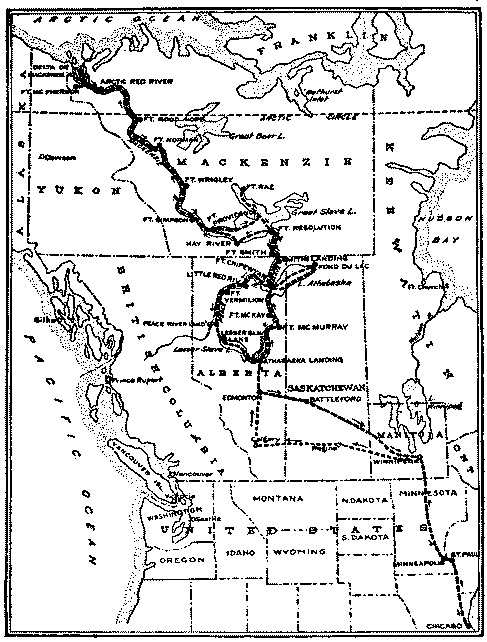
Isn't it Riley who says, "Ef you want something, an' jest dead set a-longin' fer it with both eyes wet, and tears won't bring it, why, you try sweat"? Well, we had tried sweat and longing for two years, with planning and hoping and the saving of nickels, and now we are off!
Shakespeare makes his man say, "I will run as far as God has any ground," and that is our ambition. We are to travel north and keep on going till we strike the Arctic,—straight up through Canada. Most writers who traverse The Dominion enter it at the Eastern portal and travel west by the C.P.R., following the line of least resistance till they reach the Pacific. Then they go back to dear old England and tell the world all about Canada, their idea of the half-continent being Euclid's conception of a straight line, "length without breadth."
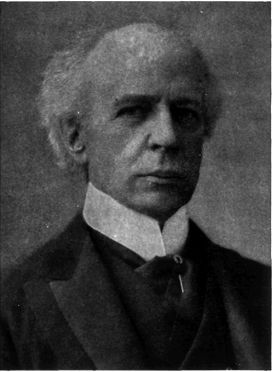
But Canada has a third dimension, a diameter that cuts through the Belt of Wheat and Belt of Fur, beginning south at the international boundary and ending where in his winter-igloo the Arctic Eskimo lives and loves after his kind and works out his own destiny. This diameter we are to follow. To what end? Not, we hope, to come back like him who went from Dan to Beersheba to say "All is barren," but to come near to the people, our fellow-Britons, in this transverse section of a country bigger than Europe. We want to see what they are doing, these Trail-Blazers of Commerce, who, a last vedette, are holding the silent places, awaiting that multitude whose coming footsteps it takes no prophet to hear.
We will take the great waterways, our general direction being that of all the world-migrations. Colonization in America has followed the trend of the great rivers, and it has ever been northward and westward,—till you and I have to look southward and eastward for the graves of our ancestors. The sons and grandsons of those who conquered the St. Lawrence and built on the Mississippi have since occupied the shores of the Red, the Assiniboine, and the Saskatchewan. They are laying strong hands upon the Peace, and within a decade will be platting townships on the Athabasca, the Mackenzie, and the Slave.
There has always been a West. For the Greeks there was Sicily; Carthage was the western outpost of Tyre; and young Roman patricians conquered Gaul and speculated in real estate on the sites of London and Liverpool. But the West that we are entering upon is the Last West, the last unoccupied frontier under a white man's sky. When this is staked out, pioneering shall be no more, or Amundsen must find for us a dream-continent in Beaufort Sea.
Kipling speaks of "a route unspoiled of Cook's," and we have found it. Going to the office of Thos. Cook & Son, in Chicago, with a friend who had planned a Mediterranean tour, I gently said, "I wonder if you can give me information about a trip I am anxious to take this summer." The young man smiled and his tone was that which we accord to an indulged child, "I guess we can. Cook & Son give information on most places." "Very well," I said, "I want to go from Chicago to the Arctic by the Mackenzie River, returning home by the Peace and the Lesser Slave. Can you tell me how long it will take, what it will cost, and how I make my connections?" He was game; he didn't move an eyebrow, but went off to the secret recesses in the back office to consult "the main guy," "the chief squeeze," "the head push," "the big noise." Back they came together with a frank laugh, "Well, Miss Cameron, I guess you've got us. Cook's have no schedule to the Arctic that way." They were able, however, to give accurate information as to how one should reach Hudson Bay, with modes of travel, dates, and approximate cost. But this journey for another day.
Leaving Chicago one sizzling Sunday in mid-May, we (my niece and I) stop for a day to revel in bird and blossoms at Lake Minnetonka in Minnesota, then silently in the night cross the invisible parallel of 49° where the eagle perches and makes amorous eyes at the beaver.
With the Polar Ocean as ultimate goal, we cannot help thinking how during the last generation the Arctic Circle has been pushed steadily farther north. Forty years ago Minneapolis and St. Paul were struggling trading-posts, and all America north of them was the range of the buffalo and the Indian. Then Fort Garry (Winnipeg) became Farthest North. Before starting, I had dug out from the Public Library the record of a Convention of Wheat-Growers who, fifteen years ago in Chicago, deliberately came to the conclusion (and had the same engrossed on their minutes) that "Our Northern tier of States is too far north to successfully grow wheat." For years Winnipeg was considered the northern limit of wheat-growth, the Arctic Circle of endeavour. Then that line of limitation was pushed farther back until it is Edmonton-on-the-Saskatchewan that is declared "Farthest North." To-day we are embarking on a journey which is to reach two thousand miles due north of Edmonton!
In the train between Minneapolis and Winnipeg an old man with a be-gosh beard looks worth while. We tell him where we are going, and he is all interest. He remembers the time when Montreal merchants wishing to reach Fort Garry had to bend down by way of St. Paul to gain their goal. These were the days of Indian raids and bloody treachery. "But," the old chap says, "the Hudson's Bay people always played fa'r and squar' with the Injuns. Even in them days the Injun knowed that crossed flag and what it stood for. I mind one Englishman and his wife who had come from Montreal to St. Paul in an ox-cart. The whole plains was covered with sneakin' red cusses on the war-path. But that darned Britisher was stubborn-set on pullin' out that night for Fort Garry, with his wife and kid, and what did the cuss do but nail a blame little Union Jack on his cart, poke the goad in his ox, and hit the trail! My God, I kin still see the old ox with that bit of the British Empire, wiggling out of St. Paul at sundown. And the cuss got there all right, too, though we was all wearing crape beforehand for his sweet-faced wife." This incident was not unique. In the early '60's an English curate, afterwards to be known to the world as Bishop Bompas, passed north through St. Cloud on his way from England to the Arctic. When the Sioux were reported on the war-path, Mr. Bompas improvised a Union Jack with bits of coloured clothing and fastened it on the first ox-cart of his cavalcade. Seeing this, the hostile Sioux turned bridle and rode away; and, protected by the flag of the clustered crosses, the Gospel-cart passed on.
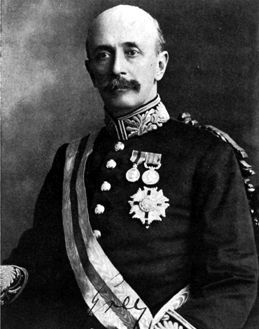
What Cook & Son failed to supply, the Hudson's Bay Company in Winnipeg furnished. This concern has been foster-mother to Canada's Northland for two hundred and thirty-nine years. Its foundation reaches back to when the Second Charles ruled in England,—an age when men said not "How cheap?" but "How good?", not "How easy?" but "How well?" The Hudson's Bay Company is to-day the Cook's Tourist Company of the North, the Coutts' Banking concern, and the freshwater Lloyd's. No man or woman can travel with any degree of comfort throughout Northwest America except under the kindly aegis of the Old Company. They plan your journey for you, give you introductions to their factors at the different posts, and sell you an outfit guiltless of the earmarks of the tenderfoot. Moreover, they will furnish you with a letter of credit which can be transmuted into bacon and beans and blankets, sturgeon-head boats, guides' services, and succulent sow-belly, at any point between Fort Chimo on Ungava Bay and Hudson's Hope-on-the-Peace, between Winnipeg-on-the-Red and that point in the Arctic where the seagull whistles over the whaling-ships at Herschel.
For a railroad station, the wall-notices in the baggage room of the Canadian Northern at Winnipeg are unique. Evidently inspired for the benefit of employés, they give the incoming traveller a surprise. Here they are as we copied them down:
Let all things be done decently and in order.As we smile over this Canadian substitute for the American,—
"Hang on to your hand-baggage. Don't letthe baggage-master with a strong Scottish accent says over our shoulders, "Guid maxims, and we live up t' them!"
A big Irish policeman is talking to a traveller who has stepped off a transcontinental train, and who asks with a drawl, "What makes Winnipeg?" Scraping a lump of mud from his boot-heel, the Bobby holds it out. "This is the sordid dhross and filthy lucre which keeps our nineteen chartered banks and their one and twenty suburban branches going. Just beyant is one hundred million acres of it, and the dhirty stuff grows forty bushels of wheat to the acre. Don't be like the remittance man from England, sorr," with a quizzical look at the checked suit of his interlocutor, "shure they turn the bottom of their trowsies up so high that divil of the dhross sticks to them!" As Mulcahey winks the other eye, we drift out into this "Buckle of the Wheat-Belt."
What has the policeman's hard wheat done for Winnipeg? Well, it gave her a building expansion, a year ago, greater than that of any other city of her population in America. One year has seen in Western Canada an increase in crop area under the one cereal of winter wheat of over one hundred and fifty per cent, a development absolutely unique in the world's history.
Winnipeg, having acquired the growing habit, expands by leaps and bounds. No city on the continent within the last thirty-three years has had such phenomenal growth. In 1876 the population was 6,000; it now counts 150,000 souls. This city is the greatest grain-market in the British Empire, and from it radiate twenty-two distinct pairs of railway tracks. Architects have in preparation plans for fifteen million dollars' worth of buildings during the coming year. The bank clearings in 1903 were $246,108,000; last year they had increased to $618,111,801; and a Winnipeg bank has never failed. Western Canada cannot grow without Winnipeg's reaping a benefit, for most of the inward and outward trade filters through here. During the spring months three hundred people a day cross the border from the United States. Before the year has closed a hundred thousand of them will have merged themselves into Western Canada's melting-pot, drawn by that strongest of lures—the lure of the land. And these hundred thousand people do not come empty-handed. It is estimated that they bring with them in settlers' effects and cash one thousand dollars each, thus adding in portable property to the wealth of Western Canada one hundred million dollars. In addition they bring the personal producing-factor, an asset which cannot be measured in figures—the "power of the man."
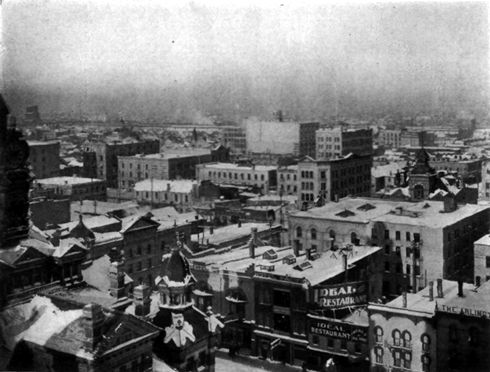
Not only from the United States do Winnipeg's citizens come. This City of the Plains is a human mosaic to which finished pattern every nation of the Old World furnishes its patine. The Bible Society of Winnipeg sells Bibles printed in fifty-one different languages—Armenian, Arabic, Burmese, Cree, Esth, Korean, Persian, Sanscrit, Slavonic, Tinne, Urdu, Yiddish, and nine and thirty other tongues. It is to be supposed that some buy their Bible not because it is the Bible but in order to feast the eye on the familiar characters of the home tongue. So would Robinson Crusoe have glutted his sight with a copy of the London Times, could the goat have committed the anachronism of digging one out from among the flotsam in the kelp.
Going into a hardware store to get a hatchet and a copper kettle, we cajole the proprietor into talking shop. He has orders for six hundred steam-ploughs to be delivered to farmers the coming season. We estimate that each of these will break at least fifteen hundred acres during the six months that must elapse before we hope to return to Winnipeg. This will make nearly a million acres to be broken by the steam-ploughs sold by this one concern, and practically the whole number will be used for breaking wild land. A peep into the ledger of this merchant shows in the list of his plough-buyers Russian names and unpronounceable patronymics of the Finn, the Doukhobor, and the Buckowinian. It is to be hoped that these will drive furrows that look straighter than their signatures do. "But they are all good pay," the implement-man says. Looking at the red ploughs, we see in each a new chapter to be written in Canada's history. The page of the book is the prairie, as yet inviolate, and running out into flowers to the skyline. The tools to do the writing are these ploughs and mowers and threshers, the stout arms of men and of faith-possessed women. It is all new and splendid and hopeful and formative!
We get in Winnipeg another picture, one that will remain with us till we reach the last Great Divide. At the Winnipeg General Hospital, Dr. D.A. Stewart says to us, "Come, I want to show you a brave chap, one who has fallen by the way." We find this man, Alvin Carlton, stretched on a cot. "Tell him that you are going into the land of fur," whispers the doctor, "he has been a trapper all his life."
Crossing soft ice on the Lake of the Woods, Carlton broke through, and his snow-shoes pinned him fast. When dragged out he had suffered so with the intense cold that he became partially paralysed and was sent here to the hospital. Hard luck? Yes, but the misfortune was tempered with mercy. Within these walls Carlton met a doctor full of the mellow juice of life,—a doctor with a man's brain, the sympathy of a woman, and the heart of a little child. The trapper, as we are introduced to him, has one leg and both hands paralysed, with just a perceptible sense of motion remaining in the other leg. His vocal cords are so affected that the sounds he makes are to us absolutely unintelligible, more like the mumblings of an animal than the speech of a man. Between patient and doctor, a third man entered the drama,—Mr. Grey, a convalescent. Appointed special nurse to the trapper, Grey studied him as a mother studies her deficient child, and now was able, to our unceasing marvel, to translate these sad mouthings of Carlton into human speech.
Who is this patient? A man without friends or influence, not attractive in appearance, more than distressing to listen to,—just one more worker thrown off from the gear of the rapidly-turning wheel of life. The consulting doctors agreed that no skill could perform a cure, could not even arrest the creeping death. Winnipeg is big and busy, and no corner of it more crowded than the General Hospital, no corps more overworked. Dr. Stewart had two men's work to do. He worked all day and was busy well into the night. A doctor's natural tendency is to see in each man that he ministers to merely "a case," a manifestation of some disease to be watched and tabulated and ticked off into percentages. But in the Stewart-Carlton-Grey combination, Fate had thrown together three young men in whom the human part, the man element, loomed large.
The doctor guessed that under that brave front the heart of the trapper was eating itself out for the cry of the moose, the smell of wood-smoke by twilight. We are happiest when we create. So he said to Carlton, "Did you ever write a story?" The head shook answer. "Well, why don't you try? You must know a lot, old chap, about out-door things, that nobody else knows. Think some of it out, and then dictate it to Grey here."
The outcome was disappointing. The uncouth sounds, translated by Grey, were bald, bare, and stiff. Soon the stiffness worked off. With half-shut eyes Carlton lived again in the woods. He lifted the dewy branch of a tree and surprised the mother deer making the toilet of her fawn, saw the beaver busied with his home of mud and wattles, heard the coyote scream across the prairie edge. Easily the thought flowed, and the stuff that Grey handed in was a live story that breathed. In that brave heart the joy of the creator stirred, and with it that feeling which makes all endeavour worth while—the thought that somebody cares. A close observer at this stage of the game may read, too, on the face of Grey the kindly look that comes when we forget ourselves long enough to take the trouble to reach out for another man's viewpoint.
Carlton's short stories, submitted to a publisher, were pronounced good, were accepted, and brought a cash return. They struck a new note among the squabblings of the nature-fakers. Favourable comment came from those who read them, who, reading, knew naught of their three authors. Before this Carlton had never written a line for publication; but he had been a true observer. He had felt, and was able to project himself into the minds of those living things he had seen and hunted.
I leave the hospital cot with a strange lump forming in my throat, although every one around me, and the patient most of all, is gay and blithe. I say to Carlton, "I wish I could take your knowledge and your eyes with me into the North, there is so much I will miss because of my lack of knowledge." With Grey's kindly interpretation I get my answer, "You must take your own mind, your own eyes; you must see for yourself."
During the last day in Winnipeg, while the Kid (like faithful Ariovistus) is looking after the impedimenta, I snatch half an hour to look in at the Royal Alexandra upon the reception which the Women's Canadian Club is tendering to Mrs. Humphry Ward. Rain-bespattered, short-skirted, and anchored with disreputable rubbers gluey with Winnipeg mud, I sit on the fringe of things, fairly intoxicated with the idea that we are off and this North trip no dream. Mrs. Sanford Evans presides with her usual savoir faire and ushers in the guest of the day, beautifully-gowned and gracious.
Like a bolt from the blue came the summons from the president, and I, all muddy, am called to the seats of the mighty. I have never seen a more splendid aggregation of women than the members of the Winnipeg Canadian Club, tall, strong, alert, and full of initiative. To face them is a mental and moral challenge. I try to hide those muddy shoes of mine. The Winnipeg women are indulgent, they make allowance for my unpresentable attire, and shower upon me cheery wishes for the success of my journey. Mrs. Humphry Ward calls attention to the lack of playgrounds in England. She wants to bring more fresh air and space to the crowded people of the Old World. I submit that my wish is the mathematical converse to hers. My great desire is to call attention to the great unoccupied lands of Canada, to induce people from the crowded centres of the Old World to use the fresh air of the New.
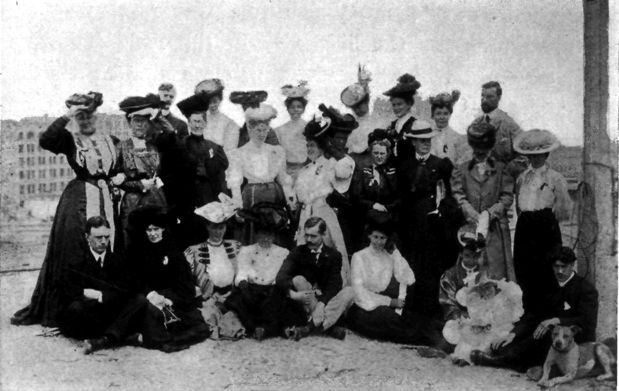
To those who bid us good-bye at the train, the Kid and I yell exultantly, "All aboard for the Arctic Ocean and way ports!"
A group of Galicians sitting by the curb, two mothers and seven small children, one a baby at the breast, make the last picture we see as the train pulls out. It was the end of their first day in Winnipeg. The fathers of the flock evidently were seeking work and had left their families gazing through the portals of the strange new land. In the half-sad, altogether-brave lines on the young mothers' faces and their tender looks bent on the little ones we read the motive responsible for all migrations—"Better conditions for the babies." In the little fellows of seven or eight with their ill-fitting clothes and their dogged looks of determination one sees the makers of empire. Before a decade is past they will be active wheat-growers in their own right, making two grains grow where one grew before and so "deserving better of mankind than the whole race of politicians put together." I think it was President Garfield who said, "I always feel more respect for a boy than for a man. Who knows what possibilities may be buttoned up under that ragged jacket?" It doesn't take long for the foreigners to make good. A young Icelander, Skuli Johnson, of all the thousands of Winnipeg students, this year captured the coveted honor of the academic world—the Rhodes scholarship.
We slip out of Winnipeg as the bells of St. Boniface ring the vespers from their turrets twain. Whittier, who never saw this quaint cathedral, has immortalized it in verse. The story is one of those bits of forgotten history so hard to get hold of in a day when Winnipeg measures its every thought in bushels and bullion.
The settlers who came to Selkirk on the outskirts of present Winnipeg just a hundred years ago were sturdy Scots, weaned on the Psalms of David and the Shorter Catechism. There were English missionaries here and priests of the Church of Rome, but the disciples of John Knox wanted some one to expound Predestination to them. A religious ceremony performed by any man who was not a Presbyterian seemed scarcely binding. One old lady, speaking of the nuptials of her daughter, said, "I wudna have Janet marrit by the bishop. She maun wait till we can have a properly-ordained meenister." And he was coming. Even now he was floating in on the Red River with Indian and half-breed boatmen, having reached St. Paul from Scotland via the Atlantic seaboard some weeks before.
When a Scot and an Indian get in a boat together, to use a Will Carleton phrase, "they do not teem with conversational grace." Straight from Aberdeen, the young Dominee coming into Winnipeg little dreamed that the Church of Rome had established its Mission on the Red River decades ago. In fact, he knew as little about Canada as he did about Timbuctoo, and in his simplicity thought himself "the first that ever burst into that silent sea." When the evening breeze brought to his ears a muffled sound, he was in doubt how to place it.
"Is it the clang of wild-geese?The Indian boatmen said nothing, but thought deep, like the Irishman's parrot.
"The voyageur smiles as he listensOnce the young Scot had reached his flock, he wrote back to a friend in the States telling how he came across on the edge of the wilderness
"The bells of the Roman Mission,That friend was a fellow-townsman of the "Quaker Poet." The story was told to Whittier and inspired the lines of The Red River Voyageur.
Place a pair of dividers with one leg on Winnipeg and the other leg at Key West, Florida. Then swing the lower leg to the northwest, and it will not reach the limit of good agricultural land.
From Winnipeg to Edmonton, roughly speaking, is a thousand miles, and two railway lines are open to us,—the Canadian Pacific and the Canadian Northern. We go by the former route and return in the autumn by the latter.
Pulling out from Winnipeg, we enter a prairie wheat-field one thousand miles long and of unknown width, into which the nations of the world are pouring. "The sleeping nation beyond," is what General Sherman in a moment of pique once called Canada. The sleeping giant has awakened. We are on the heels of the greatest economic trek this world has ever seen. The historian of to-morrow will rank it with the world migrations.
The flourishing centres of Portage la Prairie, Brandon with its Experimental Farm, Regina, the headquarters of the Mounted Police, Moose Jaw, and Medicine Hat are passed, and with these the new, raw towns in the tar-paper stage, towns that smell of sawdust, naked stand of paint. Never in the world's history did towns spring into life as these do. To-day the wind on the prairie, to-morrow the sharp conversation of the hammer on the nail-head, next week the implement warehouse, the tent hotel, the little cluster of homes. In England it takes a bishop to make a city, but here the nucleus needed is a wheat elevator, red against the setting sun.
The ploughs that we saw in Winnipeg are at work here among the buffalo bones and the spring anemones. As day breaks we catch a glimpse of a sunbonneted mother and her three little kiddies. An ox is their rude coadjutor, and through the flower-sod they cut their first furrow. It is the beginning of a new home. Involuntarily one's mind jumps to the crowded cities of the Old World with their pale-cheeked children and fetid alleyways. Surely in bringing the workless man of the Old World to the manless work of the New, the Canadian Government and the transportation companies are doing a bit of God's work.
Half way between Winnipeg and the Pacific we reach Calgary, breezy, buoyant Calgary, the commercial metropolis of the foothills, already a busy mart and predestined to be the distributing point for many railroads. The biggest man-made thing in Calgary is the C.P.R. irrigation works, the largest on this continent. The area included in the irrigation block is twice as big as the Island of Porto Rico and one-eighth the size of England and Wales; and the ultimate expenditure on the undertaking will reach the five million mark.
Calgary is the centre of a country literally flowing with milk and honey and fat things. The oil-fields of Pincher Creek, with their rich promise of becoming a second Pennsylvania, are contiguous to the city. The winter wheat grown in Southern Alberta was awarded first prize and gold medal at the World's Fair in Oregon in 1905. The hackney carriage horses which took first prize at the last Montreal and New York horse-fairs were foaled and raised near Calgary. If we were to continue going due west from this point, all the scenic glories of the Rocky Mountains would be ours—seventy Switzerlands in one. But that journey must stand over for another day, with the journey to Prince Rupert, the ocean terminus of the Grand Trunk Pacific.
Turning sharply to the north, we travel two hundred miles, and draw into where Edmonton, the capital of Alberta, sits smiling on the banks of her silver Saskatchewan. As he sees us digging out our tents and dunnage, the porter asks, "Then yer not comin' back?" "No." "You are goin' to the North Pole, then, the place you wuz hollerin' fer!"
With the exception of Victoria, Edmonton has the most charming location of all cities of Western Canada. High Hope stalks her streets. There is a spirit of initiative and assuredness in this virile town, a culture and thoughtfulness in her people, expectancy in the very air. It is the city of contrasts; the ox-cart dodges the automobile; in the track of French heel treads the moccasin; the silk hat salutes the Stetson.
Edmonton is the end of steel. Three lines converge here: the Canadian Northern, the Canadian Pacific, and the Grand Trunk Pacific. The Canadian Northern arrived first, coming in four years ago. Now that Edmonton has arrived, it seems the most natural thing in the world that there should have sprung up on the Saskatchewan this rich metropolis, anticipating for itself a future expansion second to no city in commercial Canada. But some one had to have faith and prescience before Edmonton got her start, and the god-from-the-machine was the Canadian Northern, in other words, William Mackenzie and D.D. Mann. Individuals and nations as they reap a harvest are apt to forget the hands that sowed the seed in faith, nothing doubting. When this railroad went into Edmonton, as little was known of the valley of the Saskatchewan as is known now of the valley of the Peace. Without exception, Canadian men of letters go to other countries for recognition, but not so all our men of deeds. Mackenzie and Mann, "the Brains of a Trans-Continental," stayed in Canada and put their genius to work here. The Canadian Northern is the product of Canadian minds and Canadian money.
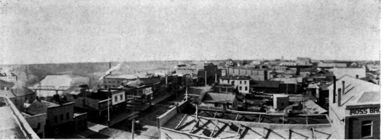
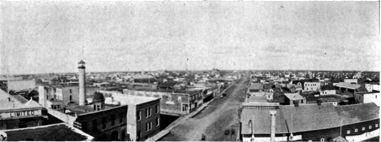
We walk Edmonton streets for ten days and see neither an old man nor an old woman. The government and the business interests are in the hands of young people who have adopted modern methods of doing things; single tax is the basis of taxation; the city owns its public utilities, including an interurban street railroad, electric lighting plant, water-works, and the automatic telephone. Mr. C.W. Cross, the Attorney-General of Alberta, is the youngest man in Canada to hold that high office. During the first session of the first legislature of this baby province less than three years ago, an enabling act was passed for a university. Nowhere else have I been sensible of such a feeling of united public-spiritedness as obtains here.
Down in the river valley are hundreds of people living under canvas, not because they are poor but because building contractors cannot keep pace with the demand for homes. As we pass these tents, we are rude enough to look in. Most of them are furnished with telephones and the city water; here a bride bends over a chafing dish; another glance discloses an oil-painting that was once shown in the Royal Academy. From the next tent float the strains of Beethoven's Moonlight Sonata, and, as we stop to listen, a gentleman and his wife step out. An auto picks them up and off they whirl to Jasper Avenue. The Lord o' the Tents of Shem disappears into his bank and Milady drives on to the Government house to read before the Literary Club a paper on Browning's Saul. To the tenderfoot from the South it is all delightfully disconcerting—oxen and autos and Browning on the Saskatchewan!
The Sunday before we leave Edmonton I find another set of tents, put up by the Immigration Department, where East-End Londoners are housed pending their going out upon the land. In the first call I make I unearth a baby who rejoices in the name of Hester Beatrice Cran. "H.B.C.," I remark, "aren't you rather infringing on a right, taking that trade-mark?" Quick came the retort, "Ho! If she gets as good a 'old on the land as the 'Udson's Bay Company 'as, she'll do!"
Another lady in the next tent proudly marshalled her olive branches. "D'isy and the baiby were born in the Heast Hend. They're Henglish; please God they'll make good Canaidians. They're tellin' me, miss, there'll be five 'undred more of us on the 'igh seas comin' out to Hedmonton from the Heast Hend, all poor people like ourselves. I often wonder w'y they don't bring out a few dukes to give the country a touch of 'igh life—it's very plain 'ere."
By the first day of June we have our kit complete and are ready to leave. We have tried to cut everything down to the last ounce, but still the stuff makes a rather formidable array. What have we? Tent, tent-poles, typewriter, two cameras, two small steamer-trunks, bedding (a thin mattress with waterproof bottom and waterproof extension-flaps and within this our two blankets), a flour-bag or "Hudson's Bay suit-case" (containing tent-pegs, hatchet, and tin wash-basin), two raincoats, a tiny bag with brush and comb and soap—and last, but yet first, the kodak films wrapped in oilcloth and packed in biscuit-tins. The bits of impedimenta look unfamiliar as we take our first inventory, but we are to come to know them soon by their feel in the dark, to estimate to an ounce the weight of each on many a lonely portage.
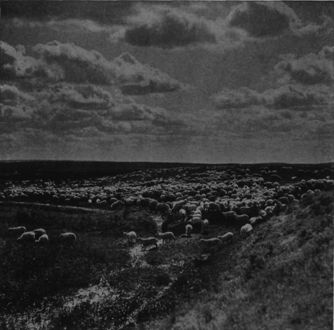
At seven in the morning the stage pulls up for us, and it rains—no gentle sizzle-sozzle, but a sod-soaker, yea a gully-washer! The accusing newness of those raincoats is to come off at once. Expansive Kennedy looks askance at the tenderfoots who climb over his wheel. His Majesty's Royal Mail Stage sifts through the town picking up the other victims. We are two big stage-loads, our baggage marked for every point between Edmonton and the Arctic Ocean. Every passenger but ourselves looks forward to indefinite periods of expatriation in the silent places. We alone are going for fun. Our one care is to keep those precious cameras dry. This is the beginning of a camera nightmare which lasts six months until we again reach Chicago.
And the fellow-passengers? Law is represented, and medicine, and the all-powerful H.B. Co. With us is Mr. Angus Brabant going in on his initial official trip in charge of H.B. interests in the whole Mackenzie River District, and with him two cadets of The Company. On the seat behind us sit a Frenchman reading a French novel, a man from Dakota, and a third passenger complaining of a camera "which cost fifty pounds sterling" that somehow has fallen by the way. Sergeant Anderson, R.N.W.M.P., with his wife and two babies are in the other stage.
Kennedy, the driver, is a character. Driving in and out and covering on this one trail twelve thousand miles every year, he is fairly soaked with stories of the North and Northmen. The other stage is driven by Kennedy's son, who, tradition says, was struck by lightning when he was just forgetting to be a boy and beginning to be a man. Dwarfed in mind and body, he makes a mild-flavoured pocket-edition of Quilp.
The roads are a quagmire. The querulous voice of the man who lost his camera claims our attention. "I thought I would be able to get out and run behind and pick flowers." Turning and introducing ourselves, we find the troubled one to be an English doctor going north off his own bat with the idea of founding a hospital for sick Indians on the Arctic Circle.
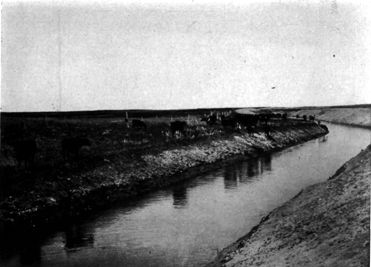
The girlish figure of a teacher struggling through the awful mud in gum-boots indicates that we have not travelled beyond the range of the little red schoolhouse. Stray wee figures splashing their way schoolward look dreary enough, and I seem to hear the monotonous drone of "seven times nine," "the mountains of Asia," "the Tudor sovereigns with dates of accession," and other things appertaining to "that imperial palace whence I came." All the summer afterwards, when mosquitoes are plenty and food scarce, a backward thought to this teacher making muddy tracks toward the well of English undefiled, brings pleased content.
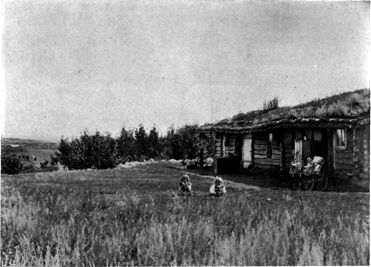
At noon it clears, and as we "make tea" at Sturgeon Creek (the Namao Sepee of the Indians), the first of the "stopping-places" or Waldorf-Astorias of the wilderness, the Doctor has his will and gathers violets, moccasin flowers, and the purple dodecatheon. As we pass Lily Lake he remarks, "This reminds me of the Duke of Norfolk's place at Arundel; it is just like this." South Dakoty returns, "I don't know him."
Here and there we pass clusters of Galician huts. Instead of following the line of least resistance in the fertile plains to the south, these people, the Mark Tapleys of the prairies, choose cheap land up here for the pleasure of conquering it and "coming out strong." They are a frugal people, with a fondness for work, a wholesome horror of debt, and the religious instinct strongly insistent. Off on a hillside near each little settlement a naked cross extends its arms. These are their open-air churches, and in all weathers, men, women, and children gather at the foot of the cross to worship the God of their fathers. By and by, when the soil has yielded to their labours, with their own hands will they build a church and without debt it will be dedicated. The idea of raising an imposing church and presenting God with the mortgage does not appeal to the Galician.
The clean sheets at "Eggie's," the second stopping-place, are attractive, and we sleep the sleep of the just. We acknowledge with inward shame that two years of city life have given us the soft muscles of the chee-chaco; we'll have to harden up a bit if we are to reach that far-away ocean.
Next day, midway between Edmonton and Athabasca Landing, we water our horses at the Tautinau. We are standing at the Height of Land, the watershed between the Saskatchewan and the Athabasca. This little ridge where the harebells grow divides the drops of rain of the noon-day shower. Some of these drops, by way of the Saskatchewan, Lake Winnipeg, and Hudson Bay, will reach the Atlantic. Others, falling into the Athabasca, will form part of that yellow-tinged flood which, by way of Great Slave Lake and the mighty Mackenzie, carries its tribute to the Frozen Ocean. These last are the drops we follow.
To save the horses we walk the hills, and I try to match giant steps with Sergeant Anderson. Kennedy, Junior, joins us and has a knotty point to settle regarding "the gentleman wot murdered the man." It is hard to induce a Mounted Policeman to talk. However, to be striding Athabasca Trail with the hero of the Hayward-King murder-trial is too good an opportunity to lose, and, reluctantly rendered, bit by bit the story comes out.
Most people looking at a map of Northwest Canada would think it a safe wilderness for a live man or a dead man to disappear in with no questions asked. In reality, it is about the worst place in America in which to commit a crime and hope to go unpunished.
In September, 1904, the Indians reported to the Mounted Police that they had seen two white men in the early summer, and that afterwards one man walked alone, and was now at Lesser Slave. An observant Cree boy added, "The dog won't follow that other white fellow any more." Sergeant Anderson, going to their last camp, turned over the ashes and found three hard lumps of flesh and a small piece of skull bone. Convinced that murder had been done, he arrested the suspected man and sent him to Fort Saskatchewan for trial. No one knew the identity of either the dead man or the living. In front of the old camp-fire was a little slough or lake, and this seemed a promising place to look for evidence. Sergeant Anderson hired Indian women to wade in the ooze, feeling with their toes for any hard substance. In this way were secured a sovereign-case and a stick-pin of unusual make. The lake was systematically drained and yielded a shoe with a broken-eyed needle sticking in it. Sifting the ashes of the camp-fire and examining them with a microscope, Anderson discovered the eye of the broken needle and thus established a connection between the camp with its burnt flesh and the exhibits from the lake. The maker of the stick-pin in London, England, was cabled to by the Canadian Government, and a Mr. Hayward summoned to come from there to identify the trinkets of his murdered brother. A cheque drawn by the dead Hayward in favour of King came to the surface in a British Columbia bank. Link by link the chain of evidence grew.
It took eleven months for Sergeant Anderson to get his case in shape. Then he convoyed forty Indian witnesses two hundred and fifty miles from Lesser Slave to Edmonton to tell what they knew about the crime committed in the silent places. The evidence was placed before the jury, and the Indians returned to their homes. A legal technicality cropped up and the trial had to be repeated. Once more the forty Indians travelled from Lesser Slave to repeat their story. The result was that Charles King of Utah was found guilty of the murder of Edward Hayward and paid the death penalty.
This trial cost the Canadian Government over $30,000,—all to avenge the death of one of the wandering units to be found in every corner of the frontier, one unknown prospector. Was it worth while? Did it pay? Yes, it paid. It is by such object-lessons that to Indian and white alike is forced home the truth that God's law, "Thou shalt not kill," is also the law of Britain and of Canada.
We are still on foot, when a cry from the Kid hurries us to the hilltop. Reaching the crest, we catch our breaths. Down below lies the little village of "The Landing." That sparkling flood beyond proves the Athabasca to be a live, northward-trending river, a river capable of carrying us with it, and no mere wiggly line on a map.
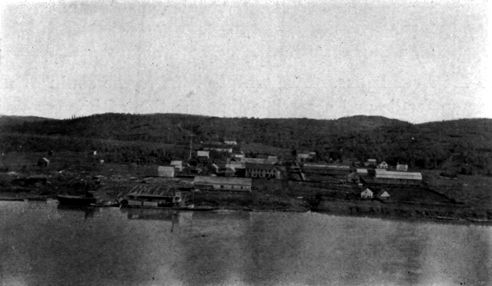
Athabasca Landing, a funnel through which percolates the whole trade between the wheat-belt and the Arctic, is the true gateway of the North. Seeing our baggage tucked away in the bar-room of the Grand Union Hotel, and snatching a hasty supper, we walk down to the river, its edges still encrusted with fragments of winter ice. It is an incomparable sunset, the light a veritable spilt spectrum, spreading itself with prodigality over the swift river.
The Athabasca, after dipping to the south, here takes a sudden northward bend. Its source is in the crest of the continent far back in the Committee's Punch-Bowl of the Rockies, the general trend of the river being northeasterly. It is the most southerly of the three great tributaries of the mighty Mackenzie, and from its source in Rockies to embouchure in Athabasca Lake it is about seven hundred and seventy-five miles long; through a wooded valley two miles wide it runs with perhaps an average width of two hundred and fifty yards.
We are in latitude 55° North, and between us and the Arctic lies an unknown country, which supports but a few hundred Indian trappers and the fur-traders of the Ancient Company in their little posts, clinging like swallows' nests to the river banks. The wheat-plains to the south of us are so fertile and accessible that the tide of immigration has stopped south of where we stand. But that there stretches beyond us a country rich in possibilities we know, and one day this land, unknown and dubbed "barren" because unknown, will support its teeming millions. Chimerical? Why so?
Parallels of latitude are great illuminators. When we run this line of 55° westward what do we strike in Asia? The southern boundary of the Russian Province of Tobolsk. Superimpose a map of that Province on a map of Canada and we find that the great Mackenzie waterway which we are to follow cuts Tobolsk almost directly through the centre. In the year 1900, Russian Tobolsk produced twenty-one million bushels of grain, grazed two and a half million head of live stock, exported one and a half million dollars' worth of butter, and supported a population of one and a half million souls. There is not one climatic condition obtaining in the Asiatic Province that this similar section of Canada which we are about to enter does not enjoy.
Off a little jetty some lads are fishing. There is a camaraderie felt by all fishermen, and soon I have a rod and access to the chunk of moose-meat which is the community bait. Within half an hour, rejoicing in a string of seventeen chub and grayling, we wend our way back to the little village. The elements that compose it? Here we have a large establishment of the Hudson's Bay Company, an Anglican and a Roman Mission, a little public school, a barracks of the Northwest Mounted Police, a post office, a dozen stores, a reading-room, two hotels, and a blacksmith shop, and for population a few whites leavening a host of Cree-Scots half-breeds.
Athabasca Landing is part of the British Empire. But English is at a discount here; Cree and French and a mixture of these are spoken on all sides. The swart boatmen are the most interesting feature of the place,—tall, silent, moccasined men, followed at the heel by ghostlike dogs. From this point north dogs are the beasts of burden; the camel may be the ship of the desert, but the dog is the automobile of the silences. The wise missionary translates his Bible stories into the language of the latitude. As Count von Hammerstein says, "What means a camel to a Cree? I tell him it is a moose that cannot go through a needle's eye." The Scriptural sheep and goats become caribou and coyotes, and the celestial Lamb is typified by the baby seal with its coat of shimmering whiteness. Into the prohibition territory that stretches north of this no liquor can be taken except by a permit signed by an Attorney-General of Canada, and then only "for medicinal purposes." By an easy transferring of epithets, the term "permit" has come to signify the revivifying juice itself.
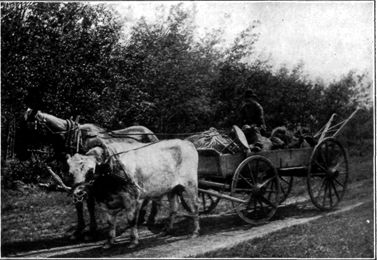
One illusion vanishes here. We had expected to find the people of the North intensely interested in the affairs of the world outside, but as a rule they are not. There is no discussion of American banks and equally no mention of the wheat crop. The one conjecture round the bar and in the home is, "When will the rabbits run this year?" The rabbits in the North are the food of the lynx; cheap little bunny keeps the vital spark aglow in the bodies of those animals with richer fur who feed upon him. Every seven years an epidemic attacks the wild rabbits, and that year means a scarcity of all kinds of fur. As surely as wheat stands for bullion in the grain-belt, little Molly Cottontail is the currency of the North.
It is at this point we join the Fur-Brigade of the Hudson's Bay Company making its annual transport to the posts of the Far North, taking in supplies for trading material and bringing back the peltries obtained in barter during the previous winter. The big open scows, or "sturgeon-heads," which are to form our convoy have been built, the freight is all at The Landing, but for three days the half-breed boatmen drag along the process of loading, and we get our introduction to the word which is the keynote of the Cree character,—"Kee-am," freely translated, "Never mind," "Don't get excited," "There's plenty of time," "It's all right," "It will all come out in the wash."
When the present Commissioner of the Hudson's Bay Company entered office he determined to reduce chaos to a methodical exactness, and framed a time-table covering every movement in the northward traffic. When it was shown by the local representative to the Cree boatmen at The Landing, old Duncan Tremblé, a river-dog on the Athabasca for forty years, looked admiringly at the printed slip and said, "Aye, aye; the Commissioner he makes laws, but the river he boss." It is only when ice is out and current serves that the brigade moves forward. Old Duncan knows seven languages,—English, French, Cree, Chipewyan, Beaver, Chinook, Montagnais,—he speaks seven languages, thinks in Cree, and prevaricates in them all.
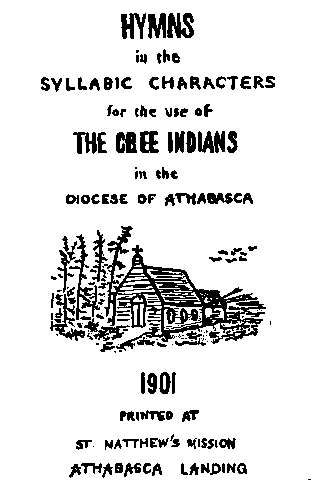

At the foot of the hill we visit the English parsonage, with its old-time sun-dial at the garden-gate. Within, we find what must surely be the farthest north printing-press. Here two devoted women have spent years of their lives printing in Cree on a hand-press syllabic hymns and portions of the Gospel for the enlightenment of the Indians. We wander into the school where a young teacher is explaining to his uneasy disciples the intricacies of Present Worth and Compound Interest. Idly we wonder to what use these bare-footed half-Cree urchins will put their exact banking knowledge.
Everywhere around us the wild flowers are a great joy; we hail with the gladness of released children the posies that sweetened childhood meadows—the dwarf cornel (Cornel Canadensis), dandelions, strawberry blossoms, wild roses, the pale wood-violet on its long stem, and amid these familiars the saskatoon or service-berry bushes, with blueberry vines, and viburnums of many kinds. On the street the natty uniforms of the Mounted Police are in evidence, and baseball has penetrated as far north as this. In the post office we read,
"It is decided to hold sports on the first day of July. The Committee promises a splendid programme,—horse-races, foot-races, football match, baseball game. There will also be prizes for the best piece of Indian fancy-work. Dancing will be in full swing in the evening. All welcome."
Opposite the hotel is a reading-room built by a Methodist parson who also made the furniture with his own hands; magazines, books, writing-material, games are available to all. This practical work of one man who accepted the responsibility of being his brother's keeper appealed to us. In a store near the hotel we see a Cree boatman purchasing a farewell present for his sweetheart. As he turns over the fancy articles, we have bad form enough to observe his choice. He selects a fine-tooth comb, for which he pays fifty cents, or as he calls it, "two skins," and asks, as he tucks it into his jerkin, if he can change it "if she doesn't like it."
In the evening it rains, and the room assigned us becomes a living illustration of the new word we have just learned,—"muskeg," a swamp. Putting the precious cameras on top of the bureau, we let the rest of the things swim at their pleasure. Starting with the rest of the unattached community of Athabasca Landing to go down to the pool-room, we catch sight of Dr. Sussex and the Cree priest, who have found a little oasis of their own around a big stove in the upper hall and, with chairs tilted back, are enjoying some portable hospitality from below. The doctor arises to escort us through the flood, and when I rally him about his liquid refreshment, he says, "Oh, I had lemonade."
"I see. And the priest?"
"He had—what he liked."
If local colour and local smell is what we have come north for, we find it here. Mr. Brabant comes up with "I wonder if that bunch of nuns is going to get here in time to take scows with us," and we pass into the billiard-room and watch the game. The players gliding round in moccasins are all half-breeds. The exclamations are for the most part in Cree or bad French, and as I crowd in looking for some local terms all that I hear intelligible is, "That is damn close, I think me."
For thirty-six hours on end it rains. That roof was full of surprises; you never knew where it would spring a fresh leak. One room is a little better than the rest, and we all gather there and make the best of it,—smoking, writing, telling yarns. A bumping noise from across the hall and the cry of a child startles us. It proves to be Sergeant Anderson's baby whose cradle has started afloat, and there is a general rush to rescue Moses from his bulrushes. Everybody is in good humour.
As we calm the baby, South Dakota says "It reminds me of the Englishman and his musical bath." We demand the story. "Well, a rich American took a great liking to an Englishman he had been travelling with, and sent him for a birthday present a Yankee invention to set up in his country-house—a musical bath. As you turned on the spigot, the thing played a tune while you were washing, and sort of relieved the tee-deum. The two gents met next Christmas in New York, and the Yankee he sez, 'And how did you like the bath?' 'Oh, thank you very much, it was kind of you indeed, but I found it a little irksome standing all the time, you know.' 'Standing, what the blazes do you mean?' asked the Yankee. 'Well,' says the Britisher, 'the tune you furnished, you know, with the bawth, was God Save the King, and as soon as it began, you know, I had to stand, and it's rather tiresome taking your bawth standing, you know."
Sergeant Joyce tells how at a Mounted Police dinner at Fort Saskatchewan a parson, who was a guest, in proposing a toast, facetiously advised his entertainers to have nothing to do with either a doctor or a lawyer. It was interesting to watch the parson's face when there arose to reply a lawyer and a doctor, each a constable in the rank and file.
Mrs. Leslie Wood of Athabasca Landing adds her quota to the Tales of a Wayside Inn. We could have listened to her for a week and regretted neither the rain nor the waiting scows. As a girl she remembers being shocked at seeing men hold tin cups to the throats of newly-slaughtered buffalo, drinking with gusto the warm blood.
"What are the two greatest things on earth?" Mrs. Wood, as a young girl, asked the dusky disciples of her Sunday School class. "The Queen and The Company," was the ready response. "And of these, which is the greater?" Little Marten-Tail rubbed one moccasin over the other, and the answer came thoughtfully in Cree, "The Company. The Queen sometimes dies, but The Company never dies."
"The Company," of which the little girl spoke, "The Governor and Company of Adventurers trading into Hudson's Bay," deriving its charter in 1670 from the Second Charles of England, is the oldest chartered concern in the world, with a present-day sphere of influence as large as Great Britain, France, Spain, and Germany combined. From lone Labrador to the Pacific littoral and from Winnipeg to the Frozen Ocean are scattered the two hundred and fifty fur-trading forts of this concern in charge of its two thousand strong silent servants. Last year it paid to its stockholders a profit of forty-five per cent on the invested capital, and for two hundred and thirty-nine consecutive years it has been declaring dividends. The motto of the Company, Pro Pelle Cutein, is prominently displayed at Athabasca Landing. Literally translated, the phrase means "Skin for skin"; but why the promoters should have chosen as war-cry the words which Satan used when fighting with the Lord for the soul of Job, is not so apparent.
As we watch the trading goods being carried in the rain from warehouse to scows, we think how, weaving its cross-Atlantic way through the centuries and joining the periwigged days of the Stuarts to this day, the one man-made thing that has persisted is this commerce-shuttle of the H.B. Co.
In the days when The Company had its birth, the blind Milton was dictating his message and the liberated Bunyan preached the spoken word, the iniquitous Cabal Ministry was forming in England, and Panama was sacked by Morgan the buccaneer. New York merchants of Manhattan met every Friday at noon on the bridge over the Broad Street Canal for barter, South Carolina was settled on the Ashley River, Virginia enacted that "all servants not being Christians, imported into this country by shipping shall be slaves," and her Governor, Sir William Berkeley, was inspired to exclaim piously, "I hope we shall have neither free schools nor printing these hundred years, for learning has brought disobedience and heresy and sects into the world, and printing has divulged them. God keep us from both!" It was not until two years later that Addison was born, and that Marquette and Joliet sailed down the Mississippi, even as we now are essaying the Athabasca.
Unique in commercial annals is the Royal Charter which gave, with power of life and death, to the Company of Gentlemen Adventurers, less than twenty in number, "forever hereafter" possession and jurisdiction over a country as large as Europe. Liberty here for utter despotism, the widest of excesses. We marvel that from the first Prince Rupert of the Rhine to the latest Lord Strathcona and Mount Royal, the Governors of the Ancient Company have, with Duncan-like demeanour, borne themselves so meek in their great office.
It has been fashionable to paint the H.B. Co. as an agrarian oligarchy. Organized for the purpose of "making fur" before the time of the Habeas Corpus, two decades ahead of the Bank of England, sixty-two years before Benjamin Franklin began publishing "Poor Richard's Almanac," and a century in advance of Watt's steam-engine, it is true that The Company, throughout the years, devoted itself to peltries and not to platting town sites. This was its business. From the beginning it has consistently kept faith with the Indians; the word of The Company has, for reward or for punishment, ever been worth its full face value. It was not an H.B. Scot who exclaimed feelingly, "Honesty is the best policy, I've tried baith."
The feeling of devotion to The Company is as strong today as it ever was. When the present Commissioner took office he penetrated the North on a tour of inspection. At Athabasca Landing, since it was not known just when the Head would arrive, the local official charged all his clerks and minions to be ready at the sound of a whistle to salute and fall into line for inspection. The call to arms came on Sunday morning during divine service. Every attaché of The Company with one exception obeyed the signal. Young Tom Helly, the paid organist, stuck to his post; and next day he was called on the carpet. "It was a special service; I was in the middle of the anthem, sir, and didn't like to leave the House of God." "Couldn't you show some respect?" roared the local officer. Man was near in Athabasca Landing and God far away. Down in the big office at Winnipeg is a Doomsday Book where the life-record of every servant of The Company is kept, for no man who has ever served The Company is lost sight of. When there is a good fur-winter, every employé of The Company is handed an envelope which contains a bonus-cheque,—ten per cent of his yearly salary.
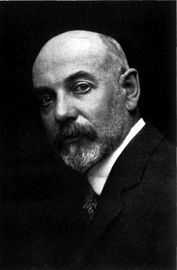
The Commissioner of the Hudson's Bay Company and the head of one of Canada's big department stores were dining together at a Toronto Club. "After six o'clock I don't want to see or hear of an employé—he doesn't exist for me until eight o'clock next morning," said the head of the department store. "Well, I'm more curious than you," smiled the Commissioner of the H.B. Co., "I want to be reasonably assured of what every man-Jack of my people is doing all the time. I want to know what he reads, and if he treats his wife well, and how his last baby is getting along—you see, he's a working-partner of mine."
There came out of Northern British Columbia last year the Indian wife and half-breed daughters of an H.B. Co. Factor. They were bound for Montreal and it was their first trip "outside." The Commissioner at Winnipeg contradicts the old saw, and surely has "a soul above a beaver-skin"; like Mulvaney, too, he "has bowels." Quickly went forward a letter to a tactful woman in the border-town through which the visiting ladies must pass—"Meet them, and see that they get the proper things to wear in society circles in Montreal. I don't want them to feel ill at ease when they get there." Stories like these give us glimpses of the kind of paternalism exercised by the Ancient Company, the one trust that has never ground the faces of the poor, and in whose people to-day appears the "constant service of the Old World."
The big books of The Company a year or two ago in unmistakable round-hand declared that one Running Rabbit, lawful widow of Blueskin, was entitled to draw from the coffers clear-side bacon and a modicum of flour. But one quarterly paysheet, returned to Winnipeg from Fort Churchill, showed that Running Rabbit in addition to her food allowance had been handed out forty cents' worth of cotton. Stern enquiry, backed by red-tape and The Company's seal as big as a saucer, was sent up to the Churchill Factor. Why had the allowance of Mrs. Blueskin (née Running Rabbit) been exceeded? By "return mail" nine months later the Factor reported,
"The widow's gone,The Ancient Company was penny-wise, but in spite of the copybook line, not pound-foolish, as its dividend paysheets conclusively prove.
There is no desire to show forth these silent ones of the North as infallible men and immaculate. They make many mistakes; they were and are delightfully human, and we couldn't picture one of them with a saintly aureole. But in the past, as in the present, they were large men; they honoured their word, and you couldn't buy them. Men of action, whether inside fort walls, bartering in the tepee of the Indian, or off on silent trails alone,—it has been given to each of them to live life at firsthand. In every undertaking the determining factor of success is men, and not money or monopoly. And because the North still breeds men of the H.B. type, the eye of The Great Company is not dimmed, its force not abated.
We spoke with no fewer than three men at The Landing who came into the North in the year of the Klondike rush, that is, just ten years ago. Into the human warp and woof of the Great Lone Land of Northern Canada the Klondike gold-rush intruded a new strand. The news of the strike on Yukon fields flashed round the world on wires invisible and visible, passed by word of mouth from chum to chum, and by moccasin telegraph was carried to remotest corners of the continent. Gold-fever is a disease without diagnosis or doctor—infectious, contagious, and hereditary; if its germ once stirs in a man's blood, till the day of his death he is not immune from an attack. The discovery of gold-dust in Dawson sent swarming through the waterways of sub-Arctic Canada a heterogeneous horde,—gamblers of a hundred hells, old-time miners from quiet firesides, beardless boys from their books, human parasites of two continents, and dreamers from the Seven Seas.
Coastwise they sought the North by steamers from 'Frisco, Seattle, and Vancouver Island, and of the numbers of these the shipping offices have some records. But of that vast army who from the east and from the south travelled inland waterways towards the golden goal no tabulation has ever been made. Singly they went, in groups, and by partnerships of two and three. There was no route marked out by which they were to reach the glittering streams of which they dreamed; the general direction of north and west was all that guided them. Athabasca Landing was the portal through which they passed, and by every northward stream they travelled,—down the Athabasca toward the Mackenzie and up the Athabasca to the Peace, leaving stranded men and stranded boats on every shore. By raft and dug-out, scow and canoe, men essayed to travel rapid waterways who had never handled craft before, and the Indians still point out to you near Grand Rapids on the Athabasca the site of the Mounted Police Station where Sergeant Anderson rescued a dozen tenderfoots from drowning.
To the Indians of this vast country the unwonted inundation of the whites was a revelation. Before this, their knowledge of Europeans had been limited to men of the Hudson's Bay posts and the few black-robed Fathers of the missions. The priests had told the Indians that in the outside world French was the accepted language of the white man and that only the degraded and debased spoke English. Most of the Northern Indians who speak English will tell you that they got their first lessons from the Klondike miners.
And what of the men who followed the gleam? Some reached Dawson. These were few. Those who gained fortunes, were fewer still. In the old books of the H.B. Co. a favourite phrase of the Factor is "a band of Indians cast up from the east," "the Express from the North cast up at a late hour last night." On the way to Dawson, and filtering backward from that point, hundreds of gold-miners are "cast up" on every interior shore. Acting as attachés to Hudson's Bay posts, engaging as free traders, manipulating missionary boats for Protestant and Roman Catholic seekers for souls, trapping off their own bat, and, in one instance at least, marrying the missionary, they were constantly passing us. Round the home hearths wives wonder about them, and the old bent mother still prays for her absent son. A silence like this once entered upon is hard to break, and the wanderer in the silence wraps tighter about him the garment of the recluse. Outcropping from the strata in striking individuality, they belong to a different race to the plodding people of the Hudson's Bay posts, and are interesting men wherever you meet them. Keen of vision, slow of speech, and with that dreamy look which only those acquire who have seen Nature at her secrets in the quiet places,—they are like boulders, brought down by the glacial drift and dropped here and there over the white map of the North.
If you have to do with Indian or half-breed boatmen in the North you plan to begin your journey in the evening, even though you hope to run only a few miles before nightfall. This ensures a good start next morning, whereas it would be humanly impossible to tear men away from the flesh-pots (beer pots) of Athabasca Landing early in any day. It took these chaps all the afternoon to say good-bye, for each one in the village had to be shaken hands with, every dog apostrophized by name.
The Athabasca Transport of which we form joyous part makes a formidable flotilla: seven specially-built scows or "sturgeon-heads." Each runs forty to fifty feet with a twelve-foot beam and carries ten tons. The oars are twenty feet long. It takes a strong man to handle the forty-foot steering-sweep which is mounted with an iron pivot on the stern.
Our particular shallop is no different from the others, except that there is a slightly raised platform in the stern-sheets, evidently a dedication to the new Northern Manager of the H.B. Co. We share the pleasant company of a fourth passenger, Mrs. Harding, on her way home to Fort Resolution on Great Slave Lake. The second sturgeon-head carries seven members of the Royal Northwest Mounted Police, jolly laughing chaps, for are not they, too, like us, off duty? Inspector Pelletier and three men are to go with our Fur Transport as far as Resolution and then diverge to the east, essaying a cross-continent cut from there to salt water on Hudson Bay. For this purpose they ship two splendidly made Peterborough canoes. The other three members of the force are young chaps assigned to Smith's Landing on the Slave River, sent there to protect the wood bison of that region, the world's last wild buffalo. The third craft we observe with due respect as "the cook boat." The remaining four scows carry cargo only,—the trade term being "pieces," each piece from eighty to a hundred pounds, a convenient weight for carrying on the portages.
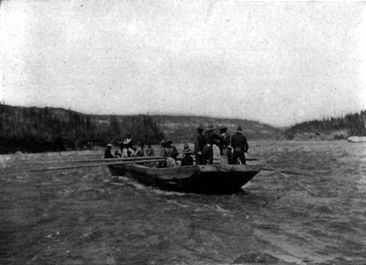
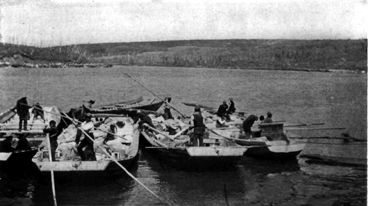
June 6th at a quarter of seven saw the whole populace of Athabasca Landing on the river bank—dogs, babies, the officials of the Hudson's Bay, parson, priest, police, and even the barkeep,—and with the yelping of dogs and "Farewell, Nistow!" we are off. We are embarked on a 2500-mile journey, the longest water route on the continent, down which floats each year the food, clothing, and frugal supplies of a country as big as Europe.
The river is running five miles an hour and there is no need of the oars. The steersman is our admiration, as with that clumsy stern-sweep he dodges rocks, runs riffles, and makes bends. The scow is made of green wood, and its resilience stands it in good stead as, like a snake, it writhes through tight channels or over ugly bits of water. Everybody is in good humour; we are dreamers dreaming greatly. Why should we not be happy? Mrs. Harding is homeward-bound, Mr. Brabant on a new rung of the fur ladder of preferment, Inspector Pelletier and his associates starting on a quest of their own seeking. Sitting low among the "pieces" of the police boat, with only his head visible in the sunset glow, Dr. Sussex builds air-castles of that eleemosynary hospital of his on the Arctic Circle. The cook is whistling from the cook-boat. Five years ago he graduated from a business college, but the preparation of bannock and sow-belly appeals to the blood more insistently than trial balances and the petty cash book. As for ourselves, the Kid's smile is almost audible as she runs a loving hand over the oilskin cover of the camera. A favourite expression of mine in the latitudes below when the world smiled was, "Oh, I'm glad I'm alive and white!" On this exclamation I start now, but stop at the word "white." North of Athabasca Landing white gives place to a tint more tawny.
A hundred yards out, the Policemen are boyish enough to launch those shiny Peterboroughs just to try them, and in and out among the big sturgeon-heads, debonair dolphins, they dart. Then comes the rain, and one by one the clumsy boats turn toward shore. There are some things that even the enquiring mind cannot run to ground, things that just happen out of the blue. For fifteen successive springs I have tried to discover the first boy who brought marbles to school when marble-season came in, and I have never yet been able to put my finger on that elusive history-maker. So on this voyage, the fleet is started and stopped, landings are made, camping-places decided upon, and no ear can detect the sound of command.
The scows tie up, and without undressing we sleep on board, pulling a tarpaulin over us and letting the rain rain. At 5:30 next morning we hear the familiar "Nistow! Nistow!" of the awakened camp. This word literally means "brother-in-law," but it is the vocative used by the Cree in speaking to anybody he feels kindly toward. The cook makes a double entry with bacon and bannock, and there is exulting joy in our soul. Who would napkins bear, or finger-bowls? We had put them far behind, with the fardels.
It is the season of lengthening days and fading nights. At seven o'clock we are in the river again, and for three glorious hours we float, first one scow in front, then the other, social amenities in Cree being shouted from boat to boat. Then, in one voice from three boats, "Mooswa!" and far beyond white man's vision the boatmen sight a moose. There is a little red tape about the ethics of taking off those precious Peterboroughs which were to make history on the map, and in the delay the moose wandered into pleasant pastures. The boatmen were very much disgruntled, as the moose is treasure-trove, the chief fresh meat that his world offers the Indian. From here to the Arctic are no domestic animals, the taste of beef or mutton or pork or chicken is unknown, bread gives place to bannock (with its consequent indigestion "bannockburn"), and coffee is a beverage discredited. Tobacco to smoke, strong, black, sweetened tea to drink from a copper kettle,—this is luxury's lap.
The bowsman points to a rude cross on the right bank where a small runway makes in, "Gon-sta-wa-bit" (man who was drowned), he volunteers. Yesterday a Mounted Policeman buried there the body of an Indian man, his wife and his baby, who fell through the ice in a dog-sled this spring,—three in one grave, Lamartine's trinity, the Father, the Mother, and the Child.
It is Sunday, and we have music from a li'l fiddle made by a squaw at Lac Ste. Anne. Lac la Biche River we pass, and Calling River, and at five in the evening are at Swift Current, Peachy Pruden's place, and then Red Mud. Sunday night is clear and beautiful, and we float all night. Making a pillow of a squat packing-case consigned to the missionary at Hay River, and idly wondering what it might contain, I draw up a canvas sheet. But it is too wonderful a night to sleep. Lying flat upon our backs and looking upward, we gaze at the low heaven full of stars, big, lustrous, hanging down so low that we can almost reach up and pluck them. Two feet away, holding in both hands the stern sweep, is the form of the Cree steersman, his thoughtful face a cameo against the shadow of the cut-banks. At his feet another half-breed is wrapped in his blanket, and from here to the bow the boat is strewn with these human cocoons. The reclining friend breaks the silence with a word or two of Cree in an undertone to the steersman, a screech-owl cries, from high overhead drops down that sound which never fails to stir vagrant blood—the "unseen flight of strong hosts prophesying as they go." It is the wild geese feeling the old spring fret even as we feel it. In imagination I pierce the distance and see the red panting throat of that long-necked voyageur as he turns to shout back raucous encouragement to his long, sky-clinging V.
Floating as we float, it is no longer a marvel to us that this North holds so many scientific men and finished scholars—colonial Esaus serving as cooks, dog-drivers, packers, trackers, oil-borers. The not knowing what is round the next corner, the old heart-hunger for new places and untrod ways,—who would exchange all this for the easy ways of fatted civilization!
At five in the morning there is a drawing-in of the fleet to Pelican Portage. Before two hours have passed the grasshopper has become a burden, and it is 102° in the shade, and no shade to be had. We are now a hundred miles from Athabasca Landing. On the left bank we come across a magnificent gas-well with a gush of flame twenty or thirty feet in height.
It seems that eleven years ago, seeking for petroleum, the Dominion Government had a shaft sunk here; their boring apparatus was heavy, the plunger with its attachment weighing nearly a ton. At eight hundred feet the operator broke into an ocean of gas, and the pressure blew him with plunger and appliances into the air as a ball comes from a cannon-bore. The flow of gas was so heavy that it clogged his drills with maltha and sand, and from then to now the gas has been escaping. To-day the sound of the escape ricochets up and down the palisaded channel so that we cannot hear each other speak. There is gas enough here, if we could pipe it and bring it under control, to supply with free illumination every city of prairie Canada. It has destroyed all vegetation for a radius of twenty yards; but, oddly enough, outside this range of demarcation the growth is more luxuriant and comes earlier and stays later than that of the surrounding country. One redheaded Klondiker, ignorant of gas and its ways, ten years ago struck a match to this escaping stream, was blown into the bushes beyond, and came out minus hair, eye-brows and red beard—the quickest and closest shave he ever had. The shells of birds' eggs, tea-leaves from many a cheering copper-kettle, tufts of rabbit-hair, and cracked shin-bones of the moose, with here a greasy nine of diamonds, show, this Stromboli of the Athabasca to be the gathering-place of up and down-river wanderers. You can boil a kettle or broil a moose-steak on this gas-jet in six minutes, and there is no thought of accusing metre to mar your joy. The Doctor has found a patient in a cabin on the high bank, and rejoices. The Indian has consumption. The only things the Doctor could get at were rhubarb pills and cod-liver oil, but these, with faith, go a long way. They may have eased the mind of poor Lo, around whose dying bunk we hear the relatives scrapping over his residuary estate of rusty rifle, much-mended fishing-net, and three gaunt dogs.
We pass House River, and the devout cross themselves and murmur a prayer. The point is marked by a group of graves covered with canvas. Here years ago a family of four, travelling alone, contracted diphtheria, and died before help could reach them. There is another legend of which the boatmen unwillingly speak, the story of the Wetigo, or Indian turned cannibal, who murdered a priest on this lonely point, and ate the body of his victim. The taste for human flesh, Philip Atkinson assures us, grows with the using, and this lunatic of long ago went back to the camps, secured an Indian girl as bride, carried her to this point, took her life, and ate of her flesh. It is a gruesome story.
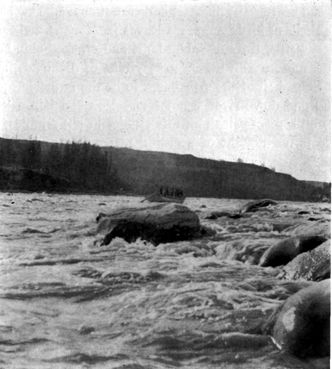
Now begin the rapids, ninety miles of which we are to run. This rough water on the Athabasca is one of the only two impediments to navigation on the long course between Athabasca Landing and the Polar Ocean. These first rapids, frankly, are a disappointment. The water is high, higher than it has been for ten years, so the boiling over the boulders is not very noticeable. The Pelican Rapid and the Stony we shoot without turning a hair; the Joli Fou is a bit more insistent, but, as the cook says, "nothing to write home about."
We drift in a drowsy dream of delight, and in the evening arrive at the head of Grand Rapids. If we had looked slightingly on the rough water passed, what we now see would satisfy the greediest. We tie up and get a good view of what lies ahead, and get also our first real introduction to the mosquito. In mid-stream he had not bothered us much, but after supper it rained a little, the day had been warm, and with cymbals, banners, and brass-bands, he comes in cohorts to greet us. The scows have their noses poked into the bank, the men have built smudge fires in front, but we decide that the best way to escape the mosquito is to go to bed. We lie down in the stern-sheets with our clothes on, make night-caps of our Stetson hats, pull the veils down over our necks, and try to sleep, but it is no avail. Each one of these mosquitoes is a Presbyterian mosquito and it has been ordained that this night he is to taste of white blood. It rains incessantly, and that hot hole in which we lie is one brown cloud of mosquitoes. The men on the bank have finally given it up as a bad job, and they set round the fires smoking and slapping different parts of their persons, swearing volubly in English. For the Cree language is devoid of invective. In the morning we are a sorry crowd, conversation is monosyllabic and very much to the point. It is the first serious trial to individual good-humour. When each one of your four million pores is an irritation-channel of mosquito-virus it would be a relief to growl at somebody about something. But the sun and smiles come out at the same time, and, having bled together, we cement bonds of friendship. What did Henry the Fifth say on the eve of Agincourt,—"For he to-day who sheds his blood with me shall be my brother"?
Who would worry about mosquitoes with that splendid spectacular of the Grand Rapids at our feet? The great flood (Kitchee Abowstik) is divided into two channels by an island probably half a mile in length, with its long axis parallel to the flow of the river, and this island solves the question of progress. The main channel to the left is impassable; it is certain death that way. Between the island and the right shore is a passage which on its island side, with nice manipulation, is practicable for empty boats. Then the problem before us is to run the rough water at the near end of the island, tie up there, unload, transfer the pieces by hand-car over the island to its other end, let the empty scows down carefully through the channel by ropes, and reload at the other end.
Between the bank where we are and the island ahead is a stretch of roaring water dangerous enough looking. We have learned ere this, however, to sit tight and watch for events. The careless Indians have straightened into keen-eyed, responsible voyageurs, each muscle taut, every sense alert. Our boat goes first, one half-breed with huge pole braces himself as bowsman, the most able man takes the stern sweep, the others stand at the oars. Fifteen minutes of good head-work brings us to the island and we step out with relief. The other boats follow and anchor, and we have opportunity at close range to inspect these worst rapids of the Athabascan chain. The current on the west side of the dividing island looks innocent, and we understand how the greenhorn would choose this passage-way, to his destruction.
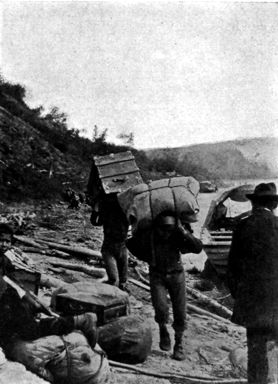
The transportation of pieces occupied four days, every moment of which we enjoyed. Grand Rapids Island is prodigal in wild flowers,—vetches, woodbine, purple and pink columbines, wild roses, several varieties of false Solomon's seal, our persisting friend dwarf cornel, and, treasure-trove, our first anemone,—that beautiful buttercup springing from its silvered sheath—
"And where a tear has dropt a wind-flower blows."I measured a grass-stem and found it two feet three inches high, rising amid last year's prostrate growth.
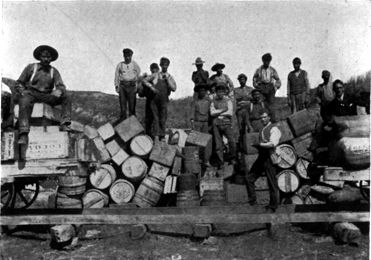
At Grand Rapids Island we overtook two scows which had preceded us from The Landing and whose crews had waited here to assist in the transport. It gave us opportunity to observe these sixty representative half-breeds from Lac la Biche. Tall, strong, happy-go-lucky, with no sordid strain in their make-up, they are fellows that one cannot help feeling sympathy for. A natural link between the East and the West, the South of Canada and the North, they have bridged over the animosity and awkwardness with which the Red race elsewhere has approached the White.
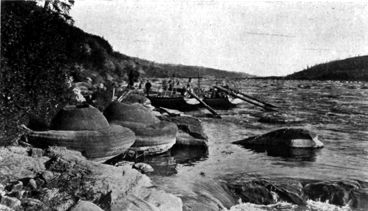
In a glade our camp is made, inside our tents we arrange the mosquito-bar (a tent within a tent looking something like a good-sized dog-kennel), and here we lie in our blankets. The hum of the foiled mosquito is unction to our souls. It is a relief, too, to remove the day's clothing, the first time in ninety-six hours.
The Athabasca here cuts through a cretaceous sandstone,—soft, yellowish, homogeneous. In passing Grand Rapids Island it has a fall of ninety feet. The river has weathered the banks into vertical cliffs four or five hundred feet high, imbedded in which are wonderful cheese-shaped nodules, some the size of baseballs, some as big as mill-stones. The river-bed is strewn thick with these concretions from which the swift current has worn the softer matrix away, and many of the stones are as spherical as if turned out by a hand-lathe. The sandstone banks opposite the island are overlain with a stratum of lignite three or four feet thick, which burns freely and makes acceptable fuel. Sections of fossil trees are also seen, and the whole thing is fascinating, one's great wish being for a larger knowledge of geology so as to read aright this strange page of history in stone.
Timber along the Athabasca has suffered much from forest fires. What we see is largely second growth,—Banksian pine, fir, spruce, birch, and aspen. The aspen is the first deciduous tree to leaf. Tall, slender, delicate, its bole is clean as an organ-pipe and its terraced feathery branches seem to float in air.
Across the roaring water swallows are nesting in the clayey cliffs:—
"This guest of summer,We learn that half-breeds share the Scottish superstition that it is unlucky to disturb bank-swallows.
Others of the migrant host travel in upper air more quickly than we on water, and have left us far behind,—swans, the Canada goose, great flocks of brant, waveys by the millions, followed by their cousins of the duck tribe,—spoon-bill, canvas-back, mallard, pin-tail, ring-neck, wood duck, and merganser. The geese will not stop until they have passed the Arctic Circle. Why people use the word "goose" as synonym for stupidity is beyond the ken of the ordinary observer. The text-books tell us tritely that the goose lives to be a hundred years. If she does, she may exclaim with the Churchmen, "Yet are my years but labour and sorrow." The little chaps who have their birthday parties among sub-Arctic reeds are surrounded with enemies from the first day they crack their baby shells. Lynx and raccoon prey upon them by land, eagles and owls swoop upon them as they swim; and as with one eye they scan the sky above them, a greedy pike is apt to snap their web-feet from under them and draw them to a watery grave.
The cadets of the Hudson's Bay Company exchange courtesies with the Mounted Police, each considering himself a distinct cut above the other. One Mounted Policeman, whose duty it had been to escort the crazed Russian Doukhobortsi on one of their "altogether" pilgrimages, is hailed across the circle, "Here, lend us your knife, you nursemaid to the Douks." "Who spoke?" yawned the Policeman. "Was it that fur-pup of the Hudson's Bay?" "Yes," retorted the first, "and I'm glad I'm it; you couldn't pay me to wear a red coat and say 'Sir' to a damned little Frenchman, even if you are going to blaze a trail to Hudson Bay."
Some one asks Sergeant Joyce to tell his Bible story. He says, "Oh, about Coal-Oil Johnnie! It was the cub's first year in the service, and he got off with some civilians and was drunk for a week. When he was in the Guard Room awaiting court-martial he had lots of time 'to sit in clink, admirin' 'ow the world was made.' Likewise he was very dry. There was nothing for him to amuse himself with but a paper of pins. He took the pillow of his cot and used the whole bunch of pins in working on it the one word 'Hagar,' in letters six inches high. The inspecting officer came in and the pin sign caught his eye. He spelled it out letter by letter, 'H-a-g-a-r,—what was the matter with him?' Johnnie retorted, 'The him was a her, and she died of thirst in the wilderness.' The inspecting officer says to Johnnie, 'Well, that would never happen to you.'"
A peculiar drumming wafts from the shore-line. "Pa-pas-ku," says one of the Cree lads, pulling his pipe from his mouth and listening. Young Hudson's Bay to my enquiring look returns, "The Canadian ruffed grouse," which Sussex elucidated, "Bonasa umbellus logata," at which we all feel very much relieved.
The Kid was pressing specimens, and, holding up a branch, the Mounted Policeman next her said, "Young jackpine, I think." "It belongs to the Conifer family," corrects the Doctor. "Oh!" says the Mounted Policeman, with a sniff, "then we'll give it back to 'em the next time one of the Conifer boys comes round." The man of the river and the woods hates a Latin name, and any stray classic knowledge you have is best hidden under a napkin. The descriptive terms men use here are crisp and to the point. The vicious habit of giving birds bad names is one that grows, and you never know when the scientific have come to a finality. For instance, little Robin Red-Breast ("the pious bird with scarlet breast" whose nest with four eggs the Kid discovered to-day), has successively lived through three tags, "Turdus migratorius," "Planesticus migratorius," and "Turdus canadensis." If he had not been an especially plucky little beggar he would have died under the libels long ago. For my own part I cannot conceive how a man with good red blood in his veins could look a chirky little robin in the eye and call him to his face a "Planesticus migratorius," when as chubby youngster he had known the bird and loved him as Robin Red-Breast. One is inclined to ask with suspicion, "Is naming a lost art?" Any new flower discovered these days, every clever invention in the realm of machinery, is forthwith saddled with an impossible name. If it had not been easy to clip the term "automobile" down to the working stub "auto," the machine would never have run our streets. Again, the decimal system is conceded to be far ahead of the asinine "five and one-half yards make one rod, pole or perch"; the only reason why the commonsense thing does not supersede the foolish one is that the sensible measurement has the fool tag on it. Who could imagine ever going into a store and asking for seven decimetres and nine centimetres of picture-moulding, or dropping into the corner grocery to buy a hectolitre of green onions? When man dug gold and iron and tin out of the earth he made things with them. Now when we discover a new mineral we dub it "molybdenum" and let it rust in innocuous ease. When man loses the art of nervous speech, his power of action goes with it. And as we ruminate, the Bonasa umbellus togata drums on.
When we pass the parallel of 55°N. we come into a very wealth of new words, a vocabulary that has found its way into no dictionary but which is accepted of all men. The steep bank opposite us is a "cut bank," an island or sandbar in a river is a "batture." A narrow channel is called a "she-ny," evidently a corruption of the French chenal. When it leads nowhere and you have to back down to get out, you have encountered a "blind she-ny." The land we have come from is known as "Outside" or "Le Grand Pays." Anywhere other than where we sit is "that side," evidently originating from the viewpoint of a man to whom all the world lay either on this side or that side of the river that stretched before him. When you obtain credit from a Hudson's Bay store, you "get debt." A Factor's unwillingness to advance you goods on credit would be expressed thus, "The Company will give me no debt this winter." From here northward the terms "dollars" and "cents" are unheard. An article is valued at "three skins" or "eight skins" or "five skins," harking back to the time when a beaver-skin was the unit of money. The rate of exchange to-day is from four skins to two skins for a dollar. Trapping animals is "making fur." "I made no fur last winter and The Company would give me no debt," is a painful picture of hard times. Whenever an Indian has a scanty larder, he is "starving," and you may be "starving" many moons without dying or thinking of dying. "Babiche" in the North is the tie that binds, and "sinew" is the thread, babiche being merely cured rawhide from moose or caribou, the sinew the longitudinal strands taken from either side of the spinal column of the same animals.
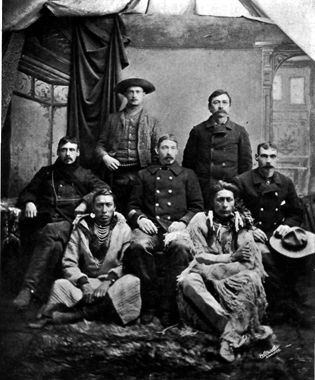
There is but one thing on this planet longer than the equator, and that is the arm of British justice, and the Mounted Police, these chaps sprawling at our feet, are the men who enforce it. The history of other lands shows a determined fight for the frontier, inch by inch advancement where an older civilization pushes back the native,—there are wars and feuds and bloody raids. Not so here. When the homesteader comes down the river we are threading and, in a flood, colonization follows him, he will find British law established and his home ready. The most compelling factor making for dignity and decency in this border-country is the little band of red-coated riders, scarcely a thousand in number. Spurring singly across the plains that we have traversed since leaving Winnipeg, they turn up on lone riverway or lakeside in the North just when most wanted.
Varied indeed is this man's duty,—"nursemaid to the Doukhobor" was a thrust literally true. His, too, was the task on the plains of seeing that the Mormon doesn't marry overmuch. He brands stray cattle, interrogates each new arrival in a prairie-waggon, dips every doubtful head of stock, prevents forest-fires, keeps weather records, escorts a lunatic to an asylum eight hundred miles away, herds wood bison on the Slave, makes a cross-continent dash from Great Slave Lake to Hudson Bay, preserves the balance of power between American whaler and Eskimo on the Arctic edge!
At one time the roll-call of one troup of Mounted Police included in its rank and file three men who had held commissions in the British service, an ex-midshipman, a son of a Colonial Governor, a grandson of a Major-General, a medical student from Dublin, two troopers of the Life Guards, an Oxford M.A., and half a dozen ubiquitous Scots. Recently an ex-despatch-bearer from De Wet joined the force at Regina, and although the cold shoulder was turned on him for a day or two, he soon made good. One of the young fellows stretched before us, now going to Fort Smith to round up wood bison, was born in Tasmania, ran away from school at fourteen, sheared sheep and hunted the wallaby, stoked a steamer from Australia to England and from England to Africa, and in the early days of bicycles was a professional racer.
Constable Walker, lying lazily on his back blowing blue spirals into the air, has in the long winter night made more than once, with dogs, that perilous journey from the Yukon to the Mackenzie mouth (one thousand miles over an unknown trail), carrying to the shut-in whalers their winter mail. On one of these overland journeys he cut off the tips of his four toes. His guide fainted, but Walker took babiche and, without a needle, sewed up the wound. On this trip he was fifty-seven days on the trail, during five days of which the thermometer hovered between sixty-two and sixty-eight degrees below.
This morning we are to leave the Island; it is June 12th and Friday. The daylight lengthens from day to day and last night at half past ten underneath the mosquito-bar within the tent, it was light enough to thread a needle. We have mending to do each night, and dragging clothes behind the boat makes a satisfactory kind of progressive laundry. At dusk we had seen an empty scow floating down river, adrift from Athabasca Landing. In the middle of Grand Rapids she broke amidships, but held together until in the darkness she floated beyond our ken.
Trouble of our own awaits us. With no one noting, an adventurous scow, with all her precious cargo, has pulled loose from her moorings. By the time the Cree watchman discovers that the "Go-Quick-Her" has taken the bit in her teeth, the runaway with tail-sweep set has turned the next corner of the Athabasca. Great excitement! Billy Loutit and Emile Fosseneuve borrow the Police canoe and go in chase. It is such a rough bit of water that we hold our breaths, for a false stroke means death to both; but that false stroke does not come. Billy Loutit knows this river as we know the borders and shrubs in our garden-bed.
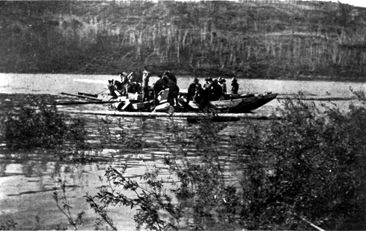
This accident causes everyone to look grave. The Edmonton value of the cargo is over two thousand dollars, but it is a loss that cannot be measured in dollars and cents. These wrecked goods, gaily sailing down the Athabasca, cannot be duplicated at some convenient grocery around the corner.
We have learned that any untoward happening means a half day's delay. Philip Atkinson calls me to one side to suggest that it would be a "clear waste" to leave behind the eggs of "that duck's nest I showed you the day we came." Atkinson is a half-breed with a Hercules-build who looks forty-five and owns up to sixty. He and I chatted over the mallard eggs and my collection of wild flowers, he respecting the preservative art and I in full awe of that art gastronomic of his which gulps the Mallards-in-embryo, sans fourchette, sans salt, sans ceremony.
They are an interesting study, these half-breeds; it means much to each on which side of the English Channel his father had birth. When a Frenchman marries an Indian woman he reverts to her scale of civilization; when a Scot takes a native to wife he draws her up to his. Our crew live at Lac la Biche and were engaged last winter for their season's work at from twenty to forty dollars a month, with board and moccasins. They walked a hundred miles to Athabasca Landing to connect with their summer's job, and the absolute certainty of regular meals just now appeals. They get three meals a day going with the current, and four while tracking back, with meals thrown in when anything unusual happens or a moose is killed. One cannot help wondering how that elastic term "the law of heredity" works out with these people, cut off from the lives their fathers led and from the free woods-life of the pre-civilization Indian.
Philip, duck-stuffed but untroubled by "that full feeling after eating," lights his pipe and looks back through the years. "My father belonged to The Company, my mother was an Ojibway from the Lake of the Woods country. My father went back to the Old Country when I was seven, leaving me to an uncle to be educated, and I don't know 'B' from a bull's foot. He put me to work on the woodpile from morning till night. When my father came back after twelve years and found me ignorant, he cried like a baby. I have no education, but," with a contemplative puff, "I have friends wherever I go." Philip is good to look at and he is a linguist, speaking Cree, French, and excellent English with a delightful Scotch accent. He is an ardent admirer of the H.B. Company. "They always kept their word with a man, and when they had done with him, returned him without cost to his old home." Philip and his two sons were the first to shoot the Grand Rapids, and he tells us that this stretch of the Athabasca River has been used only twenty years. Before that time people from the North reached Winnipeg by the Clearwater. Philip is a Loyalist. During the half-breed rebellion of 1885 he carried dispatches to Middleton and Otter, going seventy-five miles one day on foot. He had his horse, "a draught-horse as black as a crow," taken from him twice, got through the lines and stole another, and tells proudly how for his deed of valor he was presented with an Assomption belt.
At last we are off, keeping sharp look-out for the lost scow. Buffalo River, where we pull up for the night, is a recognized camping-place. The men know where to put their hands on old-time tent-poles, the boys dig out shin-bones of the moose,—the relics of some former feast,—which they gnaw as a puppy mumbles an old bone.
Another manifestation of gas is here. It bubbles up on the shore and through the water at the boat's bow, and as we strike a match the whole surface flames like the brandy on a Christmas plum-pudding. On the opposite side of the river are "lobsticks," a new word to us and a new thing. To stand as a living totem-pole, the Indians select on a striking promontory a tall spruce and from a section of the trunk lop all the branches except two, which are left as wings. If the lobstick is to stand a monument to a certain man or party, the names of those to be honored are written in Cree on an attached slab. We were to notice lobsticks from point to point along the rest of our journey, some of them indicating good hunting-grounds or fishing-places back from the shore, but most of them memorials of happenings on the river.
The Little Buffalo carries to the Athabasca its noisy current between two high escarpments, and on the shelf leading back from the banks of the main stream is a far-reaching plateau of splendidly-fertile land. In the scow next us the two young Crees who are preparing the food for our evening "meat-su" carry on a religious controversy as they slice the sow-belly. We gather that one has been taken into the Protestant fold and that the other follows the priests. Duncan Tremblé comes down and cuffs them both soundly, putting an end to the argument with, "It's all the same as the other, just like the Hudson's Bay Company and the free trader. Each one tells you his goods is the best and the other is nee-moy-yuh mee-wah-sin (no good). It's that way with the God-goods of the white men. Each church tells you that his is the best, but they all come down to us in the same scow, both the priest and the missionary."
Next morning we are all keyed-up for the rapids, and about six miles down we encounter the Brulé, the first one, and take it square in mid-channel. We ship a little water, but pass through it all too soon, for the compelling grandeur of the Brulé grips one. The river here is held between vertical walls of the reddest of red sandstone against which the lush greenery makes a striking contrast. Twenty miles below is the Boiler Rapid. It got its name not from its churning water but because the boiler of the steamer Wrigley was lost here and still remains at the bottom of the basin. The walls of this rapid are as clear-cut as if wrought into smoothness by mallet and chisel. The tar-soaked sands appear off and on all the way to McMurray. Next comes the Long Rapid (Kawkinwalk Abowstick), which we run close to its right bank.
From the distance sounds the ominous roar of the Big Cascade. At quarter past four we reach the head of the swirling fall. The underlying cause of the Big Cascade is a limestone ledge which cuts the channel diagonally and makes ugly-looking water. We plan to run the rapid one boat at a time. The crews are doubled. Our steersman is alert, expectant, and as agile as a cat, his black hair switching in the wind. Sitting in the centre of the scow, as we do, the sensation is very different to that which one experiences in running rapids in a canoe. Then it is all swiftness and dexterity, for your craft is light, and, in expert hands, easily dirigible with one clever turn of the wrist. With a ten-ton scow the conditions change and you feel correspondingly more helpless.
The great rapid stretches from shore to shore and the drop is sheer. With much excitement, the bowsman points out the channel that seems to him the safe one. No one speaks, and the big awkward craft is brought up for the jump. It is an elephant drawing his feet together to take a water-fence. For all we own in the world we wouldn't be anywhere but just where we sit. If it is going to be our last minute, well, Kismet! let it come. At least it will not be a tame way of going out. For the life of me I cannot forbear a cry of exultation. Then there is the feeling below one's feet which you experienced when you were a kiddie lying flat on your stomach coasting down a side-hill and your little red sled struck a stone. We, too, have struck something, but do not stop to ask what the obstruction is.
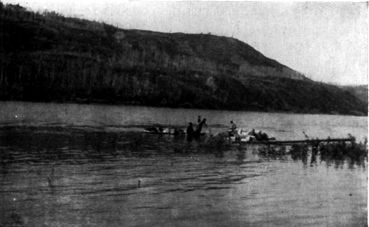
At the foot of the rapids, we hurry the boatmen ashore. I want to photograph the next scow as she shoots the fall. We reach a good vantage-point and, getting the coming craft in the finder, I have just time to notice that her passengers are Inspector Pelletier and Dr. Sussex, when a sharp crack rings out like the shot of a pistol. Just as we touch the button, something happens. We wanted a snap-shot, and it was a snap-shot we got. The scow has broken her back and begins to fill.
The blue-and-white jerkin of Isadore Tremblé, the pilot, dances in the sun as he gesticulates and directs his two passengers to crawl to the top of the boat's freight. In less time than it takes to write it, the men from our scow have launched the police canoes and make their way through the boiling water to take off Pelletier and the Doctor. The Inspector says, "Step quick, Doctor, there's no time to waste." The native politeness of Sussex doesn't fail him, even in this crisis, "After you, Inspector." Then Pelletier says, sharply, "Jump, I tell you, jump; there's no time for—Gaston-and-Alphonse business here."
As always, it is impossible to tell who directs affairs, but quickly things happen. Lines are run from the wreck to the shore, other scows discharge their cargo on the bank and push out to take the water-logged goods from the wreck. The lightened craft is pulled ashore. There has been no loss of life, but it is a sorry-looking cargo that piles up on the bank,—five thousand dollars' worth of goods destroyed in three minutes!
A sad procession, we make the boats, and drop downstream toward McMurray. The night is beautiful. The sun sank in a crimson splendour an hour ago. A low-hung moon comes out and is visible and is hidden alternately as we pass on the shore-line high hill and intervening swale. With a blanket thrown over me, as the others sleep, I lie along the gunwale, and the beauty of it sinks into my very soul. Just before we enter McMurray the wraith of a tall oil-derrick tells of the enterprise of some pioneer in the wilderness.
The location of Fort McMurray is ideal. At this point the river breaks into two branches which encircle a high-banked and thickly-wooded island. Some hundreds of yards farther on the Clearwater River makes in; so here we have three streams. The fort has a foundation dating back forty years. This fur outpost will be the terminus of the Alberta and Great Waterways Railway, and one could not well imagine a more beautiful site for a great city. On the broad flat as we enter appear a handful of Indian houses and the little stores of the fur-traders.
Letters from the outside are not as eagerly looked for as one would expect. To the people who live within the North, the North is their world, and to them the news of who is to be appointed to the charge of the next post down the river is of more, importance than the partition of Turkey or a possible redistribution of the thrones of Europe. Mr. Brabant says, "Oh, by the way, Bob, there is a package of letters for you somewhere in the scow. Shall I dig them out for you?" "Never mind," says Bob, "I'll get them to-morrow. Have you got any whiskey?"
It is Sunday the fourteenth of June. On the long beach is strewn the water-soaked cargo of the wrecked scow, the abomination of desolation. Mrs. Harding, although all of her personal belongings and her "special orders" are ruined, smiles bravely. It is a point of honour in the North not to whine, whatever happens. All day we work trying to save some of the wrecked cargo. Bales of goods are unwound and stretched out for hundreds of yards in the sun. Bandanna handkerchiefs flutter on bushes. Toilet soap, boots, and bear-traps are at our feet. The Fire-Ranger of the district, Mr. Biggs, has his barley and rice spread out on sheeting, and, turning it over, says bravely, "I think it will dry." Mathematical and astronomical instruments consigned to a scientist on the Arctic edge are shaken off centre and already have begun to rust, and there are miles and miles of cordage and nets, with braids and sewing silks and Hudson's Bay blankets!
In the midst of his wrecked drugs and cherished personal effects the Doctor is a pitiful sight. By stage and by scow, he has been confiding to us that, in order to save bulk, his medicines have been specially put up for him in highly concentrated form by London chemists. One little pill-box of powder is potent enough to make a dozen quart-bottles of effective medicine. And now all these precious powders have melted together, and appear like Dicken's stew at the Inn of the Jolly Sand-boys "all in one delicious gravy." The Doctor is dazed, and offers to white and brown alike a tin box with "Have a pastile, do." He wanders among the half-breeds, offering plasters for weak backs, which they accept with avidity as combining two things that the red man specially appreciates,—something free and something medicinal. Sad-faced, the Doctor brings to me a glass case holding a dozen lozenge-shaped disks on each of which an infinitesimal piece of wood rests. "Here are some authenticated relics, but unfortunately the water has made them run and I don't know them apart. You see they have the seal of the Carthusian Monastery on the back. One of them is a piece of the true Cross, but I shall never be able to tell which it is." One by one the Doctor digs out from the wreck his water-soaked treasures,—a presentation "Life of the Countess of Munster," also a crucifix from her, and a beautifully-carved holy water stoup of French design which he declares to be "as old as the Conqueror." There is a medal of the Worshipful Company of Cutlers which carries with it the freedom of the City of London. Another order shows the Doctor to be a Knight of the Primrose League; and, fished from under a side of bacon, is a print of "my great-grandfather who discovered a cure for scurvy." A missionary's box of toys for some Christmas tree in Far North fastnesses is opened, and here a native stops work to lead along the sand a pink-and-blue alligator.
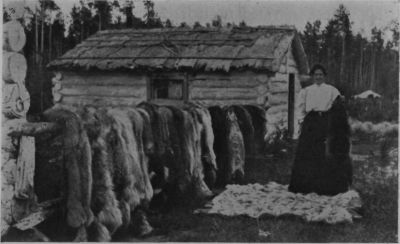
Although the wrecked scow has its grotesque features, the sight is a sad one, and we are glad to leave it and pull across the river to Fort McMurray. We call upon Miss Christine Gordon, a young Scottish woman and a free-trader, if you please, in her own right, operating in opposition to the great and only Hudson's Bay Company. The only white woman on a five hundred mile stretch of the Athabasca, she has lived here for years with the Indians for companions, her days being marked out by their migrations and tribal feasts. We question, "Are you not lonely, especially in the winter?" But she smiles and refuses to be regarded as heroic. "Often in the winter a trapper passes through, and the Indians are always coming and going, and they are full of interest."
We have not walked with Miss Gordon for half an hour among the tepees when we discover the secret of her cheeriness and content. Our happiness consists not in our havings but in our attitude of mind. The world is divided sharply into two classes. The classes are not the white and the black, the good and the bad, the sheep and the goats, as the orthodox would have us believe. We are all good and bad, not black or white, but varying shades of grey. Neither are we sheep or goats, but moral alpacas, all of us,—something between a sheep and a goat. But no less are we divided into two clear-cut classes. Each of us puts himself of his own volition into the class of the self-centred, or the self-forgetting, and in the act marks himself as happy or unhappy.
As Miss Gordon lifts the tent-flaps, smiles greet her from every home. The baby in the moss-bag is handed up for her inspection, and old blind Paul Cree, the Chief, knows her moccasined step, and rises on his elbow from his couch of spruce-boughs to greet her eagerly and salute any that she may present as friend. The Chief is in his ninety-sixth year and depends upon chance visitors for his companionship and food. Yet an assured air of dignity shows that Paul Cree is aware of the respect due to the Chief of the McMurrays. He addresses us in Cree, which Miss Gordon translates. "I am delighted that ladies have come such a long distance on purpose to see me. The white man is my friend. I think all white women must be good. Their mothers have taught them to be kind to old people. I am sorry I am blind. Be glad that you can see the water, the sky, the birds and flowers and the faces of little children," and the tired old head sinks on the fir-boughs and we are dismissed. "Be glad you are alive, and use that sight while you have it." It is the advice given by that other strong man laid on his back, Carlton in the Winnipeg Hospital.
We are joined by Paul Cree's brother. He has long hair, and wears a pair of pince-nez as an English gallant wears his monocle—merely for effect, for there is nothing the matter with the vision of those sharp eyes. In one tepee a young mother is reading a service book of the Roman Church to her little girl of five. Across the plateau under the shadow of the hill we enter a camp where Miss Gordon has a patient with an injured hand. The cut is ugly and is surrounded by proud flesh, and we find that twice a day Miss Gordon leaves her household work and her little store to go across and dress this wound.
When a schoolboy takes to his bosom a fidus Achates, the first thing he does is to offer to show his birds' nests; so Miss Gordon introduces us to her find,—nests of the Gambel sparrow. We take two views, one of a nest of five eggs and another of the nesting mother.
During the past winter Miss Gordon has fed the Indians in families, as they had "made little fur," entertaining them as courteously as you would your special friends at an afternoon of pink tea and pink thoughts. Visiting the sick, trading fur, cultivating her little garden, bringing wolf pups and bear cubs up by hand, thus this plucky woman passes her days. It takes the adaptability and dour determination of a Scot to fit into this niche. Your Irishwoman would last in McMurray just about three days.
A new duty has been taken on by Miss Gordon,—the reading of the rain-gauge just installed by the Canadian Government. Slyly taking a peep into her records, we feel that they will have to be adjusted to the latitude of Ottawa when they get there, for with a true Northern contempt for fractions she has made all the decimals read as full fractions. The outside world which feasts on blue-books is apt in the future to be startled at the generous precipitation accorded Fort McMurray! Miss Gordon's ambitions run in other lines than the mathematical. Holding us by both hands as we bade good-by, she said, "Oh, that I were young again, I would learn, learn, learn. I would learn medicine so that I could help these poor creatures." Her tone of unselfish sincerity we carry with us as we make our way back to the scows, bearing with us, as token of good-will from the Gordon garden, radishes and lettuce for an evening salad.
Next morning we start bird-hunting on our own account, and get a pair of pictures as striking as those we have Miss Gordon to thank for—a Foxsparrow on the nest, then the baby sparrows but one day old. If any one thinks it easy to find and photograph birds' nests in the heart of the ancient wood on Athabascan banks in mosquito time he has "another guess coming." The mosquito here is not a joke, not a theorem, but a stinging entity. During the five days we are at Fort McMurray the potatoes in Miss Gordon's garden have grown as many inches, literally an inch a day. Wood violets, wild roses, false Solomon-seal, and the wild sarsaparilla are everywhere; the air is full of the scent of growing things.
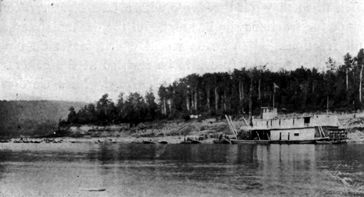
Fort McMurray is the parting of the ways where the Hudson's Bay Company's steamer Grahame meets us, bringing her tale of outward-going passengers from the North. The journey of these people from Fort McMurray to The Landing is going to be a very different thing from the easy floating with the current that we have enjoyed. All northern rivers are navigated against stream by "tacking," that is, towing the boats, weary mile after mile, "by the power o' man," the half-breed boatmen scrambling now on the bank, now in the water, tugging the heavily-laden craft after them. It is a mode of transportation that neither written word nor camera can do justice to. We shake hands with those going out to civilization and take our dunnage aboard the steamer. The Grahame has its advantages,—clean beds, white men's meals served in real dishes, and best of all, a bath!
On the Grahame we meet Mr. Harris, of Fond du Lac, who has come thus far to greet the incoming transport and who goes back again with it. Scholarly and versatile, we are to find in Mr. Harris a very mint of Indian lore and woodland wisdom and the most wonderful memory I have ever encountered. All the vicissitudes of a Northern life have failed to rub out one line of the Virgil and Horace of his schoolboy days, whole chapters of which, without one false quantity, he repeats for us in a resonant voice. He can recite the whole of "Paradise Lost" as faultlessly as Macaulay was credited with being able to do. If Mr. Harris could be induced to write a story of the North it would put to shame all the weak efforts of one-season visitors who of necessity see only the surface and have to guess the depths.
As we pull out, we mentally run our fingers along the parallel of 56° 40' North to find out by comparison, as they say in Chicago, "where we are at." In Europe we would be on the top of Ben Nevis and not so far north as Aberdeen. Our line of latitude run westward will cut Sitka, and the lone Pribilof, "where the little blue fox is bred for his skin and the seals they breed for themselves." Crossing the junction of the Clearwater with the Athabasca, we strike for the first time the trail of Sir Alexander Mackenzie, who came in by Portage la Loche, and in 1789 traced to the sea the great river which bears his name. At its confluence with the Clearwater the Athabasca is perhaps three-quarters of a mile wide, and it maintains a steady current with a somewhat contracting channel to the point of its discharge into Lake Athabasca in latitude 58° 36' North.
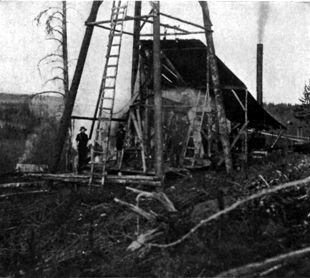
In all Canada there is no more interesting stretch of waterway than that upon which we are entering. An earth-movement here has created a line of fault clearly visible for seventy or eighty miles along the river-bank, out of which oil oozes at frequent intervals. Count von Hammerstein, building derricks from point to point along the stream, has put in much time, toil, and money in oil-development here. Our traverse of those ninety miles of Athabasca Rapids has given us respect for the labor and determination which in this wilderness has erected these giant derricks. Looking at them, we waft a wish that the plucky prospector may reap his reward and abundantly strike oil. The Count tells us of striking one hundred and fifty feet of rock salt while "punching" one of his oil-shafts through the ground. Here are overhanging dykes of limestone; and out of the lime and clay shoot up splendid trees of pine, poplar, and spruce.
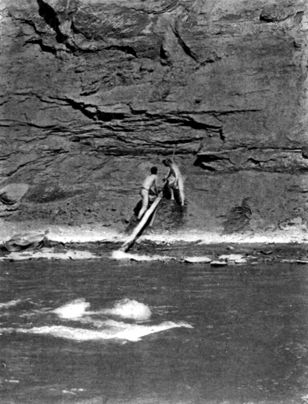
At Fort McKay, thirty miles below McMurray, a fine seam of coal is exposed on the river-bank. It is bituminous, and can be used for blacksmithing, but probably not for welding. Ochre is found on these banks, with sand of the very best quality for making glass, while extensive sulphur deposits have been discovered on the east side of the river between Fort McMurray and the lake. On the Clearwater are medicinal springs whose output tastes very much like Hunyadi water.
Tar there is, too, in plenty. Out of the over-hanging banks it oozes at every fissure, and into some of the bituminous tar-wells we can poke a twenty foot pole and find no resistance. These tar-sands lithologically may be described as a soft sandstone, the cementing material of which is a bitumen or petroleum. They are estimated to have a distribution of over five hundred square miles. Where it is possible to expose a section, as on a river-bank, the formation extends from one hundred and twenty-five to two hundred feet in depth, the bitumen being distributed through the sands.
Twelve miles below the last exposure of the tar-sands and about two miles above the mouth of Red Earth Creek a copious saline spring bubbles up, and there is an escape of sulphurretted hydrogen whose unmistakable odour follows the boat for half a mile. Kipling was right when he said, "Smells are surer than sounds or sights."
We speak only of what we observe from the deck of a boat as we pass down this wonderful river. What is hidden is a richer story which only the coming of the railroad can bring to light.
At seven in the morning of Sunday, June 21st, we enter Lake Athabasca, and catch our first glimpse of Fort Chipewyan. An acceptance of the invitation, "Come, shake your leg," has kept the men busy half the night over a hot sequence of Red River jigs among "pieces" on the lower deck, and we have this superb sweep almost to ourselves.
The great lake-scape is blue and green and grey and opaline as the sun strikes it and the surface breaks to a south wind. Ours is the one craft on this inland sea, but overhead a whole navy of clouds manœuvres, the ships of the ghostly argosy doubling themselves in the lake. As we draw in, the village takes shape. What haunts us as we look at the white houses, that crescent beach of pinkest sand? We have it! It is a print, an old woodcut of "Russian America" that we used to pore over in the days when one wore "pinnies" of flour-sacking, and "hankies" were made from meal-bags.
At one end of the village are the little smithy of the Hudson's Bay Company and the pretentious buildings of their establishment. At the other gibbous horn of this Athens of the Athabasca rise the steeples and convent-school of the Roman Church, with the free-trading-post of Colin Fraser. Midway between is the little Church of England, and higher up and farther back the Barracks of the Royal Northwest Mounted Police. The white-washed homes of the employés of The Company, little match-boxes dazzling in the sun, stretch from one end of the beach to the other. In among the half-breed populace stalk policeman and priest, red jacket keeping the dark-skinned people straight in this world and black robe laying out conditions for the world to come. So is Chipewyan fate chequered with the rouge et noir of compulsion and expediency.
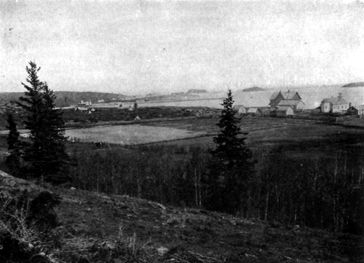
Fort Chipewyan is the oldest post in the North, and every boulder of red gneissic rock, if we could interrogate it, has a story to tell. Peter Pond, of the North-West Company, in 1778 built a post on the Athabasca River thirty miles to the south of the lake. The far-seeing Alexander Mackenzie, in the interests of the same company, sent his cousin Roderick ten years later to build Fort Chipewyan on the lake, and for over a century this was the entrepôt and emporium of the whole North. The Hudson's Bay Company meanwhile were maintaining a post, Fort Wedderburne, not far away on Potato Island, and upon the amalgamation of the Companies in 1821 they took possession of the present Fort Chipewyan.
This metropolis is one hundred and twenty years old. Chipewyan was doing business at the same old stand before Toronto was the capital of Upper Canada, while Ottawa was still unheard of, and when of Chicago not even the Fort Dearborn nucleus had been built. 1788! We wonder if the old ox that conveys our "cassette" and "pieces" up to the big gateway of The Company's quadrangle was a drawer of wood and drinker of water at that date. He looks as if he might have been. George III was reigning in England when Fort Chipewyan was built, Arkwright was making his spinning jenny, and Watts experimenting with the steam-engine. Sir Joshua Reynolds painted his pictures, Burns, a young man of twenty-nine, was busy with his ballads. In London a little baby saw the light of day, whom the world afterwards hailed as Lord Byron. Three British boys might have been seen with arms thrown over each other's shoulders, "dreaming greatly"—Coleridge aged sixteen, young Walter Scott, seventeen, and Wordsworth just eighteen. Across the Channel the French Revolution was at its height. Shelley and Keats were not yet born. Down on the Atlantic seaboard of America a new people just twelve years before had gone through the birth-throes of nationhood. It is a far call.
Scraping the yellow lichens off the old sun-dial, we adjust our bearings. We are 111° West of Greenwich and in latitude 58° 45' North. Our parallel carried eastward would strike the Orkneyan skerries and pass through Stromness. All untouched by the development of that busy continent to the south which has grown up within its lifetime, Chipewyan is a little pearl of the periwigged days of the early Georges. From its red sands, tamarack swamps, and mossy muskeg one almost expects to see arise the forms of those great of old who outfitted here, making Chipewyan the base of their northward explorations. The ghostly company is a goodly one—Sir Alexander Mackenzie, Sir George Simpson, and Sir John Franklin (their honorary prefixes coming to them in the after days as reward of their labors), Back and Richardson and Rae, and in later days that young stripling curate who was afterwards to be known throughout the world of letters as Bishop Bompas, the "Apostle of the North." Then there is the great unnamed horde who rested tired limbs at Chipewyan on their northward journeys, each on his own mission—fur-traders and hunters of big game, devoted nuns and silent priests, the infrequent scientist, and the hundreds of Klondikers, their hearts hot with the greed for gold. These all through the century have enjoyed as we now enjoy the spontaneous hospitality of this little bit of Britain which floats the Union Jack from its fort walls, and whose people, brown and white, when the belated news of the passing of Victoria the Great reached this her northern outpost, gathered on the beach and bewailed aloud their personal loss. We seem to hear again the far-flung cry "The Queen is dead! The Queen is dead!" from the half-breed runners coming in that Christmas Day across the winter ice.
Mackenzie made Chipewyan his headquarters for eight years. It was from here he started on his voyage to the Arctic Sea in 1789, and three years later on that other history-making journey to the far Pacific. Sir John Franklin outfitted here for his two land-journeys—in July, 1820, with Dr. Richardson, and again in 1825. Chipewyan is a mine of interest. We almost begrudge time given to the dainty meals of our hostess, Mrs. William Johnson, and the hours spent between her lavender-scented sheets.
In the loft above the office of the H.B. Company, in among old flintlock rifles and discarded ox-yokes, we browse through the daily records of The Company, old journals written by the Factors at the close of their day's work through the years and here preserved for our inquisitive eyes. Sitting on the floor, making extracts from these tomes, one has the half-guilty feeling of being caught poking into a tomb.
On this page the ink is thin and one can see the old writer thawing out his frozen ink-pot of stone at the end of a tired day and sitting down to write his simple tale. Here are finger-marks where the blood of a buffalo gives a marginal note. The journalist had been called away from his writing to weigh and pay for some fresh meat. Drops from a tallow candle show the light of other days. A pressed mosquito of the vintage of 1790 is very suggestive. We picture the trivial round and common task of the man who writes, see him exchanging fathoms of tobacco for beaver-pelts in those long, cold winters, and eagerly hunger with him for the signs presaging the going-out of the ice and the coming-in of Spring. We follow out the short Summer with him and revel in its perpetual daylight. With him we make the fall fishery and shoot our winter's supply of waveys and southward-flying cranes. We wonder, as he wondered, what news the next packet will bring from the old folks in the Orkneys or the Hebrides. We study, as he studied, the problem of governing his servants, placating the Indians, and making enough fur to satisfy that inexorable Board of Directors back in London whose motto is "Skin for skin."
It has been a grim enough life as the author of this journal records it. He is far from those who direct his fate, and recognition and reward are slow in coming. Companionship and the gentle arts of "outside" are denied him. He must make his own world and rear within it his dusky brood, that they in honourable service may follow his round of "work done squarely and unwasted days." What made the charm of this life to these men? It is hard to see. The master of the post was also master of the situation, and an autocrat in his community, a little Fur King, a Captain of Industry. A thing was law because he said it. And isn't it Caesar himself who declares, "Better be first in a little Iberian village than second in Rome?"
We get a delightful picture in an entry under the date of Wednesday, 23rd May, 1827, when Sir John Franklin was on his way back to England at the end of his second journey.
"To-day William McGillivary and Katherine Stewart, daughterGreat is the force of example, for five days later appears the entry
"This evening the ceremonial of marriage took place betweenLooking at these records, we are reminded of a not-very-well-known story of international courtesy which connects itself with the third and ill-fated journey of Franklin. Old Sir John, then in his sixtieth year, had sailed from England in an attempt at the Northwest Passage. Years passed and no word came from the explorer, and in 1852 the ice-desert was still mute.
In this year, Sir Edward Belcher in the Resolute headed one of the many Arctic Relief Expeditions, subsequently abandoning his boat in the ice off Melville Island. Next year the American whaler Henry George met the deserted Resolute in sound condition about forty miles from Cape Mercy; she must have drifted through Barrow Strait, Lancaster Sound, and Baffin Bay. She was recovered, the Government of the United States bought her and with international compliments presented her in perfect condition to Queen Victoria in 1856. The old ship was broken up about thirty years ago, and from the soundest of her timbers a solid desk was made by direction of Queen Victoria, who presented it to the then President of the United States. This is the desk which stands in President Taft's reception room to-day, and on it the papers of eight administrations have been written.
There is living as well as buried history in Chipewyan. A stroll from one end of its lacustrine street to the other is lush with interest. We call upon Colin Fraser, whose father was piper to Sir George Simpson. Colin treats us to a skirl of the very pipes which announced the approach of Simpson whenever that little Northern autocrat, during his triumphal progress through a bailiwick as big as Europe, made his way into a new fort.
With the echo of the "Gay Gordons" in our ears we pass into the largest convent in the North country, managed by the Grey Nuns of Montreal. Sister Brunelle came into the North in 1866. Forty-two years in a convent-school of the Northland! It makes one gasp.
These Indian schools, assisted by the Canadian Government, catch the little Indians in the camps and hold their prey on school-benches from the age of four to fourteen. One boy is dumb, another a hunchback. In a corner we came upon a poor old derelict of the camps, a Cree woman, paralysed and mentally deranged, who within these quiet walls has found harbour. The kiddies are taught one clay in French and the next day in English; but when they hide behind their spellers to talk about the white visitors, the whisper is in Chipewyan. What do they learn? Reading, (vertical) writing, arithmetic, hymns, and hoeing potatoes, grammar, sewing and shoemaking, and one more branch, never taught in Southern schools. When the fall fishery comes, the nuns kilt up their skirts, slates are shoved far back into desks, and shepherdess and sheep (young brown moose!) together clean the whitefish which are to furnish meals for a twelve-month to come. If fish be brain food, then should this convent of Chipewyan gather in medals, degrees, and awards, capturing for its black-eyed boys Rhodes scholarships ad lib.
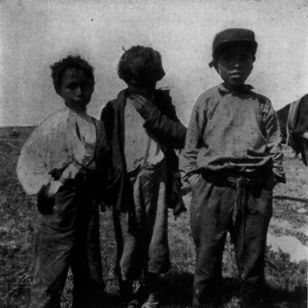
Back of the convent stretches a farm with an historic record. It was from this enclosure, tilled by the priests and their protégés, that the sample of wheat came which at the Centennial Exposition in Philadelphia in competition with the wheats of the world took the bronze medal. This wheat ran sixty-eight pounds to the bushel.
We linger in the convent, looking at the rows of tiny beds neat and immaculate, each covered with its little blue counterpane. Sister Jigot, with the air of divulging a state secret, tells that the pretty bed-covering is flour-sacking, that it is dyed on the premises from a recipe brought out of Chipewyan woods. In the long winter evenings these good step-mothers of savages do all their reading and sewing before six o'clock. The mid-winter sun sinks at four, and two hours of candle-light is all that the frugal exchequer can afford. "What in the world do you do after six?" I venture; for well we know those busy fingers are not content to rest in idle laps. "Oh! we knit, opening the stove-doors to give us light." Many a time are we to throw a glance backward through the years to these devoted souls upon Athabascan shores, trying to graft a new civilisation on an old stock, and in the process economising their candles like Alfred of old.
Both Protestant and Roman missionaries are amateur doctors and we find a stimulating rivalry in bodily and spiritual ministrations. At the Church of England Mission we are shown with triumph a piece of bone salved from the leg of an injured Indian. Afterward we learn that the peripatetic patient accepted the Church of England treatment in the daytime, and in the evening shadows was carried across the rocks to the shrine of Rome. Poor chap, he died in the process! But while he lived he stimulated trade, and his memory lingers to point a moral and adorn a tale. If there had but been a Presbyterian Church within range, he might have comforted himself with the thought that it had all been comfortably fore-ordained.
An interesting family lives next to the English Mission—the Loutits. The father tells of the days when as a young man he served The Company, and "for breakfast on the march they gave you a club and showed you a rabbit-track." There were Loutits in Chipewyan as far back as the old journals reach. The Scottish blood has intermingled with that of Cree and Chipewyan and the resultant in this day's generation is a family of striking young people—the girls good to look at and clever in bead-work and quill-ornamentation, the boys skilled in nemoral arts and holding the strong men's records of the North.
George Loutit without help brought a scow with four thousand pounds from Athabasca Landing to Chipewyan through the ninety miles of rapids. His brother Billy, carrying a special dispatch of the Mounted Police, ran with a hand-sled (and no dogs) from Chipewyan to Fort Smith and back in three days—a distance of two hundred miles at least. Once, when the river rose suddenly in the night, Billy unloaded nine tons from one scow to another, astonishing the owners, who snored while Billy was toiling upward in the night. The rivermen tell of George Loutit's quarreling with a man one afternoon in a saloon at Edmonton and throwing his adversary out of the window. When he heard him slump, George immediately thought of the North as a most desirable place and started hot-foot for Athabasca Landing, a hundred miles away. He arrived there in time for noon luncheon next day.
At the H.B. Co. end of the village we find Pierre Mercredi in charge. A French Bishop once wanted to train him for the priesthood, but it is peltries and not souls that Pierre is after. His forebears were Irish McCarthys, but this name failed to fall trippingly from the tongue of French priests, and became corrupted into the Mercredi as he now signs it.
Throughout the journals of the last forty years we run across such entries as these:—"Wyllie at the forge," "Wyllie making nails," "Wyllie straightening the fowling-pieces," "Wyllie making sled-runners," "This day Wyllie made a coffin for an Indian." We step into the old man's smithy, and he turns to greet us with an outstretched hand and a "Good mornin'," in richest Doric. The date 1863 cut into the wooden foundation of his forge marks the year when Wyllie came to Chipewyan. He was born in the Orkneys, and had never seen a city in the Old World. Coming out to America in a sailing vessel of The Company by way of Hudson Bay, he threaded the inland waterway which brought him to Chipewyan without seeing a city in America. Torontonians think the hub of the universe is their capital on Lake Ontario. A smart young man from Toronto filtered in one day to Chipewyan, and asked the old blacksmith, "Came from the Old Country, didn't you? What did you think of Toronto?" "Naething, I didna see the place."
Mr. Wyllie has never seen an electric light nor a railway train nor a two-story building nor a telegraph wire nor a telephone. In the forty-five years in which he has presided over this forge, the limits of his wanderings have been McMurray on the south, Fort Smith on the north, Fond du Lac on the east, the Chutes of the Peace on the west. To him these are innocuous days of ease, in which we are falling into luxuriousness with all its weakening influence. "It was much better in the old days when we had only dried meat and fish-oil. Nowadays, when we have flour and tinned meats and preserved fruits, all my teeth are coming out!"
No one feels like smiling a smile of superiority in talking with old Mr. Wyllie. He has taught himself the gentle arts of gunsmithing and blacksmithing. The tools that we see all around us are marvels of mechanical skill and would be the joy of a modern Arts and Crafts Exhibition. His sledges and augurs, planes and chisels have been made by the old man out of pig iron which came as ballast in the holds of those old sailing ships which beat their way into Fort Churchill through Hudson Strait. The hand-made tools are set into convenient handles of moose-horn and bone. Clever indeed is the workmanship that Wyllie has done with them. The last triumph from this unique forge was the welding of the broken shaft of the little tug Primrose. The steamer Grahame was built at Chipewyan of whipsawn lumber, and much of her steel and ironwork was wrought on Wyllie's forge.
Wyllie left the Scottish Isles when a mere lad, but they are still "Home" to him and he tells us that this autumn he is going back on a visit. It was a prototype of Wyllie's
"From the lone sheiling and the misty island,who prayed "O, Lord, we beseech Thee, send down Thy covenanted blessin' on the Muckle Hebrides, the Lesser Hebrides, and the adjacent islands of Great Britain and Ireland." Talking with the old gentleman, you are conscious of the innate moral strength rather than the mechanical skill of the craftsman. Instinctively you feel the splendid power of his presence and come out from his forge murmuring, "Thank God I have seen a man this day." Wyllie belongs to the age of the old journals, to the days that bred Joe Gargerys and old Adams in whom appeared "the constant service of the antique world."
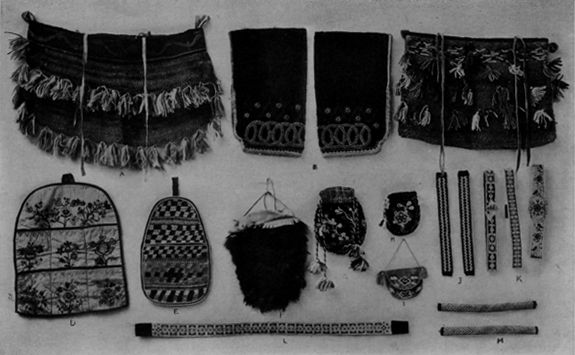
EXPLANATION OF PLATE
A and C—Muski-moots, or bags used by the duck-hunter for his game. Made by Dog-Rib women, of babiche, or rawhide of the moose or caribou.
B—Velvet leggings richly embroidered in violet-coloured bead-work, made by Mrs. (Archdeacon) Macdonald, a full-blooded Loucheaux woman.
D—Wall-pocket of white deerskin embroidered in silk. Made by a Rabbit-Skin woman at Fort Good Hope under the Arctic Circle.
E—Wall-pocket ornamented with porcupine-quill work, made by a Yellow-Knife Indian woman at Fort Resolution on Great Slave Lake.
F—Fire-bag, or tobacco-pouch, made of two claws of the black bear. The work of a Beaver Indian woman at Vermilion-on-the-Peace.
G—Fire-bag of velvet ornamented with silk-work, made by Chipewyan woman at Fond du Lac, Lake Athabasca.
H—Velvet watch-bag embroidered in silk, made by Slavi Indian woman at Fort Providence, at the head of Mackenzie River.
I—Watch-pocket of smoked moose-skin, embroidered in silk-work, made by a Cree girl at Fort McMurray on the Athabasca.
J—Armlets ornamented in porcupine quills, made by a half-breed woman on the Liard River (a feeder of the Mackenzie).
K—Three hat bands—the first two ornamented with porcupine quills, and the last in silk embroidery—made by Chipewyan woman at Fond du Lac, Lake Athabasca.
L—Beautiful belt of porcupine work, made by a half-breed woman at Fort Nelson on the Liard (a feeder of the Mackenzie).
M—Armlets of porcupine-quill work, made by half-breed girl at Fort Chipewyan.
Mr. and Mrs. William Johnson, with generous courtesy, have made us their guests while we stay, and their refined home is a clear delight. Mr. Johnson is as clever a man as Mr. Wyllie, but in other lines. Without ever having seen an electric light, he learned by study and research more about electricity than nine men out of ten know who go through Electrical Training Schools. With the knowledge thus gained he constructed and put into working use an electric-light plant at Fort Simpson on the Mackenzie. Far up here on the map, too, the "Judge," as he is lovingly called, taught himself all about watches, and he is now Father Time for the whole Mackenzie District, regulating and mending every timepiece in the country. The corrected watches are carried to their owners by the next obliging person who passes the post, where the owner is notching off the days on a piece of stick while he waits. A watch, the works of which were extracted from three old ones and assembled within one case by this Burbank of Watchdom, found its way down to Chicago. The jeweller into whose hands it fell declared that among all his workmen there was not one who could have duplicated the job.
Chipewyan is a bird paradise; the whole woods are vocal to-day. In the autumn, wonderful hunts are made of the southward-flying cranes, geese, and waveys, thousands of these great birds being killed and salted and put in ice chambers for winter use. If the mosquitoes were not so bad we would spend hours in the woods here with "God's jocund little fowls." These sweet songsters seem to have left far behind them to the south all suspicion of bigger bipeds. We hear the note of the ruby-crowned kinglet (regulus calendula) which some one says sounds like "Chappie, chappie, jackfish." The American red-start comes to our very feet, the yellow warbler, the Tennessee warbler, the red-eyed vireo, and the magnolia warbler, which last, a young Cree tells us, is "High-Chief-of-all-the-small-birds." Rusty blackbirds are here with slate-coloured junco, and we see a pair of purple finches. We are fortunate in getting a picture of the nest of the Gambel sparrow and two of the nesting white-throated, sparrow. They are ferreted out for us by the sharp eyes of a girl who says her Cree name is "A-wandering-bolt-of-night-lightning!" At our feet blossom cinquefoil, immortelles, the dainty flowers of the bed-straw.
It has been a full day, and by the way the "permits" are opening up in the settlement when we come back, promises to be a full night. These men have waited a whole year for a drink, and now the lids can't come off quick enough. "Come, hurry up, Flynn, we're all as dry as wooden gods, we're so dry that we're brittle—we'd break if you hit us." "Well, I'm hurrying; I'm as much in a rush as any of you; I'm so warped the hoops are falling off."
It doesn't take long to polish off the permits proper (or improper). By morning all this liquor, imported for "medicinal purposes," is gone. Whoever in Chipewyan is thoughtless enough to get ill during the next twelve months must fall back on the medicine-chest of the English Mission or of the Grey Nuns. Anything strong will do for the creation of joyousness during the remaining three hundred and sixty-four days of the year—Jamaica ginger, lavender-water, flavouring extracts.
Next morning the bon vivants of Chipewyan are down to essences of lemon, vanilla, and ginger, which have been specially imported as stimulating beverages. We ask if they are any good. "Good? I should say so, and one bottle just makes a drink. Can I offer" (politely) "to exhilarate you ladies with vanilla?" The most jovial of the celebrants tells of his early imbibition of red ink. "I used to get a gallon of red ink with my outfit every year, and it gives you the good feel, but when this new Commissioner comes in he writes, 'I don't see how you can use a gallon of red ink at your post in one year,' and I writes back, 'What we don't use we abuse,' and next year he writes to me, 'It's the abuse we complain of,' and, with regretful reminiscence, "I got no more red ink." The substitution of red tape for the carmine fluid that inebriates is an innovation not appreciated.
The old records fascinate us. We spend every spare moment before the coming of the treaty party in transcribing choice bits from them. There were drinks and drinkers in these old days.
"1830, Friday 1st. January. All hands came as is customary to wish us the compliments of the season, and they were treated with cakes each, a pipe, and two feet tobacco. In the evening they have the use of the hall to dance, and are regaled with a beverage."
"1830, April 30. Poitras, a Chipewyan half-breed, arrived, and delivered 81 made beavers in prime furs, though he says he has been sickly all winter. I therefore presented him with a complete clothing and a Feather."
"1830, May 16th. One of our Indians having been in company with Indians from Isle a la Crosse got married to one of their young women, consequently has followed the father-in-law and taken his hunt away from us."
"1830, August 13th. One Indian, The Rat, passed us on the Portage, he was treated with a dram for 'Old Acquaintance' sake."
On New Year's Eve the old chronicler drops into verse. In tall thin letters in faded ink we read,
"If New Year's Eve the wind blow south,"1831, January 1. The thermometer this morning was 29 below cypher."
1831, May 22. They bring intelligence that Mousi-toosese-capo is at their tent, having lately joined them, without his family of two women and two children, who perished during the winter. From his frequent prevarication when questioned by the other Crees, they suspect he has murdered and eaten them."
"1831, May 30th. The fellow has got too large a family for a Fort Hunter, he cannot feed them with unlimited Indulgence and supply us at the same time." [Would Mr. Roosevelt second this?]
"1831, June 19th. Two Chipewyans came from the Long Point informing us that Big Head's son is dead, that Big Head has thrown away his property in consequence of the loss of his boy, and that he told them to beg a shirt and tobacco. The shirt, of course, I did not send, the scoundrel is not worthy of it. I merely sent him six inches of tobacco with reluctance. That cursed family is a perfect pest to the place, and it is my humble opinion that the hand of Providence sends them the present calamity for their ill deeds."[!]
"1834, November 27th. A party of the Isle à la Crosse Indians with old Nulooh and Gauche cast up. They have not come in this direction for the sake of running about, some of their relations is dead, and in their own words they are travelling on strange lands to kill grief, not an unusual custom among the Northern Indians."
"1865, October 23rd. We were surprised yesterday at the arrival of a Protestant missionary, a Mr. Bompas from England; he came in a canoe from the Portage with Sylvestre and Vadnoit."
"1866, January 1st. The whole Establishment breakfasted in the Hall and in the evening a Ball came off with great eclat. Two marriages also to-day, Francis Villebrun to Marie Cyre, and Baptiste St. Cyre, Jr., to Justine McKay—so that all things considered the New Year was ushered in with a tremendous row! Verily, times are improving in the North."
"1866, January 2nd. The men are rather seedy to-day after their tremendous kick-up of yesterday."
"1840, January 25th. The object of sending Lafleur to the Little Island is that he may procure a kind of willow that the Canadians call 'Courmier,' the bark of which scraped and boiled in water has healing qualities which they think will be of great service for Hassel's complaint. Confidence in anything is half the cure."[!]
"1840, February 1st. Hassel is still without much appearance for the better, and at his earnest request was bled."
"1841, December 31st. The men from the Fishery made their appearance as usual at this time, and as usual, too, the best we had (which by-the-by is not great as will be seen by this journal) was served out to them. The other men had the time to themselves to prepare for the holiday of to-morrow, for the Jour de Tan is the greatest day of the Canadians in these distant Northern posts. To finish things properly there is still wanting the famous aqua vitae, which we are sorry to state is not in our means to furnish. Adieu the year one thousand eight hundred and forty-one!"
"1842, February 13th. The Rev. Mr. Evans proposing to take his departure to-morrow for Isle a la Crosse edified us with a farewell service, several of the women and children were baptized, and Flett and Hassel were married to their wives."
From the records we compile this Chipewyan calendar:—
March 17th, House-flies. April 8th, Grey goose seen. April 11th, Catkins. April 12th, Barking crows. April 19th, Blackbirds and mosquitoes. April 21st, Plover, two hawks, and a butterfly. April 22nd, Gulls, white waveys, robins. April 28th, White cranes. April 30th, Frogs, most of snow gone. May 2nd, Dark butterfly, four purple crocuses. May 4th, Frogs noisy, bumble bees. May 5th, Nearly clear of ice. May 8th, Water from Peace River flowing into lake. An Eagle. May 10th, Sand martins. Ice drifting in channel in front of fort. May 20th, Swans passing north. May 21st, Trees bursting into leaf. July 11th, Strawberries and raspberries. August 18th, Cranes passing south. October 11th, Small birds passing south. October 12th, First ptarmigan seen about the fort. October 24th, Lake in front closed up this morning.
—C.G.D. Roberts.
For fresh woods and pastures new this Friday, June 26th! Our little "bunch" breaks up. Mr. Brabant and Mrs. Harding, of the Hudson's Bay Company contingent, go on in the Grahame to Smith's Landing, and with them the two detachments of the R.N.W.M.P. As we shake hands with the police party, we wonder what Fate has in store for each of us. Breaking off at Fort Resolution, Great Slave Lake, and trending eastward by canoe over unchartered ways, will they reach salt water on Hudson Bay as they hope?
For our two selves, great good fortune is ours. The Canadian Government Indian Treaty party, consisting of Mr. Conroy in command, Mr. Laird as secretary, Dr. Donald, and Mr. Mooney in charge of the commissariat, with Constable Gairdner, R.N.W.M.P., as Escort, has just come down the Peace. To-day they pay treaty in Chipewyan, and this afternoon start for far Fond du Lac, at the eastern extremity of Lake Athabasca. The little H.B. tug Primrose will tow them and their outfit in a York-boat and a scow, and the captain has been persuaded to allow us, too, to take our blankets and come along, sleeping on the deck. The Primrose from stem to stern is not big enough to swing a cat in, but who wants to swing a cat? It is blue Lake Athabasca that we long to see; no white woman has yet traversed it to its eastern extremity and we would go if we had to work our passage at the sweeps of the scow.
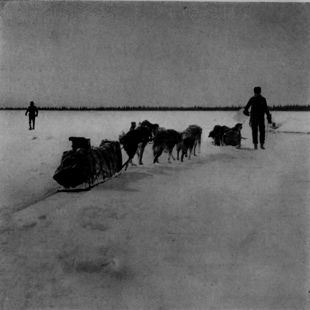
Athabasca Lake (whose name means "In Muskeg Abounding"), is two hundred miles long, with thirty-five miles at its greatest width. It lies in a general easterly and westerly direction. No survey has been made of the lake; its height above ocean level is seven hundred feet, and it covers perhaps three thousand square miles. Its chief feeder is the Athabasca River, down which we have come from the south. This stream, assisted by the Peace, is fast filling up with detritus the western portion of Lake Athabasca. There is a marked contrast between the upper and lower coasts of the lake. The north shore consists of Laurentian gneiss with a sparse wood growth; the south bank for the most part is low, the formation being a cretaceous sandstone. Ice holds fast this beautiful sheet for six months every year. As we puff along the surface of its incomparable blue it is hard to realise that, although the Peace and Athabasca Rivers open their icy mouths about May-day, parts ot the lake are not free for travel until mid-May. The lake freezes fast at Fort Chipewyan some time in November. Lying on the deck of the tug, we look down and take inventory of our odd tow. Just behind comes the scow. It holds wood for the engine, a long sled, a canoe, a "skift," all this year's trading supplies for Fond du Lac, and half a dozen chained husky dogs. Trailing the scow is a York-boat carrying the treaty party and Mr. Harris.
It is late in the afternoon when we pull out from Chipewyan, but the sun is still heaven-high, with the offshore air a tonic. At seven o'clock Colin Fraser's boat passes us with Bishop Grouard standing upright at the prow. This stately figure, clear-cut against the sky-line, may well stand as the type of the pioneer Church of the Northland. On the little deck we can use the camera with facility at ten in the evening, and the typewriter all night. The light manifestation is a marvel and wooes us from sleep. Have we not all the tame nights of the after-days for slumber? Here we lose the moon and those friendly stars which at Pelican Portage dipped almost to meet our hands. No more are we to see them until the Arctic has been reached and we have turned southward many, many hundreds of miles.
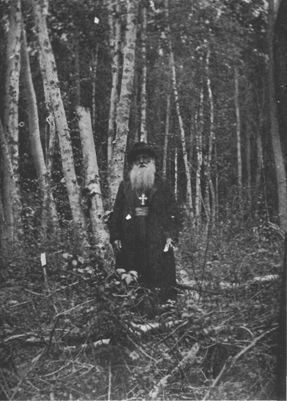
Hours since all the badinage was silenced in the York-boat behind us. On board the Primrose the mate sleeps, and Captain Prothero has the wheel. I creep along the wobbly gunwale to sit out a four hours' watch with him. "I never saw any one navigate as you do, captain, you seem to have neither chart nor compass."
"No," assents he, biting hard on the little black pipe, "we just go by the power o' man," and with the words a sharp turn of the wheel lurches us out from the lee of a batture. The jolt jerks up its passengers in the semidetached steerage. A growling of huskies, a kick, and a muttered adjuration in Cree, and all is silent again.
By six o'clock every one is astir, and Saturday is a long glorious day. At noon we stop to take aboard an Indian who hails us from the scrub-pine, sore afraid that he will miss connection with his five dollar treaty present from the Government. It is good to stretch out on the grass after this somewhat restricted Primrose path of dalliance. In front of us extends a long row of islands, in the hot haze suspended midway between blue of lake and blue of sky. Their covering of baby-willows suggests a face guilty of a three days' beard. We rest, so far as the mosquitoes think it proper we should rest, on a bed of reindeer moss (cladonia rangiferina?), the tripe de roche of the North. This constitutes almost the sole winter-food of the reindeer, its gelatinous or starchy matter giving the nutritive property to the odd-looking stuff. Reindeer-moss has saved the life of many an Indian lost in these woods. We try it, and find the taste slightly pungent and acrid; but when boiled it forms a jelly said to be nourishing and tonic.
No orders are given when we land, and we study countenances and actions to guess the time-limit of our tether. For twenty-four hours we have wondered if there were trout in Lake Athabasca and if they would rise to the fly. With a borrowed rod we take a canoe and off the shadow of a cottonwood point try a cast at random. The gut carries three flies—a brown hackle, a coachman, with a Jock Scott at the tail—a rainbow aggregation. To the coachman we get a rise and it takes three of us to land him. There are no scales; so his weight must forever be unrecorded, but as we lay him out he measures just a trifle over twenty-three inches, as beautiful a lake trout as ever sent thrill up and down a sympathetic spine. Bye-and-bye this road we travel is going to be listed on the sporting routes of the world, and tired souls from the Seven Seas with rod and gun will here find Nepenthe.
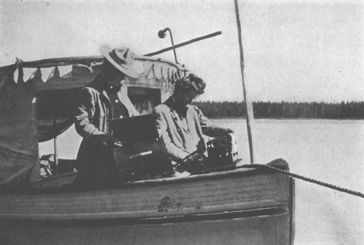
Clutching our catch, we step gingerly along an outstretched oar and climb on board. The orders of the captain to the mate are sporty and suggest turf rather than surf. "Kick her up, Mac!" "Give her a kick ahead!" "Who-o-oa!" On Sunday evening, June 28th, we reach Fond du Lac, clinging close to the water-line on her beautiful stretch of sand. All unregarded are the church-bells, and the Indians crowd to meet us,—bent old crones, strong men, and black-eyed babies. For is not the coming of the treaty party the one event of the Fond du Lac year?
Half way along the traverse of the lake we had crossed the inter-Provincial boundary, and now find ourselves near the northern limit of the Province of Saskatchewan, and in the latitude of Sweden's Stockholm. There are but two people in Fond du Lac who speak English,—Mr. Harris who trades fur with the Indians, and Father Beibler who would fain shepherd their souls.
These Caribou-Eater Indians are true nomads who come into the post only at treaty-payment time or to dispose of their hunt. In the moon-when-the-birds-cast-their-feathers (July) they will press back east and north to the land of the caribou. September, the-moon-when-the-moose-loose-their-horns, will find them camping on the shore of some far unnamed lake, and by the time of the hour-frost-moon, or the ice-moon, they will be laying lines of traps.
We have learned to estimate the prosperity or otherwise of the Indians by the condition of their dogs. Fond du Lac dogs are fat; each baby in its moss-bag exudes oil from every pore. Peace and Plenty have crowned the Caribou-Eaters during the winter that is past. The law of Saskatchewan permits the taking of the beaver. Alberta for the present has enacted restrictive legislation on this hunt, to which restriction, by the way, among the Indians at the treaty-tent at Chipewyan, objection had been loud and eloquent.
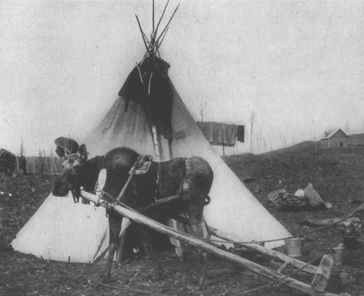
We call upon Mr. Harris and his Chipewyan wife, a tall handsome woman whom he addresses as "Josette." Their three girls are being educated in the convent at Fort Chipewyan. The room in which we sit reflects the grafting of red life on white. A rough bookcase of birchwood, with thumbed copies of schoolboy classics, Carlyle, the Areopagitica, and the latest Tractate on Radium, gives one a glimpse of the long, long winter nights when all race and latitude limitations fade away and the mind of the Master of Fond du Lac jumps the barrier of ice and snow to mix with the great world of thought outside. "Stone walls do not a prison make nor iron bars a cage." Fighting our way with the mosquitoes, under birches somewhat dwarfed but beautiful, through a pungent bocage of ground pine, wild roses, giant willow-herb, mints innumerable and Labrador tea (Ledum latifolium), we reach the H.B. garden where the potatoes are six or eight inches high. We wander into a little graveyard, surely the most lonely God's acre in all Canada. The inscriptions in syllabic Chipewyan show the patient devotion of Father Beihler, who comes across us as we gaze at the graves. Eight long years the priest has put in at Fond du Lac, sent here when but three months in the priesthood. His English, acquired from Mr. Harris, is a bit hesitating. His home was in Alsace-Lorraine; he tells us his mother was out of her mind for three days when he was ordered here, and he himself wept. White women are a rara avis. Father Beihler wants to know how old we are and if we are Catholics and how much money we earn. Pointing wisely to the Kid, he assures me, "They are not an-gell (angel) at that age," and says, "I am not a woman-hater, and I am not a woman chercher." The priest is as great a curiosity to us as we are to him, and each is interested in studying a new kind of animal. One sympathy we have in common,—the good Father knows every bird that flies over Fond du Lac. Who can tell what they whisper to him of the sweet Alsace so far away? We are treated to peeps into the nests of the orange-crowned warbler, the hermit thrush, and that shy wader, the spotted sandpiper.
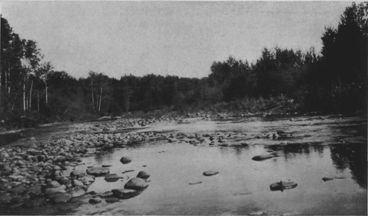
These ultimate woods fascinate us, with their worn north trails of the trapper beaten as hard as asphalt with the moccasins of generations. The father of the Chipewyan down at the tents receiving his treaty money to-day and his grandfather before him trod these same trails and served The Company. Dusky feet trod these paths when good Queen Anne ruled in England, men made toilsome portages up these waterways, and here Crowfoot and Running Rabbit and Gaston Lamousette kept undisturbed the tenour of their way and matched wits with Carcajou the wolverine.
To the student who would read at first hand the story of fur, more interesting than dark otters, Hudson Bay sables, or silver-fox, one form silhouettes on the white canvas of the North. It is the figure of the Trapper. Here, as elsewhere, the man who mixes brains with his bait and makes a scientific art of a rude craft is the man who succeeds. It is a contest of wit worthy the cleverest. The animals, as the years pass, become more rather than less wary, and the days of the magenta string tying a chunk of fat to a nice new shiny trap are long past. The man who used to "make fur" in that way is, like Fenimore Cooper's Indians, the extinct product of a past race that never existed.
The Chipewyan trapper eats at once, or dries for the future, every ounce of flesh he traps, from the scant flesh-covering over the animal's skull to the feet and the entrails. As soon as the skins of beaver and musquash are removed, the bodies, so many skinned cats, are impaled on sticks of jack-pine and set sizzling before the fire. In the woods as in the camp, the laborious work falls to the woman. Lordly man kills the animal and that is all. With her babies on her back or toddling by her side, the wife trails the game home on hand-sled, and afterwards in camp she must dress the meat and preserve the skin.
The band of Fond du Lac Indians is the largest in the whole North, and they are perhaps the least unspoiled of "civilisation," as their range is removed from the north-and-south route afforded by the Mackenzie. To-morrow the treaty party will leave, the skin tepees will be pulled down, and in those beautiful birchbark canoes whole families will be on the move. These people are essentially meat-eaters. Their hearts have not learned to hunger for those soggy bannocks, unventilated shacks, and sheet-iron stoves which are luring their tribal cousins on the germ-strewn way to higher culture with convenient stopping-places in the graves by the wayside.
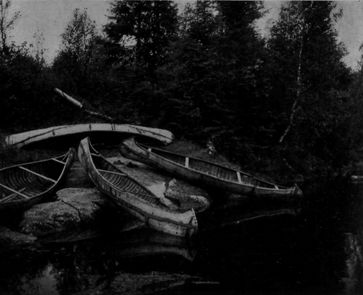
Starting from Fond du Lac in July, a Chipewyan family sets out in two canoes, the big communal one, and the little hunting-canoe, the dogs following along shore. It is paddle and portage for days and weary weeks, inland and ever inland. In October the frost crisps into silence the running water and the lake lip. Snow begins to fall, and the grind of forming ice warns the Chipewyan it is time to change birchbark for moccasin and snow-shoe. Canoes are cached, and the trail strikes into the banksian pine and birchwood. The door of the forest is lonely and eerie. It no longer seems incongruous that, although Big Partridge wears a scapular on his burnt-umber breast and carries with him on his journey the blessing of Father Beihler, he also murmurs the hunting incantation of the Chipewyans and hangs the finest furs of his traps flapping in the top of the jack-pine, a sop to the Cerberus of Mitchie Manitou, the feared Spirit of the Wood.
Winter sees Indian families, each little group a vignette in the heart of the wider panorama, flitting over lake surfaces to ancestral fur-preserves. In the early snow they pitch tepee, family fires are lighted, and from this centre the trapper radiates. The man sets his traps, and if the couple is childless his wife makes an independent line of snares. Each individual traps for miles and days alone, and an accident in the woods means a death as lonely and agonising as that of the animal he snares. With blanket, bait, and bacon on a small hand-sled, silently the trapper trudges forward. The Northern Lights come down o' nights, and it is cold; but cold makes finer fur. Down far trails in gloomy forests, across the breasts of silent streams, the Chipewyan trudges from trap to trap; if he finds fifty dollars worth of fur along the whole line he is content. It is not this lonely man who gets the high price, madame, for your marten stole or opera-cloak of ermine.
On the trail the hunter may go hungry for two days and no word of complaint, just a tightening of the lips and L'Assumption belt, and a firm set to the jaw; but when a moose is killed life is one long supper. A jolly priest whispers of this confession from a son of the Church, a recent brand from the burning, "O Father, I know that Christianity is true, the great, the strong religion. When I was a heathen Chipewyan and trapped with my mother's tribe I ate ten rabbits a day. But now I am a Christian, a good Catholic, seven rabbits are enough for me—I will eat no more!"
In the early days the H.B. Company allowed its men en voyage five pounds of meat a day, and each kiddie three pounds. In British Columbia and the Yukon the ration was one salmon; up here on the Athabasca one wild goose or three big whitefish; on the Arctic foreshore two fish and three pounds of reindeer meat. This was the scheduled fare, but the grimness of the joke appears in the fact that each man had to run his breakfast to earth before he ate it.
Forty miles a day from trap to trap is a hard tramp on snowshoes when the wind sweeps down from the Arctic and the silence can be felt. The whole thing is a Louisiana lottery. The very next trap may hold a silver-fox that spells kudos for a year round the winter camp-fires and a trade valuation of one hundred dollars from the tempting stores of Mr. Harris. As long as the red fox brings forth her cubs to play in the starlight and marten and musquash increase after their kind, just so long will there be trappers and sons of trappers setting out from Fond du Lac. In October or November these Chipewyans will meet the migrating caribou on the northern side of Athabasca Lake. Caribou skins are in prime condition then to make coats and robes, and caribou venison, fresh or dried, is the daily bread which Providence sends to these far folk. About Christmas time, if they find themselves at a convenient distance from the post, the Indians come in to Fond du Lac to trade their furs with Mr. Harris and to get from Father Beihler the blessing of Mother Church. Out they go again and make their spring hunt of otter, bear, and beaver, whose skins they bring in when they come for their treaty money and annual reunion in July.
Interesting indeed is the life-history of the Barren Ground caribou (rangifer articus), whose migrant hordes to-day rival in number the bands of the dead and gone buffalo. Caribou go north in spring and south in autumn, as the birds do; and, unlike the seals, the female caribou form the advance line. They drop their young far out toward the seacoast in June, by which month the ground is showing up through melting snow. The male caribou never reach the coast, but join their wives and make the acquaintance of their babies at the end of July. From this time they stay together till the rutting season is over late in October. Then the great herds of caribou,—"la foule,"—gather on the edge of the woods and start on their southern migrations toward the shelter and food afforded by the country of the larger pine trees. A month later the females and males separate, the cows with their intent fixed on the uttermost edge of things beginning to work their way north toward the end of February and reaching the edge of the woods by April.
This is the general rule. Broadly speaking, the north shore of Athabasca Lake to-day forms the southern limit of the caribou range, while the Mackenzie River makes a natural dividing-line between eastward and westward branches of the caribou family. But the trend of this mighty migration will not be pent between mathematical lines of limitation, and the direction of prevailing winds may turn the numberless hosts and divert them from their line of march. Individuals and scattered bands, indeed, have been known not to migrate at all. Fifteen years ago in the last days of July, in latitude 62° 15' North, the Tyrrell Brothers saw a herd of caribou which they estimate contained over one hundred thousand individuals. In 1877 a line of caribou crossed Great Slave Lake near Fort Rae on the ice. It took them two weeks to pass that point, and, in the words of an eye-witness, "daylight could not be seen through the column."
A priest, on the winter trail between Fond du Lac and Fort Chipewyan a few winters ago, was travelling without fire-arms and, as his trail crossed that of the moving caribou, he had to delay his journey till they deigned to give him the right of way. It was impossible to pass through their ranks, and he hadn't even the satisfaction of making a fat bull pay tribute to his Mother Hubbard cupboard.
Mr. Hislop, a fur-trader of Great Slave Lake, said to the writer, "At Fort Rae the caribou are and always have been very plentiful, I don't think they will ever die out." Rae was the old meat-station for the Far North, and the records show that after supplying local needs three thousand tongues were often exported in one season. If one intercepts a caribou-band in a little lake he may with patience kill them all without any trouble, as they run round and round on the ice, mystified by the wood-echoes and the reverberation of the shots.
When the Chipewyan filters into southern latitudes and weakens with pink teas the virility that should go with red blood, aping the elect he will cast round for a suitable coat-of-arms. The proper caper for him would be the caribou rampant with a whitefish flotsam. The whitefish (coregonus clupeiformis) is gregarious, reaching shallow water to spawn. Wherever you see Indian tepee-poles by the side of Northern waters you may guess that to be a good fishing spot. The poles are always hospitably left for the next comer, the Indian merely carrying with him the skin or canvas cover of his tepee. The location of the Hudson's Bay forts was in the beginning determined by the good fishing-grounds, although now there is but indifferent fishing near some of the posts. It would almost seem that the whitefish have in their chilly veins as variable blood as any vagrant horde of caribou. The whitefish contains all elements necessary for human nourishment, and it is a happy fact that it does, for men and dogs in the North often live for solid months on nothing else. It is a rich fat fish and the usual mode of cooking it is by boiling. Northern people tell you that it is the only fish whose taste will never produce satiety, as it becomes daily more agreeable to the palate. I can't say that it worked on our sensibilities in just that way. But it is the old story of de gustibus, etc. We see the Fond du Lac people this evening roasting upon the coals, as choice tit-bits, the stomachs of the whitefish. Scraping the dirt and ashes from the blackened morsel, they offer it to us as one would pass the olives in those lands so far below us where people wear dress-suits and railroads run. It is all a matter of latitude, after all, for when a bottle of olives was salved from the wrecked scow we had overheard this dialogue between two boatmen, as surreptitiously they broached cargo. "Do you like these?" "Yes." "You're a liar!" On the Athabasca trail, too, we had seen an untried soul struggling with his first olive. It was Shorty, the lightning-stricken heir of the house of Kennedy. He coveted one of the "plums" from our lunch-basket, and was much surprised when we suggested that it was an olive. "What are them?" "Olives," we elucidated; "they come from Southern Europe by steamer." "Do they?" (slightingly). "The one I et must have come steerage."
We are to make the acquaintance of other Northern delicacies,—beaver-tails, moose-nose, rabbits' kidneys, caribou-tongues, and the liver of the loche, an ugly-looking fish of these waters. But the whitefish remains the staple; the fish-harvest here is as important a season as Harvest Home elsewhere. At the fishery, whitefish are hung upon sticks across a permanent staging to dry and freeze; an inch-thick stick is pierced through the tail, and the fish hang head downwards in groups of ten. This process makes the flesh firmer if the days continue cool, but if the weather turns mild as the fish are hanging they acquire both a flavour and a smell exceedingly gamy. This is the "Fall Fishery." Winter fishing is done through holes in the ice, the net being spread by means of a long thin pole. The handling of net and fish is terrible work in the bitter cold.
As a whole, Canadian Indians are more independent than those of the United States, and certainly they have been more fairly dealt with in Canada than in the sister Republic. There is in the Dominion to-day an Indian population of 110,000. The amount expended last year by Canada from the Consolidated Revenue Fund for her Indian Department was $1,358,254. The Canadian Government has sedulously kept faith with its Indians and has refrained from pauperizing them by pap-feeding or ration-folly; very largely to-day the Canadian Indian plays the game off his own bat.
Into the sturdy and intelligent faces of the Fond du Lac Indian we look, seeking in vain any trace of "the wild Red Man." The raison d'être of these annual "treaty-payment parties" is merely the acknowledgment on one side and the recognition on the other that the Northern Indian is a British subject protected by and amenable to British law. In addition to the present of five dollars per head each year, the Canadian Government sends in by the Indian Agent presents of fishing twine and ammunition, with eleemosynary bacon for the indigent and old. The chiefs strut around in official coats enriched with yellow braid, wearing medals as big as dinner-plates.
From Edmonton northward to Fort Chipewyan the Indians are all Crees. At Fort Chipewyan the northern limit of the Crees impinges on the southern limit of the Chipewyan, but here at Fond du Lac the Indians are all true Chipewyans. The Chipewyan wife is the New Red Woman. We see in her the essential head of the household. No fur is sold to the trader, no yard or pound of goods bought, without her expressed consent. Indeed, the traders refuse to make a bargain of any kind with a Chipewyan man without the active approbation of the wife. When a Chipewyan family moves camp, it is Mrs. Chipewyan who directs the line of march. How did she happen to break away from the bonds that limit and restrain most Red brides? This is the question that has troubled ethnologists since the North was first invaded by the, scientific. We think we have found the answer. Along the shores of Fond du Lac we descry a long-legged wader, the phalarope. This is the militant suffragette of all bird-dom. Madame Phalarope lays her own eggs (this depository act could scarcely be done by proxy), but in this culminates and terminates all her responsibilities connubial and maternal,—"this, no more." Father Phalarope builds the house, the one hen-pecked husband of all feathered families who does. He alone incubates the eggs, and when the little Phalaropes are ushered into the vale, it is Papa who tucks their bibs under their chins and teaches them to peep their morning grace and to eat nicely. Mamma, meanwhile, contrary to all laws of the game, wears the brilliant plumage. When evening shadows fall where rolls the Athabasca, she struts long-leggedly with other female phalaropes, and together they discuss the upward struggles toward freedom of their unfeathered prototypes.
Everybody is to say farewell to Fond du Lac to-day, June 29th, so there is a hurried finishing up of loose ends. A loud yowl as of a lost soul letting go of life starts the lake echoes! No hand is staining itself in brother's blood. The treaty doctor, who visits these people, to use their own word, "as a bird on the wing," has just succeeded in extracting a tooth for a Chipewyan bride, Misère Bonnet Rouge. Misère looks ashamed of her howl when the operation is over, and lisping, "Merci very," bears off in expansive triumph the detached molar.
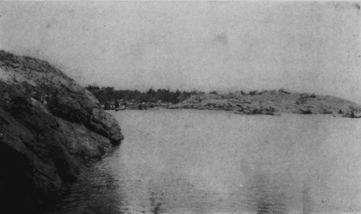
Down at the lake edge, belly prone, men and women lap the water as dogs do, while the festive small boy from the Government bags of poor-house bacon is slyly licking the oozing fat. Of the taste of red-cheeked apples and chewing-gum he is guiltless; popcorn, bananas, and the succulent peanut are alike alien. This pee-mee or oil of bacon is delicious morsel enough for his red palate. We trade a brier pipe with young McDonald, a full-blood, for his beautiful hat-band of porcupine quills, and in the French of the North he confides to us, "I have two boys. The mother can have the younger one to help her in the house, and the priest can teach him to be a white man if he likes; but the other one goes with me, no school for him. I will make him a hunter like myself." Last year McDonald went into the woods on New Year's Day and didn't return until June, when he came back with three hundred caribou.
Father Beibler is carrying a cup of water up to a tepee where an old Indian lies dying, to whom he is giving extreme unction. The slanting sun strikes the tin cup and the big crucifix of the good Father, and so we leave Fond du Lac.
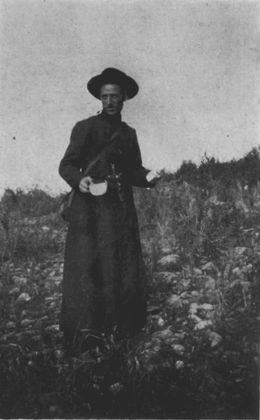
The man who tells the story crosses himself piously and immediately begins a bit of rag-time of the vintage of '08. We ask him where he heard the tune. "O, I catch him from the phunny-graph, me at the Mission." Canned culture even here! It is light enough to read on the deck at quarter past eleven. We chunk along through a lake of amethyst and opal, the marvellous midnight light keeping us from sleep. On the scow astern, sprawled on the season's output of fur, the men smoke and argue. In the North, men talk of feats of strength and endurance, boast about their dogs, and discuss food. Two kindred souls may hark back to boyhood days and quote a page of Virgil or demonstrate on a bit of birchbark the forty-seventh proposition of Euclid, but you overheard no discussion of elections or ward-politics, no chatter of the marketplace. That is all "long ago and far away." To-night it is "You know there are fellows in here who can run like hell. The world's record is beaten every winter." "The world's record in lying, do you mean?" "No, running—a man can run one hundred miles a day in this country." "Well, what makes a day?" "Twelve hours,—that is what I learned at school." "No: there's twenty-four hours in a day." "Well, a day, I take it, is as far as you can go without stoppin'—it never gets dark, so how is a man to know what's a day?"
We reach Chipewyan Wednesday, July 1st, and there is no soul who cares a whitefish for the fact that this is Dominion Day, Canada's national holiday. For our dinner Mrs. Johnson gives us home-grown parsley, radishes, lettuce, and green onions; the potatoes are eight or ten inches high, and rhubarb stalks an inch and a half in diameter. Wild gooseberries are big enough to make delectable "gooseberry fool." Who hungers for whitefish-stomachs or liver of the loche?
Early in the morning we start north in the Primrose, cross Athabasca Lake, and enter the Rocher River. Thirty miles from Fort Chipewyan the Rocher, uniting with the main channel of the Peace, makes a resultant stream known as the Slave, down which we pass in an incomparable summer day, our hearts dancing within us for the clear joy of living. Poplars and willows alternate with white spruce (Picea canadensis) fully one hundred and fifty feet high and three feet in diameter. It is an ideal run,—this hundred miles between Fort Chipewyan and Smith's Landing, and we make it in twelve hours.
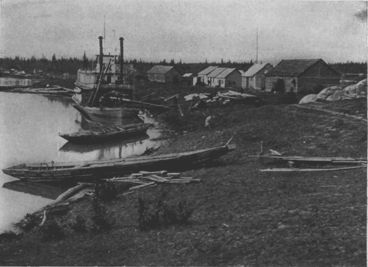
"How did Smith's Landing get its name?" I ask the Primrose Captain. "Some ould fish o' the Hudson's Bay," from the tightly-bitten black pipe leaves one wondering if Lord Strathcona (Sir Donald Smith) was meant. At Smith's Landing we encounter the only obstacle to steamboat navigation in the magnificent stretch of sixteen hundred miles between Fort McMurray and the Arctic Ocean. Between Smith's Landing and Fort Smith the Slave River presents sixteen miles of churning rapids with a total drop of two hundred and forty feet. Until within a few years every ounce of freight for the lower Mackenzie River posts had to negotiate this turbulent waterway, making seven portages and many decharges. The "free trader" still takes his scows down this Rapid of the Damned, but the H.B. Company (thanks be!) has provided a cross-country portage.
We land on the heels of a tragedy. Some days before, in this surging swirl of waters two priests pushed out in a canoe. The older man had been in the North for years and was "going out," the other had come from Europe to take his place; the Father would show to his successor all the beauties of the rapids. In their enthusiasm they ventured too near the "Rapid of the Drowned," and canoe and men went down. An old Indian woman, the only eye-witness, said to me, "One arm lifted out of the river, the paddle pointing to the sky—a cry came over the water, and that was all." Our thought jumps to that peasant's home in far France where the mother waits and wearies for news from America. We see the unsteady fingers tearing open the first letter that comes out of that remote land where devotion and duty had called her son. We wonder who wrote that letter to her, and, turning away, wonder too at the destiny which suddenly breaks off the thread of lives like these and leaves dotards dozing in the sun.
At Smith's Landing we join our Athabasca friends and meet new ones, among the latter Mr. Max Hamilton, who will tell you more of the North and its little ways in a forenoon than you could glean from books in a winter's study. Corporal Mellor and Constables Johnson and Bates, R.N.W.M.P., no longer gay birds of travel, have gotten down to brass tacks. With gay visions of striding blooded mounts, herding bison, and making history, they find themselves employed at present in making a barracks, making it out of logs and sweat with the lonely ox as coadjutor. Johnson, who has broken horses in the ring at Regina, is head of a wagon transport and tries to get speed and form from Wall-Eye Buck, an ox that came in with the Klondike rush and hasn't rushed since. Johnson holds the ribbons well and bows acknowledgment when we find a prototype for him in Mulvaney, the tamer of elephants. He can afford to take our banter good naturedly, for he knows what lies before us on the Mosquito Portage and we do not.
We thought we had met mosquitoes on the Athabasca. The Athabasca mosquito is gentle, ineffective, compared with his cousin of Smith's Portage. Dr. Sussex sits on the wagon-seat behind and explains the mosquito. He tells us that they are "of the order Diptera," "sub-order Nemocera," and chiefly "of the family Culicidae," and he also goes so far as to tell us that they "annoy man." As we bump along in the muskeg and the creatures surround us in a smother, he ventures to assert that "the life of the adult insect is very short" and that it is the female who stings. The Doctor is a born instructor. We learn that "the natural food of the mosquito is a drop or two of the juice of a plant." We suspect the Doctor of fagging up on "Mosquito" out of some convent dictionary while we have been at Fond du Lac. He is like the parson introduced by his friend of the cloth. "Brother Jones will now give an address on Satan. I bespeak for him your courteous attention, as the reverend gentleman has been preparing this address for weeks, and comes to you full of his subject."
The adult mosquito may have a short life, but it is a life crammed full of interest; if the natural food of the mosquito is the sweet juice of a pretty flower then a lot of them in this latitude are imperilling their digestion on an unnatural commissariat. And if the female mosquitoes do all the fine work, there is a great scarcity of male mosquitoes on Smith's portage, and once more in the North the suffragette comes into her own. We fear that these mosquitoes are like the Indians of whom a Slave River priest had said to us, "These have not delicate sensibilities such as gratitude and affection, but they have a proper appreciation of material things."
Opposition is the life of trade. For every vantage-point as big as a match-head on our face and hands the "bull-dog" contests with the mosquito. An interesting study is the "bull-dog." He looks like a cross between a blue-bottle fly and a bumble bee, and we took leisure as we went along to examine the different parts of his person under a microscope that some one carried as a watch-charm. The head of the insect (if he is an insect) looks exactly like that of a bull-dog, he makes his perforation with a five-bladed lancet, and he is good workman enough to keep his tools always well sharpened. The Doctor was not "long" on the "bull-dog." He told us that his Sunday name was "Tabanus," and that was about all he could impart. The rest we could learn for ourselves by direct contact.
Personally I have very little rancour against the "bull-dog." He looks worse than he is, and an adversary armed with hands can easily repel him. Four-legged brutes find it different. On the Bloody Portage we overtook five teams of oxen which had been more than twelve hours trying to make sixteen miles and were bleeding profusely from the fly-bites. Finally two of them succumbed and a relief team had to be sent out from Fort Smith. Moose in the North, maddened by the "bull-dogs," often jump over precipices and river-banks, as the Scriptural swine did when they were possessed of devils.
Johnny-Come-Lately from dear old Lunnon reading in a Western paper, "The deer are chased into the water by the bull-dogs," ruminates audibly, "Chase the de-ah into the wa-tah with bull-dogs! How interesting! Jolly resourceful beggars, these Colonials." A literary scientist sending out copy from the North wrote, "My two greatest troubles are mosquitoes and bull-dogs," which the intelligent proof-reader amended into, "My two greatest troubles are mosquitoes and bull-frogs."
Bringing in our daily treasure-trove of flowers we can scarcely realise that at Fort Smith we are in latitude 60° North, the northern boundary of the Province of Alberta and in the same latitude as St. Petersburg. One day we gathered careopsis, pretty painted-cups, the dandelion in seed, shinleaf (Pyrola elliptica), our old friend yarrow, and golden-rod. Another day brought to the blotting-pads great bunches of goldenrod, a pink anemone, harebells of a more delicate blue than we had ever seen before, the flower of the wolf-berry, fireweed, and ladies'-tresses. The third day we identified the bear-berry or kinnikinic-tobacco (Arctostaphylos uva-ursi) with its astringent leaves, and that dear friend of lower latitudes and far-away days, the pink lady-slipper. The last time we had seen it was in a school-room in far-off Vancouver Island where in early April the children had brought it in, drooping in their hot little fists. This same evening, watching a night-hawk careering in mid-air by the rapids of the Slave and enjoying its easy grace in twisting and doubling as with hoarse cry it fell and rose again, we were fortunate in literally running to ground its nest.
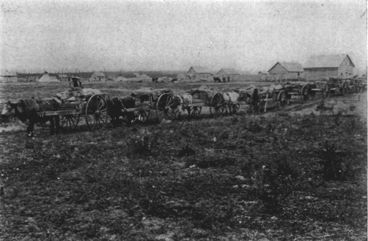
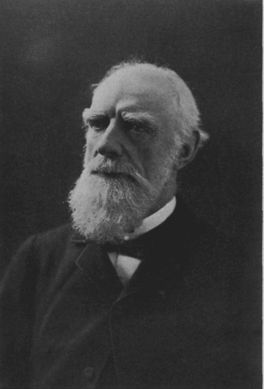
Fort Smith, as places go in this country, is an infant in age, having been established only thirty-four years. Resting on the edge of the high bank of the Slave, it enjoys an eternal outlook on those wonderful rapids. The river here is a mile wide. The sweep and eddy-wash of ages have cut out a deep bay, on the inner shore of which stand the buildings of The Company, the little Roman Church, the houses of the priests. Back of the permanent structures rise, this glorious July day, the tepees of the Chipewyans, Slavis, and Dog-Ribs who have come in from the hunting-grounds for their treaty money. Fort Smith struck us as being more "dead" than any northern post. But it is on the verge of great things. Mr. Brabant has announced that this place is to succeed Fort Simpson as headquarters for the Northern fur-trade, and his personality will soon send unction into the dry bones of the valley.
At the foot of the high hill looms a monument to the initiative and commercial enterprise of the H.B. Company,—a modern steamship in the waters of a wilderness-country. Ours is to be the honor of making in her the initial journey to the Mackenzie mouth. It is impossible coming from the South to navigate the Slave River rapids by steam. Any boat ambitious to ply on the waters lying northward between Fort Smith and the Arctic must be either taken in in sections or built on the ground. With enterprise and pluck, the Hudson's Bay Company has just completed the construction at Fort Smith of the steamship, The Mackenzie River. Its great boilers and engines made in far factories of the south came in over the Athabasca trail on sleighs in winter. Down that whole distance of ninety miles of Athabascan rapids they floated on scows as we floated, and while human ingenuity is bringing north the iron bowels, skilful hands out of native timber are framing the staunch body to receive them.
The builders of the big boat have had disasters which would have daunted any but the dogged Company of Fur-Traders. Two land-slides threatened to slice off and carry into the river the partially-made boat, a fire burned up the blacksmith shop and with it all the imported doors, window-sashes and interior finishings, so that she sails to-morrow with carpenters still at work. While the hull of this carefully modelled vessel is necessarily of light construction, with special steel to enable her to navigate safely the waters of the Mackenzie River, longitudinal strength has been adequately provided in the form of five lattice girders and by numerous hog-posts and ties, and the diagonal bracing of the bulkheads will provide ample transverse strength. The bow also has been made especially strong to resist the impact of ice, snags, etc. The hull is one hundred and twenty-five feet in length, twenty-six feet broad at the water-line, and five and one-third feet deep to the structural deck. The strength and safety of the hull are increased by five water-tight compartments. Propulsion is effected by a pair of modern stern paddle-wheel engines capable of being worked up to over two hundred and fifty horse power, giving her a speed of ten miles an hour. She has stateroom accommodation for twenty-two passengers, draws three and a half feet of water aft, and eats up half a cord of wood an hour. She will carry to the northern posts their trading-goods for the year.
Within a day's ride of Fort Smith grazes a herd of four to five hundred wood bison, the last unconfined herd of buffalo in the world. Doubtless the wood buffalo were originally buffalo of the plains. Their wandering northward from the scoured and hunted prairies has not only saved them from extinction but has developed in them resistance and robust vitality. These bison appear darker and larger than their pictured cousins of the past. Probably the inner hair of these is finer and of thicker texture, a difference which the change of habitat to more northern latitudes would easily account for. The bison have two enemies: the grey wolf and the Indian, one an enemy in esse, the other in posse. The Government of Canada has prohibited the killing of the buffalo, and my opinion is that this law, as all other Canadian laws, is obeyed in the North. I questioned every one I talked with who lives on the rim of the buffalo-habitat, and the concensus of testimony of priests, H.B. men, settlers, traders, and Mounted Police, is that the Indians do not molest these animals. The arch-enemy of the wood buffalo is the timber wolf.

Evidently the beautiful thick coat of the woodland bisons allows them to laugh at the mosquito, for we come upon them in an almost impenetrable mosquito-infested muskeg. An untoward frost is more to be feared by these great brutes than the attacks of any insect. Thirty-eight years ago a heavy rainfall in the winter soaked the snow and formed a subsequent ice-crust which prevented them from grazing, and as they do not browse on the branches of trees, the herd was almost exterminated. In the past, they have been abundant throughout sections of this North country. In the beginning of the last century, the upper Peace River and as far north as the Liard was stocked with them. As the Hudson's Bay Company never traded in these skins for export, the Indians hunted them for food only, Fort Chipewyan being regularly supplied by its fort hunters with buffalo for its winter use up to the year 1885.
In sections of the wooded country of the north the bison in times past were as plentiful as on the southern plains. During Sir John Franklin's first journey, his people near where the Athabasca River enters the lake "observed the traces of herds of buffalo where they had crossed the river, the trees being trodden down and strewed as if by a whirlwind." In 1871, two travellers making a portage to Hay River near its entrance into Great Slave Lake saw countless numbers of buffalo skulls piled on the ground two or three feet deep. The terrible loss of life indicated by these bones they attributed to a fourteen-foot fall of snow which occurred in the winter of 1820 and enveloped the travelling animals.
One cannot but be intensely interested in the preservation of this herd of wood bison making here their last stand. The Canadian Government has shown a splendid spirit in its attitude toward every phase of the buffalo question, as its purchase of the Pablo herd from Montana now ensconced in the new Buffalo Park near Wainwright, in Alberta, as well as the measures for preserving these northern brands from the burning, conclusively prove.
Upon my chatting with Chief Pierre Squirrel, and admiring largely his magenta mosquito-veil, the astute chap tells me that he himself, back of Fort Smith a few years ago, saw a full-grown buffalo pulled down and the flesh literally torn off it by woodland wolves, strong brutes, he assured me, which weighed from one hundred and fifty to two hundred pounds each. A wolf shot on the Mackenzie last year measured from snout to the root of the tail sixty-four inches. The Dominion bounty on the timber-wolf is twenty dollars, but this is not an off-set to the native's superstitious aversion to killing this animal; the Indian's belief is that such slaughter on his part queers his hunt for a whole season. He never goes out with malice aforethought on a wolf-hunt, but if one of these animals crosses his track he may kill it, although always with inward foreboding. A man brought in a wolf to Fort Smith while we were there and throwing down his hunting gear said, "There, it had better all be destroyed, I will have no luck with it more." Shortly afterwards a fish-staging fell on his son, for which the dead wolf was held responsible. As the female wolf has from three to five young at a litter and as the mother buffalo gives birth to but one calf, Fate, in both birth-rate and death-rate, would seem to favour the smaller animal. It is up to the red-coated lads of the river-edge to appear in the drama as gods-from-the-machine. While one's sympathy is with the shaggy bison host, still one cannot withhold admiration for the grit and tenacity of the wolf. Archbishop Taché tells of the persevering fortitude of a big wolf caught years ago in a steel trap at Isle â la Crosse. Thirty days afterwards, near Green Lake, a hundred miles away, it was killed, with trap and wood block still fixed to a hind leg. The poor brute through the intense cold of a Northern winter had dragged this burden all those weary miles.
With Fort Smith as a centre, there remains an unmarred fur-preserve and a race of hardy trappers. Is the fur-trade diminishing? Statistics are extremely difficult to get, dealers do not publish dividend-sheets, the stockholders of the Mother-Lodge of the H.B. Company do not advertise. There is no import duty on raw skins into the United States, and so no means of keeping tally on the large shipments of fur which yearly find their way south from Canada. The statistics which are available overlap. Raw furs making out by Montreal to Europe come back, many of them, as manufactured imports into this continent by way of New York. Canada in 1904 sent to her American cousins furs and skins and manufactures of the same to the value of $670,472. This year the export has been more than doubled; the exact figures are $1,531,912. In 1908, Canada sent to France $110,184 worth of raw and manufactured fur, to Germany $23,173 worth, and to Belgium $19,090 worth.
More money goes to the trapper to-day for such common skins as red-fox and skunk and muskrat than was ever paid to the fur-hunter for beaver, seal, and sea-otter in the old days. Six million dollars worth of raw furs are sold annually by auction in London, and Canada is the Mother Country's chief feeder. Included in these London sales are some hundred thousand martens, or Hudson Bay sables, and probably four times that number of mink. The imports of raw furs and exports of the manufactured article cross each other so perplexingly that to-day the wearer of fur clothing has no way of finding out in what part of the world her stole or cap or jacket had origin. On the feet of the sacrificed animal, by snowshoe of trapper and scow of the trader, it may have travelled half round the world before, in the shop-window, it tempted her taste and pocket-book. Furs will be always fashionable; the poet of old who declared, "I'll rob no ermyn of his dainty skin to make mine own grow proud," would find scanty following among the women of fashion in this age.
In some parts of the United States an ingenious by-industry to the fur-trade has arisen, for the offered-bounty destructive animals are carefully reared in illicit kindergartens. As some states pay for the scalps of these animal pests and other states for the tails, the undertaking is interesting and profitable. The only gamble is in the nursery. When the gladsome breeder gets his wild-cat or coyote big enough to market, it is "heads I win, tails you lose." The United States, in twenty-five years, has paid two and a half millions in wild animal bounties. California paid in a year and a half $190,000 on coyotes alone, and no breed of noxious animals is yet extinct.
What is true of the undesirable animals fortunately is true also of the harmless fur-bearers. Several causes make against the extermination of these in Canada. The range is so wide that, harassed in one quarter, the animal may get his family around him and make tracks for safer pastures. Hunted in the winter only, he has a good six months of planning and putting into practice plans of preservation as against the six months of active warfare when the trapper's wits are pitted against his. The fickleness of Fashion's foibles, too, in his favour. In no line of personal adornment is there such changing fashion as in furs. A fur popular this season and last will next spring be unsaleable at half its original value, and some despised fur comes to the front.
What causes the changed standard? Who shall say? World's Fairs, in showing perfect specimens, popularise particular skins. Some princess of the blood or of bullion wears mink at a regal or republican function, and the trick is turned. The trade-ticker on mink runs skyward and a wireless thrill of warning should by poetic justice be impelled here to the shores of the Slave where Mr. and Mrs. Mink and all the little minxes love and hate and eat and sleep (with one eye open). During the last five years furs have been increasingly fashionable, and to this end no one cause has contributed so strongly as the automobile. The exhilarating motion makes necessary clothing of compact texture. This truth is self-evident and does not require the involved chain of reasoning by which a friend over our milkless teacups last night strove to prove that by all laws of the game the auto makes milk cheap.
The burden of his demonstration is this. Autos have largely done away with the keeping of horses for pleasures. Horses and horse-stables inevitably breed flies. Flies in summer worry cows, and they, to escape the annoyance, stand for hours in running streams and do not graze. For lack of food, the milk-supply yielded by the cow is scanty, and milk rises in price. The auto upsets all this, and, undeterred by the horse-bred fly, complacent cows crop grass and distend their udders with cheap and grateful milk. Now, the reasoning is plain and incontrovertible at any one point, and yet urban milk grows dearer and Northern travellers drink boiled tea au natural. Cows are the eternal feminine and will not be explained by logic.
But we are in the latitude of the fox and not the cow. Should the most valuable fox that runs be called a black-fox, or a silver-fox? What is the highest price ever paid for a fox-skin? Do not try to get to the bottom of these two innocent-looking demands. That way madness lies. "How old is Ann?" pales before this. Canadian foxes present themselves patriotically in red, white, and blue, and there are also black foxes and silver ones. The black-fox is only less elusive than the black tulip or the blue rose, and yet he inhabits the same section and cohabits often the same burrow with the red and the cross-fox. By the way, a cross-fox is not a hybrid; he bears the sign of the cross on his shoulders, and so his name. The red-fox of America is not dissimilar to the red-fox of Europe, and yet a red-fox in Canada may have a silver-fox for its mother and itself give birth to a silver-cub. At the Mission at Isle â la Crosse in latitude 55° 30', about twenty years ago, an experiment was made in breeding black-foxes. The missionary—Burbanks got two black-fox pups, male and female, and mated these when they were mature. From them always came mixed litters of red-fox, cross-fox, and black and silver. It reminds one of the Black Prince of England, who was son of a King and father of a King, yet never was a King!
We are told that Messrs. McDougall & Secord, of Edmonton, enjoy the distinction of having received the highest price for a silver-fox pelt ever paid on the London market,—$1700, that it was one of the most beautiful skins seen in the history of the trade, and that it went to the Paris Exposition. Official Russian records at St. Petersburg state, "Of the American silver-fox (Canis vulpes argentatus) black skins have a ready market at from $1500 to $4000. They are used for Court robes and by the nobles."
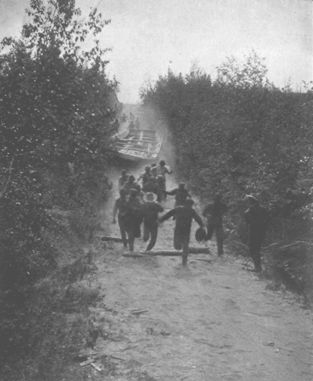
And so the stories go on. A dealer in Calgary told us that last winter he had handled a silver-fox skin that subsequently brought $1950 in the London market. One quotes these tales blithely and with pleased finality. Then arises from some unsuspected quarter the voice of one cavilling in the wilderness, who contradicts your every story and finds with keen discriminating sight, "Black's not so black nor white so very white." Mr. Thompson-Seton makes declaration, "The silver-fox is but a phase or freak of a common-fox, exactly as a black sheep is, but with a difference—!" Yes, there's that fatal and fascinating difference. As we must have salmon-hatcheries, so Nature demands intelligent fox-farms, and beaver-farms, and skunk-farms. Forty acres under fur promises greater interest than even forty-bushel wheat, and, to the imaginative, the way opens up for the development of a new Cat-o-Dog or Dog-o-Cat, Goatee-rabbiticus or Rabbito-goat.
I would not like to vouch for the story told on the mosquito-portage by the half-breed driver, who declared that last year a red-fox on the Slave stole a decoy duck and hunted with it for three seasons at the river-lip, placing it among the sedges and pouncing on the lured game. He was a serious-minded saturnine Scots-Slavi and told the story without moving an eye-brow.
At Fort Smith we enjoyed a close study of the American White Pelican (Pelecanus crythrorhynchos) which in the Mountain Rapids of the Slave finds its farthest north nesting-place. It, too, has the saving grace of continuance exhibited by the grey wolf. Mackenzie, a century ago, came across the birds here, and they have persisted ever since, although in the direct line of the river-transit of the fur-traders. A wooded island in the swirl of the rapids is their wild breeding-place, and while we were there the young birds were very much in evidence. We found something fascinating about this bird, so famed in song and story. The plumage is white, relieved with rose and yellow. The pelican nests are slight depressions in the sand, some of them softened with an algoid matting. The eggs are white, rough-shelled, and equal-ended, with, so far as we could see, only one to three in a nest. One by one the illusions of childhood vanish. Some wretched historian proves without shadow of doubt that Sir John Moore at Corunna met decent daylight sepulture and was not "darkly buried at dead of night, the sod with our bayonets turning." There arises one Ferrero who demonstrates with conclusive exactness that Antony was attracted by Cleopatra's money and his breast was not stirred by the divine passion. A French scientist robs Benjamin Franklin of the kudos of his lightning-rod. I myself on Vancouver Island have happened to be in at the death of two swans, and neither gurgled a musical note but yielded the ghost in dignified silence. And now candour compels me to report that the Slave River pelican feeds her nestlings on prosaic fish without the slightest attempt to "open to her young her tender breast." It is rank libel for Byron to state
"Her beak unlocks her bosom's streamAnd, when Keats states so sententiously in Endymion, "We are nurtured like a pelican brood," he merely calls the world at large, fish-eaters.
A double cabin is assigned us on The Mackenzie River and the nightmare that haunted us on the scows of wet negatives and spoiled films vanishes. On Tuesday, July 7th, the new steamer takes the water. Although, as we have said, we are in the latitude of St. Petersburg, still twelve hundred miles in an almost due northwest direction stretches between us and that far point where the Mackenzie disembogues into the Polar Ocean. The Union Jack dips and all Fort Smith is on the bank to see us off. On the Fourth of July we had improvised a program of sports for the Dog-Rib and Slavi boys, introducing them to the fascinations of sack-races, hop-step-and-jump, and the three-legged race. The thing had taken so that the fathers came out and participated, and, surreptitiously behind the tepees, the mothers began to hop. Having no popcorn, fizz, or Coney-Island red-hots to distribute, we did the next best thing,—became barkers and gave the calls that go with festivities. So now, as the boat swings out from the soft bank, it is a gay company of urchins who wave their caps and yell, "R-r-r-red lemol-lade, everybody drinks it!"
There is only one Fort Smith! Established for three decades, it has as yet seen no wells dug. The people still climb that steep bank, carrying in pendant buckets from wooden shoulder-yokes water for the daily drinking and ablutions. At four o'clock in the afternoon, should you visit Fort Smith forty years from now, you will see the same daily procession of women and kiddies bearing buckets,—the Aquarius sign of the Fort Smith zodiac. A scoffer at my elbow grins, "Why should they bother to dig wells? It's cheaper to bring out Orkney-men in sail-boats from Scotland to tote their water up the banks."
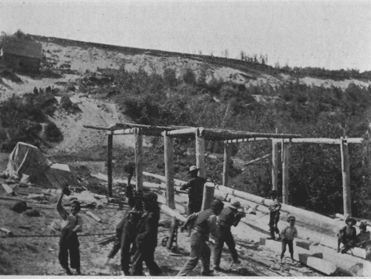
At noon we reach the Salt River, twenty-two miles up, which is one of the most marvellous salt deposits in the world. The Salt River winds in crescent curves through a valley wooded with aspen and spruce, and the Salt Plains six miles in extent stretch at the base of hills six or seven hundred feet high. The salt lies all over the ground in beautiful cubes,—pure crystal salt. It is anybody's salt plain; you can come here when you will and scoop up all you want. These plains have supplied the North country with salt since first white men penetrated the country. At the mouth of the Salt River are the shacks of the present representatives of the Beaulieus,—a family which has acted as guides for all the great men who ever trended northward. They have been interesting characters always, and as we look in upon them to-day neither Beaulieu nor salt has lost his savour.
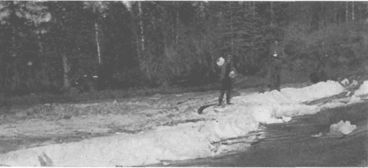
The Slave River from where it leaves Fort Smith to its embouchure in Great Slave Lake is about two hundred miles long, with an average width of half a mile, except where it expands in its course to enclose islands. The big boat behaves beautifully in the water, and on we slip with no excitement until about five o'clock, when a moose and her calf are espied, well out of range. Each in his narrow cell, we sleep the sleep of the just and wake to find ourselves tied to the bank. The captain fears a storm is brooding on Great Slave Lake; so, tethered at the marge of the reedy lagoon, we wait all the forenoon. A corner of Great Slave Lake has to be traversed in order to reach Fort Resolution.
To Samuel Hearne, the Mungo Park of Canada, belongs the double honour of tracing the Coppermine River and discovering Great Slave Lake. Just one hundred and thirty-seven years ago on Christmas Eve, Hearne got his first glimpse of this magnificent inland sea which is cut through the centre by the parallel of 62°, and which lies east and west between the meridians of 109° and 117°. No survey of Great Slave Lake has been made, but it is estimated to have a superficial area of 10,500 square miles—just one-third the size of troubled Ireland, and as great as Delaware, Connecticut, and Rhode Island combined.
Great Slave Lake, lying wholly within the forested region, is three hundred miles long, and its width at one point exceeds sixty miles. At every place on its banks where the fur-traders have their stations ordinary farm-crops are grown. Barley sown at Fort Resolution in mid-May reaches maturity in a hundred days; potatoes planted at the same time are dug in mid-September. The gardens of Fort Rae on the North Arm of the Lake produce beets, peas, cabbages, onions, carrots, and turnips. As Fort Rae is built on a rocky island with a bleak exposure, this would seem to promise in some future day generous harvests for the more favoured lands on the south and west.
The names given by the old fur-traders to their posts make the traveller think that in these North lands he, a second Christian, is essaying a new Pilgrim's Progress. At the south entry to the Lake we are at Resolution; when we cross it we arrive at Providence; away off at the eastern extremity is Reliance; Confidence takes us to Great Bear Lake; and Good Hope stretches far ahead down the lower reaches of the Mackenzie. Fort Resolution on the south side of Great Slave Lake, a little west of the mouth of the Slave, lies back of an island-sheltered entrance.
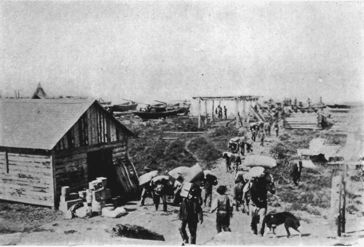
The striking feature as we enter is an immense Roman Catholic Mission school in process of construction, to supplement the existing church and school of that faith. There is neither station of the Mounted Police nor Church of England here; their places are taken by two independent fur-trading concerns operating in opposition to the Ancient Company.
We had been told that the children down North had the kiddies at Fort Smith and Chipewyan "all skinned" for politeness, and we find it even so. The good nuns are trying to make reputable citizens of the young scions of the Dog-Rib and Yellow-Knife nations and are succeeding admirably as far as surface indications go. We approach a group of smiling boys arrayed in their Sunday clothes, awaiting a visit of the Bishop. With one accord come off their Glengarry bonnets, smoking caps, and Christie stiffs, and a row of brown hands is extended to greet us. Very trim the laddies look in their convent-made cadet-uniforms, as, standing at "'Shun!" they answered our every question with, "Yes, missus," "No, missus." When we ask their names, without tittering or looking silly they render up the whole list of saintly cognomens. Here they have once more their white brothers "skinned"; no civilised man, woman, or child ever stood up in public and announced his full baptismal name in an audible tone without feeling a fool. I have seen grizzled judges from the bench, when called upon to give evidence as witnesses, squirm like schoolboys in acknowledging that their godfathers had dubbed them "Archer Martin" or "Peter Secord" or whatever it might be.
It is certainly Old Worldish. We speak with Father Laity who, all unconscious of the commotion around him, marches up and down the trail and reads his breviary. He tells us he is a Breton and that in an age that is past he served as a drummer-boy in the Prussian war. The Father came to this shut-in land forty-one years ago.
Great Slave Lake, which presents a formidable barrier to the passage of the smaller land birds, is a breeding station of the sea-swallow. The Arctic tern hatches on its shores, laying its eggs in the beach gravel. The bird, with its slender body, deeply-forked tail, and shrilly-querulous voice, is everywhere in evidence. Does the whole family of lake birds show any more exquisite colour-scheme than the pearly plumage, small coral feet, carmine bill, and black cap of this tern? In a dell carpeted with silverweed and wild mustard, we come across a nest of our persisting friend, the chipping sparrow. Afterward we wander down to the shore and make the acquaintance of Pilot Julien Passepartout, whose calling as Mackenzie River navigator allows him to live out the largeness of his title, though I like best to think of him by the cradle-name his mother gave him, Tenny Gouley, which means "A man born."
Down at the Treaty tent, Dog-Rib and Yellow-Knife are being handed the five one dollar bills which remind each that he is a loyal subject of His Imperial Majesty Edward the Seventh. The Yellow-Knives were so named by Mackenzie far back in 1789 when he first saw them and their weapons of native copper. Each head of a family is issued an identification-ticket which he presents and has punched from year to year. A father "draws treaty" for his olive-skinned branches until each marries and erects a tepee for himself. Government Agent Conroy, big bodied and big hearted, sits on a nail-keg, represents the King, and gives out largesse; and Mr. Laird presides over the Doomsday book. Inside the tent we take up a sheltered position and watch the fun. There are marked zones of names as well as of vegetation. The Fiddler Anns, Waggon-box Julias, and Mrs. Turkeylegs of the Plains country are absent here, in the Land of the Yellow-Knife, where neither waggon-boxes nor turkeys flourish.
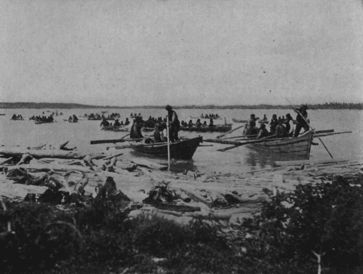
Mary Catholic comes along hand-in-hand with Samuel the Worm. Full of animal spirits is a group of four—Antoine Gullsmouth, Tongue-of-the-Jackfish, Baptiste Wolftail, and The Cat's Son. A little chap who announces himself as T'tum turns out to be Petite Homme, the squat mate of The Beloved. It would be interesting to know just how each of the next couple acquired his name, for neither Trois-Pouces and Owl-Plucked-Out-His-Eye bears evidence of abnormal conditions. On a whole the names are more striking than our John Smiths; Richard Roes, and Tom Browns, as for instance the next three—Le Père des Carriboux, Geroux the Eldest, Alixi To-rong-jo. The-man-who-stands-still is evidently a stand-patter, while one wonders if it would be right to call The-Man-Who-Walks-With-The-Red-Hair, a Crimson Rambler.
Carry-the-Kettle appears with Star Blanket and The Mosquito, and the next man in line, who has the tongs from a bon-bon box stuck in the band of his hat, rejoices in the name of Strike-Him-on-the-Back, which somehow suggests the match-box in the hotel hall-way. As the dignified father, Having-Passed-Many-Birthdays, claims five dollars each for his four daughters, Smiling Martin, My-Wigwam-is-White, and the twins Make-Daylight-Appear and Red-Sky-of-the-Morning, we acknowledge that here again, in the art of naming, the Yellow-Knife has his white brother "skinned."
Birth, dowry, divorce, death, each must be noted on the treaty ticket, with a corresponding adjustment of the number of dollar-bills to be drawn from the coffer. If a man between treaty-paying and treaty-paying marries a widow with a family, he draws five dollars each for the new people he has annexed. If there is an exchange of wives (a not-infrequent thing), the babies have to be newly parcelled out. Through all the family intricacies Mr. Conroy follows the interpreter with infinite patience and bonhomie. To the listener it sounds startling as the interpreter, presenting two tickets says, "He married these three people—this fellow." "O, he give dat baby away to Charles." When we hear in a dazed way that "Mary Catholic's son married his dead woman's sister who was the widow of Anton Larucom and the mother of two boys," we take a long breath and murmur, "If the angle ACB is not equal to the angle ABC, then how can the angle DEF be equal to the angle DFE?" A young couple, looking neither of them more than sixteen or seventeen, return with a shake of the head five of the fifteen dollars proffered them, and the interpreter explains, "Their little boy died—there's only two of them."
Gregory Daniels in a Scottish voice, which cannot quite hide its triumphant ring, pushes back his five dollars and demands forty-five. "I got a wife and siven since last year, she's a Cree wumman." Another half-breed asks anxiously if he would be allowed to send for a "permit" like a white man if he refused to take treaty.
One man with long black hair and a cheese-cutter cap creates consternation at the tent-door by claiming treaty for two wives and seventeen children. Mr. Conroy, scenting an attempt to stuff the ballot-box, produces seventeen matches, lays them at my feet on the tent-floor and asks The-Lean-Man to name them. He starts in all right. We hear, "Long Lodge, Little Pine, Blue Fish, Birdtail, Little Bone, Sweet Grass, Ermine Skin," and then in a monotone he begins over again, "Long Lodge, Little Pine, Blue Fish," and finally gives it up, eagerly asking the interpreter to wait "a-little-sun." The drama of paying and recording has gone on for half an hour and we have quite forgotten The-Lean-Man, when back he comes with Mrs. Lean-Man, Sr., and Mrs. Lean-Man, Jr. Each spouse leads her own progeny. Seeing is believing, and off Lean-Man goes with a fat wallet. We wander into the stores to see what purchases the Indians will make. One young blade is looking at a box of stogies, and the clerk says, "He can afford to blow in his wad on perfumes and cigars, that chap, he got a silver-fox last winter." They tell the story of how old Maurice, Chief of the Chipewyans, put his first treaty money in a cassette and kept it there all the year because he had heard one white man tell another that money grows, and he wanted to see if a white man lies when he talks to another white man.
Sometimes, though, the Indian scores one on the white. This was markedly the case when the first treaty payments were made at Lesser Slave. Two young Jews had followed the treaty party all the way in from Edmonton with an Old Aunt Sally stand where you throw wooden balls at stuffed figures at ten shies for a quarter. "Every time you hit 'em, you get a see-gar!" They thought they were going to clear out the Indians, but it took a bunch of Lesser Slave braves just an hour and a quarter to break the bank at Monte Carlo. As an appreciative onlooker reported, "Them chaps pinked them dolls every time."
As we leave Resolution in the evening through an open door, we get a glimpse of a woman placing her hands in blessing on a boy's head. It is the mother of one of our boatmen, Baptiste Bouvier, or "De-deed." The lad in turn puts a hand on each of his mother's shoulders and kisses her gaily on both cheeks, grabs the camera, and helps us down the bank. The whistle toots impatiently. We both turn and wave our hands to the mother at the open door.
Travelling all night, we do not go to bed, but merely throw ourselves down for an hour's rest about midnight, for we must not lose the light effects on this great silent lake. As the captain finds, amid shifting sandbars, a fairway for his vessel, there comes offshore the subdued night-noises of the small wild things that populate the wilderness. Here a heavy tree, its footway eaten out by the lake-swirl round a high point, slumps into the water, and joins the fleet of arboreal derelicts. The raucous voice of a night-fowl cries alarm. Then there descends over all a measureless silence. At three o'clock in the morning we haul into the Hay River Mission, where the familiar mosquito-smudge greets us at the landing.
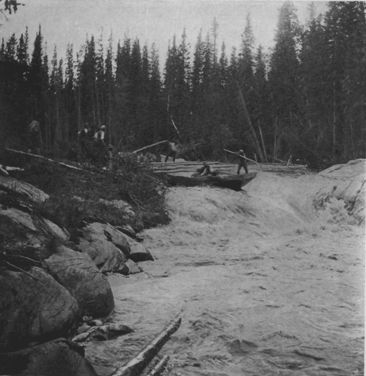
This was by far the most attractive English Church Mission in the whole North—although comparisons are odorous and yet illuminating. All Hay River had been up over night, anticipating their yearly mail. Red girls and boys of every tribe in the North are housed in this Mission, learning how to play the white man's game—jolly and clean little bodies they are. It looks like Christmas time. Parcels are being done up, there is much whispering and running to and fro, and the sparkling of black eyes. Would you like to see the letters that The Teaser, The Twin, Johnny Little Hunter, and Mary Blue Quill are sending out to their parents? For the most part the missives consist of cakes of pink scented soap tightly wrapped round with cotton cloth, on which the teachers are writing in ink the syllabic characters that stand for each father's and mother's name. The soap has been bought with the children's pennies earned by quill-work and wood-carving done in the long winter nights. The parcels will be passed from one trapper's jerkin to another, and when, months afterwards, they reach their destination in far tepee or lodge of the deerskin, Mrs. Woman-of-the-Bright-Foam and Mr. Kee-noo-shay-o, or The Fish, will know their boys and girls "still remember."
One of the Hay River teachers is married to a Chicagoan who started ten years ago for the Klondike, knew when he had found pure gold, ceased his quest here, and lived happily ever after. Their children are the most fascinating little people we have seen for many months. Life is quaint at the Hay River Mission. The impression we carry away is of earnest and sweet-hearted women bringing mother-love to the waifs of the wilderness, letting their light shine where few there are to see it. We discover the moccasin-flower in bloom, see old Indian women bringing in evergreen boughs for their summer bedding—a delightful Ostermoor mattress of their own devising. Dogs cultivate potatoes at Hay River in summer, and in the winter they haul hay. The hay causes our enquiry, and we learn that this Mission boasts one old ox, deposited here no doubt by some glacial drift of the long ago. And thereby hangs a tale. Charlie, an attaché of the school-force, drove this old ox afield day by day. As man and beast returned wearily in the evening, the teachers asked, "Well, what happened to-day, Charlie?" "Bill balked," was the laconic reply. Tuesday's question would bring the same response, "Bill balked." And "Bill balked," on Wednesday. Thursday it is—"Bill didn't balk"; and so the days divided themselves into days of blueness and red-letter days.
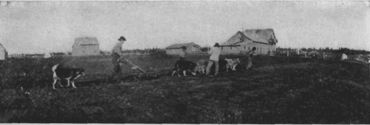
The mean July temperature at Hay River is 60° Fahrenheit, and the monthly mean for January, 18° below zero. Vegetables of their own growing, with whitefish from the lake, furnish almost the entire food supply of this thrifty Mission, one season's harvest giving them a thousand bushels of potatoes, fifteen of turnips, and five each of beets, carrots, and parsnips, with two hundred cabbages and over ten thousand whitefish.
Hay River has never been explored. It is supposed to head near the source of the Nelson and to flow northeast for three hundred miles before emptying, as we see it, into Great Slave Lake. This river marks the limit of those grassy plains which extend at intervals all the way from Mexico northward. Bishop Bompas, years ago, descended a long stretch of the river, discovering not far back from where we stand a majestic cataract, which he named the "Alexandra Falls" after the then Princess of Wales. He describes it as a perpendicular fall one hundred feet high, five hundred feet wide, and of surpassing beauty. "The amber colour of the falling water gives the appearance of golden tresses twined with pearls."
Crossing Great Slave Lake, we think of Chant-la, Chief of the Slavis at Hay River. Bishop Reeves was anxious to convert him to the Christian faith, but had great difficulty in giving Chant-la a proper conception of the Trinity. The old man would not say he believed or understood what was inexplicable to him. Setting out once on a long journey, the cleric adjured the Chief to struggle with the problem during his absence. The Bishop returning, Chant-la came out in his canoe to meet him, eagerly reporting that all now was clear. "It is like Great Slave Lake," said the old man. "It is all water now, just like the Father. When winter comes it will be frozen over, but Great Slave Lake just the same; that is like the Son. In the spring when the ice breaks and the rain makes the snow into slush, it is still Great Slave Lake; and that is like the Holy Ghost."
Beyond Great Slave Lake, forty-five miles down the Mackenzie, we reach Fort Providence, as strongly French in its atmosphere as Hay River is British. Our coming is a gala day. The hamlet flies three flags, the free trader sports his own initials "H.N.," the Hudson's Bay Company loyally runs the Union Jack to the masthead, over the convent floats the tri-colour of France. Fort Providence is hot. We walk to the convent and are hospitably received by the nuns. They call their Red flock together for us to inspect and show us marvellous handwork of silk embroidery on white deerskin. The daintiest of dainty slippers calls forth the question, "Where are you going to find the Cinderella for these?" A blank look is my answer, for no one in Providence Convent has ever heard of Cinderella! But then, convents are not supposed to be the repositories of man-knowledge (although a half-breed, on our passage across the lake, did whisper a romantic story of a Klondiker who assailed this very fortress and tried to carry off the prettiest nun of the north). The garden of the Sisters is a bower of all the old-fashioned flowers—hollyhocks, wall-flower, Canterbury bells, and sweet-William—and down in the corner a young girl of the Dog-Ribs discovers to us a nest of fledgling chipping sparrows.
As we landed from the boat, Tenny Gouley dressed in his Sunday best had beamed, "Nice day—go veesit." And "veesit" we did. Mrs. Herron, of the H.B. Company, has spent many years at Old Fort Rae, and her thoughts hark back to one severe winter spent there. She turns to the wife of our good Captain with, "Hard living, Mrs. Mills, dry suckers." It is a short speech, but fraught with meaning. I honestly think a dry sucker (well sanded) the least succulent of all the impossible fish-dishes of the North. There are many young Herrons all as neat as new pins, the last—no, the latest, enshrined in a moss-bag. Tradition tells that once, when they were fewer in number, the father took the flock out to Winnipeg to school. The children cried so at the parting that Mr. Herron turned and brought them all back with him to the Mackenzie!
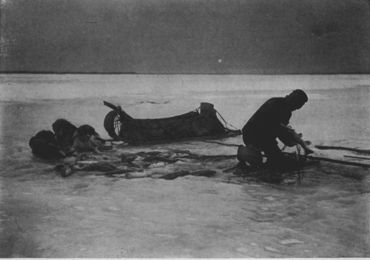
The most interesting man in all Fort Providence is David Villeneuve, one of the Company's Old Guard. He was anxious to be "tooken" with his wife and grandchild, and over the camera we chatted. David goes through life on one leg—fishes through the ice in winter, traps, mends nets, drives dogs, and does it all with the dexterity and cheerfulness of a young strong man. He tells of his accident. "I was young fellow, me, when a fish-stage fell on me. I didn't pay no notice to my leg until it began to go bad, den I take it to the English Church to Bishop Bompas. He tole me de leg must come off, an' ax me to get a letter from de priest (I'm Cat-o-lic, me) telling it was all right to cut him. I get de letter and bring my leg to Bompas. He cut 'im off wid meat-saw. No, I tak' not'in', me. I chew tobacco and tak' one big drink of Pain-killer. Yas, it hurt wen he strike de marrow."
"Heavens! Didn't you faint with the awful pain?"
"What? Faint, me? No. I say, 'Get me my fire-bag, I want to have a smok'.'"
We have just finished supper and are sitting reading on the upper deck about seven o'clock, when a cry comes from below, followed by the rushing back and forth of moccasined feet. In a flash Bunny Langford, one of the engineers, has grabbed a lifebuoy, runs past us to the stern, and throws it well out toward a floating figure.
It is De-deed, De-deed who had smilingly helped us aboard at Resolution just twenty-four hours before. Finishing his turn at stoking, he had gone to draw a bucket of water, leaned over too far, and fallen, carrying the hatch with him. At first we think nothing of the incident, as he is a good swimmer and the current is with him. As soon as the startled people realise what has happened the steamer's engines are reversed and a boat is lowered. We call out to De-deed to swim to the buoy, but he doesn't see it or doesn't understand. The black head gets smaller in the distance; it disappears, and comes up again. Down it goes for the second time. A strange, constricted feeling comes into our throats as we cry out, "Swim, De-deed, the boat is coming! They are almost up to you!" The boat, pulling hard against the current, seems but a dozen yards away. Will he hold up? As we look, the head sinks, and it does not come up. Within a few feet of buoy and boat, the body of De-deed disappears for the last time. We search for an hour or more with grappling irons, but he is never seen again. A strange silence settles down above and below deck, and all night long two faces flit before us—the grave face of the mother calling down blessings on her boy, the rallying smile of De-deed bidding her good-by and telling her all is well. It is a brave and happy spirit which, in the "Little Lake" of the Mackenzie, goes out with the current.
The Mackenzie River, "La Grande Rivière en Bas," as the people of Resolution call it, on whose waters we are now fairly embarked, is the greatest water-way in the British Empire, and of earth's great rivers the one least traversed by man. Counting back from the headwaters of either its more northerly tributary the Peace or its southern feeder the Athabasca, the length of the river is three thousand miles. At Little Lake, where it issues out of Great Slave Lake, the Mackenzie is eight miles wide, and its delta a thousand miles below here has an expansion of fifty miles. The average width of the stream, as we traverse it from source to mouth, is a mile and a half, widening out often in its sweep to two and a half to three miles.
From Little Lake the current is somewhat sluggish, the river bank seldom exceeding one hundred feet in height until we reach what is known as "The Head of the Line." Before the advent of steam on the Mackenzie, when the patient voyager made his way up south from the ocean, it was at this point that the tracking-line was exchanged for oars. The plains bordering the river here are forested with white spruce and broken with muskeg and lakes. The statistician on board works out that the volume of water the Mackenzie carries to the sea is half a million feet a second. No one is wise enough to challenge his calculation, and we merely hazard a wonder if this most magnificent water-power will ever be used for commercial and economic purposes. There is surely enough "white coal" rushing by us to turn the wheels of the factories of a continent. The Mackenzie is the only river whose basin is cut by a thousand mile range. The sources of the Peace and the Liard lie on the west side of the Rockies, from where these giant feeders bring their tribute to the main river through passes in that range.
At intervals all the way down the river to Fort Simpson we are treated on our right hand to views of the Horn Mountains, which slope away on their north side but show a steep face to the south. Along our course the bluish Devonian shales are capped by yellow boulder-clay.
We awaken on Friday, July 10th, to find ourselves at Rabbitskin River and everybody busy carrying on wood for fuel. By ten o'clock we are at Fort Simpson in latitude 62°, the old metropolis of the North. Fort Simpson is built on an island where the Liard River joins the Mackenzie, the river being a mile and a half wide at this point. The foundation of the fort dates back to the beginning of the nineteenth century, when it was known in fur annals as "The Forks of the Mackenzie."
Simpson is essentially a has-been. We look upon the warehouses of its quadrangle with their slanting walls and dipping moss-covered roofs and try to conjure up the time long past when all was smart and imposing. In those days when the Indians brought in their precious peltries they were received and sent out again with military precision and all that goes with red tape and gold braid. Surely the musty archives of Simpson hold stories well worth the reading! We would fain linger and dream in front of this sun-dial across whose dulled face the suns of twenty lustrums have cast their shadows, but we begrudge every moment not spent in fossicking round the old buildings. We seek for threads which shall unite this mid-summer day to all the days of glamour that are gone. In a rambling building, forming the back of a hollow square, we come across the mouldy remains of a once splendid museum of natural history, the life work of one Captain Bell of the Old Company. It gives us a sorry feeling to look at these specimens, now dropping their glass eyes and exposing their cotton-batting vitals to the careless on-looker, while the skeleton ribs of that canoe with which Dr. Richardson made history so long ago add their share to the general desolation. In a journal of the vintage of 1842 we read an appeal for natural history exhibits sent to Fort Simpson by an official of the British Museum. He writes,
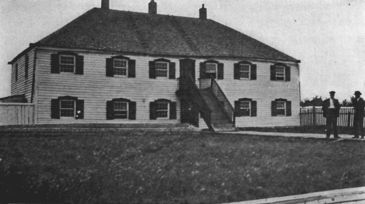
"I may observe that in addition to the specimens asked for, any mice, bats, shrew-mice, moles, lizards, snakes or other small quadrupeds or reptiles would be acceptable. They may either be skinned or placed in rum or strong spirits of any kind, a cut being first made in the side of the body to admit the spirits to the intestines."
Of all the rare humour disclosed in the old records, this entry most tickles my fancy.
I think of the little group that we had forgathered with at Chipewyan, driven even in this year of grace to lavender-water and red ink, when permits run dry. One turns back the clock to the time of the Chartists and the year of the nuptials of the young Queen in England. We see up here on the fringe of things the dour and canny but exceedingly humorous Adam McBeaths, John Lee Lewises, and George Simpsons, the outer vedette of the British Empire; and, seeing them, get some half-way adequate conception of what a modicum of rum or "strong spirits of any kind" meant in the way of cheer at old Fort Simpson in those days. When we try to get a picture of one of these Hudson's Bay men gravely opening a shrew-mouse, mole, or "other small quadruped," while his chum pours in the aqua vitae or precious conversation water, we declare that science asks too much.
An outer stairway leading to the second story of a big building invites us. Opening the door, we find ourselves in the midst of an old library, and moth and rust, too, here corrupt. We close the door softly behind us and try to realise what it meant to bring a library from England to Fort Simpson a generation ago. First, there arose the desire in the mind of some man for something beyond dried meat and bales of fur. He had to persuade the authorities in England to send out the books. Leather-covered books cost something six or seven decades ago, and the London shareholders liked better to get money than to spend it. We see the precious volumes finally coming across the Atlantic in wooden sailing-ships to Hudson Bay, follow them on the long portages, watch them shoot rapids and make journeys by winter dog-sled, to reach Simpson at last on the backs of men. The old journals reveal stories of the discussion evoked by the reading of these books afterward as, along with the dried fish, deer-meat, and other inter-fort courtesies, they passed from post to post. Was never a circulating library like this one. And now the old books, broken-backed and disembowelled, lie under foot, and none so poor to do them reverence. Everything is so old in this North that there is no veneration for old things.
It is but a few years since the founder of this library died, and his son now sits in his saddle at Fort Simpson. If you were to wander across the court, as I did to-day, and look into the Sales Shop, you would see the presentation sword of this last-generation Carnegie, ignobly slicing bacon for an Indian customer. Sic transit gloria mundi!
What are the books which this sub-Arctic library sent out? We get down on the floor and gently touch the historic old things. Isn't it Johnson who says, "I love to browse in a library"? Judging by the dust and cobwebs, there hasn't been much browsing done among these volumes for years. Present-day Simpson has seldom "fed on the dainties that are bred in a book." Here is a first edition of The Spectator, and next it a Life of Garrick, with copies of Virgil, and all Voltaire and Corneille in the original. A set of Shakespeare with exquisite line drawings by Howard shows signs of hard reading, and so does the Apology for the Life of Mr. Colly Cibber. One wonders how a man embedded in Fort Simpson, as a fly in amber, would ever think of sending to the Grand Pays for Burton's Anatomy of Melancholy, yet we find it here, cheek by jowl with The Philosophy of Living or the Way to Enjoy Life and Its Comforts. The Annual Register of History, Politics, and Literature of the Year 1764 looks plummy, but we have to forego it. The lengthy titles of the books of this vintage, as for instance, Death-Bed Triumphs of Eminent Christians, Exemplifying the Power of Religion in a Dying Hour, bring to mind the small boy's definition of porridge—"fillin', but not satis-fyin'." Two more little books with big titles are Actors' Budget of Wit and Merriment, Consisting of Monologues, Prologues and Epilogues, and The London Prisons, with an Account of the More Distinguished Persons Who Have Been Confined in Them.
But the book that most tempts our cupidity is Memoirs of Miss A—— n, Who Was Educated For a Nun, with Many Interesting Particulars. We want that book, we want to take it on with us and read it when we reach the Land of the Eskimo, where the Mackenzie slips into the Arctic by all its silver mouths. We lift the volume up, and put it down again, and we hunger to steal it. Jekyll struggles with Hyde. At last the Shorter Catechism and the Westminster Confession of Faith triumph; we put it down and softly close the door behind us. And ever since we have regretted our Presbyterian training.
At Fort Simpson, it is like walking across a churchyard or through an old cathedral. Here men lived and wrought and hoped, cut off from their kind, and did it all with no thought of being heroic. We walk along the shore to watch Indian women busied in making a birchbark canoe and in washing clothes with washboards—the old order and the new. A little dive into the mosquito-ridden woods discloses a wonderful patch of Pyrola and a nest of Traills' flycatcher, and makes us wish that the minutes were longer and the mosquitoes fewer. What a beautiful tiling this Pyrola is, with its inverted anthers and the cobwebby margins of its capsule! Its bracted, nodding flowers run through all shades of white, pale yellow, and dark yellow.
Down on the beach we chat with a prospector and his son, a lad of fifteen, who are building a skiff in which to ascend the Liard, hunting gold. Yesterday a Mr. and Mrs. Carl and a Mr. and Mrs. Hall passed us on the river. Outfitted for two years, they will prospect for gold in the Nahanni Mountains and toward the headwaters of the Liard. One of the couples has just come out from Glasgow and this is their honeymoon. We half envy them their journey. Can anything compare with the dear delights of travelling when you do not know and nobody knows just what lies round the next corner?
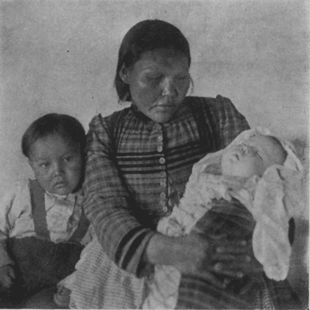
The dogs at Simpson are "wicked." Picking our way among them, I particularly approve this term of the natives, attributing as it does a human conception and malice aforethought to these long-legged wraiths. The first articulate sound an Indian child of the Mackenzie learns to make is "Mash!" an evident corruption of the French "Marche." This is what Shakespeare meant when he speaks of "a word to throw at a dog." A brown baby just emerged from the cocoon stage of the moss-bag toddles with uplifted pole into a bunch of these hungry mongrels and disperses them with a whack of the stick and the lordly "Mash!" of the superior animal. For our own part we are "scared stiff," but follow along in the wake of our infant protector to a wee wooden church which staggers under the official title, "The Cathedral of St. David."
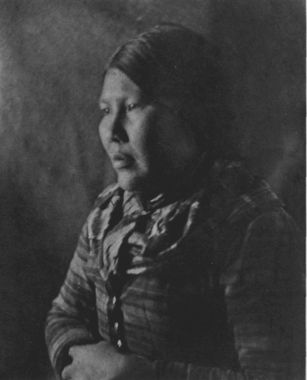
We have had occasion to speak of the splendid service rendered to Northern and Western Canada by the Hudson's Bay Company and by the Royal Northwest Mounted Police. A third factor through the years has been building Empire with these. Are we not as a people too prone to minimise the great nation-building work performed by the scattered missionaries in the lone lands beyond the railway? Ostensibly engaged in the work of saving souls, Canadian missionaries, both Roman and English, have opened the gates of commerce, prosecuted geographical discovery, tried to correct social evils, and added materially to our store of exact science. Through their influence, orphanages have been founded, schools established, and hospitals opened. Creeds take a secondary place to deeds in this land, and when you discuss a man, be he cleric or layman, the last thing you ask is, "To what church does he belong?" Incidentally, it does seem rather odd that with Scottish blood running through the veins of nine-tenths of the people of this North as yet no Presbyterian missionary has penetrated beyond the latitude of Edmonton. The great Churches of England and Rome, north of the Athabasca, divide the field between them.
The records of the whole missionary world show no more striking figure than that of Bishop Bompas of the Anglican Church. We have already had two glimpses of this young Cockney curate; once, hoisting his homemade Union Jack on the ox-cart at St. Cloud, and, again, passing north as the wild-fowl flew south in October, 1865, chronicled by the Chipewyan scribe merely as "a Protestant missionary coming in a canoe from the Portage." In the forty years of missionary life which intervened between his coming into the North and his death in the Yukon just two years ago, only twice did the Bishop emerge from these Northern fastnesses. It is literal truth to state that no one on any part of the world's map has ever made so many long and toilsome journeys as did this man. With his sheep scattered over a country a million square miles in extent, we might compare a parochial visit of this parson to a barge-journey from London to Constantinople, replacing the European capitals by Hudson's Bay forts, and substituting for Europe's vineyards and pleasant vales an unbroken line of jack-pine and muskeg.
We are told that Bishop Bompas's father was Dicken's prototype for Sergeant Buzfuz. A new vista would open up to the counsel for Mrs. Bardell could he turn from his chops and tomato-sauce to follow the forty-years' wandering in the wilderness of this splendid man of God, who succeeded, if ever man succeeds, in following Paul's advice of keeping his body under.
Bishops Bompas was one of the greatest linguists the Mother Country ever produced. Steeped in Hebrew and the classics when he entered the Northland, he immediately set himself to studying the various native languages, becoming thoroughly master of the Slavi, Beaver, Dog-Rib, and Tukudk dialects. When Mrs. Bompas sent him a Syriac testament and lexicon, he threw himself with characteristic energy into the study of that tongue. There is something in the picture of this devoted man writing Gospels in Slavi, primers in Dog-Rib, and a Prayer Book in syllabic Chipewyan, which brings to mind the figure of Caxton bending his silvered head over the blocks of the first printing-press in the old Almonry so many years before. What were the "libraries" in which this Arctic Apostle did his work? The floor of a scow on the Peace, a hole in the snow, a fetid corner of an Eskimo hut. His "Bishop's Palace," when he was not afloat, consisted of a bare room twelve feet by eight, in which he studied, cooked, slept, and taught the Indians.
They tell you stories up here of seeing the good Bishop come back from a distant journey to some isolated tribe, followed at heel by a dozen little Indian babies, his disciples for the days to come. Bishop Bompas lived in one continent, but manifested in two, keeping himself closely in touch with the religious and Church growth of the Old World. When the British press had been given over to any particular religious-controversial subject, and the savants had finally disposed of the matter to their own satisfaction, travelling out by summer traverse or winter dog-sled would come a convincing pamphlet by Bishop Bompas, to upset altogether the conclusions of the wranglers.
There is one tale of this man which only those can appreciate who travel his trail. An Indian lad confides to us, "Yes, my name is William Carpenter—Bishop Bompas gave me my name, he was a good man. He wouldn't hurt anybody, he never hit a dog, he wouldn't kill a mosquito. He had not much hair on his head, and when it was meetsu, when the Bishop eat his fish, he shoo that mosquito away and he say, 'Room for you, my little friend, and room for me, but this is not your place: go.'"
We call upon the present incumbents of the little church of St. David. They are young people, the Rev. and Mrs. Day, putting in their first year in this Northern charge. Their home with its spotless floors and walls papered with old copies of The Graphic and Illustrated London News is restful and attractive. The garden of the parsonage shows an amount of patient work on the part of some one. Potatoes eighteen inches high and peas twice the height of this, with turnips and cabbages and cauliflower are good to look at. There are records to show that, years ago, Fort Simpson produced tomatoes and decent crops of barley.
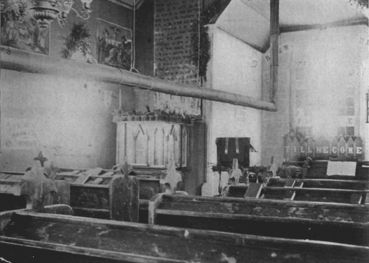
Entering the little church we see the neat font sent here by Mrs. Bompas, "In dear memory of Lucy May Owindia, baptised in this Church, January, 1879." Owindia was one of the many red waifs that the good Bishop and Mrs. Bompas took into their big hearts. Her story is a sad one. Along the beach at Simpson, Friday, an Indian, in a burst of ungovernable temper murdered his wife and fled, leaving their one baby to perish. It was not until next day that the little one was found, unconscious and dying. The Bishop and Mrs. Bompas took the child into their loving care. To the name Owindia, which means The Weeping One, was added the modern Lucy May, and the little girlie twined herself closely round the hearts of her protectors. When the time seemed ripe, Owindia was taken back to England to school, but the wee red plant would not flourish in that soil. She sickened and died. Hence the memorial and the inscription we read this July day. Much history of militant energy, much of endurance, and countless chapters of benevolence did the good Bishop write into the history of the North before, off on the Yukon side in 1906, "God's finger touched him and he slept."
Missionaries of the present day are not without their troubles. Mrs. Day tells of potato-whiskey making in some illicit still back in the mosquito-woods, the results of which she fears; and, even as we speak, an Indian lunatic pokes his head through the palings of the potato-patch. From far back in Fort Nelson, British Columbia, and from Fort Liard, the Hudson's Bay men have come to make their reports to Mr. Brabant at Simpson. They brought their wives and babies with them, brought also a quantity of beautiful porcupine-quill work, Fort Liard being one of the few places in the North where this art flourishes. Tomorrow they will start back, tacking against the stream, as the imported brides are doing before them.
To dive into the journals of the past, of which the loft above the offices here at Simpson is full, is even more interesting than talking with the people of the present. We take 1837, the year which saw the accession in England of the young and well-beloved Queen, and from these musty books unearth a running commentary of what is doing in Fort Simpson in that year.
"1837, January 1. The people were brought into the Hall, and enjoyed their meal with great appetites, being also treated to a glass of wine and a fathom of tobacco and a pipe. Wind East."
"1837, February 11. Rabbits are numerous, but the ladies of the Establishment make no great effort in snaring them."
"1837, February 14. Late last night arrived a woman, Thawyase, and a boy, the family of the late Thoesty. They have all come to take refuge here as they are starving. The woman at dusk decoyed old Jack away to camp in the woods—and the old fellow has found a mate."
One wonders if either Thawyase, the decoyed Jack, or the old chronicler was conscious of the fact that this was St. Valentine's Day.
"1837, March 27. Two geese have been seen to-day, the first this season."
"1837, May 2. Marcel sowed some oats. Mosquitoes begin to become annoying."
"1837, May 5. Wild fowl are beginning to frequent the small lakes of the neighbourhood. The willows and young trees are now budding forth beautifully."
"1837, May 18. Hope began to plough this morning with the bull, but as this is the first time he has been yoked, the day's work is found to be but poor."
"1837, May 19. Felix and Roderick McLeod made twelve bags of pemmican to-day."
1837, May 21. The Mackenzie River broke up to-day, and continued drifting pretty thick till evening."
"1837, June 18. Some of the Indians killed a bear before the door and it supplied us with a little fresh meat."
"1837, June 19. Flies so numerous that we are under the necessity of putting our cattle into the stable, otherwise they will fall victims to the cruel insects."
"1837, June 20. Weather very suffocating, thermometer 85 above at three p.m., not as much as a cloud to be seen in the firmament and not the least air to afford any refreshment; this along with the solitude of the time is enough to make people dull. No Indian from any quarter: well supplied with ammunition last spring, they forget us when they can get their own mouths satisfied. Ashley grinding barley in the steel mill."
"1837, June 21. Le Mari has just brought in some fish and a little bearskin in order to get a chemise, he says he is not able to hunt without a chemise, as there are so many flies just now. I have taken it upon myself to give him the shirt on credit."
Here a new hand writes the records, untrammelled by any orthographic rules.
"1837, June 24. Flys very numerus and trublsome to the Cattel."
"1837, July 11. Starvan Indians going and coming ourly."
"1837, July 13. Six squas arrived with plenty Bearrys—that's all they subsist on in this part of the River."
"1837, July 26. Barley is getting ripe. But small birds nip off the ends of the stalks as fast as it ripens."
"1837, August 23. Last night the bull broke into one of the gardens where oats was sown and eat the whole up."
"1837, September 18. An Express arrived from Fort Norman with despatches from the Gentlemen of the Arctic Discovery Expedition, and it is most satisfying to learn that the first object of the Expedition was successfully accomplished: on the 4th August the Company's flag was planted on Point Barrow."
"1837, September 19th. Louson put parchment in the window-frames."
"1837, October 11. Ice is forming since yesterday along the beach."
"1837, November 1. This being the holiday for All Saints, the men though no saints celebrated it off duty. The weather cold but fine."
"1837, November 2. I have been these two days occupied with the blacksmith in making an oven, and this evening it being finished we give it a fair trial by placing a large trout in it for supper and it is found to answer most excellently."
"1837, November 3. Strong northwest wind with drift and cold. About one o'clock of last night the Aurora had a most unusual appearance, seemingly black in place of the white commonly observed and forming an arch from east to west, consisting of five streaks, here and there broken off."
"1827, November 5. Blacksmith making iron runners for our traineaux from old gun-barrels."
"1837, November 30. This being the anniversary of the Tutelar Saint of Scotland, we had in addition to our usual dinner a roasted swan and a moose-nose, a rice pudding, a cranberry tart, and a glass of wine."
"1837, December 1. I was obliged to give four pounds of dried meat to the dogs for there are some that are almost dead and they et all the windows of the Forge."
"1837, December 2. Three of the Fort women fell into a fit of insanity and kept all of the men at the Fort to hold them and prevent them devouring themselves."
December 25. Thermometer 35 below the cypher this morning, this being Christmas no labour done. Wind N.W."
"1838, January 1. The morning was ushered in by a salute fired by our people at the windows and doors, after which they came to wish us a Happy New Year—and in return, in conformity to the custom of the country they were treated, the men with half a glass of brandy each, and the women with a kiss, and the whole of them with as many cakes as they choose to take and some raisins. One of our gentlemen who had a bottle of shrub treated them to a glass, and after some chit-chat conversation they retired, firing a salute on going out. In the evening they played at Blind-man's-buff, concluding the fête by a supper in the Hall. I also gave each of the men a fathom of twist tobacco and a clay pipe."
—Chas. G.D. Roberts.
About ten o'clock on the evening of July loth, in broad daylight, we push out from Fort Simpson, with the whole population, white, red, and parti-coloured, on the banks to bid us good-bye. We have seen present-day Simpson and opened for a little way the volume of the past. We try to imagine what it is like in winter-time, and a picture pushed into our hands at parting gives us another viewpoint, showing the hamlet photographed by the light of the Aurora. As we leave Fort Simpson, the Mackenzie's channel is a mile wide and it increases in width as we proceed. For about seventy-five miles the course of the river is due northwest, running four miles an hour. The banks look low, but when the pilot takes us close in to shore, we see that it is the size of the river which has cheated our eyes, and the cliffs that seemed so low-lying will measure two hundred feet or over. At the Great Bend we impinge against two peaks, Mt. Camsell and Mt. Stand Alone, and here the Nahanni joins the Mackenzie. The great river takes a due north course for another thirty miles, and the Willow River flows in from the east.
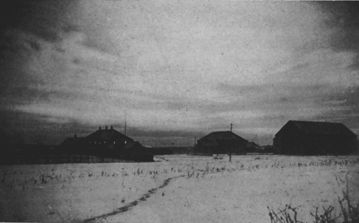
At this point the Mackenzie enters the Rockies, this great spinal mountain-chain of North America breaking into parallel ranges to allow the mighty flood to flow between. We feel, as the boatman did on Lake Athabasca, that a day is as long as you can go without stopping. A ladder takes us to a seat by the side of Tenny Gouley in the pilot-house, who merely drops the window to give us an unobstructed view, and says nothing. Tenny Gouley is one of the rare people who understand. Talk of civilising these half-breeds of the North! They have that gift of repose which we know nothing of, which we may hope to attain after we have lived through automobiles and air-ships and when many incarnations will have allayed the fever of that unrest which we so blatantly dub "progress."
It is an ancient something, this unmapped Mackenzie into whose silence we intrude. Before man was, these waters had cut for themselves a road to the ocean. These banks were once marked by the mammoth. Previous to the Glacial Age, prehistoric man here hunted prehistoric prey; eons passed; and when the Ice Age went out, willows and aspens occupied the silt, delicate flower-growth flourished, and birds sang in the branches.
Three thousand miles of waterway, forest-fringed and rampart-guarded, and of its treasures the world knows naught! They await man's development and acceptance—banks of pitch, wells of oil, outcroppings of coal, great masses of unmined salt, mineral wealth uncounted and unguessed. Silent forests have followed us from where we entered the Athabasca, and these woods persist to where the great river divides into its delta channels. Of the mineral wealth of the Liard, the Peace, the Nahanni, and the half hundred other waterways tributary to the Mackenzie, practically nothing is known. There remain in these streams hundreds of miles unnavigated, and channels innumerable known only to the inconnu and the Indian.
It is one hundred and twenty years since Mackenzie descended this stream to its mouth, "discovering" a river along whose shores centuries before had smoked the watch-fires and risen the tepees of an anterior race, wanderers from Asia, who here, guiltless alike of onlooker or chronicler, lived and loved and worked out their drama of life. Age follows age, a new generation is evolved in the new habitat, and in time these once-migrants from Asia are dubbed "the red men" and "the American Indian."
We watch out the night with Tenny Gouley. In the early morning, sharply turning a corner, we flush a mixed family of water-fowl—gulls in great variety, something that looks like a brant, and a loon with its uncanny laughter. Snipe are on every batture, and sand-pipers, with kingfishers and all the lesser waders. The boreal summer is short and if broods are to be raised there is no time to waste. A riot of blossoms fringes the banks—the uplifted magenta torches of the fireweed, tufts of vivid golden-rod, the pink petals of the rose, and a clustering carpet of moss dotted with the dead white of the dwarf cornel. Now and again a splash breaks the silence, as great slices of the bank, gnawed under by the swollen river, slip into the current, carrying each its cargo of upstanding spruce. So the channel of the Mackenzie is ever being modified, and no permanent chart of its course can be attempted.
Winter changes all this. With October the leaves fall and the waters begin to crisp into ice, fishes and fowl part company, the birds fly south to kinder skies, the inconnu hurry northward seeking the sea. Out of the sky comes the snow, the half-breed's "Le convert du bon Dieu," silent, soft, and all-covering. The coat of fox and rabbit and ptarmigan whitens, too. It is the coming of stern winter. Wandering Dog-Rib, Slavi, and Loucheux, lone trapper, the people of each isolated fur-post, must alike take warning. God pity man or beast who enters the six months of a Mackenzie winter unfortified by caches of food or unwitting of shelter.
According to Tenny Gouley there are but two seasons in this country: the ice season and the mosquito season. He likes winter best. As he holds the wheel in those clever hands of his, we fill and light his pipe for him, and half a dozen of his illuminating phrases give us a clear-cut etching of the winter story. From the lowest form of life to the highest it is a struggle for existence. Sinuous as a serpent, the mink in his man-envied coat winds among the willows on rapine bent, the marten preys upon the field-mouse, the lynx hunts the hare, each form of life pursues a lower while hiding from a higher, and all are the prey of the great hunter, man.
In these high latitudes it is the wind that is feared rather than the intense cold. Before the coming of the missionary, the Indian of the Mackenzie basin heard in the winter wind no monition. The storm spoke not to him of Divine wrath or an outraged Deity. The wind was the voice of God, but it assured the heathen Slavi of protection and power—the Gitchi Manitou coming out of the all-whiteness to talk with his children.
Spring up here is but a flutter of invisible garments; even when one is saying "Spring," full-blown summer is hot afoot. In high noon, in the open places, pools of water form in the ice. With glee is hailed the honk of the first wild goose, the coats of ptarmigan and rabbit thin and darken. There is water on the trail of the kit-fox. The subsidiary streams that feed the Mackenzie fill their banks and flush the rotting ice. With a crash, the drift-logs, with pan-ice and floating islands and all the gathered debris, roll headlong to the frozen ocean.
Do we wonder that Indians worship the great forces of Nature? Gloomy and wide-reaching between her banks of tamarack and spruce, now opening into a lake expansion, here narrowing between her stony ramparts, but ever hurrying on and on and on to that far ocean of ice, the Mackenzie has always been good to her own, the self-contained and silent people along her banks. In this vast land men speak not of bread as the staff of life; their unvoiced prayer is, "Give us our fish in due season." From the waters of this river, since man was, have the Indians drawn and dipped and seined their sustenance—inconnu, jack-fish, grayling, white-fish, and loche. The wide bosom of the Mackenzie, in winter's ice or summer's spate, forever has been the people's highway—a trail worn smooth by sled-runner and moccasin in the ice-season, melting its breast in the spring-time to open a way to the questing bow of the birch-bark.
Along these banks, forgotten tepee-poles, deserted fish-stage, and lonely grave remain, a crumbling commentary of yesterday, a hint of recurring to-morrows. Son succeeds father, race replaces race, but the great Mackenzie flows on, and, as it flows, unwritten history along these banks is ever in the making. Tragedy and triumph, self-aggrandisement and self-obliteration, are here as well as in the noisy world we have left. Lessons these are for us, too, if we bring the keen eye and listening ear. Among Mackenzie tribes no Yellow-Knife, Dog-Rib, or Slavi starved while another had meat, no thievish hand despoiled the cache of another. A man's word was his bond, and a promise was kept to the death. Not all the real things of life are taught to the Cree by the Christian. Courage is better than culture, playing the game of more importance than the surface niceties of civilisation, to be a man now of more moment than to hope to be an angel hereafter.
About noon we reach Fort Wrigley, and are boarded by priests and Indians all interested in the new steamer and impressed with its size. One asks if it is a boat or an island, and another declares it is "just like a town." Fort Wrigley is an inconspicuous post with a dreary enough record of hunger and hardship. We find it rich in flowers and will always remember it as the one place in the North in which we gathered the fringed gentian (Gentiana crinata) with its lance-shaped leaves, delicately-fringed corollas, and deep violet blue. The fringed gentian is rapidly becoming a thing of the past in a great many localities, and it gives us pleased surprise to find it far up in latitude 63°. Purple asters are here, too, and the heart-shaped seed-pods of shepherd's-purse or mother's-heart. Wrigley adds to our collection the green-penciled flowers of the grass of Parnassus, with wild flax, and both pink and purple columbines already forming seed.
Below Wrigley rugged ranges border both sides of the river at a distance from the shore-line of ten or twelve miles, and we come to Roche Trempe-l'eau or "The Rock by the Riverside," an outcrop of Devonian limestone rising on the right bank a sheer fifteen hundred feet above the river. We come into view of the "boucans" or beds of lignite coal which have been continuously burning here since Mackenzie saw them in 1789 and mistook their smoke for tepee fires. At this point of his journey, had Mackenzie been a timorous man, he would have turned back, for natives came to meet him and told him with great empressment that it would require several winters to get to the sea and that old age would come upon him before the period of his return. He would also encounter monsters of gigantic stature adorned with wings. They added that there were two impossible falls in the river, and described the people of the Arctic coast as possessing the extraordinary power of killing with their eyes. These Indians told Mackenzie of "small white buffalo" which they hunted to the westward. Perhaps they meant the mountain sheep, the Sass-sei-yeuneh or "Foolish Bear" of the Slavis.
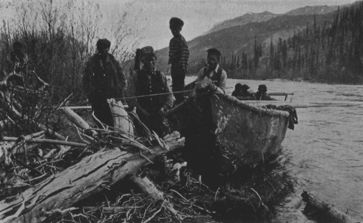
It is midnight in the midst of a howling wind-storm when we come abreast of Fort Norman where Bear River, the outlet of Great Bear Lake, makes into the Mackenzie. It is not an easy thing to handle the big steamer in a swift current and in the teeth of a storm like this, and we have been in more comfortable places at midnight. However, after running with the current, backing water, and clever finesse, we come safely to anchor against the shore opposite the Fort, under the lee of Bear Rock. This is a fourteen-hundred foot peak which starts up from the angle formed by the junction of the Bear River with the Mackenzie.
The water of Bear River is clear and its current swift through the whole of its hundred-mile course. Great Bear Lake, known chiefly to the outside world from the fact that Sir John Franklin established winter-quarters here at Fort Confidence, is an immense sheet of water, probably 11,500 square miles in extent, and bigger even than Great Slave Lake. Five arms meeting in a common centre give the lake an unusual shape, the longest distance from shore to shore being one hundred and fifty miles. The south and west banks are well wooded, and we are surprised to learn that the lake remains open at the outlet until very late in the autumn and sometimes throughout the whole winter.
March sees the greatest depth of snow at Great Bear Lake, probably three feet. In mid-April the thaws begin, and by May-day arrive the earlier water-fowl. By the end of May the herbaceous plants begin to leaf, frogs are heard, and there is bright light at midnight. The end of July brings blueberries, and at this time stars are visible at midnight. September is ushered in by flurries of snow, and by the tenth of October the last of the wild-fowl depart; but it is often Christmas Day before the centre of the lake freezes over.
When we awake it is Sunday, July 12th, Orangeman's Day, with no one going round with a chip on his shoulder, and nobody to whistle "Boyne Water." The wind falling, the steamer is turned and we bear away across the river to Fort Norman, leaving the shelter of Bear Rock, the "Nest of the Wind" of the Indian. Tradition and superstition hang round this great butte, with its heart of coloured gypsum several hundred feet in thickness, and on its face we plainly see the three beaver-skins that the Great Spirit, "in the beginning," spread out there to dry. We find Fort Norman a beautiful place in the sunshine of this Sunday morning, the souls of its scanty populace well looked after by Roman and Protestant missionary. Bishop Breynat is expected on the mission boat coming up the river, and all is excitement among the sheep belonging to his particular flock. The parson of the other fold is in his library, and, visiting him, we duly admire his neat garden of potatoes and peas, beets and turnips. The reverend gentleman owns up to finding Norman lonely in winter and recalls with appreciation his last charge in the outports of Newfoundland, where the tedium was relieved by tennis and pink-teas.
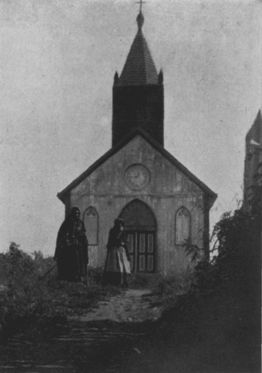
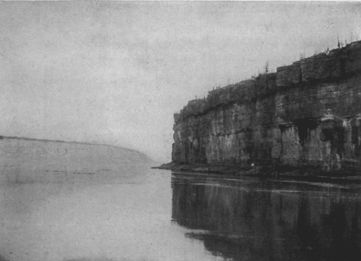
Seldom have we seen a more beautiful vista than the up-climbing path leading from the shore to the Roman chapel at the head of the hill. It is bordered by flaming fireweed and lined with the eager faces of children dressed in their Sunday best, ready for morning mass and awaiting the blessing of their Bishop. Wherever the willow-herb flourishes there a Guadet is serving The Company. One was in charge at lonely Wrigley, and we find his brother here.
Leaving Norman before church-time, we travel on, the glory of the peerless day reflected in the face of every one on board. We float between two spurs of the Rockies, and about eight in the evening pass Roche Carcajou, looking in vain for the wolverine the name calls for. The Indians would seem to be strangely inconsistent in this connection. If there is one animal they fear it is the carcajou, and with him they have an old, old pact: the Indian on his side promises never to shoot a wolverine, and that cunning thief agrees to leave unmolested the cache of the Red man. While this bargain still holds, since the day when ammunition first came into the country no Indian has passed this rocky replica of the carcajou without firing a shot at the face of the cliff.
It is an hour before midnight when we reach one of the two greatest spectaculars of our whole six months' journeying,—the Ramparts. The great river which has been running at a width of several miles, here narrows to five hundred yards, and for a distance of five or six miles forces its flow between perpendicular walls of limestone three hundred feet high. Between the cliffs, scarped by Nature into turrets, towers, and castellated summits, the great Mackenzie, "turned on edge," flows, maintaining a steady rate of four or five miles an hour. The depth of the water equals the visible height of the palisaded walls. In spring, the ice jams the stupendous current. The dammed-up water once lifted a skiff bodily, leaving it, when the flood subsided, a derelict on the cliffs above.
As we pass in silence we can but look and feel. One day a Canadian artist will travel north and paint the Ramparts, some poet, gifted with the inevitable word, here write the Canadian Epic. Awed and uplifted, our one wish is to be alone; the vision that is ours for one hour of this Arctic night repays the whole summer's travel. The setting of the picture is that ineffable light, clear yet mellow, which without dawn and without twilight rises from flowing river to starless heavens, and envelopes the earth as with a garment,—the light that never was on sea or land. We could not have chosen a more impressive hour in which to pass the portal into the Arctic World.
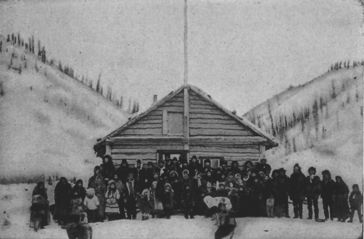
A hundred yards from the entrance to the Ramparts, a group of Indians has found foothold at the base of the escarpment. They have been waiting for three days to signal our arrival, and as they catch sight of the big steamer they cry out their greeting and fire a volley from their old-fashioned rifles. The sound reverberates from rock to rock, ricochets, and is carried on to waiting Indians on the other side lower down. They repeat the salute, and others take it up. Signals are flashed from each little camp, the lights being repeated in the dancing river; and so it is by salvos of musketry and answering watch-fires that, at midnight in broad daylight, we reach Fort Good Hope under the Arctic Circle.
The Arctic Circle! When we used to sit on uneasy school-benches and say our "joggafy" lesson, what did that term spell for us? Icebergs, polar bears, and the snows of eternal winter. Nine-tenths of the people in America to-day share the same idea, and so far as they think of the Arctic Circle at all, think of it as a forbidding place, a frozen silence where human beings seldom penetrate. What did we find there? Approaching the shore, we stand in the bow with the pilot and his daughter, whose name suggests the Stone Age,—Mrs. Pierre la Hache. Tenny wears his "other clothes" and a resplendent l'Assumption belt, for this is his home. "It looks like a swan on the water," he says, when the first white houses come into view. "You like it, do you not?" "Like it? Good Hope is God's Country!" There is no place like home, even when it is the Arctic Circle!
The populace look down upon us from the high bank, every wiggle of the dogs' tails indicating the general impatience at the time it takes the big boat to make a landing. Down the steps comes a stately figure, Mr. C.P. Gaudet, the head and brains of Good Hope. Of the two thousand servants of the Hudson's Bay Company, this is the man who has the greatest number of years of active service to his credit. Mr. Gaudet has continuously served The Company for fifty-seven years, and his ambition is to put in three years more. The Company gives its employés a pension after thirty years' service, and this veteran of Good Hope surely deserves two pensions. The steps are almost precipitous, but the old gentleman insists upon coming down to present in person his report to his superior officer. Then the two climb up the bank together, the younger man giving a strong arm to the older. We follow, and half-way up the two figures stop, ostensibly for Mr. Gaudet to point out to Mr. Brabant the view up river. We suspect the halt is to allow the Fort Hope Factor to get breath, for the sky-line stairway is hard on asthma.
Reaching the top, we find the air heavy with the perfume of wild roses, and we can scarcely make our way through the sea of welcoming Indians. Old people grasp our hands as if we were life-time friends just back from a far journey. Young men greet us as long-lost chums, the women call to the children, and there seems to be a reception committee to rout out the old beldames, little children, and the bed-ridden: it is hand-shaking gone mad. We shake hands with every soul on the voting-list of Good Hope, to say nothing of minors, suffragettes, and the unfranchised proletariat, before at last we are rescued by smiling Miss Gaudet and dragged in to one of the sweetest homes in all the wide world.
We meet Mrs. Gaudet, a dear old lady with a black cap, the pinkest of pink cheeks, and the kind of smile that brings a choky feeling into your throat and makes you think of your mother. She gives us home-made wine and galettes, and as we smell the mignonette flowering in the window-ledge and look around the walls of the "homey" room we wonder if this really can be the "Arctic Circle, 23-1/2° from the North Pole, which marks the distance that the sun's rays," etc., etc., as the little geographies so blithely used to state. On the walls are the Sunday School tickets that the young Gaudets, now grey-haired men and women, earned by reciting the Catechism when they were little boys and girls—the same old tickets that flourish in the latitudes below. Here a pink Prodigal feeds sky-blue swine in a saffron landscape, and off there a little old lady in a basque leads a boy in gaiters and a bell-crowned hat down a shiny road. They seem to be going on a picnic, and the legend runs,—"Hagar and Ishmael her son into the desert led, with water in a bottle and a little loaf of bread."
Thirty years ago when Miss Gaudet was a little girl she got her first Scripture lesson from an R.C. Sister, the story of our old Mother in the first garden. One Sunday was review day, and this question arose: "And how did God punish Adam and Eve for their disobedience?" Quick came the girlie's reply, "They had to leave The Company's service!"
Mrs. Gaudet thinks people rush very much nowadays. "We get a mail every year without fail, and sometimes there is a second mail." This is to her the height of modernism. That second mail is an interesting one. A letter written in Montreal in winter and addressed to Fort Good Hope crosses Canada by the C.P.R. to Vancouver, by coastwise steamer it travels north and reaches the Yukon. Then some plucky constable of the Mounted Police makes a winter patrol and takes the precious mail-bags by dog-sled across an unmarked map to Fort Macpherson on Peel River. Thence the Montreal-written letter is carried by Indian runner south to Good Hope on the Arctic Circle.
We love to talk with Mrs. Gaudet, she is so dear. Mother-love and devotion to The Company,—these are the two key-notes of her character. Looking back through the years, she tells of a visit she made "outside" to Montreal when she was a young mother—it was just fifty years ago,—measles attacked her three babies and within a week they all died, "Le bon Dieu prit les tous, mes trois jolis enfants!" Some years after this at Macpherson an Eskimo woman stole another of her babies, snatching it from a swing in the fort yard, and not yielding it up until it was torn from her by force.
We wander out into the midnight daylight where with dogs and Indians the whole settlement is still a stirred-up ant-hill. Splendid vegetable gardens are in evidence here,—potatoes, turnips, carrots, cabbages. Should we reach the North Pole itself we would expect there a Hudson's Bay fort, its Old World courtesy and its potato-patch. As we pass the store of the "free-trader," he says, "Yes, Mrs. Gaudet is a sweet woman, kindly, and dear, but she doesn't approve of me. She makes a point of not seeing me as she passes here twice a day on her way to church."
"Why?" we ask, much surprised.
"Oh," with a laugh, "you see, I sort of trade in opposition to the H.B. Company, and a fellow who would do this comes mighty near having horns and a tail!"
We step into the "Little Church of the Open Door," and sit down and think. The quaint altar and pictures, the hand-carved chairs, and the mural decorations all point to the patient work of priests. We see across the lane the home of the R.C. clergy, looking like a transplanted Swiss chalet and carrying on each door-lintel the name of a saint,—St. Matthew, St. Bartholomew, St. John. From the shrubbery outside wafts in the sweet old-world perfume of wild-roses. Our thoughts will often drift back to this restful little sanctuary, "Our Lady of Good Hope," the mission founded here in the year 1859 by M. Henri Grollier, R.C. missionary priest of Montpelier.
—A Pagan Hymn.
"The Eskimo is a short, squat, dirty man who lives on blubber," said text-books we had been weaned on, and this was the man we looked for. We didn't find him.
It was at Arctic Red River, one hundred and ninety miles of river-travel since we cut the Polar Circle, that we came upon our first Eskimo, the true class-conscious Socialist of Karl Marx, the one man without a master on the American continent. A little band of Kogmollycs they were, men, women, and kiddies, who had come in to trade silver-fox skins for tobacco and tea at the Post of the Hudson's Bay Company.
On the rocks they sat, waiting for the new steamer to make her landing, and much excited were they over the iron bowels of this puffing kayak of the white men. An Eskimo generally lets you know what he thinks, and this is a basic difference between him and the Indian. An Indian is always trying to impress you with his importance; he thinks about his dignity all day and dreams of it at night. The Mackenzie River Eskimo is a man who commands your respect the moment you look at him, and yet he is withal the frankest of mortals, affable, joyous, fairly effervescing with good-humour. His attitude toward the world is that of a little half-Swiss, half-Chinese baby friend of mine who, in an ecstacy of good-will when she saw her first Christmas-tree, clutched me tightly round the neck with, "Everybody are my friend."
One of the Kogmollycs, rejoicing in the name of Wilfrid Laurier, strode on deck with the swing of a cavalryman and signified his willingness to trade. Loading down my hunting-coat with pictures, pipes, tobacco, looking-glasses, needles, files, knives, I climbed over the cliffs with him to his hut. Down on the floor we sat. Wilfrid put his treasures between his knees before him, I sat opposite, and the barter began. "What for this fellow, huh?" and he held up a piece of carved ivory, a little triangular mincing-knife, a fur mat that his wife had made, or the skin of a baby-seal. The first thing he asked for was scented soap, the ring that I was wearing, and my porcupine-quill hat-band which looked good to him; every exchange was accompanied with smiles, each bargain sealed with a handshake.
Wilfrid Laurier is doing his part toward bridging the old chasm of animosity existing between the Eskimo and their next-door neighbours, the Loucheux Indians to the South. Wilfrid, in taking to himself a Loucheux woman to wife, has done what the Seventh Henry of England did when he married Elizabeth of York. Wilfrid's son and heir holds the same place in Northern history as did Henry VIII, who united in himself the claims of the rival Roses of York and Lancaster.
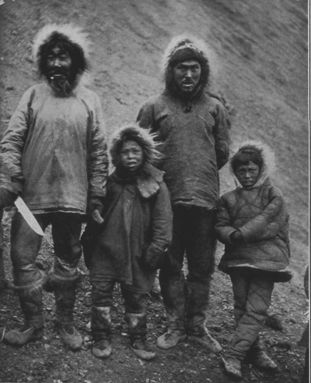
Mrs. Ila-la-Rocko asked us into her hut, where we reclined on fur mats while the whole family, wreathed in smiles, tumbled over themselves to do us honour. One by one they danced for us, stopping to tell their names and to ask ours. "Major Jabussy," "Missa Blown," they got the names all right but applied them promiscuously, and then went into roars of laughter at their blunder. The merriment was infectious. Let no one waste further sympathy over the poor benighted Eskimo of this Canadian North. The Mackenzie River Eskimo is, with perhaps the one exception of an Arab I fraternized with in Chicago at the World's Fair, the most splendid specimen of physical manhood I have ever seen; in physique he stood out in splendid contrast to the Europeans and Americans who were investigating him and his. Arrow-straight and six feet tall, mark him as he swings along the strand. His is the carriage and bearing of the high-bred Tartar. This man has "arrived"; he has an air of assuredness that in the drawing-rooms "Outside" you seldom see.
The Eskimo of the Arctic foreshore are of two tribes: the Kogmollycs to the east of the Mackenzie mouth, the Nunatalmutes, Dwellers in the Hills, or Deermen, originally from the interior to the West, but now for the great part making their home at Herschel Island, eighty miles from the Mackenzie delta, attracted there by the opportunity of working for the American whalers.
One of the striking figures of the North is Oo-vai-oo-ak, headman of the Kogmollycs, living in dignified happiness with his children and his two wives. This second wife was the cause of much comment among us. How did she happen? It was this way. Mr. Oo-vai-oo-ak married Mrs. Oo-vai-oo-ak the Elder when they were both young. Children were born to them, the big seal was plenty, succulent beluga-steaks graced the board, and the years followed one another as smoothly as glacial drift or the strip of walrus-blubber that the last baby drops down its red gullet as a plummet sinks in a well.
One day after a big hunt, as Mrs. Oo-vai-oo-ak placed before her lord the matutinal mess of whale-skin boiled to that particular rubber-boot consistency which was his taste, she said, "I'm not as young as I was, you entertain much, the household cares are heavy, I'd like you to get another wife to help me with the work." Chief Oo-vai-oo-ak chewed upon the whale-skin and the suggestion of his spouse. Out in his kayak, dodging the icebergs, he turned it over in his mind for half a day; and as the outcome of his cogitations Mrs. Oo-vai-oo-ak the Younger, a rollicking and comely maiden, joined the family circle.
How does it work out? For ten days I sat round their hospitable fire trying hard for the viewpoint of each member of this Farthest North family of fellow-Canadians. I have lived under many roof-trees, but never have I seen a more harmonious family, nor a ménage of nicer adjustment. Mrs. Oo-vai-oo-ak the Elder, full of the mellow juice of life, waggish and keen, "quick at the uptak'," as the Scotch say, presides over her household with dignity, never for a moment relaxing her hold on the situation. Chief Oo-vai-oo-ak wisely leaves the interior economy of the household in the hands of the women. He is the quiet, dignified gentleman with an easy manner that courtiers and plenipotentiaries extraordinary might envy. His six feet two inches of height, magnificent physique and superb carriage would mark him out as a man of distinction at any race-course, polo-meet, or political reception where men of the world forgather.
Observing the small, strong, exquisitely-formed hands and feet of the Oo-vai-oo-aks, the almost-white complexions dashed with ruddy scarlet, the easy grace that even the children have, and, above all, the simple dignity which compels respect, one recognizes here an ancestry harking back to Old World culture and distinction.
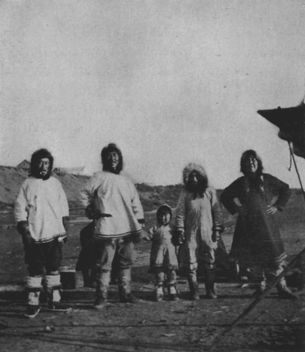
How does the young wife fit in? No suffragette need break a lance for her, demanding a ballot, dower-rights, and the rest of it. She is happy and busy. All day long she sings and laughs as she prepares the family fish and feast of fat things, she pays deference to her co-wife, romps with the children, and expands like an anemone under the ardent smile of her lord. When the grave question was under discussion regarding the exchange of her pendant bead-and-shell ear-rings for a pair we had brought from the shops of the white men, the two spouses discussed the matter in all its phases earnestly together, as chummy as two school-girls.
The Oo-vai-oo-ak family was a puzzle to the on-lookers, who sought in vain for some one of the three contracting parties to pity. They were all so abundantly happy, each in his or her own way, that Walking Delegate could find no crack here for the opening wedge of discord. If no one is to be pitied, then surely for this new departure in matrimony there must be some one for the virtuous to blame. But why?
Kipling declares, "There's never a law of God or man runs north of fifty-three." The Eskimo has worked out his life-problem independent quite from the so-called civilisations evolved to the south of him. He is his own man.
In the rest of America and in Europe we have formulated a rule of "One man, One wife," allowing an elasticity of the rule in Chicago and elsewhere, so that it may read, "One man, one wife at a time." Are we so sure of results that we are in a position to force our rule upon the Eskimo?
Following the animals that God has ordained shall be their daily bread, in little communal bands they thread the silent places of the North. On the Arctic foreshore we have a people different to all other peoples; here is no inherited wealth, no accumulation of property. A man's skill as a hunter determines his ability to support others, the pursuit of seal is the pursuit of happiness; life and liberty belong to all. In many of the little wandering groups or septs or clans the women outnumber the men. A mighty hunter is able to kill seals at will and provide blubber enough for two or even three wives. The Canadian Eskimo is the direct antithesis of the French-Canadian in the matter of large families; seldom are more than three children born to one mother. Now, the crux of the matter is this: is it better for one man to marry and provide for one wife and three children, leaving on the community a floating sisterhood of unattached females, or is it more sane and generous for the Northland Nimrod to marry as many wives as he can comfortably support, and raise up olive-branches to save from extermination the men of the Kogmollycs, the honourable people of the Nunatalmutes?
The fact that the women prefer a vulgar-fraction of a man, an Eskimo equity in connubial bliss, to spearing walrus on their own account is a significant factor in the problem. And before we piously condemn either the lord or the lady in the case, it is well that we adjust our judgment to the latitude of 68° North and take cognizance of the fact that no seductive "Want Columns" in the daily press here offer a niche whereby unappropriated spinsters may become self-supporting wage-earners as chaste typewriters, school-teachers, Marcel-wavers, or manicurists. To keep the vital spark aglow you must kill walrus and seal in your own proper person or by proxy, for no other talent of body or grace of mind is convertible into that sustaining meat and heating blubber which all must have in order to live.
Economically, then, a woman must herself hunt or have a man or part of a man to hunt for her. Ethically, it works out beautifully, for each partner to the hymeneal bargain is fat and full of content, happiness fairly oozing out of every oily pore. And is not happiness the goal of human endeavour, whether a man seeks it amid the electric lights, subtle perfumes, and dreamy waltz-music of a New York ballroom, or finds it seated with his community wives on a hummock of ice under the Aurora?
I wouldn't like to picture our cousin the Eskimo woman as being always content with a circulating decimal of a husband instead of a whole unit, nor would such presentment be just. The shield, like most shields, has a reverse. Last winter, at the Mackenzie Delta, one Eskimo bride of seventeen took her fourth consecutive husband. She is dark but comely, but truth will not carry the analogy further. I have yet to see the Eskimo who is like a bunch of camphire in the vineyards of Engedi. Three winters ago, at Baillie Island, the three-times-widowed one had both her feet amputated as the result of exposure to cold.
In the latest wedding, the one that came under our notice (we hesitate to call it the last), the much-sought one was given away by her brother-in-law Su-pi-di-do, or Sour Potatoes. The wedding breakfast consisted of seal-meat, frozen rotten fish, and muktuk (whale-meat). The ceremony took place at the igloo of Su-pi-di-do, with fifty guests present, and as the size of Su-pi-di-do's bungalow is ten by twelve, one needs only suggest what the old hymn speaks of as "odours of Edom and offerings Divine."
The festivities began to warm up about midnight. An old chap, with a retrospective look in his left eye peering back through eighty midnight suns and noonday nights, set the ball a-rolling by raising his hands above his head and hopping about in the middle-distance. His wife, a gay old girl of twice his age, lilted a song, and the guests joined in the chorus; line by line in a minor key the wedding song was sung, the air being confined to three notes. After each line came the chorus twice repeated,
"Ai, yea, yae! Yae, yae, ya—yae!"Dancing was kept up to an early hour. Overcome by the air, respiratory and vocal, we made our adieus to the crippled but captivating bride, pushing our way through the ghostly dogs and sleeping babies at two a.m.
By natural gifts and temperament the Eskimo is probably the most admirable, certainly the most interesting, and by circumstances the most misunderstood and misrepresented of all the native races of America. The Eskimo of any one group would seem within historic times to have known but little of other bands than his own. Yet sometimes they met. There is an island, called Barter Island, in the Arctic at the dividing line between Alaska and the Canadian Yukon Territory, one hundred and fifty miles west of Herschel. For years this was a trading rendezvous for four peoples: the Kogmollycs or Mackenzie Delta Eskimo, the Alaska Eskimo, and the Indians and Nunatalmute Eskimo whose habitat lay due south of Barter Island. To this point the Cape Barrow Eskimo in the old days brought their most precious medium of exchange,—a peculiar blue jade, one bead of which was worth six or seven fox-skins. And thereby hangs a tale. Mineralogists assure us there is no true jade in North America, so the blue labret ornamenting the lip of Roxi must have come as Roxi's ancestors came, by a long chain of exchanges from Siberia or from China.
This trading tryst at Barter Island was made an occasion of joy and merriment. In imagination we see the chiefs in their kayaks, the old men, the women, and the babies in the slower and more commodious oomiaks, making their way across the lonely ocean to exchange gifts and courtesies with their half-known kin. The barter consummated, these Northland voyageurs had their yearly dance and sing-song and orgy of delight. No shooting the chutes, no pop-corn, no pink lemonade, no red-hots nor "fr-resh Virginia peanuts, l-large sacks and well-f-filled and f-five a bag!", but the Arctic concomitants of these,—boiled beluga-skin, luscious strips of walrus-blubber, and frozen fish that smells to high heaven. Joy is the same, gastronomic and aesthetic, in the latitude of Boston and the latitude of Barter Island. It is only the counters that are different.
Meagre are the bits of knowledge of the Eskimo that have floated down into our ken through the ages; on the icy edge of things this unique and fascinating people worked out their drama, the world unknowing by the world forgot. The white men who reached the Eskimo land from the south were discoverers following to the sea the three great rivers that disembogue into the Polar Sea: the Mackenzie, Coppermine, Back or Great Fish. The first of these explorers was Samuel Hearne who, in 1771, followed the Coppermine to the Frozen Ocean. For the northern natives their first contact with white explorers was a disastrous one, for at Bloody Falls on the Coppermine Hearne's Indians set upon the only band of Eskimo they saw and almost exterminated them. Sir John Franklin in 1820 was more happy. He says, "The Eskimo danced and tossed their hands in the air to signify their desire for peace; they exhibited no hostile intention; our men saluted them by taking off their hats and making bows." Back, who explored the Back or Great Fish River in 1834, has this tribute of respect and appreciation. He says, "I called out 'Tima' (Peace), and putting their hands on their breasts they also called out 'Tima.' I adopted the John Bull fashion of shaking them each heartily by the hand; patting their breasts, I conveyed to them that the white man and the Eskimo were very good friends. They were good natured, and they understood the rights of property, for one of them having picked up a small piece of pemmican repeatedly asked my permission before he would eat it."
Through all these years, if we except the noble devotion of the Moravian missionaries on the northeast of Canada and the splendid Christianity of such men as Bishop Bompas who sought them from the south, no one visited the Eskimo from the outside with the purpose of doing him good, but rather with the idea of exploiting him. Yet, from the days of Sir John Franklin and Sir Alexander Mackenzie to the recent voyage of Amundsen, the spontaneous tribute of every man who has met them, talked with them, and received their hospitality is the same. The Eskimo is generous, and his word is worth its full face value. What we have done for the Eskimo is a minus quantity; what he has done for us is to point a splendid moral of integrity, manliness, and intrepid courage.
Indians beg and boast, the Eskimo does neither. With no formulated religion or set creed, he has a code of ethics which forbids him to turn the necessity of another to his own advantage. Amundsen's farewell to his Eskimo friends sets the thoughtful of us thinking, "Goodbye, my dear, dear friends. My best wish for you is that civilisation may never reach you."
The trite saying is that the Loucheux Indians forced the Eskimo north, "keeping them with patient faces turned toward the Pole." But the Eskimo has a better country than the Loucheux has, for it is less rigorous and it produces more food stuffs. The Loucheux at Fort Macpherson knows what it is to experience a temperature of 60 below Fahr., while at the coast it doesn't drop below 55.
The Eskimo has two fields in which to hunt food,—the land and the sea, with fish the great staple; and both fresh and salt-water fish are his, that in the mouths of the great rivers being better than what the Loucheux gets higher up. If the Eskimo wrote copy-book lines, the most insistent one would be, "Lose your matches, throw away your guns, but hang on to your fish-net."
Through the years there was bad blood and mutual distrust between Eskimo and Loucheux. The last pitched battle occurred in the 60's, when of the contestants only two Loucheux escaped and not one Eskimo was killed. The Hudson's Bay Company officer at the close of the fight called together the relatives of the slain Loucheux, upon whom rested the duty of revenge, and out of The Company's stores paid in trade-goods the blood-price of the slain. Since then both peoples have traded at Forts Macpherson and Arctic Red River, maintaining a sort of armed peace, but with no deeds of violence. The Loucheux Indian, his wives, his babies, and his slab-sided dogs suffer from starvation almost every winter. In the whole history of the Eskimo there is not an authenticated story of one of this people having starved to death. Once more we protest against misapplied sympathy. However it may have been in the past, the Eskimo stays on the coast to-day because it is to him "God's country" and not because any hostile Loucheux sends him there.
For the past twenty years the men on the American ships have employed the Eskimo to aid them in the whaling industry, picking up different bands all the way from Bering Sea eastward as they sail in from the Pacific, and depositing each group at their individual beaches as the ships take out their rich spoils of baleen and oil at the close of the season. The Eskimo has proven a valued aid to this industry; how has the intrusion of the whites into his ancestral sea-domain affected the Eskimo?
Within two decades the European population of this Mackenzie River delta region has been cut down from two thousand to probably one-fourth of that number. The causes? White men's diseases: scarlet fever, consumption, measles, syphilis must account for most of the startling decrease. Scarletina has killed many, consumption some, though consumption is not nearly so fatal with the Eskimo as with the Indian, measles perhaps more than all. Measles among the Eskimo is more fatal than the Bubonic plague among Europeans.
What other changes is the yearly presence of American whalers among them making in Eskimo evolution? Who shall say? It is so easy to be dogmatic, so hard to be just. This intrusion of the whites has changed the whole horizon here; we can scarcely call it the coming of civilisation, but call it rather the coming of commerce. The whalers have taught palates once satisfied with rotten fish and blubber to want coffee and tea and molasses, yeast-bread, whiskey, and canned peaches. To the credit side of the account, we must fairly state that the ships have brought the Eskimo whale-boats, good guns, and ammunition.
The Eskimo population of the Mackenzie delta is becoming mixed by marriages between the different tribes brought together to work on the whaling-ships. Each of these intertribal alliances brings about its changed culture characteristics. But as a more far-reaching result of the coming of the whalers there is springing up on the edge of the Arctic a unique colony of half-caste Eskimo children, having Eskimo mothers, and, for "floating fathers," marking their escutcheon with every nationality under the sun,—American, Swedish, Danish, Norwegian, Italian, Portuguese, Lascar. This state of things startles one, as all miscegenation does, and this particular European-Eskimo alliance is different from all others. In the hinterland of the Arctic, when a Frenchman or a Scot took a dusky bride from the tepee of Cree or Chipewyan it was with an idea of making the marriage a permanent one. There is no intent on the part of the whalers to take their Eskimo "wives" outside with them, nor does the wife so-called look for this. One or two cases are on record where the half-breed child has been taken "outside" by his father to school, and through the years perhaps six or eight half-Eskimo kiddies have percolated the interior waterways south to some mission-school, Anglican or Roman. As a rule, the marriage-contract is "good for this season only," and the wife and children bid their quondam husband and father farewell, smiling at him with neither animosity nor reproach as the boats go out.
What is then the ice-widow's condition? Is she an outcast among her people? No, you must remember that neither the matrimonial standard of Pall-Mall nor Washington, D.C, obtains here. The trade-ticker of the erstwhile wife of the whaler ticks skyward in the hymeneal Lloyd's; she is much sought of her own people. Has she not gained in both kudos and capital? The knowledge which she must have acquired from the white man of whalers' ways of trading is supposed to be of monetary use to her second lord. Moreover, the tent, utensils, and cooking-kit which she shared with her spouse from the ships makes a substantial dower when she again essays Hymen's lottery.
Eskimo women are neither petulant nor morose. With the men they share that calm-bearing of distinction, combined with the spontaneity of a child which makes such a rare and winning mixture. In moving among the half-caste Eskimo children up here on the edge of things, fairness forces us to admit that neither in stature nor physique do they fall below the standard of the thorough-bred natives. About the morals, the ethical, or mental standards, we venture no comparison, for heredity plays such strange tricks. The whole condition is formative, for the blending of races has been going on scarcely long enough for one to see and tabulate results. The influence of the mother will be longer applied and its results more lasting than that of the evanescent father, and in this is their hope. For years we have been repeating the trite, "The sins of the father are visited upon the children to the third and fourth generation;" it remained for Charles Dickens to ask, in his own inimitable way, if the virtues of the mothers do not occasionally descend in direct line.
We respect the Eskimo for many things: for his physical courage as he approaches the bear in single combat, for his uncomplaining endurance of hardships, for his unceasing industry, the cleverness of his handicraft, his unsullied integrity, sunny good-humour, and simple dignity. But, most of all, he claims my respect for the way he brings up his children. "A babe in the house is a well-spring of pleasure," is a pretty theory, but Charles Lamb reminds us that each child must stand on his own footing as an individual, and be liked or disliked accordingly. In the igloo and the tupik the child has his own accorded place and moves in and out of the home and about his occupations with that hard-to-describe air of assuredness that so distinguishes his father and mother.
The Eskimo child accepts himself as the equal of any created thing, but there is nothing blatant about him, nor is his independence obtrusive. He is born hardy, and lives hardy, trudging along on the march in his place beside the grown-ups. Each Eskimo man and woman is an independent entity, free to go where he pleases. There is no law, no tribunal, no power to limit or command him, but instinctively he observes the rule of doing as he would be done by, and he teaches his child the same Golden Rule. A boy or girl is never considered an encumbrance and is readily even eagerly adopted if his own parents die. The Eskimo child is ushered into the earthly arena with no flourish of trumpets, for his coming is but an incident of the journey if Fate has decreed that he should be born when the family is on the march. The hour's stop for the mid-day meal often sees a new little valiant soldier added to the ranks of the clan and starting his traverse of Arctic trails. If the baby is born while the family is in camp, mother and babe separate themselves from the rest of the family for a month, no one being allowed to look at, much less fuss over, the little stranger.
Naming an Eskimo baby is fraught with significance. If the last grown man who died in the band was one revered, one whose footsteps are worthy to be followed, the name of the departed clansman is given to the newborn child. The belief is that the spirit of the dead man hovers around the community and immediately upon the birth of the child takes possession, a re-incarnation in the baby-body. Withdrawing itself in twelve months' time, the spirit of the ghostly god-father lingers by to influence the character and destiny of the growing child.
We trace a well-known nursery rhyme to the igloo of the Eskimo. The summer-born baby dispenses with clothing for the first six months of its earthly pilgrimage, cuddling its little bare body close to its mother's back under her artikki, or upper garment, which has been made voluminous to accommodate him. But the husky babe who comes when King Wenceslaus looks out on the Feast of Stephen has his limbs popped into a bag of feathers before his mother takes him pick-a-back, or else he is wrapped in a robe of rabbit-skin. So we see that it was an Eskimo mother who first crooned in love and literalness,
"By-o, Baby Bunting,Mother-love is a platform upon which even ancestral enemies can meet. While I sat cross-legged (and, like cotton, absorbent) last summer enjoying the hospitality of the Oo-vai-oo-aks, to us entered a beautiful-faced Loucheux Indian mother with a pair of twins pendant,—rollicking chaps. The younger Mrs. Oo-vai-oo-ak dropped on the floor her lord's boot which she had been dutifully biting into shape and jumped up to greet her visitor. There was no mistaking that smile of hospitality. Snatching from the visitor one of her baby boys, the young hostess kissed and cried out to it with an abandon of maternal joy, the culminating point of which was feeding it from her own breast. Thus, in one instance at least, has the ancient feud of Loucheux and Eskimo died.
A baby Eskimo is nursed until it is two years old or older, and learns to smoke and to walk about the same time. The family pipe is laid upon the couch, and papa, mamma, and the children take a solacing whiff as the spirit moves them. These pipes are identical with those used by the Chinese, and hold but half a thimbleful of tobacco, the smoke being inhaled and swallowed with dreamy joy.
The hardihood of Eskimo children is scarcely believable. It is not unusual for children of six years to trudge uncomplainingly for twenty-five miles by the side of their elders; and we came to know a little seven-year old chap who was quite a duck-hunter, and who went out every day alone and seldom came back without at least two brace. At eleven years, with his watertight boots, spear in hand, and coil of line on his back, he takes up the Innuit man's burden, and does it with an air both determined and debonair. If you ask a mother if she does not think this a somewhat tender age for her boy to essay to keep up with the men on the hunt, she merely smiles as she sews her waterproof seam, and says, "The First Innuits [Eskimo] did so."
These fur-clad philosophers are perhaps seen at their best in their play, for there is always harmony in the crystal nursery of the North, as these little people have no bad names nor threatening terms in their vocabulary Yet the play is often very rough, and your Eskimo lad is no molly-coddle. The writer watched five small boys playing football with a walrus-bladder among the roses on the edge of the Arctic. The game was neither Rugby nor "Soccer," but there seemed to be a good deal of tackling in it. Four of them got the fifth one, who hugged the ball, down, and were sitting on him and digging their skin boots into the soft parts of his anatomy. "You're angry, now," said a Major of the Royal Northwest Mounted Police who was looking on. "No, sir," said the under dog, with difficulty protruding his head, "I never get mad when I play."
The boys have a sort of duel which they have copied from their elders. It is customary for the grown men of the tribe to settle accumulated difficulties by standing a selected number of contestants, say four on each side, facing each other. Each man is allowed to strike his adversary a number of blows, the recipient of the buffeting being bound by the laws of the game to stand quiescent and take what is coming to him. Then striker and strikee change places and reverse the courtesy. All sorts of feelings come into your throat to choke you, as you watch a row of "heathen" Eskimo lads carry out an ungentle joust of this kind, for the blows are no child's play. Think of what this self-inflicted discipline means in the way of character-building, then think of the ignoble tactics that obtain on some of our race-courses, baseball diamonds, and "sport" carnivals, and then do some more thinking. A line of Tennyson came persistently to my mind last summer as I walked in and out among the camps of the Eskimo,—"Self-reverence, self-knowledge, self-control."
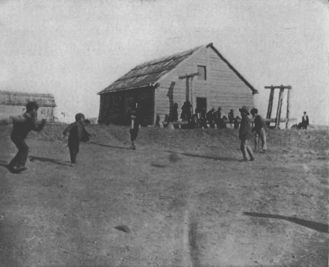
What of the little girls? They have dolls made of reindeer skins, rude imitations of their elders. And they play "house," and "ladies," and "visiting," just as their cousins do on every shore of the Seven Seas; but no little Eskimo girl has ever yet had the pleasure of dressing up in her mother's long dresses.
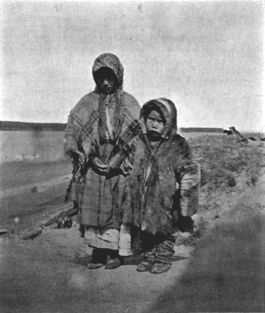
When the ptarmigan gets dark in feather and the sun begins to return in spring after the long six months' night, it is the pleased prerogative of the children to blow out the lamp in the snow-house. All the time that the sun is travelling south, clever combinations of cat's-cradle are played by the mothers and the children to entangle the sun in the meshes and so prevent its being entirely lost by continuing south and south and forgetting entirely to turn back to the land of the anxiously-waiting Eskimo. The boys, by playing a cup-and-ball game, help, too, to hasten its return. When the sun forgets you for six months, you become fearful lest you have lost his loving care forever. The spring is an anxious time in more ways than one, for if there is any suffering from hunger it is felt now, when the winter supplies are finished and the new hunts not yet begun. "I'll eat my hat" is an empty threat in the south, but many an Eskimo kiddie has satisfied the gnawing pains of spring hunger by chewing his little skin boots.
At the Mackenzie delta last year, Roxi the Eskimo came in and told me this sad story. Six weeks before, a party of Eskimo had left Baillie Island with dogs for Kopuk. On their way they found a dead whale and cooked and ate of it; the next day they found another and again indulged. After travelling twenty-five miles, the whole party was taken violently ill, and six adults and two children died, leaving only one little girl alive. There for three days and four nights she remained, alone in the camp of the dead, until by the merest chance a young Eskimo, attending his line of traps from Toker Point, stumbled into the silent camp.
One can faintly glimpse at, but must utterly fail to grasp, what that little girlie suffered mentally. We picture her sleeping, sobbing, waiting in that snow-hut in the silences, surrounded by the still bodies of every one she loved on earth. The sequel of the story is as sad as its first chapter. The band of Eskimo to which the rescuer belonged went in their turn and ate of this stranded whale, with the result that A-von-tul and Ita-chi-uk, two youths of twenty or twenty-one, died, too, and with them a little four-year-old girl. The drift whale must have been poisoned either by ptomaine or by the remnants of the highly compressed tonite, the explosive used by the whale-hunters.
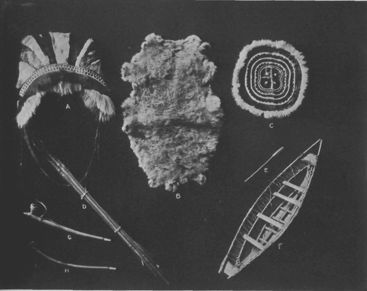
A—Eskimo woman's head-dress of reindeer skin.
B—Skin of the baby seal, its shimmering whiteness used by the missionaries to typify the Lamb of God, the word "Lamb" having no meaning to an Eskimo.
C—Ornamental skin mat, the work of an Eskimo woman.
D—Quiver of arrows used by Eskimo boys.
E—Model of Eskimo paddle.
F—Skin model of the Oomiak or Eskimo woman's boat.
G and H—Eskimo pipes of true Oriental type, the bowl holding only half a thimbleful of tobacco.
As we visit in friendly wise the Eskimo and their children, a feeling of loving admiration and appreciation tightens round our hearts. We had never heard a harsh word bestowed upon a child, no impatient or angry admonition. If a boy gives way to bursts of temper, and this is rare, he is gently taken to task, reproved, and reasoned with after the fit of passion is over. Certainly, without churches or teachers or schools, with no educational journals, and no Conventions of Teachers, with their wise papers on the training of "the child," the Eskimo children we saw were better behaved, more independent, gentler, and in the literal sense of the word, more truly "educated" than many of our children are. Instinctively you feel that here are boys and girls being trained admirably for the duties of life, a life that must be lived out in stern conditions.
Perchance, floating down on the Aurora, has come to the Eskimo a glint of the truth that has passed us by, the truth that God's own plan is the family plan, that there are life lessons to learn which, by the very nature of things, the parents alone can impart. Teaching children in the mass has its advantages, but it is the family after all and not the fifty children in a school grade which forms the unit of national greatness.
On July 14th, shortly after we leave Arctic Red River, an open scow passes us, floating northward with the stream. It comes in close to the steamer, and we look down and see that every one of its seven occupants is sound asleep. In traversing the Mackenzie, there is no danger of running into ferry-boats or river-locks, if you strike the soft alluvial banks here the current will soon free you and on you go. The voyagers in the scow may sleep in peace.
At Point Separation, 67° 37' N., the Mackenzie delta begins. Where the east and west branches diverge, the width of the river is fifty miles, the channel becoming one maze of islands, battures, and half-hidden sand-bars. The archipelago at the Arctic edge extends a full hundred miles east and west.
The two lob-sticks at Point Separation are full of historic interest. It was here, on the evening of July 3rd, 1826, that Sir John Franklin and Dr. Richardson parted, Franklin to trend west and Richardson east, in their mission of Arctic coastal exploration. Twenty-two years later, Richardson, this time concerned with the Plover Relief Expedition of the lost Franklin, again visited Point Separation. He records,
"July 30th, 1848, Point Separation. In compliance with myAs we look at these enduring lobsticks, we recollect that Commander Pullen, with two boats from the Plover in 1849, visited the depot and found the precious pemmican. We leave the Mackenzie proper for the present and enter the easternmost channel of its farthest north tributary, the Peel, and follow this considerable stream thirty-three miles to Fort Macpherson, the most northerly post of the Hudson's Bay Company.
Fort Macpherson has a striking site. To the east, spreads a rolling wooded plain of alluvial origin, containing thousands of lakes. The west aspect gives us an uninterrupted view of the wooded valley of the Peel, backed by a heathery slope with the northern Rockies on the far horizon. Due north, upstarts a peak of the Rockies known locally as Black Mountain—a dark barren spur two thousand feet in height. A winter trail from Macpherson to Arctic Red River cuts no fewer than thirty-three small lakes.
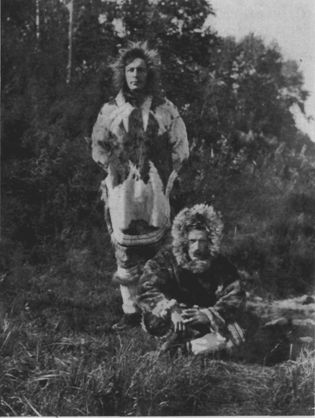
On the beach to meet us are Mounted Police and Eskimo from Herschel Island, Church of England missionaries, traders of the H.B. Co., and Loucheux Indians. But here, as at Arctic Red River, it is that Polar gentleman the Eskimo who claims our attention. Let Sergeant Fitzgerald, R.N.W.M.P., stationed at Herschel Island, speak for the Kogmollye and Nunatalmute Eskimo. In his departmental report this officer states, "I have found these natives honest all the time I have been at Herschel Island. I never heard of a case of stealing among them." He has been there five years. Up here on the Arctic the bare word of an Eskimo is accepted of all men. If he states to an H.B. Co. factor that he has an order from a whaling captain to get certain goods for himself, that unwritten order is honoured though it may date back two or even three years, whereas an order presented by a white man must be in writing and certified.
Why should I enter the lists and take up icy spear for my Eskimo fellow British subject? Because he is so very worth while. Because through the years the world has conspired to libel him. Because within a decade or two he will have passed utterly off the map. And because it is so very much pleasanter to write appreciations than epitaphs. This man wins you at once by his frank directness; his bearing is that of a fearless child. The Indian, like Ossian's hero, scorns to tell his name, and on occasion will dodge the camera, but the Eskimo likes to be photographed. Young and old, they press to our side like friendly boys and girls round a "chummy" teacher, volunteering information of age, sex, and previous condition, with all sorts of covetable bits of intimate family history. You love the Eskimo because he is kind to his dogs and gentle to little children. His entire willingness to take you on credit is contagious, trust begets trust even in walrus latitudes.
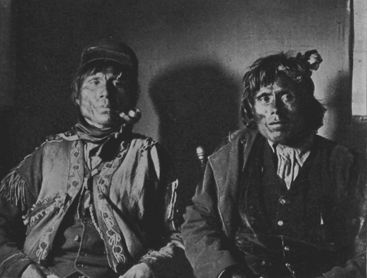
The Mackenzie River Eskimo is a clever chap. With no school-teacher, no school, no modern appliances, he does many things and does each admirably. He is a hunter by land and sea, a fearless traveller, a furrier, a fisherman, a carver, a metal-smith, and he takes in every task the pride of a master mechanic,—"the gods see everywhere." The duties of the man and the woman are well-defined. The head of the Kogmollyc household is the blood-and-flesh-winner, the navigator of the kayak, the driver of dogs. It is he who builds the houses on the march, and when occasion requires he does not consider it infra dig. to get the breakfast or mind the baby. The wife dresses the skins, prepares the food, makes all the clothing, and the lord of the igloo demands from her the same perfect work that he turns out himself.
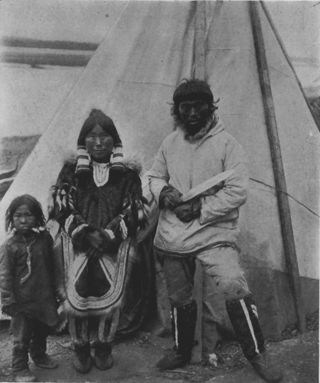
When an Eskimo wife has finished making her spouse a pair of waterproof boots, she hands them to him, and he blows them up. If there is one little pin-hole and the air oozes out, he throws the boots back to her, and she may take up the pedal gauntlet in one of two ways. Either she must meekly start to make a new pair of boots without murmuring a word, or leave it open to him to take to his bosom another conjugal bootmaker. We noticed with interest in watching this little tableau that there was no recrimination. No word was spoken on either side, the exacting husband contenting himself with blowing up the boots and not the wife.
With uncanny fascination we watched one old woman curry a sealskin. Her tongue was kept busy cleaning the scraper, while her mouth was a repository for the scrapings, which went first there, then to a wooden dish, then to the waiting circle of pop-eyed dogs. The whole performance was executed with a precision of movement that held us fascinated.
If a white woman were to be shipwrecked and thrown upon an Eskimo foreshore and presenting herself at a Husky employment bureau, many surprises would await her. Instead of asking for references from her last employer, the genial proprietor would first ask to inspect her teeth. In prosecuting female Eskimo handicraft your teeth are as important a factor as your hands. The reporter for the funeral column of an Eskimo daily, writing the obituary of a good wife, instead of speaking of the tired hands seamed by labor for her husband and little ones, would call pathetic attention to, "the tired and patient teeth worn to their sockets by the yearly chewing for the household." A young wife's cobbling duty does not end with making for her mate boots that shall be utterly waterproof, but each morning she must arise before the seagull and chew these into shape. You see, after the boots are wet each day they get as stiff as boards, then they must be lubricated with oil and chewed into shape. We watched Mrs. Oo-vai-oo-ak the Younger at this wifely duty. Taking the big boot up in her well-shaped hands, incisively, quarter-inch by quarter-inch, the white teeth made their way round the borderland between upper and sole, the indentations looking like the crisped edges on the rims of the pies your mother used to make. Solomon's eulogy of Mrs. Oo-vai-oo-ak corrected to the latitude of 70° North would read, "She seeketh fish and the liver of seals and worketh willingly with her hands; she riseth also while it is yet night and cheweth the boots of her household."
Every bit of Eskimo skin-clothing is as soft and pliable as a kid glove. The effect is not produced without patient labor, and again the teeth of the woman are brought into requisition. The raw sealskins or hides of the reindeer and bear are staked out in the sun with the skin-side up and dried thoroughly. Before this stiff material can be worked up into garments it must be made pliable, and this is done by systematically chewing the fibres, a slow and painstaking task. Creasing the hide along its whole length, the women take it in their hands and chew their way along the bend from one end of the skin to the other, working their way back along the next half-inch line. Watching them, one is reminded of the ploughman driving his team afield up one furrow and down the other.
It falls to the lot of the woman, too, to do her share of boat-making. The men deftly fashion the frames of kayak and oomiak, using in their construction not a single nail or piece of iron, but fastening the wood together by pegs and thongs of skin. Then the women come on the scene, measure the frame, and sew green hides of the proper shape to fit, making wonderful overlapping seams that are absolutely watertight. As it is necessary to put the skin covering on while the hides are raw, the whole job has to be completed at one sitting. So a bee is held of the women of the communal camp.
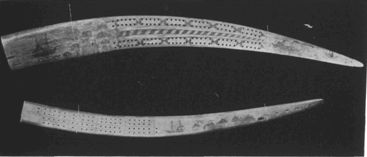
Where did the Eskimo get his versatile ability? Only the walrus knows. The whalers have inducted the Eskimo into the art of making cribbage-boards. They use for each board a complete tusk of walrus-ivory, covering the whole with a wealth of descriptive carvings illustrative of all that comes into the yearly round of an Eskimo's life,—ice-fishing, bear-hunting, walrus-sticking. So far as we could find out, the Husky's connection with cribbage ceased with his making these edition de luxe boards. He seemed himself to have gathered no inkling of the fine points of that game which one instinctively associates with Dick Swiveller as tutor and as pupil the little Marchioness, "that very extraordinary person, surrounded by mysteries, ignorant of the taste of beer, and taking a limited view of society through the key-holes of doors." In the world outside, far from igloos and ice-floes, where people gather round cheery Christmas fires with "one for his nob," "two for his heels," and "a double run of three," these ivory crib-boards are sold for from seventy-five to one hundred dollars each. We have two among our most treasured trophies, and with them an ivory ring beautifully formed which we saw made. Set in the ring is a blue stone of irregular shape which was fitted into its ivory niche with a nicety of workmanship that few jewellers could attain. I had fashioned for me also a gavel in the shape of a sleeping seal, made of fossil ivory from the Little Diomedes. The contrast of the weathered brown of the outside of the ivory with the pure white of the inner layers, when worked up into a carved design, gives the effect of cameo and intaglio combined.
We tasted many new Eskimo dishes. When, on our return, we confessed that the brain of the seal served here is a delicious dish, we ran against the sensibilities of refined natures. But why is it cruder to enjoy seal's brains â la vinaigrette, than to tickle our taste with brains of the frolicking calf? The seal furnished a more equivocal dinner than this, nothing less than entrails au naturel, which our hostess draws through her fingers yard by yard in pure anticipative delight, each guest being presented with two or three feet of the ribbon-like pièce de résistance. The scene that jumps to our memory as we watch this feast of fat things is connected with food-manipulations in Chicago. It was down at Armour's in the stockyards that we had seen Polacks and Scandinavian girls preparing in the succulent sausage a comestible that bore strange family semblance to that which our friends are now eating before us, this linked sweetness long drawn out.
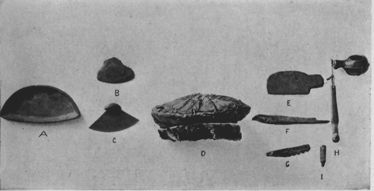
A—Eskimo soapstone lamp which burns seal-oil. The wick is of reindeer moss.
B—Eskimo knife of Stone Age.
C—Its modern successor, fashioned from part of a steel saw, with handle of ivory. This is the knife used by the women; note how the old shape is retained.
D—Eskimo Tam O'Shanter. The band is of loonskins, the cap proper being carefully constructed from swans' feet. This admirably shows the cleverness of the Eskimo in adapting natural forms to economic use, each foot of the swan being a true sector of a circle.
E—Old-time stone hatchet.
F and G—Knives filed from saw-blades, with bone handles.
H—Mortar for pulverising tobacco into snuff.
I—Needle set in a wood handle, and by rapid rotary motion used to pierce ivory.
Mr. John Firth, of the Hudson's Bay Company here, gives us much information regarding these people who for thirty-seven consecutive years have traded with him. The Kogmollycs have been here "from the beginning," the Nunatalmutes moving into this region in 1889, driven out of their hunting grounds inland from Kotzebue Sound, Alaska, by a scarcity of game. The two tribes live in peace and intermarry. The aged among them are respected. Criminals and lunatics are quietly removed from the drama. Supposed incurables commit suicide and in that act reach immediately a hot underground heaven.
Nature to these Eskimo is especially benign. The junction of the Mackenzie and the Peel is covered with a forest of spruce, and even to the ocean-lip we trace foot-prints of moose and black bear. In the delta are cross, red, and silver foxes, mink and marten, with lynx and rabbits according to the fortunes of war. The Eskimo declare that, east of Cape Parry, bears are so numerous that from ten to twenty are seen at one time from a high hilltop.
The Chauncey Depew of the Kogmollycs, the man with the best stories and the most inimitable way of telling them, is Roxi. It was Roxi who gave us the love story of his cousin the Nuntalmute Lochinvar. This young man wooed a maid. The girl's father had no very good opinion of the lad's hunting ability and was obdurate. The lover determined to take destiny into his own hands. A ravine of ice stretched between his igloo and that of the family to whom he would fain be son, and over the chasm a drift-log formed a temporary bridge. Lothario, one night, crossed the icy gully, entered the igloo of his elect, seized her in her shin-ig-bee or sleeping-bag and lifted the dear burden over his back. In spite of struggles and muffled cries from within, he strode off with her to his side of the stream. The gulch safely crossed, he gaily kicked the log bridge into the gulf and bore his squirming treasure to his own igloo floor. He had left his seal-oil lamp burning and now it was with an anticipative chuckle of joy that he untied the drawstring. We end the story where Roxi did, by telling that the figure which rolled out sputtering from the shin-ig-bee was the would-not-be father-in-law instead of the would-be bride!
The Midnight Sun! The sun does not sink to the horizon, but pauses for a moment and rises again. Dawn and eventide are one. The manifestations of light ever since we left Athabasca Landing have been wonderful, uplifting. The supreme marvel of the Midnight Sun is not what we see but what we feel. Standing at this outpost of Britain's Empire, we give our imagination rein and see waking worlds and cities of sleep. As this red sun rises from its horizon-dip, it is the first of the unnumbered sunrises which, as hour follows hour, will come to the continents. Longfellow says:
"Think, every morning where the sun peeps through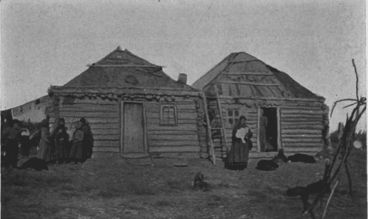
How do the people of Macpherson divide into day and night their largesse of light? By common consent four o'clock in the morning seems to be bedtime, and by four in the afternoon people are busying themselves with breakfast. In Polar Circles, do as the Polars do, is good advice, and we follow suit. Individuality is strongly marked at this metropolis on the Peel. Every one you meet is a mine of interest, and sharp contrasts present themselves. Mrs. Macdonald discusses fur and deer-meat with Jack Johnson. He is a trapper who plays the game alone and who last year was reduced to killing his favourite dog for food. Current report credits him with having "killed his man in the Yukon." Mrs. Macdonald is a Loucheux woman who, at the age of fourteen or fifteen, married Archdeacon Macdonald of the English Church and for eight long years afterwards assisted him in his life work of translating the Gospels into the Loucheux language. She has come all the way from Winnipeg to the Arctic Circle to spend the summer visiting her people. We lose our hearts to her two sons, splendid fellows both.
It is the Eskimo who brings both missionary and trader to Fort McPherson. Are these Eskimo, Christians? Are they civilised? These are the questions that confront us when we speak of these Farthest North Canadians. It is an age of classification. You cannot find a flower nowadays that some one has not tacked a Latin name to, and it goes by inverse ratio—the smaller the flower the longer the name. Every bird you hear sing, even though it stop but an hour to rest its tired pinion on its northern migration, has an invisible label pinned under its coat. How can a man, a tribe, a people, hope to escape? In the northeast of Canada the Eskimo is a disciple of the Moravian missionary. In Alaska, on the extreme northwest of the continent, the Greek Church takes him to its bosom. In between these two come the people we are studying. The Episcopalians through the years have made some sporadic attempt to influence these people, but so far as I know these Eskimo are not Episcopalians. What then must we call these splendid fellows so full of integrity and honour, whose every impulse is a generous one? Heathens? The question sets us thinking.
The Century Dictionary defines a heathen as "Any irreligious, rude, barbarous or unthinking class or person." This Eskimo is not "irreligious," for he has a well-formed conception of a Great Spirit and an Evil One, he looks to a place of reward or punishment after death, and he accedes to Kipling's line without ever having heard it,—"They that are good shall be happy." He is not "rude," but exceedingly courteous, with a delicacy of feeling that is rare in any latitude. "Unthinking" he certainly is not. Six months' darkness within the igloo gives him the same enviable opportunity of thinking that the shoemaker has in his stall, and the whole world knows that the sequestrated cobbler is your true philosopher.
There remains but the one ear-mark, "barbarous." The dictionary declares that barbarous means, "not classical or pure," "showing ignorance of arts and civilisation." On the first of these indictments our poor Kogmollyc must fall down, for he is not classical. And what man dare pronounce on the purity of another? Then we come to "arts" and "civilisation." In arts, this Eskimo can give cards and spades to every European who has visited him. The stumbling-block in this honest search for a tag to put on my people is the term "civilisation." One is reminded of the utterance of the Member of the British House of Commons: "Orthodoxy is my doxy, heterodoxy is the other man's doxy." Was it not Lowell who at a Harvard anniversary said, "I am conscious that life has been trying to civilise me for now seventy years with what seems to me very inadequate results"?
If "Christianity" with the Eskimo means taking him into the white man's church, and "civilising" means bringing him into close contact with white men's lives, then he has not yet attained the first, and has but little to thank the second for. Two years ago eighty of these people in one tribe died of measles, a white man's disease. A stray chaplain wandered into an encampment of Eskimo, finding his way from a whaling ship. He told the people of Heaven, its golden streets, pearly gates, and harp-songs, and it meant nothing to these children of frost. They were not interested. Then he changed his theme, and spoke of Hell with its everlasting fires that needed no replenishing. "Where is it? Tell us, that we may go!" and little and big they clambered over him, eager for details.
Prayer as presented by the white man is recognised as an incantation which should bring immediate and literal results. An enquiring scientist was seated one day with Oo-vai-oo-ak, the two fishing through adjacent air-holes in the ice. Calling across to the white man, Oo-vai-oo-ak said, "How is it, brother, have you any fish?"
"No," replied the man of letters, "I have taken nothing."
"Have you spoken to God this morning?" asked the Eskimo in a business-like tone.
"No," said the wilted Walton.
"Well, that's what's the matter," returned Oo-vai-oo-ak; "I always speak to God every morning before I go fishing. Once, when I went to Herschel Island, a missionary told me what to say. It always works. I have many fish."
The scientist, interested, queried, "And do you do the same when you go duck-hunting or goose-hunting or when you are after seal?"
"No," eagerly responded Oo-vai-oo-ak, dropping his line and pressing close to the geologist, "Is there a prayer for duck, and for geese, and one for seal? The missionary never told me that. You teach it to me, eh? I like to make sure what to say to catch that fellow,—goose and seal."
But, unfortunately for both, the university man did not have the charm.
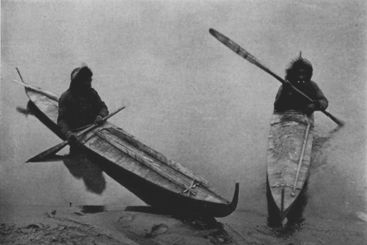
Broadly speaking, the Eskimo's theory of things, evolved from white spirits on the ice-floes or carried across in the age of the mastodon from sires and grandsires in Asia, does not differ materially from our own. There is a Good Spirit, called by different tribes Cood-la-pom-e-o, Kelligabuk, or Sidne, who dwells high in the zenith, and to whom it is good to pray. There is an Evil Spirit, Atti, symbolising cold and death. Their heaven is a warm underworld reached by entrances from the sea. Hell is a far, white, dreary plain. The Eskimo pray to Sidne; but it is wise to propitiate Atti or Tornarsuk, and in this last idea they but follow their Chinese or Tartar ancestors. In common with all nations, the Kogmollycs have a tradition of the flood. Mrs. Oo-vai-oo-ak the Elder said, "This world once covered with the sea." Asked why she thought so, she replied, "You have been down to the land of the caribou, eh? Little smooth stones from the sea are there, and shells."
The labrets or lip-ornaments, shirt-stud shaped effects worn in holes pierced in the cheek, strike us with interest. Is it too daring a conjecture to trace in these, which Eskimo men so sedulously cherish and resolutely refuse to talk about, a religious significance? The term "Kelligabuk" in a literal translation means "Mastodon." This animal, whose bones not infrequently are unearthed from ice-floes, has been for all time venerated as a god of the hunting grounds. Is it too fanciful to suggest that the labrets are a sort of peripatetic idol carried around on the person as an imitation of the tusks of this God-Mammoth?
East and south of the Mackenzie delta the Eskimo tell of a Supreme Goddess, Nuliayok, who was once a coy maiden and refused to marry a mortal. Wooed by a gull, she accompanied the bird to an inland home, to find instead of her dreams of delight a nest of sticks and rotten fish on a high-hung ledge. Jostled by the other fulmars, or gulls, who tried to push her off the rocks, she sent for her father. In the night-time he came and sailed with her over the water in an oomiak. The deserted fulmar-bridegroom, taking a leaf out of Prospero's book, raised a storm. The father, to lighten the craft and propitiate the storm-spirit at the same time, threw the poor bride over-board, and cut off her fingers as she clung to the boat. As the four fingers dropped into the sea they changed respectively into beluga the white whale, nutchook the common seal, oog-zook the big seal, and ibyl the walrus. After thus giving origin to the four great sea-friends of the Innuit, the Goddess Nuliayok let go the boat and went to the world beneath the sea, where she now lives in a whalebone house with a dog for husband. She cannot stand erect, but hunches over the ground, holding one foot under her as a baby does who has not yet learned to walk.
It is to Nuliayok that the spirits of sea-animals go after staying three days by their dead bodies; and this is the reason why the Eskimo breaks the eyes of a killed seal. He does not want it to witness the indignity of seeing its own body denuded of its skin. This too is the raison d'être of the ceremonies which every Eskimo punctiliously performs in connection with the animal he kills. Each animal has a soul or spirit to be offended or placated; if pleased, the spirit of the dead animal communicates with its living kin, who in turn will deem it an honour to be killed by such considerate folk as the ceremonious Innuit. Round the igloo fire we heard another tradition of Nuliayok. The Goddess of the Sea once gave birth to a litter of white and red puppies. These she put into two little water-tight baby-boots and set them floating before a north wind. The puppies landed on southern shores and became the white race and the red race, the Europeans and the Indians. The Innuit, of course, had lived from the beginning.
We arrogate to ourselves the term of "white race," but if these Eskimo were to wash themselves daily (which they do not do yearly) they would be as white as we are. They have fleshy intelligent faces and eyes with more than a suggestion of the almond-slant of the Oriental. The idea occurs to us that the full appearance of the cheeks of the women is more likely to be caused by the exercise of chewing skins and boots than by an accumulation of fatty tissue. The men are distinguished by the thin, straggling growth of beard and moustache which adorns their Asiatic progenitors. The labrets of the men are offset by the long pendant earrings of the women, which are made from H.B. Co. beads and shells brought by Alaska Indians from the Pacific, It is only the women who here tattoo their faces, the three long stripes extending from lower lip to the chin. The men crop their hair in the style of the tonsure of the monk. Neither man nor woman provides any head covering except the hood of the artikki or smock, which hood, fringed with waving hair of the carcajou or wolverine, hangs loosely at the back until called into requisition by a winter's storm or a summer's siege of mosquitoes.
Eskimo clothing is much lighter in weight than it seems, and this is one reason why the Eskimo attachés of every Arctic expedition have moved around with less exhaustion than their European or American leaders. A well-made Eskimo outfit of inner and outer suits, with mittens, socks, and boots, weighs about thirteen pounds, while one imported fur coat of European deerskin will alone weigh more than that.
A custom noted at the afternoon whale-meets and pink-teas might fittingly find way into the latitudes where narrow toes and French heels obtain. Two ingenious young Kogmollyc belles had placed applique pockets mid-leg on their lower garments. When the walrus was passed round and conversation became general, the boots were slipped off quietly and one foot at a time was thrust for a resting spell into the pocket provided on the opposite trouser-leg. This act of easement was done deftly, and the neat action of instep boot-jack never lost its fascination for us.
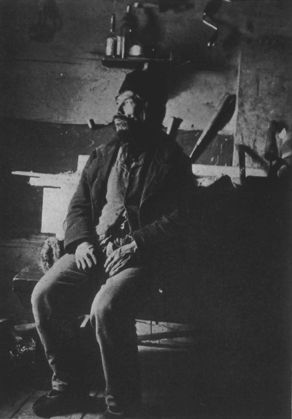
All the way from boundary-line to ice-barrier we had seen Indians tricked out in grotesque garments borrowed from the white man and used in combination with their own tribal covering of skins and furs. These sun-bonnets and shepherd's-plaid trousers, silk hats and red-flannel petticoats, the trader had persuaded the child of the woods to buy. The debonair Eskimo is a re-incarnation of the bastard brother of Aragon's Prince, and, leaning his furry back against the North Pole, says with him, "I smile at no man's jests, eat when I have stomach and wait for no man's pleasure, sleep when I am drowsy and tend on no man's business, laugh when I am merry and claw no man in his humour."
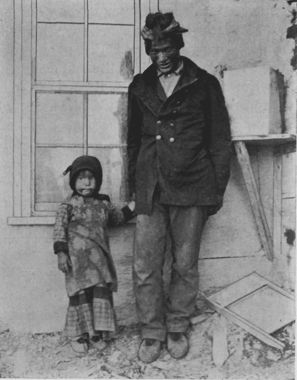
You cannot induce an Eskimo to think he wants anything just because you have found that thing to your liking. There are two reasons for this. First, long experience in the most rigorous climate which the human race inhabits has taught this man what garments are the most suitable for him in which to live and move and have his being. Second, although the Indian may ape the white man as a superior being from whom eleemosynary grub and gew-gaws may be wheedled, the Eskimo of the Mackenzie delta considers himself to be the superior of every created being. The Eskimo knows what he wants; he is always sure of it, and there is no vacillating. When he comes into the H.B. Company's post to trade, skins are his currency, the pelts of the silver-fox his gold coinage. A good silver, or black-fox is worth here about one hundred dollars in barter.
We saw a band of Nunatalmutes come into Fort Macpherson to do their summer shopping. They wanted English breakfast tea, superior rifles and ammunition, and a special brand of tobacco. Failing any or all of these, it was in vain that the Factor displayed before them the wares of John Bull, Uncle Sam, or Johnny Canuck, or any seductive lure made in Germany. Ig-ly-o-bok and Nan-a-sook-tok bought what they found to their liking, took small change out of two silver-fox skins, and put the remaining six pelts back into the wooden box which formed at once their savings bank and letter of credit for the season to come. The hungry-eyed H.B. man confided to us that two of these coveted pelts had been thus exhibited to him and thus tucked back into the Eskimo sinking-fund for three successive seasons.
As regards weapons, we found Eskimo hunters in the transition stage. The old-time spears, four feet long and tipped with ivory, are still in active service. The bows, with arrows finished in copper, flint, and bone, have been relegated largely to the boys, while Krag-Jorgensen, Lee-Enfield, and other high-power guns are bought from American whalers. The fish-hooks which I got in friendly barter are interesting to any one born with angling blood in his veins. Beautifully fashioned of ivory, copper, bone, and beads, the contrivance is a sinker, bait, and hook, all in one. The daily baskets procured with this lure incontestably proves the Husky a judicious hooker.
The Eskimo is a merger. Father Petitot shows us the close analogy between the Kogmollyc language and the tongues of eastern Asiatic tribes, ancient and modern. This Eskimo's speech, then, gives him a connection with the effete East (which is his west), while enamelled washbasins, with here and there a corrugated wash-board, prove that slowly but surely Canadian culture is reaching him from the south.
With two modifications, this Eskimo is invariably truthful. Like the Indians to the south of him, seeking to please you by answering a question in the way that you desire, he will at times tell you an untruth, for it seems to him discourteous to answer your question other than in the way which you anticipate. For instance, if you say to Roxi, "Wasn't that a grey goose we heard overhead?" Roxi will readily assent, though he well knows it to have been a mallard duck, but he would spare your ignorance. Again, it is Eskimo etiquette to belittle your own success in hunting and, in so doing, be not literally truthful. When we place this delightful trait alongside the fish-stories we are familiar with, who would seek to change the heathen?
Marriage with the Eskimo is not a ceremony, it is not even the taking of each other for better or for worse. It is an easy union entered upon and maintained so long as both parties are pleased. This arrangement has one manifest advantage,—Eskimo annals tell of no unhappy marriages. When unhappiness conies in at the door of the igloo, marriage flies out of the chimney. When a woman leaves her tentative husband, she takes herself and her babies back to the paternal topik, and no odium attaches. As the marriage vows melt into the Arctic air, the quondam husband is expected, however, to play the game. Last winter a young Nunatalmute and his sorry spouse came to the parting of the ways. She asked him to take her back to Papa, but he said, "No. You may go to-morrow if you wish, but I am ready to hunt in the opposite direction, and I hunt." Off to the chase he went and took the family auto, i.e., the sled and dogs, with him. The once-wife, travelling five days and six nights by the fitful light of the Aurora, found her way to her father, for the instinct of direction is unerring in these people; but the ex-bride's feet became badly frozen. Public opinion in this case was strongly roused against the husband and probably if there had been a tree handy he would have been lynched. This would have been the first lynching recorded in Canada. The feeling of the Eskimo community was that, when the wife announced her intention of enforcing a divorce, the bounden duty of the husband was either to drive her himself in proper state to her father's door or to let her have the dogs.
In their beliefs in the great powers of concentration and in re-incarnation we find traces in the Eskimo of those Theosophical ancestors of theirs far off on Asian shores. The ceremonies which approximate in time to our New Year's Day and Christmas show the importance they attach to concentrated thought. Early in the morning of what corresponds to our New Year's Day, two young men, one of them grotesquely dressed in women's garments, visit every igloo and blow out each seal-oil lamp. The lights are afterwards renewed from a freshly-kindled fire. The chief, asked the meaning of the ceremony, replied, "New light, new sun," showing his belief that the sun was yearly renewed at this time. This early morning visit from igloo to igloo reminds us of the "first-footing" of the Scottish village. The mummery of wearing the fantastic dress of the woman points back to the old Lord of Misrule.
About the season of Christmas, a great meeting is held in the igloo, presided over by the Angekok or medicine-man, who entreats the invisible powers for good fortune, immunity from storms, and a plenitude of blubber for the ensuing year. This invocation is followed by a family feast. Next day the ceremonies are carried on out-of-doors, where all from oldest to youngest form a ring-around-a-rosy. In the centre of the circle is set a crock of water, while to the communal feast each person brings from his own hut a piece of meat, raw preferred. This meat is eaten in the solemn silence of a communion, each person thinking of Sidne, the Good Spirit, and wishing for good. The oldest member of the tribe, a white-haired man or tottering dame, takes up a sealskin cup, kept for this annual ceremony, dips up some of the water and drinks it, all the time thinking of Sidne, the Good Spirit, while the others close their eyes in reverent silence.
Before passing the cup on to the rest of the company that they may drink, the old man or woman states aloud the date and place of his or her birth, as accurately as it can be remembered. The drinking and thinking ceremony is performed by all in succession, down to the last naked baby cuddling in its mother's artikki, the little child that cannot yet speak. The solemn rite is brought to a close by the tossing of presents across the ring from one to the other, the theory being that, as they generously deal with others, so Sidne will deal with them in the coming year. So up here on the edge of things, among our "uncivilised heathens," we have our Christmas presents and "Peace on earth, good will to men."
Exigencies of life have caused the Mackenzie Eskimo to formulate on vital matters an unwritten law to which each gives assent. Succinctly stated, this system of Northland jurisprudence runs thus:—
(a) Should a man, inadvertently or by malice aforethought, kill another, the wife and children of the man so killed remain a burden on the murderer so long as he or they live.
(b) A drift-log found is treasure-trove, and belongs to the finder, who indicates possession by placing upon it a pipe, mitten, or personal trinket of some kind. Whalers, missionaries and Mounted Police are a unit in testifying that precious flotsam of this kind has remained four or five years in a land of wood-scarcity without being disturbed.
(c) No one must eat seal and walrus on the same day. Thus a check is given to luxuriousness and the Eskimo is self-prevented from falling into the fate which overtook Rome.
(d) All large animals killed are to be looked upon as common property of the tribe and not as a personal belonging of the man who kills them. Thus here, under the Northern Lights, do the Farthest North subjects of the Seventh Edward work out in deeds the dream of Sir Thomas More's crescent-isle of Utopia where men lived and worked as brothers, holding all things in common.
The Eskimo realises that the pleasure of life is in pursuit, not in acquisition. Where wants are many, joys are few; the very austerity of his life has made a man of him. Laying up few treasures for the elements to corrupt, accumulating no property except a little, a very little, of the kind designated by Wemmick as "portable," he, to better and saner effect than any man, decreases the denominator of his wants instead of increasing the numerator of his havings. Surrounded by the palcocrystic ice, the genial current of his soul has not been frozen by that ice. An Eskimo family accepts life with a smile and, in the faith of little children, goes on its way.
An old Scot once prayed, "O Lord, send down to Thy worshippin' people at this time the savin' grace o' continuance." Only one man has less need to pray that prayer than the Scot himself, and that man is the Eskimo. The Indian eats and sleeps as his wife works, but while there is spear-head to fashion or net to mend, the clever hands of the Eskimo are never idle. Thrifty as a Scot, ingenious as a Yankee, every bit of the little property that he has is well kept. You find around this igloo no broken sled-runner, untrustworthy fishing-gear, nor worn-out dog-harness. Civilisation has nothing to teach this man concerning clothing, house-building, or Arctic travel. Indeed, one may hazard the opinion that the ambitious explorer from the outside, if he reach the Pole at all, will reach it along Eskimo avenues with this man as active ally and by adopting his methods of coping with Northern conditions.
On account of the malignity of nature, it is rare that an Eskimo attains the three score and ten Scriptural years. Few, indeed, live beyond the age of fifty-five or sixty. If his life is short, it is happy. This pagan has grasped a great truth that his Christian brother often misses, the truth that happiness is not a luxury, but the highest of all virtues, a virtue filling the life where it originates and spreading over every life it touches.
There is about this Mackenzie Eskimo a certain other-worldliness which we insistently feel but which is hard to describe, and to us his generosity is sometimes embarrassing. At Peel River a band of Kogmollycs met us, carrying on board pieces of their ivory-carving. One man exhibited a watch-chain containing fifteen links and a cross-bar, all carved from a single piece of ivory. He wanted thirty-five dollars or the equivalent of that for his work, saying that it represented the leisure hours of two months. The engineer tried to make him lower his price, but with a courteous smile he shook his head, and the carving was dropped back into artikki recesses. Afterwards, with the air of a shy child, the clever carver came to me and offered me the chain as a gift. It was probably a difficulty of articulation rather than a desire to be scathing which induced this man subsequently to refer to the one who tried to beat down his price as "the cheap engineer."
Surprised at the magnificent physique and unusual height of this little group, one of us began measuring the chest expansions, length of limbs, and width of shoulders of the men and women we were talking with, while the other of us jotted the figures down in a note-book. Many of the men were over six feet tall, and none that we measured was under five feet nine inches. One young giant, Emmie-ray, was much interested in our researches. The whalers call him "Set-'em-Up," for his name bears the convivial translation, "Give us a drink." "You going to make better man, you get Outside—make him like Emmie-ray?" As Emmie-ray pursues the tenour of his Arctic way, hunting the walrus, standing, a frozen statue, with uplifted spear over the breathing-hole of the seal, to the end of the chapter he will think of himself as being used for a stimulating Delineator-pattern in the igloo of the white man.
Forty years ago, when Bishop Bompas came across a band of these people, instead of being awed at the appearance of a white man, they took him for a son of Cain! Their tradition was that, in the early history of the world, an Eskimo murdered his brother and fled to the inhospitable parts of the earth. The bishop, coming to them from the unknown south, must be a direct descendant of the outlaw, with his hands red with a brother's blood.
Circling the ocean-edge from Siberia, without doubt this people came originally from Asia, as the Chipewyans did before them and the Crees before that, the more newly arrived in each case pressing their predecessors farther away from the food-yielding ocean. The Anglo-Saxon estimates all habitable land by his ell-measure, fertility of the soil, its ability to yield turnips, potatoes, and flax, and forty-bushel wheat. The measure of desirability of range of northern tribes has another unit—blood, and flesh, and fish. Your Eskimo and Chipewyan and Cree cares not a potato-skin for your waving fields of grain, your apple-orchards and grape-vines. What he is after is blood and blubber and good dripping flesh; these his soul craves in the night season. These peoples who made their way into the continent by the open door at the north have come down through the years toward the habitat of the white man, not because they loved him, but because a stronger tribe has pushed them back from Arctic flesh-pots.
At the Mackenzie mouth we enjoyed the companionship of that courteous Eskimo gentleman, Roxi, and heard the story of his last winter's larder, but not from his lips. At the beginning of the season Roxi had whale-meat and fresh walrus, and also flour that he had earned from the whalers. In a characteristic burst of generosity he gave the greater part of this to needy members of other tribes who had had poor hunts and who found themselves at the beginning of the Long Night with empty Mother Hubbard cupboards. The Eskimo winter has many mealtimes, and Roxi had but a poor idea of the higher mathematics. Long ere the darkness of the Great Night relaxed its overbearing blackness Roxi got very hungry, and he had no food. Life is dear, even on the edge of things. So into the silence Roxi crept and dug down through the ice and frozen sand to the skeleton of a stranded whale killed three years before. All the sustaining flesh had been eaten from it more than a year ago, but the dried tendons were still there. By chewing these assiduously and picking bones already bare, this generous soul kept life in his body. As I heard the story, the last words of the gallant Sidney dying in agony on Zutphen's field that another's thirst might be quenched came across the ocean from another age and a far land, "Thy necessity is greater than mine." Britain's heroes, men of the finest mould, manifest on the shores of many seas.
Inherited tastes in foods, like inherited creeds, are mainly a matter of geography, or of history, or of both. An Englishman had preceded us to the Arctic, going in in 1907, and the story of his food discrimination still lives in tepee of the Cree and Eskimo topik. The North is full of rivers, the cold bottle is always at your disposal, and generally, if you are any shot at all, you can get the hot bird. But this son of a thousand earls, or of something else, wouldn't eat owl when owl was served, though he would eat crow. Now, eating crow is to most a distasteful task, and the guides questioned the Englishman regarding the gastronomic line he drew. "Aw!" replied he, "No fellow eats owl, you know. Never heard of the bweastly bird at home, but crow ought to go all right. The crow's a kind of rook, you know, and every fellow eats rook-pie."
Having put the seal's body into his own body and then encasing his skin in the seal's, the cheery Eskimo strides the strand, a veritable compensation-pendulum. The seal is so much an integral part of this people that if a geologist were to freeze a typical Eskimo and saw him through to get a cross-section he would have in the concentric strata a hybrid of Husky and seal. Holding up his transverse section under the light of the Aurora, the investigator would discover an Arctic roly-poly pudding with, instead of fruit and flour, a layer first of all of seal, then biped, seal in the centre, then biped, and seal again. This jam-tart combination is very self-sustaining and enduring. Deprived of food for three days at a stretch the Eskimo lives luxuriously on his own rounded body, as a camel on his hump.
Reading an Arctic bill-of-fare in southern latitudes may give one a feeling of disgust and nausea, for it is all so "bluggy." You feel differently about it at 70º North. You put prejudice far from you, comfort yourself with the reflection that raw oysters, lively cheese, and high game are acquired tastes, and approach the Arctic menu with mind and stomach open to conviction. It is all a matter of adjustment. Because raw rotten fish is not eaten in Boston or in Berkeley Square there is no reason why it should not be a staple on Banks's Land.
We had brought with us on our transport two years' provisions for the detachment of Royal Northwest Mounted Police stationed at Herschel Island, and we had been privileged to taste the concentrated cooking-eggs and desiccated vegetables which formed part of their commissariat. Now, a concentrated egg and a desiccated carrot or turnip bear no more family-likeness to the new-laid triumph of the old Dominick or the succulent vegetable growing in your own back-yard than the tin-type of Aunt Mary taken at the country fair does to the dear old body herself. Whale-meat is better than concentrated cooking-egg, seal-blood piping hot more to be desired than that vile mess of desiccated vegetables. I know. I feel like the old Scot who exclaimed, "Honesty is the best policy. I've tried baith."
But we do not live on seal alone in the North, for there is a bewildering bill-of-fare. Reindeer have a parasite living on the back between the skin and the flesh, a mellifluous maggot an inch long. Raw or cooked it is a great delicacy, and if you shut your eyes it tastes like a sweet shrimp. Don't be disgusted. If you have scooped shrimps from their native heath, you have discovered the shrimp, too, to be a parasite.
Another Arctic titbit is that fleshy cushion of the jaw of the whale which in life holds the baleen. What is whale-gum like? It tastes like chestnuts, looks like cocoa-nut, and cuts like old cheese. Whale-blubber tastes like raw bacon and it cannot very easily be cooked, as it would liquify too soon. It is a good deal better than seal-oil, which to a southern palate is sweet, mawkish, and sickly. Seal-oil tastes as lamp-oil smells. But you can approach without a qualm boiled beluga-skin, which is the skin of the white whale. In its soft and gelatinous form it ranks among northern delicacies with beaver-tail and moose-nose, being exceedingly tasty and ever so much more palatable than pigs-feet.
Musquash in the spring is said to be tender and toothsome, but that overpowering smell of musk proved too much for our determination. You may break, you may shatter the rat if you will, but the scent of the musk-rose will cling to it still. There is a limit to every one's scientific research, and, personally, until insistent hunger gnaws at my vitals and starvation looms round the edge of the next iceberg, I draw the line at muskrat and am not ashamed to say so. Compelling is the association of ideas, and the thought grips one that muskrat must taste as domestic rats (are rats domestic?) look. Raw fish at the first blush does not sound palatable, yet raw oysters appeal. The truth is that meat or fish frozen is eaten raw without any distaste, the freezing exerting on the tissues a metabolic change similar to that effected by cooking; and it is convincingly true that bad fish is ever so much better frozen than cooked.
Blubber is not a staple, as is so often misstated, but it is a much esteemed delicacy. During the summer months the Eskimo has to provide light and fuel for that long half-year of darkness within the igloo. The blubber obtained in summer is carefully rendered down and stored in sealskin bags—the winter provision of gas-tank, electric storage-battery, coal-cellar, and wood-pile. In using oil for fuel, this master artificer of the North has anticipated by decades, if not centuries, the inventive adaptability of his "civilised" cousins. The blubber appears in a blanket between the skin of the animal and its flesh, and when it is spared for food, is cut into delicious strings, an inch wide, an inch deep, and the longer the better. Give a Fur-Land kiddie a strip of this sweetmeat and he grins like that Cheshire cat he has never seen. He doesn't eat it, but drops it into the cavernous recesses of his stomach, as you lower your buckets into the well of English undefiled. "Disgusting," you say. It's all a matter of latitude. Watching a roly-poly Innuit baby finding its stomach-level with plummet of seal-blubber sustains the interest of the grand-stand for a longer period than watching your child dallying with the dripping delights of an "all-day sucker." These little babies have the digestion of an ostrich and his omnivorous appetite. Suckled at their mothers' breasts until they are two or even three years old, when they are weaned they at once graduate into the bill-of-fare of the adult. Walrus-hide is about as uncompromising as elephant-hide, and an inch thick. You see little chaps of three and four struggling valiantly with this, nibbling at it with keen delight, as a puppy does on an old shoe, or your curled Fauntleroy on an imported apple. The Eskimo mother has no green apples to contend with in her kindergarten and need never pour castor-oil upon the troubled waters. Every day in the year her babies are crammed with marrow and grease, the oil of gladness and the fat of the land.
To many Eskimo the contents of the paunch of the reindeer is the only vegetable food they get, and this is eaten without salt, as all their food is eaten. They crack the bones of any animal they kill to get the marrow, which is eaten on the spot, the broken bones being pulverised and boiled to make much-prized gelatine. To his fish and flesh the Eskimo adds a bewildering plenitude of wildfowl. Last spring, eighteen hundred geese and ducks were killed by Eskimo on Herschel Island sand-pit. It is the paradise of pot-hunter and wing-shot. Captain Ellis of the Karluk, with one Eskimo fellow-sportsman, got a bag of 1132 ducks, geese, and swans in three days' shooting, to send to the wrecked whalers off Point Barrow, Alaska.
Who are these people, and whence came they? Each little tribe is a book unread before, and full to the brim of fascination. When they are confronted with the picture of an elephant in a current magazine, they are all excitement. The book is carried eagerly to the old man sunning himself down in the anchored oomiak. Animation, retrospection, agitation chase from his seamed face all traces of drowsiness. "We used to know it." "Our fathers have told us." "This land-whale with its tail in front once lived in the land of the Innuit." We are now the ones to become excited. Intending merely to amuse these fellow-Canadians who had been kind to us, we stumble upon a story of intense interest. "Where did your fathers see this animal?" we asked. "Here, in this country. In the ice his bones were hidden," said the old man. With this he relapsed into the torpor we had disturbed, and no further word did we elicit.
Captain Mogg, of the whaling schooner Olga, two winters ago pursued his whaling operations far to the north and east. Ice-bound at Prince Albert Land, he stumbled upon a little settlement of Eskimo. These were completely isolated from and had had no communication with white men or any community of their own race. Only one of their number had seen a white man before—one old, old woman, the grandmother of the band. The captain of the Olga speaks Eskimo fluently, and to him this ancestress of the "lost tribe" had an interesting story to tell. She remembered a white man who came across the Great Sea from the west in "a big kayak," and she extended her arms to show its size. Her people had given this stranger seal-meat and blubber and the "Chief" from the great ship had presented her with a piece of cloth as red as the new-spilt blood of the seal. This grandmother-in-Ice-Land is without shadow of doubt the very child to whom M'Clure gave a piece of red flannel far back in the early fifties while prosecuting his double search for the Northwest Passage and the lost Franklin. We have M'Clure's record of the incident and the little girl's questioning wonder,—"Of what animal is this the skin?" Thus does history manifest itself on the other side of the shield "after many days."
Through the years, the Eskimo has fared better than the Indian. It would seem that the London Directorate of the H.B. Co. expected its servants within the Arctic Circle in the days that are past to do almost a Creator's part and make all things of nothing. The scanty provisions and trading goods from England which filtered in thus far were to be given to the Indians in exchange for furs, while the Factor and his people were largely expected to "live on the country."
Cannibalism was not unknown. The winter of 1841-2 was an especially hard one. On the 18th March, 1841, J. William Spence and Murdock Morrison were dispatched with the winter express from Fort Good Hope to Fort Macpherson. During the second night out, while they were asleep in the encampment, they were knocked on the head by four starving Indian women, immediately cut to pieces, and devoured. It is further reported that these women previously had killed and eaten their husbands and all their children except one little boy. Of the two murdered Scots they ate what they could that night and made pemmican of what was over, reporting afterward that one was sweet but that the other, tasting of tobacco, was not so good.
Father Petitot gives us another glimpse of that awful winter. His naïve words are, "Chie-ke-nayelle, a Slavi from Fort Norman, was a winning fellow, handsome, gracious, the possessor of a happy countenance. On his features played always a smile of contentment and innocence. In his youth he had eaten of human flesh during the terrible famine of 1841. He killed his young daughter with a hatchet-blow, cooked her like flesh, and ate her as a meat-pate. It is said that after one has partaken of human flesh, the appetite for it often returns. I hasten to add that Chie-ke-nayelle, in spite of the soubriquet mangeur de monde which is irrevocably rivetted to his name, has not succumbed to such an appetite. He is indeed an excellent Christian. Nevertheless, I would not like to camp with Chie-ke-nayelle in time of famine."
Another starvation story related by the good Father is not quite so ghastly. He tells us of one "M. Finlaison of burlesque memory," who, when all provisions were out, took his fiddle and, calling the men of his fort before the door of his empty larder, played to them a Scottish reel. That was their dinner for the day,—instead of meat they had sound. The narrator adds, "In America they would have lynched the too-jovial Scotchman. In the Northwest the good half-breeds laughed and applauded the master."
The winter of 1844 also was a season of distress. Referring to this year, a beautiful young Indian woman said to the sympathetic priest, "I did not wish to eat the arm of my father. I was then a small child of eight, and I had not been able to see my old father eaten without crying out with loud screams. But my mother called to me in rage, 'If you do not eat of it, it is that you condemn us and hate us, then you will surely go the same way.' And I ate the flesh of my father, hiding my sobs and devouring my tears, for fear of being killed like him; so much was I afraid of the eyes of my mother."
Another Indian woman confesses, "I left my husband, a hunter at the fort, and took with me by the hand my only child, a boy of six, and directed my steps towards Ka-cho-Gottine. It was indeed far. I only knew the way by hearsay. Once I myself have eaten of my father, but now I am a Christian and that horrible time is far from me. I have a qualm in thinking that my stomach has partaken of the author of my days. Meanwhile his flesh has become mine, and what will happen to us both on the final resurrection day?" Here Father Petitot interpolates, "Ah! if she had only read Dante!" "I did not intend to keep my boy with me, he was too young and too weak. I did not wish to devour him. I had no heart for that. I decided to abandon him. At the first camp I left him, and knew they would eat him there. I wept on thinking of the horrible death that awaited my only child. But what could I do?" This story has a more comfortable ending than the previous one. We breathe relief in learning from the priest that the following night the little boy overtook his mother. He had walked all day and all night, following her snowshoe tracks. They went on together, the third day they snared some hares, and their troubles were over.
Father Petitot tells of a Rabbit-skin Indian who found a mummified body in the forks of a tree near the Ramparts of the Mackenzie and who came running into the Mission, his hair on end with fright, asking excitedly, "Did God make that man or was he made by the men of the Hudson's Bay?"
Another tale of his is of an Indian, Le Petit Cochon, who had a tape-worm and thought it was a whale. "Unfortunate!" exclaims the Father, "possessed of a whale! That's the difference between Le Petit Cochon and Jonah." Sucking Pig said he would join the Church if the priest would rid him of the tape-worm. But we must use the words of Petitot himself, for they are too delicious to lose. "Christmas night, 1865, after midnight mass, Le Petit Cochon, carefully purged, both as to body and soul, by an emetic, two purgatives, and a good confession, content as a King, received holy baptism. I gave him the name of Noel."
In starvation times, guests were not appreciated. Robert Campbell of the H.B. Company, writing from Fort Halkett in 1840, says, "God grant that the time of privation may soon end, and that I may not see a soul from below till the snow disappears." These days of the early forties when England was engaged with the Chartist risings at home and her Chinese wars abroad, were surely parlous times up on this edge of empire. The Fort Simpson journals of February 4, 1843, record, "The Cannibal, with young Noir, and others of the party of Laman, arrived this evening in the last stage of existence, being compelled by starvation to eat all their furs."
Still these sonsy Scots kept a good heart and were able to jest at their misfortunes with the grim humour that belongs to their race. Neither empty larder nor other misfortune disheartened them. The recurrence of New Year's Day and the Feast of St. Andrew were made ever occasions for rejoicing. Up on the Pelly Forks under date of November 30th, 1848, the record reads, "Though far from our native land and countrymen, let us pass St. Andrew's Day in social glee. So fill your glasses, my lads, and pass the bottle round." Three years later, on the same anniversary, the lines are, "Very cold for St. Andrew's, and no haggis for dinner."
And as January Ist ushers in the year 1845, the Factor at Fort Macpherson bursts into verse:
"This day, Time winds th' exhausted chainUnderneath the record a postscript appears, in another hand:
"Oh let us love our occupations,"In the North Sea lived a whale."
What is a whale? Well, although the whalers dub it so, it is not a fish, but is a true mammal, the last of the mammoth creatures that trod the earth and floundered the seas of a past age. The whale is the biggest, the meekest, and the most interesting of living animals. As we go north, we readjust all our ideas of distance and immensity. Rivers are longer, lakes more majestic, and whales bigger than we have ever dreamed. Examining a stranded whale at Herschel, we see the flippers to be really hands with four fingers and a thumb enveloped in a sheath, and rudimentary hind-legs are discovered under the tough skin. Without doubt, the ancestors of the whale were land mammals which became adapted to a littoral life, and in splashing round the shore acquired the habit of swimming. Subsequently carried out to sea, they became under the new environment the structure as we see it.
Off the delta of the Mackenzie, the Circumpolar of Arctic Bowhead whale (Balaena mysticetus) is making his last stand. Unless a close season is enforced, this cetacean carrying round his ten thousand dollar mouthful of baleen will soon fold his fluked fins like the Arab and swing that huge body of his into line with the Great Auk, the Sea-Otter, the Plains Buffalo, and all the melancholy procession of Canadian Has-Beens.
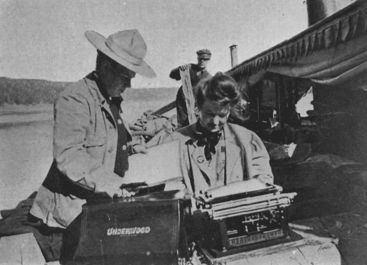
Whales divide themselves into two great classes: those furnished with teeth (the Denticete) and those in which the place of teeth is supplied by a sieve process, furnishing the baleen or "whalebone" of commerce (the Mysticete or Balaenidae). The members of the Baleen Whale family are the Sulphur-Bottoms, the Finner Whales or Rorquals, the Humpbacks, and the king of all whales, the founder of the municipality of Herschel Island, whom his pursuers call indiscriminately the "Arctic Whale," "Polar Whale," "Greenland Whale," "Bowhead," "Right Whale," or "Icebreaker."
Bowheads run in length from seventy to one hundred feet, weighing up to one hundred and ten tons each, there being authentic records of exceptional specimens whose weight reached two hundred and fifty tons. Comparisons are illuminating. The mammoth or hairy elephant in the Field Columbian Museum is nine feet six inches high and twelve feet in longitudinal measurement. The lips of a Bowhead whale are from fifteen to twenty feet in length and yield from one to two tons of pure oil each,—lips that turn a nigger-minstrel green with envy! The eyes placed in the posterior part of the head are each as big as an orange. The tongue of the whale is twenty feet long, and this member, by means of which he pushes to the top of his palate the animalculae on which he feeds (as you would a gooseberry), gives the whaler six tons of oil. The aorta is as big as a man's waist and, at each pulsation of the heart, spurts out ten to fifteen gallons of blood. The heart itself is more than a yard in transverse diameter. The toothed whales carry the teeth in their lower jaw, the most valuable of this lot being the Spermaceti or Sperm Whale or Cachalot, the Pilot Whale or Ca'ing Whale, the White Whale or Beluga, the Killer or Orca, the Narwhal, and such small fry as Blackfish, Porpoises, and Dolphins. Only the toothed whale eats fish; the others live upon animalculae and the most minute of marine life, called "brit" by the whalers. The Bowhead that we have come up to the Arctic to see feeds on the smallest infusoria. He couldn't eat a herring if by that one act he might attain immortality.
Whale errors die hard. Artists persistently depict the big animals as spouting beautiful fountains of water, but the fact is that whales breathe out air only from their lungs. They come to the surface for that purpose, the "blowing" being quite analogous to the breathing of land mammals. Noticing the condensation of a whale's breath up here in the icy Arctic, we guess at the cause which gave rise to this particular blunder. Milton in thirteen words manages to perpetrate three (whale) bulls. "At his gills draws in, and at his trunk, spouts out, a sea." Guiltless of either gills or trunk, no whale ever spouted out anything but common or seaside air.
The Bowhead is hunted for his "whalebone"; the Cachalot or true Sperm, the lord of the toothed whales, for that great lake of sperm oil and spermaceti which he carries round in a portable tank in the top of his head.
It is customary to call whales "fierce," "savage," "murderous," but this is rank libel, for the whale is timid and affectionate. Every family, however, has its black sheep. The Orca or Killer is the terror alike of sealing-rookeries, fish-schools, and whale bone whales. One Killer taken up here had in its stomach fourteen porpoises and fourteen large seals, and it choked to death on the fifteenth. Banded in Molly Maguire groups, the Killers murder the young seal-pups taking their first lessons in swimming off the Pribilofs. We have seen them, a pack of hungry sea-wolves, surround a Bowhead whale! A number of these brigands of the Bering Sea hang on to the lower lip of the big whale till the opened mouth allows a Killer to enter bodily, when the Bowhead's tongue is eaten out and the whole sea is a shambles. At the approach of the Killer even sea-lions seek the shore. And the Alaska Indian who would pose as Bad Bill of the Clambank to the third generation carves a Killer as the crest of his totem.
The American is more aggressive—shall we say progressive?—than the Canadian. The Bowhead whale has within recent years chosen for his summer habitat the pleasant waters off Arctic Canada. Each of these floating tanks of baleen and oil nets his lucky captor from thirteen thousand dollars upward?, and yet for twenty years Canadians have been content to see their more enterprising cousins from California come into their back-yard and carry off these oily prizes.
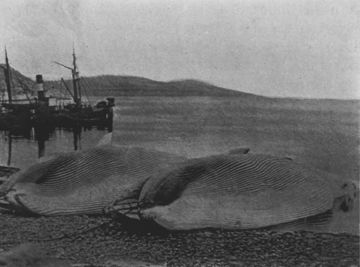
Is there much money in whales to-day? Are not oil and whalebone drugs in the market? Let us see. Off the Mackenzie mouth is Herschel Island anchorage. Here, since 1889, the American whaling-fleet, setting out from San Francisco, has made its summer stand, its winter waiting-quarters. One whale to one boat in a season covers the cost of outfitting and maintenance, and more than one spells substantial profit. In 1887, one of the Arctic whalers, the steamer Orca, captured twenty-eight whales. The Jeanette in 1905 got ten whales and a calf, the Karluk got seven whales, the Alexander eight, the Bowhead seven. The boats wintering at Herschel in that year had among them thirty-three whales and one calf. At fifteen thousand dollars each (San Francisco values for that season) the thirty-three whales netted very nearly half a million. Two years later the Narwhal took out fifteen whales, the Jeanette and Bowhead each four. Although the average bone per head is two thousand pounds, sometimes the catch runs far beyond that figure. A whale caught by Capt. Simmons of the ship John M. Winthrop carried thirty-three hundred and fifty pounds of bone in its head,—$16,750! One of these at a time would be good fishing.
The first Bowhead taken from these waters went in 1891 to the American steam-whaler Grampus, her catch for three seasons being twenty-one whales. Previous to this, even wise whale-men thought it useless to go "to the east'ard of P'int Barrow" for this big whale; since that date the catch in Canadian waters has been thirteen hundred and forty-five whales. Ignoring the oil altogether and putting the "bone" (baleen) at two thousand pounds each whale and the value of it at five dollars a pound, both conservative figures, we find that thirteen and a half millions in whale-values have gone out of this Canadian sea-pasture the past twenty years, by the back-door route.
Are there as good fish in the sea as have come out of it? Expert evidence differs. Captain George B. Leavitt, of the Narwhal, in 1907 lowered twenty-two times without striking and yet went out with fifteen whales. He says he saw that season more whales than any year previous, but that they are on the move east and north.
The general practice is for a ship to reach this water from San Francisco in the early summer; whale as long as the ice will permit; go into winter quarters at Herschel; get out of the ice as soon as possible next summer, probably the first week in July; whale as long as it can stay without getting nipped by the new ice of September; carry out its catch through Bering Strait to San Francisco as late as possible; dispose of the cargo; refit; return next season, and do it all over again. The active whaling-season is restricted to eight or ten weeks, and every one on board a whaler from captain to galley-devil works on a lay. The captain gets one-twelfth of the take, the first mate one twenty-second, the second mate one-thirtieth, the third mate one forty-fifth, the carpenter one seventy-fifth, the steward one eightieth, fore-mast sailors one eightieth, green hands one two-hundredth. Engineers get about one hundred and twenty dollars a month straight. It looks all right in the contract signed a year ago in a San Francisco waterfront dive, but it never works out as it looks on paper. The A.B. overdraws from the slop-chest (often before the whale is caught) the vulgar-fraction which stands for his share of fat things, and you come across him possessed of the sulky mood which dining on dead horse (land or marine) induces in most of us.
A trade in fur also makes out by this Pacific-Arctic, Arctic-Pacific route. We estimate that total products to the value of a million and a half find their way each year out of Canada in the ships of the whaling-fleet. "The farther north the finer fur" is a recognised law. The American ship brings flour, provisions, Krag-Jorgensen guns, ammunition, tea, trinkets to the Eskimo, and receive for these the choicest furs this continent produces.
The Canadian Provinces which propinquity would seem to call to this international whale-joust are British Columbia and Alberta. British Columbia, in her splendid whaling-stations and refineries on Vancouver Island, has tasted whale-blood, the blood of the Humpback and Sulphur bottom, the Orca or Killer, the Cachalot or true Sperm, and one would think her appetite sufficiently whetted to want to acquire the "feel" of Arctic Bowhead profits, the fattest dividend-sheets of them all. Alberta claims as rich hinterland all the coal and gas and timber, tar, furs, feathers, and fish between the parallel of 60° and the uttermost edge of things. These winning bulks of blubber should by all laws of the game be hers. Some day Alberta's metropolis on the Saskatchewan, overcoming the rapids on the Athabasca and the Slave, will send her deep-sea vessels by interior waterways to pull down into Canadian pockets a tardy share of these leviathans. Will there be any left? It is hard to say.
Little wind-swept island of Herschel! We reach you to-day not by deep-sea vessel from the westward but up through the continent by its biggest northward-trending stream. Eighty miles through the Northern Ocean itself from the Mackenzie mouth brings our whale-boat grating upon the shingle. "As far as we go!" This is essentially the Island of Whales, the farthest north industrial centre in America, the world's last and most lucrative whaling-ground. It is well to take our bearings. We are in latitude 69-1/2° N. and just about 139° west of Greenwich; we are a full thousand miles nearer our Pole than the Tierra del Fuegan in South America is to his. And it blows. A nor'easter on Herschel never dies in debt to a sou'wester. Lifting itself one thousand feet above sea-level, this septentrional shelter for ships where the seagulls wheel at our approach, and as they wheel, whine like lost souls, is twenty-three miles in circumference, with neither water nor fuel. For six months every year comparative darkness wraps it around. Snow and ice hold it fast till mid-July; and yet people with tropic isles to choose from and green valleys where the meadow-lark sings have crowded here for twenty years to make their home!
The most incongruous lot that Fate ever jostled together into one corner,—who are they? The whaler of every country and complexion from Lascar to Swede, Eskimo men and women and big-eyed babies, half-caste hybrids of these two factors, Missionaries, and Mounted Police. It is interesting to note the order of their arrival. The whaler drawn by oily lure followed the Bowhead east and north from Bering Sea. To man his boats, to hunt caribou for him, and to furnish temporary spouses, the whaler picked up and attached to his ménage the Eskimo from the mainland in little bunches en famille. Ensuing connubial complications brought the missionary on the scene. To keep the whaler and the missionary from each other's throats, and incidentally to make it easy for the American citizen to trade in Canadian baleen and blubber, came the debonair Royal Northwest Mounted Policeman, the red-coated incarnation of Pax Britannica. There winter at Herschel every year two hundred and fifty whalers and an equal number of Kogmollye and Nunatalmute Eskimo.
Pauline Cove on Herschel Island has three fathoms of water and can winter fifty ships. Landing and looking about us, we experience a feeling of remoteness, of alienation from the world of railroads and automobiles and opera tickets. Back of the harbour are the officers' quarters of the whaling company, the barracks of the Royal Northwest Mounted Police, the huts of the Eskimo; in front of us the clear panorama of the mountains on the shore-line.
North America here, in profound and lasting loneliness, dips its shaggy arms and ice-bound capes into an ocean illuminated now by the brief smile of summer but, for ten months out of the twelve, drear and utterly desolate. The most striking features of the off-shore islands is that they are islands of ice rather than of earth. Slightly rising above ocean-level, they exhibit one or two feet of sandy soil, and between this scant counterpane and the interior foundations of the earth is nothing but pure translucent ice. There is going on a rapid disintegrating of these islands. The whaler calls this far fringe of America "the ocean graveyard" and "the step-mother to ships." There have been five wrecks on this coast in recent years: the Penelope off Shingle Point, the Bonanza off King Point, the Triton on the shores of Herschel itself, the Alexander near Horton River, a little missionary craft off Shingle Point, and Mikklesen's ship The Duchess of Bedford, abandoning her ambitious search for a dream-continent in Beaufort Sea to deposit her tapped-camphor-wood bones on the edge of the ocean of her quest.
The Mackenzie River carries the freshening influence of its current for miles out to sea, and the whole mainland coast is piled high with drift-trees carried by its stream to the Eskimo,—a boon more prized by them than the most seductive story the missionary can tell of the harps and golden streets of that strange heaven of the white man where whale-meat is unknown and blubber enters not.
In July, resurrection comes to Herschel,—saxifrages, white anemones through the snow, the whoop of the mosquito-hawk, and the wild fox dodging among the dwarf-junipers and uncovered graves! And the Midnight Sun? It is not a continual blare of light for twenty-four hours. It sweeps through the midnight heavens, but between ten o'clock in the evening and four in the morning there is a sensible change. Colour tints and lines of demarcation on sea and ships are harder to distinguish, shadows less clearcut. Birds roost and even flowers close, Nature whispering to both that, if they would reproduce after their kind in the short Arctic summer, energies must be conserved. Surely the world holds nothing more beautiful than this Polar night, this compelling gloaming, the "cockshut light" of Francis Thompson. Here the evening and the morning sit together hand in hand, and, even as you watch, lead in the day, the new day born beneath the starless sky. The July sun stabs into activity our incongruous community. On board the vessels guns are cleaned, harpoons pointed, whale-boats caulked, and the winter deck-house is lifted off bodily. Up in the rigging fox-skins and all the year's fur-booty sweeten in the sunlight, and eagerly the spring "leads" in the ice are watched from hour to hour if a way be opened to trend out in the track of the big Bowhead.
Strange people crowd the fo'castle. Two years ago the ships bound for "Outside" got nipped in early ice and were forced to winter at Herschel all unprepared. Reduced to half-rations the crew got weak, and scurvy threatened. The Mounted Police (who by the way are "mounted" in imagination only, as there is nothing for the most gallant to stride here but Husky dogs), in making examination of the men below decks, got to their enquiries a technical reply that staggered them. One able-bodied seaman, busied with between-decks blubber, proved to be a medical man with degrees from two colleges. He subsequently made at the request of the Police a searching report on the state of health of the island community, adding suggestions for its improvement. The report was signed "T.H. Toynbee Wright, M.D.," and, after making it, the A.B., M.D. saluted, donned his oily overalls, and turned once more to the savoury spoils of the Bowhead. Which all goes to prove that in these latitudes "you never can tell."
Whale-men at Herschel give whales five names according to age and size: they are "suckers" under a year, "short-heads" as long as they are suckled, "stunts" at two years, "skull-fish" with baleen less than six feet long, and "size-fish" at the age when a boy reaches man's estate. A whale needs no re-incarnation theory of the theosophist, for he crowds enough experience into one sea-life to satisfy the fact-thirst of the greediest little Gradgrind. Fancy, thrashing the sea for a thousand years! A "sucker" who happened to be disporting round the British Isles when Alfred the Great was burning those historic cakes and prefiguring with candles the eight-hour day may still be chasing whale-brit round an Arctic iceberg. The whale mates, we are told, once and for keeps. Jogging along from one ocean end to another with the same wife for a thousand years without turning fluke to look at an affinity! Shades of Chicago and Pittsburg, hide your wings! Whales follow their annual migration as regularly as do moose and caribou on land, the seal and salmon in the Pacific. Seen first in May in Bering Strait, the Bowheads trend from here north and east, doubling back on their westward journey in July and August, when the Herschel Island whalers go out to intercept them. September sees the great mammals off Southern Kamchatka, and year by year with regularity they follow this Arctic orbit, edging farther in successive seasons to the north and east. The usual track of any family of whales may be left at a tangent on account of a furious storm, excessive cold, the want of food, the harassing of an enemy, or a change in the season of their amours.
A whale, for an old party, is not so slow. Alarmed while extended motionless at the surface of the sea, he can sink in five or six seconds beyond the reach of human enemies. His velocity along the surface horizontally, diving obliquely or perpendicularly, seems to be the same, a rate of from twelve to fourteen miles an hour. Now, to carry a whale of seventy-four tons through the Arctic at the rate of twelve miles an hour would require a (sea) horse-power of one hundred and forty-five. Captain Scoresby, a whale expert, by careful calculation estimates that a surface of two square miles of the Arctic Ocean contains 23,888,000,000,000,000 of the minute animalculae on which the Bowhead feeds, so we hope there is enough to go round. He quaintly elucidates this inconceivable number by explaining that eighty thousand persons would have been employed since Adam in counting these little medusae in the two square miles. Why any one should count them we fail to conceive and gladly accept Scoresby's figures.
The poet tells of shooting an arrow into the air and "long years afterwards in an oak he found the arrow still unbroke." Those who stick harpoons into whales and suffer the animal to get away start floating rumours (a sort of cyclometer of the sea) for their grandsons to read in blubbery history three generations after. England offered knighthood and a bag of sterling pounds to him who would discover a Northwest Passage connecting the Atlantic and the Pacific. M'Clure and the heirs of Sir John Franklin disputed the honour of this achievement. In the "North Sea" lived a whale who exhibited in his own person indubitable proof of having found that elusive Anian Strait. At Herald Island, due north of Bering Strait, in 1886, a whale was caught who carried round in his inside pocket of blubber the head of a harpoon marked Ansell Gibbs. The Ansell Gibbs was wrecked at Marble Island south of Chesterfield Inlet on Hudson Bay on October 13, 1871. Imagination sees opportunity in this for establishing hyperborean letter-service between lovers kept apart by cruel ice-floes. Eskimo Evangeline wandering under Northern Lights seeking Dusky Gabriel might find here a carrier-pigeon of utility. Is it not Pliny who gives us a delightful account of Hippo's enamoured dolphin?
Captain Kelly was the first to notice that whales sing One Sunday, while officers from three ships were "gamming" over their afternoon walrus-meat, Kelly dropped his glass with, "I hear a Bowhead!" There was much chaffing about "Kelly's band," but Kelly weighed anchor and went to find the band-wagon. Every sail followed his, and the result was the bagging of three whales. Among Bowheads, this sing-song is a call made by the leader of a school as he forces passage through Bering Sea to give notice to those who follow that the straits are clear of ice. Walruses and seals and all true mammals having lungs and living in the water have a bark that sounds weird enough coming up from hidden depths. Every look-out from a mast-head notices that, when one whale is struck, at the very impact of the harpoon the whole school is "gallied" or stampeded as they hear the death-song. The dying swan may not sing, but there is no doubt about the ante-mortem Valkyrie song of the whale. From the Bowhead the sound comes like the drawn-out "hoo-hoo-oo-oo-oo" of the hoot-owl. A whaler stops coiling his harpoon-line to tell you that "beginning on 'F' the cry may rise to 'A,' 'B,' or even 'C' before slipping back to 'F' again." He assures us that, "with the Humpback the tone is much finer, sounding across the water like the 'E' string of a violin."
Whalers themselves on this grim shore die without requiem. Every year men desert from the ships. They make their way across from Herschel to a mainland of whose geography they know nothing, thinking that once they strike the shore they can find railway trains which will take them to the gold-mines. One man, Morand, left his ship without sled or dogs. He carried only a gun, twenty rounds of ammunition, some cigarette papers and tobacco. In the spring they found him about a day's journey from the ship, frozen to death. He sat with his gun leaning against his left arm, and a cigarette in his mouth. Both feet and one hand were eaten off. He had fired off nine shots, probably as a signal which was never heard.
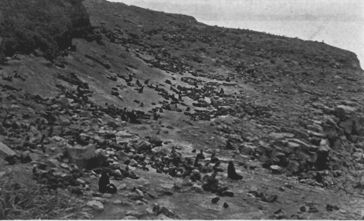
Within recent years, on other shores but this one, an innovation has entered the whaling business. The modern plan is to have shore-refineries and from these strategic bases to send out strongly-built high-speed steamers to shoot detonating harpoons from a cannon into the whale. Such methods are pursued with profit on Newfoundland and Vancouver Island shores. The gun-harpoon, the invention of Sven Foyn, a Norwegian, is furnished at the point with a contrivance which, as it enters the whale, opens out anchor-like flukes which clutch his vitals. Connected by a line to the whaling-steamer, the harpoon holds the quarry until the whaler steams alongside, when the "fish" is soon dispatched. A nozzle is attached to the harpoon-wound, and hot air from the engine pumped into the "proposition" keeps it afloat. The Vancouver Island station has bagged as many as five whales in one day,—Cachalots, Humpbacks, and Sulphur-Bottoms.
The Eskimo say, "There is no part of a seal that is not good," and the same applies to whales. Blubber and bone have their regular markets. The viscera, scraps of fat and oddments tried out in fiery furnaces, appear in the form of pungent snuff-like powder, a much-sought fertiliser. From the Vancouver Island stations it goes across to enrich the cane-fields of Honolulu and the rose-gardens of Nippon. The Japs are eager customers for the dried or smoked whale-meat; and whale-steak broiled to a turn can scarcely be distinguished from choice porterhouse, since it is absolutely free from fishy taste. Far back in the fourteenth century the Biscayans made whale-venison their staple, and Norway to-day has more than one establishment which turns out canned whale. Newfoundlanders find whale-meat a welcome change from cod perpetual, and I have seen the Indians of Cape Flattery eat it when it hailed you a mile to windward and had more than begun to twine like a giddy honeysuckle. Now, enterprising people are talking of canning whales' milk, a dense yellow fluid like soft tallow. When the milk-maid goes out to milk a whale she must take half a dozen barrels along as milking pails. The Eskimo like it. Soon the soda-fountains on Fort Macpherson and Herschel Island will bear the legend, "Whale cream soda" and "Best Whale Milkshake."
To have an even superficial knowledge of the commercial products of the whale, one must learn of baleen, of whale-oils and spermaceti, of ambergris, whale-guano, whale-ivory, and whale-leather.
What do we do with baleen? It so combines lightness, elasticity, and flexibility, that nothing yet invented adapts itself so perfectly to all the requirements of the fashionable corset. Whalebone whips are made from single pieces of baleen seven or eight feet long. A whalebone horsewhip costs from fifteen to eighteen dollars and will outlast a dozen cheaper persuaders. The Sairy Gamp umbrella of the last generation, which boasted whalebone ribs, never "broke its mighty heart" in a rainstorm (and incidentally could never be shut up tight). Flexible steel has taken the place of whalebone in many of the arts; but new avenues of usefulness open up to baleen. Out of it artificial feathers of exquisite lightness and wigs or toupees are made. Shredded into fine filaments, baleen is now woven in with the other fibres in the manufacture of the finest French silks, imparting resilience and elasticity to the rich material. A Chicago paper of the date of this writing advertises:
WHALEBONE TEETH $5Spermaceti, the solid waxy body carried round in the Cachalot's head in solution, is a valuable whale-product. Bland and demulcent, spermaceti is employed as an ingredient in ointments, cosmetics, and cerates. Spermaceti candles of definite size form the measure of electric light, giving rise to the phrase "of so many candle-power." Present-day spermaceti is both a saving and a destructive agent. Large quantities of it are used in Europe in the manufacture of ecclesiastical candles, and part of the same consignment may help to make self-lubricating cartridges.
Most valuable of all whale-products, the costliest commodity on this earth ounce for ounce with the one exception of radium, is ambergris. As amber was once considered "the frozen tears of seagulls," so ambergris for ages puzzled the ancients. Some called it "the solidified foam of the sea," with others it was a "fungoidal growth of the ocean analogous to that on trees." When people in the old days came across anything exceedingly costly they wanted to eat it, on the same principle which makes the baby put each new gift into his mouth. So we have historic record of pearl soup a la Cleopatra, and dishes dashed with ambergris. Milton sings of,—
"Beasts of chase, or fowl of game,What is this choice tidbit? It is a morbid secretion of the intestines of the sick Sperm-whale, and sells for from thirty to forty dollars an ounce. Ambergris, if discovered in the animal itself, is always in a dead or dying body, but it is usually found floating on the ocean or cast up on the shore. Many a day, as kiddies on Vancouver Island beaches, have we turned over bunches of kelp, trying to smell out that solid, fatty, inflammable dull grey substance with its sweet earthy odour. The present-day use of ambergris is to impart to perfumes a floral fragrance. It has the power to intensify and fix any odour. In pharmacy, it is regarded as a cardiac and anti-spasmodic and as a specific against the rabies. For years it has been used in sacerdotal rites of the church; and suitors of old times sought with it to charm their mistresses. The dying sperm, spouting up the ghost, offers of his very vitals to aid the lover and serve the church.
Fascinating are the finds of ambergris. The barque Sea-Fox of New Bedford, in 1866, off the coast of Arabia, took a one hundred and fifty-six pound mass of ambergris, which was sold to the Arabs of Zanzibar for ten thousand dollars in gold. The Adeline Gibbs, in the same year, took one hundred and thirty-two pounds from a bull-sperm south of St. Helena, and sold the hunk for twenty-three thousand dollars. Three winters ago an Arctic whaling-crew put into Seattle, and there leaked out the interesting story of how, not recognising the priceless unguent, they had greased their oars, masts, and knee-boots with "a big lump of ambergrease."
In modern whaling not an ounce of the carcase is cast as rubbish to the void. The intestines make a soft kid which takes any dye and is largely used for artistic leather-work. The size of these immense strips makes possible splendid belts for machinery with a minimum of joinings. The chemically-macerated bones are turned into an "indestructible" crockery-ware which is far more enduring than anything made of vegetable-fibre. The Beluga gives us the best shoe-strings in the world. You can lace your shoes with a Beluga lace for two years and be sure it will not break the morning you are in an especial hurry to catch an inter-Reuben train.
An interest attaches to living whales which outweighs the fascination with which we study their dead parts. Each species of the whale propagates with one of its own species only. The fidelity of whales to each other exceeds the constancy of birds. The whale mother gives birth to one calf, and in extremely rare cases two calves, producing every second year, the young being born between the end of March and the beginning of May. When the mother suckles her young she throws herself on one side on the surface of the sea and the calf regularly feeds at the breast (like a young Eskimo) for nearly two years. During this time the baby is extremely fat and the mother correspondingly emaciated. Perhaps nothing in nature is more touching than the devotion of a female whale to its wounded young. Whalers harpoon the babe at the breast so that they may afterwards secure the dam. In this case, the mother joins the wounded young under the surface of the water, comes up with it when it rises to breathe, encourages it to swim off, assists its flight by taking it under her fin, and seldom deserts it while life remains.
Unless the Circumpolar Bowhead is to become extinct within a decade, the thinking world should strengthen the hands of the Canadian authorities in an effort to put a close season for four or five years on the great Arctic Baleen Whale. At their rate of reproduction it is not so easy to restock a whale pasture as a salmon stream. Cutting down a whale which has taken ten centuries to grow is like cutting down an oak-tree with a thousand concentric rings. You cannot in one or two or twenty scant generations of man grow another one to take its place.
A tax on tea caused the revolt of the thirteen Colonies, a taunting load of tennis-balls lost France to the Dauphin. Eighty years ago on this Arctic edge, white beads, or the lack of them, lost a lucrative fur-trade, alienated the Loucheux and caused the death of whites. "Trifles make the sum of human things."
The old records tell the story. John Bell from Fort Good Hope, under date of August 14th, 1827, writes to the Factor at Fort Simpson:
"The beads sent in for the Loucheux trade are not sufficiently large to please them. I request you will endeavour to send in the largest size for the trade of the ensuing year. A specimen of the kind wanted I send enclosed."
The Factor at Fort Simpson, under date of November 22nd of the same year, writes to the Governor and Chief Factors at Montreal:
"I now forward a specimen of the common white beads wanted for the trade with the Loucheux Indians. It is their request and I hope it will be attended to. I would not venture to make the demand, were it not from conviction that without this favourite article these Indians look with indifference on the best of our goods. No other ornamental article is ever asked for or wanted by these natives."
The same official on March 15th, 1828, pleads with Montreal:
"The white beads demanded for the Loucheux trade I hope will be sent, and of the size according to sample enclosed. May I use the freedom of representing the importance of getting this article to the liking of the Indians, to come up by the Montreal canoes and be ready for outfit 1829? Three kegs will contain the quantity required, 200 to 250 pounds."
Again on the 29th of November, 1829, he writes Montreal:
"The White Beads asked for the trade with the Loucheux are not according to the order sent, 15 pounds only of the quantity received (200 pounds) are of the proper size, the remainder being the same as those in outfit 1825 so much complained of. They will not be satisfactory to the Indians. We request you will be pleased to make a strong representation to their Honours at Home that this article be sent according to order and sample. We now conceive to say anything further would be tiresome."
The Fort Simpson Factor on March 19th, 1830, reports to Montreal:
"The goods came. The white beads was too small and not according to order or sample asked for. The Indians would not take them and left the Fort dissatisfied."
The Trader at Fort Good Hope augments the story by recording that the Indians would be better pleased in trade with two small kegs of the special beads they wanted than with half a ton of any other trade goods which London could manufacture and send out. The sequel of the story is that, disappointed time and again in not getting their favourite beads, the Loucheux Indians failed to bring in the autumn supply of meat to Fort Good Hope and in consequence, before the snows of the winter of 1831 had melted, many of the white men attached to that post died of starvation.
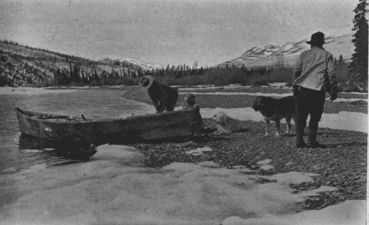
We had gone North with the birds in spring and now, as we turn our faces homeward, the first migrants with strong wing are beginning their southward flight. Our travel is against current now, for we make slower time than we did coming in and consequently see more of the passing shore-line. The last specimens we gather within the Arctic Circle are the blue blossoms of the flax. In them we see the earnest of many a cultivated farm of the future. The days are getting perceptibly shorter and one by one the old familiar constellations come back in the heavens. We find it a relief to have once more a twilight and a succeeding period of dusk. Yet are we loath to leave this fascinating North with its sure future, its quaint to-days, and all the glamour of its rich past.
We had just passed Fort Norman when the sharp eyes of an Indian deck-hand saw three figures on the beach ahead. Pulling in at the point where the Gravel River joins the Mackenzie, we find a regular Robinson Crusoe group,—Mr. J. Keele, of the Dominion Government Survey, and his two associates. Going in on the Yukon side, Mr. Keele's task has been to cross the Divide between the Yukon and the Mackenzie, mapping the rocks. The only white man they had seen in sixteen months was a French priest who had passed yesterday, and whose knowledge of current events in Canada and Europe was scanty. They were glad to see us. A moose-skin boat showed how they had run the rough Gravel; the meat of two moose smoked over the camp-fire; their dogs were fat. These are men who know the woods—no hard-luck story here. It needs only Friday's funny fat umbrella to complete the picture, with the goat scampering in the middle distance.
Coming on board, the surveyors are greedy for newspapers, and we in return learn somewhat of that great slice of land which they are the first to traverse. The Gravel River is two hundred and fifty-five miles long, with "white water" all the way. The force of the current may be appreciated from the fact that it is forty-four hundred feet above the sea-level at the Height-of-Land, and only four hundred feet here where it enters the Mackenzie. All along the banks of the Gravel are moose, mountain sheep, and caribou. The winter cabin of the party was built on the Ross River and there, during the past winter, they experienced a temperature of 54° below. A party of this kind must be to a large extent self-supporting, as it would be impossible to carry from the outside food for such a long sojourn. Speaking with Mr. Keele, one is forcibly struck with the fact that what the technical schools teach their students forms but a small part of the equipment of the man who would do field work in Northern Canada—packing, tracking, hunting, and breaking trail,—each man must do his share of these.
The Keele party on the great watershed, as they travelled east, crossed two families of Mackenzie River Indians going westward to hunt, on the west side of the ridge, the marten and the beaver. It was 32° below, and cold. The whole families were on the march, a little baby tucked in the curve of the sled, and tottering on foot an old, old woman, bent and wrinkled and scarcely able to move. As the Indians were on their return journey toward the Mackenzie in spring, the Keele party saw them again. But the old woman was not there. Under some lonely mound where snow falls in winter and the leaves of birch and cottonwood flutter down in the shrieking winds of autumn rest the bones of the old woman, her many journeys ended. The wearer of a costly fur coat in the glittering capitals of the Old World seldom stops to conjecture how much of hardship, patient suffering, and loneliness go to the making of that luxurious garment. In order that one might be warmly clad, many have gone cold, more than one sad, tired, old head has lain down for the last time by the lonely camp-fire.
Sad is the lot of the Indian woman of the North. Fated always to play a secondary part in the family drama, it is hard to see what of pleasure life holds for her. The birth of a girl baby is not attended with joy or thankfulness. From the beginning the little one is pushed into the background. The boy babies, even the dogs, have the choicer bed at night, and to them are given the best pieces of the meat. The little girl is made to feel that she has come into a world that has no welcome for her and her whole life seems to be an apology. You read it in the face of every Indian girl or woman you meet, from the shrinking pathetic little figure in the camp to the bent old crone, whose upturned face with its sadly acceptive look gives you the flicker of a smile.
Storm-stayed at Wrigley Harbour at the entrance to Great Slave Lake, we have some splendid fishing,—jackfish, whitefish, loche, inconnu, "and here and there a lusty trout and here and there a grayling." Within an hour I get fifteen graylings to my own rod. Collectively they weigh just a little over thirty pounds. Swimming against the current, they take the fly eagerly; and one cannot hope to land a more gaudy or more gamy fish. Its big dorsal fin is rainbow-tinct, the tail an iridescent blue, and the scales pure mother-of-pearl. Mr. Keele has had "The Complete Angler" for two years with him in the fastnesses, and as he helps us prepare the catch for our evening meal over the coals, quotes blithely that the grayling is eating fit only for "anglers and other honest men."
The traverse of Great Slave Lake in the teeth of a wind is not without its interest, for the new steamer has yet to be tried in the waters of what practically amounts to an open sea. She behaves well, and brings us dry-shod into Fort Rae.
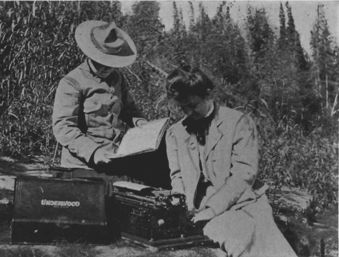
We are the first white women who have penetrated to Fort Rae, and we afford as much interest to the Indians as they afford us. Lone Fort Rae, clinging to the Northern Arm of Great Slave Lake, was noted in the past as a "meat-post." It supplied the Mackenzie District with dried caribou-meat, and formed an outfitting point for the few big game hunters who trended east from here into the Barren Grounds seeking the musk-ox. Its foundation dates back to some time before the year 1820. We cross a bridge of clever Indian construction and sit for a while to muse on a flat boulder of primal rock. This stands as bell-tower to a quaint bell cast in Rome and bears an inscription to some dead and gone Pope. The missionary priest over half a century ago paddled in here bringing the Gospel to the Dog-Ribs.
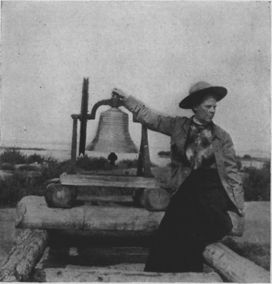
The musk-ox (Ovibos moschatus) is a gregarious animal which would appear to be a Creator's after-thought,—something between an ox and a sheep. The long hair hanging down from the body foreshortens the appearance of the legs and gives a quaint look to the moving herd. The present range of the musk-ox is from Fort Rae north to the Arctic and between the meridians of 86° and 125°. As it is the most inaccessible game in the world, there would seem to be no immediate fear of its being hunted to extinction. Toothed like a sheep, footed like an ox, tailed like a bear, and maned like a horse, the musk-ox does not circle up wind as the moose and caribou do, but travels in any direction he sees fit. Each little herd of ten or fifteen bunches up, tails to the middle and horns outside, to meet a common danger. The robe of the musk-ox is a rich, dark brown streaked with grey, the hair all over the body being very long, with a coat of mouse-coloured wool at its base. According to the Indians, the single young of the musk-ox is born in April. The mother buries the calf in the snow as soon as it is born, selecting a sheltered place for the cradle. Three days after its post-natal burial it is able to frisk with its dam and begin to take up the musk-calf's burden.
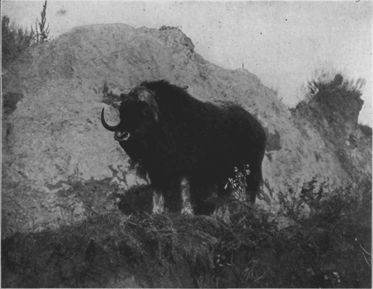
We are all day and all night crossing Great Slave Lake from Fort Rae to Fort Resolution. Food values and the outgoing cargo of fur are the topics of conversation. Years ago a delicate baby at Rae required milk, and with trouble and expense a cow was evolved from somewhere and deposited at the front door of the H.B. Co. Factor there—a cow but no cow-food. All animals must learn to be adaptable in the North. She was fed on fish and dried meat, lived happily, and produced milk after her kind. One of Mr. Keele's men tells of a horse on the Yukon side which ate bacon-rinds with a relish. The dogs at Smith eat raspberries, climb trees for a succulent moss, and when times are really hard become burglars, burgling bacon in the night season, and even being ghoulish enough to visit Indian cemeteries to pick a bone with the dead. A dog in the North Country is surely qualifying for some canine heaven in the asphodel meadows. I know of no created being who is undergoing a sterner probation than this creature forced by man and the exigencies of Fate to work like a horse in winter and live on air in summer.
From Great Slave Lake to Chipewyan the days are enlivened with stories from the outgoing traders. We learn that when the church was still young, some priests on the Mackenzie hungered after flesh-pots in the wilderness and wrote to the Pope, asking him whether beaver-tails were to be considered fish, or flesh. Rome evidently was not "long" on North American mammals and put itself into the class of Nature fakers forever by declaring said tails "fish" and not flesh. This is why you can discuss beaver-tails on top of the world on Fridays to this present and commit no sin.
The stories give us some idea of the difference between winter and summer travel across Great Slave Lake. Captain Mills tells of two Indian women, one old enough to have a daughter of forty, who drove a dogsled one hundred and forty-eight miles from Providence to Rae, in four days. The older one walked ahead of the dogs and made the trail while the other drove. Coming back, it took them five days, and the old woman explained, "We didn't make such good time, as we had a man with us." It was her son-in-law whom she brought back with her.
A striking picture is given us of a woman who walked alone from Hay River to Province on snowshoes, taking thirteen days to do it. She had no matches, and carried her fire with her, keeping it alight in a little copper kettle. This, of course, necessitated her guarding it very closely and stopping to renew the fire from time to time; for if the burning wood was once permitted to die down, her life in that intense cold would go out with it.
How cold does it get? Mr. Campbell Young, of our little group, says that he has been out when a thermometer—one obtained from the U.S. Meteorological Station—registered seventy-six degrees below zero, and has worked in weather like that. "I've been trapping in that temperature, when of course the weather was absolutely still, and I tell you I'd rather be out in seventy-six below than to cross Smith Portage with the mosquitoes." Mr. Christie, of the Keele Survey Party, says, "Last winter I had to go out and get a moose for the camp, and on the second day I met the Mounted Police boys who told me it had been seventy-five below. I had started out when it was quite mild, only forty-five below. You know when it is below fifty, for then your breath begins to crackle, and that's a sure sign." Mr. John Gaudet says, "I was driving last winter on Lesser Slave Lake when it was sixty-four below. Yes, it was quite cold."
At Resolution we see once more our old friend Dr. Sussex, happy and busied among his Indians. It is just hail and farewell. The little "red lemonade" kiddies are the first to greet us as we come into Fort Smith, and here everybody goes visiting. Mrs. (Archdeacon) Macdonald tells us that her grandfather had two wives, and was the father of twenty-two children. She says she and her brother are glad of this, as it gives them so many friends in all parts of the country; and we notice that at every port where we stop Mrs. MacDonald has friends to visit—a cousin here, and an auntie there. The fancy bag in which you carry your calling cards and little friendly gifts up here is a "musky-moot"; the more formidable receptacle, which gives your friends warning that you may stay a day or two, is a "skin-ichi-mun." Visiting a little on our own account, we note that we have penetrated to a latitude into which the gaudy calendars of the advertiser have not yet made their way. Each man, foolish enough here to want a calendar, marks out his own on pencilled paper. We come across an H.B. Journal of the vintage of 1826 where the reckless scribe introduces two Thursdays into one week, acknowledging his error in a footnote with the remark, "It is not likely that the eye of man will ever read this record."
At Fort Smith we leave the steamer Mackenzie River to take passage in the Grahame from Smith's Landing, and once more essay the Mosquito Portage. We find our winged friends in fine fettle. Their eyes are not dimmed, their strength not abated. For miles we notice blackened and dead stems of young spruce, cut off as if by machinery, at a uniform height of two and a half feet from the ground. The top of the dead stem shows the depth of the snow when the rabbits, running along the surface, had nibbled off and eaten the growing spruce. A fur-trader at our side says, "While at Fort Macpherson I noticed that the ice always melted in the spring in Peel's River before it did in the Mackenzie. It would break up in the Peel about the Queen's Birthday and begin to go out. Reaching the Mackenzie, it came up against a solid mass of unbroken ice which sent it back to flood the whole country. It was a curious experience to paddle round in a canoe for miles and miles where one had set rabbit snares but a few weeks before. The poor rabbits themselves were at a loss, for no kind monition apprised them of the coming flood. We could see whole colonies of them,—each a shipwrecked sailor on his own little raft of bark, buffeted here and there with the stream and peering out across the swollen waters, like Noah's dove, seeking some green thing."
Our arrival at Chipewyan is opportune. Honorine Daniels, unceremoniously known as 'Norine among her friends (and they are legion), is about to join hand and fortune with one of the Mercredi boys. 'Norine owns a cottage in her own right, and to-night under her roof-tree there is to be a wedding-dance. We wait round, hungering for an invitation, finally to be told largely, "You don't need no invitation, everybody goes."
We go with the crowd. The room is full to overflowing. Babies are deposited on the benches along the wall, dogs look in at the window. The air is heavy with mosquitoes and tobacco-smoke. But joy reigns. Nobody is too old or too obese to dance. Old Mr. Loutit and lame Jimmy Flett each secures a sonsy partner. There are three fiddlers, and these relieve each other in turn, for fiddling, beating time with your moccasin on the earthen floor, and "calling out" is hard work for one man. There are but two kinds of dances,—the Red River jig, and a square dance which probably had for honourable ancestors the lancers on the father's side and a quadrille on the mother's.
Endurance is a sign of merit in the Red River jig. A man or woman steps into the limelight and commences to jig, a dark form in moccasins slips up in front of the dancer, and one jigs the other down, amid plaudits for the survivor and jeers for the quitter.
It is the square dance that interests us, our attention being divided between watching the deft forms in the half light and listening to the caller-off. Louie-the-Moose first officiates. His eyes look dreamy but there is a general's stern tone of command in his words:
"Ladeez, join de lily-white han's,Over and over again Louie reiterates his injunction, to the accompaniment of pattering moccasins and a humming chorus from door and windows. There are phrases of variation, too. We catch the words, "Address your pardner," "Adaman left," "Show your steps," "Gents walk round, and all run away to the west."
Then Michel Manvil takes hold of the situation. He stands up to it, and we hear
"Ladies round ladies, and gents all so!Why should they, we wonder!
The third fiddler is a full-blooded Chipewyan. In some dancing academy in the woods he has learnt a "call-off" all his own, and proud indeed is he of his stunt. We manage to copy it down in its entirety, fighting mosquitoes the while and dodging out into the open now and again for a little air.
"'Slute your ladies! All together!The perspiring musician pushes his instrument into the hands of Running Antelope and turns to us with, "There's another verse, but I don't always give it." We ask him to repeat it for us, but he seems a little at a loss. "It's hard to call it out without the fiddle. When yer playin' you just spit it out—the words come to you."
It is August 6th at Chipewyan, and once again we are at the parting of the ways. Every one we know is heading for "Outside" by way of the steamer Grahame and the Athabasca scows. Our own ambition is to make a traverse of the great Peace River Country before the snows. We have had no mail since last May, and the temptation to follow the multitude as far as McMurray in the hope of finding letters there is too strong to be resisted. We will then return and try to perfect arrangements for the Peace.
The outgoers are a cosmopolitan and happy "bunch,"—Major Jarvis, R.N.W.M.P., fur-traders galore, three Grey Nuns and a priest, Mr. Wyllie and his family bound for the Orkney Islands, fifty-four souls in all, without counting the miscellaneous and interesting fraternity down on the lower deck among the fur-bundles.
It is essentially a voyage de luxe. When Mr. Keele imagines a place is good, the steamer stops and we all gather fossils. When lame James, the steward, our erstwhile jig-expert, is about to serve coffee, he pokes his head over the side and orders the engines stopped that we may drink the beverage without spillage. The beardless prospector buys tinned peaches from the commissariat, opens them with a jack-knife and passes them round the deck with impartiality and a to-hell-with-the-man-that-works smile. Who would envy kings?
We arrive at McMurray in time for treaty-payment. Tethered horses at the tepee-poles, store-dolls for the babies, and unmistakable "Outside" millinery prove the prosperity of these Crees, and proves also their proximity to Edmonton. One little group looks tattered, out-at-heel, and hungry,—a Cree widow presenting her four offspring that they may receive the annual payment. The officials within the treaty tent declare the youngest baby an illegitimate child and will pay it no treaty,—it "has no name." I catch the anxious look in the mother's eye. Five dollars goes a long way when baby bodies have to be fed and clothed. The situation is crucial. Without a sponsor, the priest will not name the baby. With no name, it cannot draw treaty. I conclude to father the child, as its own (un)lawful father will not. My offer to give my name to the girlie, after due deliberation of Church and State, is accepted. Under the name of Agnes Deans Cameron the Cree kiddie is received into the Mother Church and finds her place on the list of treaty-receiving Indians—No. 53 in the McMurray Band. May she follow pleasant trails!
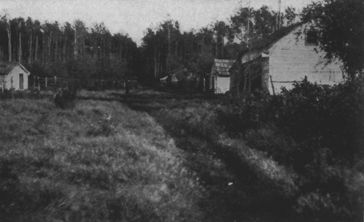
Back of McMurray lies a lush land. We tread a path a full mile in length leading to meadows where, belly-high, the horses graze. Every yard of our way is lined with raspberry bushes bent with their rich, red burden.
While the furs are being transferred from the Grahame to the scows, the working of our typewriter is a matter of much wonderment. Old Paul Fontaine, a half-breed who thinks he is a white man, first looks through the door, then comes into the dining hall where we are, takes his hat off, and watches respectfully. Then, with an air of great conviction, "This is the first time I ever see that. It is wonderful what man can do—wonderful. There is only one thing left to be done now—and that is to put the breath of life into a dead body." Solemnly putting on his hat, he turns and walks out.
Mrs. Loutit, another fellow-passenger attracted by the click of the machine, comes in and recounts her arts, wild and tame. In winter she goes off in dog-cariole, traps cross-foxes off her own bat, shoots moose, and smokes the hide according to the ancient accepted mode. Coming home, she takes the smoked hide and works upon it silk embroidery of a fineness which would be the envy of any young ladies' seminary in Europe or America. She weaves fantastic belts of beads and sets the fashion for the whole North in chef d'oeuvres of the quills of the porcupine. She is a most observant "old wife." Watching, fascinated, the lightning play of the machine, "Much hard that, I think, harder than bead-work, eh?" Conquering her timidity, she at last glides across to find out how the dickens when you strike capital "A" at one end of the keyboard, it finds itself in the writing next to small "o" at the other end. There is something uncanny about it, and our stock goes up.
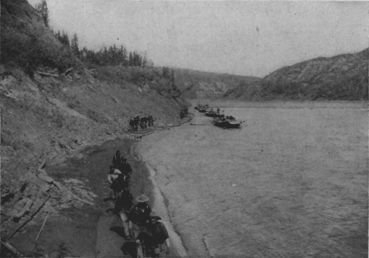
We confess to being a little homesick as we wave farewell to the half hundred passengers in the familiar scows embarked for their two hundred and thirty-eight mile journey up the Athabasca. It will be a tiresome enough trip, though, for every foot of the way the big boats will have to be tracked (towed) by teams of half-breeds scrambling along the shore, now on land, now splashing in the water. The party will have the mosquito as companion on the sorrowful way and it will take them four weeks to make Athabasca Landing, the distance which in the spring we dropped down in little over a week. We send letters home, and with hand-shaking all round bid farewell to Mr. Wyllie, the Grey Nuns, and the rest.
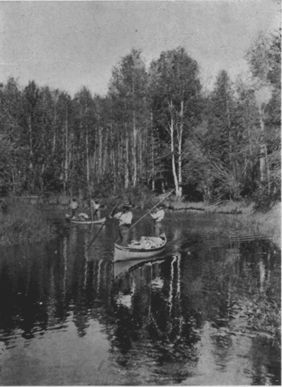
Our way back on the Grahame to Chipewyan is not without adventure. At three o'clock in the afternoon we run up hard and fast on a batture! There is no swearing, no shouting of orders. The deck-hands from long experience know exactly what to do. The engines are reversed and, in their efforts, seem to speak Cree, for we catch the sound of the familiar "Wuh! Wey!" But it is no go. The sun sinks behind the bank, over the tops of the poplars floats a faint rosy glow which fades into purple and then into black, and we are still there hard and fast. The drifting sand piles up against us, and, in scows, the whole cargo is removed. The captain throws out a kedge-anchor, and in a mysterious way we pull ourselves off by hawsers, as a man lifts himself by his own boot-straps.
We have head-winds all the way. At four o'clock on the morning of August 14th, stress of weather causes us to run in under the lee of an island. We tie up at the base of some splendid timber. Spruce here will give three feet in diameter twenty feet from the ground. With an improvised tape-line I go ashore and measure the base-girth of three nearby big poplars (rough-backed). The first ran seven feet three inches, the second exactly eight feet, and the third eight feet four inches. Within view were fifty of these trees which would run the same average, and interspersed with them were spruce with a base-girth scarcely less.
Arrived at Chipewyan, we are able to arrange to be taken up the Peace in the same little tug Primrose which had before carried us so safely to Fond du Lac.
When we leave Chipewyan August 17th, the fall hunt of waveys has already begun. We learn afterwards that the Loutit boys alone made a bag of sixteen hundred of these birds which, salted down, form a considerable part of the winter food of the old Fort. Mrs. William Johnson comes down to see us embark. She has overwhelmed us with generous kindness at our every visit to Chipewyan, kindness we cannot soon forget. It is a small group which now starts out in the little tug on the bosom of the mighty Peace,—Major Routledge, R.N.W.M.P., Mr. and Mrs. John Gaudet with their two olive-branches "Char-lee" and "Se-li-nah," now returning to Lesser Slave Lake from a visit to Fort Good Hope, Miss Brown and myself.
This part of the journey we are to enjoy more keenly than all that has gone before. Rising on the western side of the Rocky Mountains, the Peace River is the largest affluent of the Mackenzie, being already a splendid stream when it cuts through that range. With but one break, the Peace River affords a nine hundred mile stretch of navigation, and we can justly describe the country through which it flows as a plateau in which the river has made for itself a somewhat deep valley. Extensive grassy plains border it on both sides, and north of Fort Vermilion country of this character extends to the valley of the Hay River. Crossing the Quatre Fourches, an offshoot of the Peace at the Lake Athabasca edge, we turn our faces due west to a land of promise. The Mackenzie River and the banks of the Great Slave may some day afford homes to a busy and prosperous populace, but there are many fertile and more accessible lands to be settled first. With the Peace River Country there is no conjecture, for it is merely a question of the coming of the railway. Given a connection with the world to the south, the district watered by the Peace will at once support a vast agrarian population. The advance riders are already on the ground.
It is not our intent to go to the expense of using a steamer for our whole journey up the Peace. Scows will allow us to proceed more leisurely and to see more as we go, so the second day we turn the steamer back and transfer ourselves and our belongings into a little open craft or model-boat The Mee-wah-sin. We have a crew of five men, one on the steering-sweep and four to track, and in this wise we make our way for three hundred miles up the great river to Fort Vermilion. One day we improvise a sail and so make fifty miles in a favourable wind, but, with this exception, every other mile of the journey is by patient towing.
Incidents are many. The first morning after we turned back the little tug, the Kid and I left the slow trackers behind and were glad to stretch ourselves in a long forenoon's tramp along the sandy beach. The mosquitoes were practically gone and for the first time all summer one could really enjoy the woods, where a tang of autumn in the air made every breath a tonic draught. Exulting in the fact that we were alive, we turned a sharp corner and came suddenly face to face with a grey wolf, loping along at a swinging pace at the water's edge, muzzle close to the ground! To make the story worth telling, one should have something to say of "yawning jaws" and "bloodshot eyes" and "haunches trembling for a spring." But this grey wolf simply refused to play that part. He took one look at us, evidently didn't approve, and turned up from his tracks quietly into the cottonwoods above. As we on our side had brought neither gun nor camera from the Mee-wah-sin, we are unable to punctuate the story by either pelt or picture. Sic transit lupus!
A week out from Chipewyan, where the Swan River makes into the Peace, we came one glorious afternoon upon a camp of Crees, the family of the Se-weep-i-gons. They had just killed two bears. We bought the skins and a large portion of meat from them, and Mrs. Se-weep-i-gon very kindly added to the feast of fat things some high-bush cranberries "in a present." As an excuse for listening to their soft voices, before we left the camp we asked the name of every member of the little group, scratching the list down on a piece of birchbark. The Crees evidently considered this an official ceremony, for after we had paid our score and shaken hands with everybody from Grandpa to the latest baby and were well out in mid-stream, Mrs. Se-weep-i-gon came running down to the bank to call us back. Rowing to the shore we found that she had remembered one more child whose name she wanted to add to the list. She assured us that this one too had a little brass cross hanging round his neck, so we will be sure to know him if we meet him in the woods.
We lived for the next two days on bear-meat and cranberries.
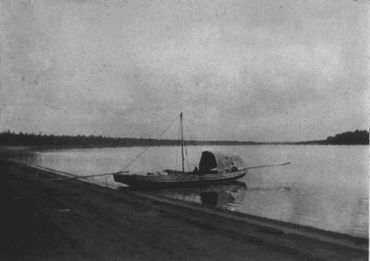
So one wonderful day follows another as our little boat is towed first against one bank then another of this majestic stream. The forest growth is a marvel. We measure one morning three of the spruce trees to which our tent-ropes are tied, and get for base measurement six feet eight inches, five feet two inches, and five feet respectively. The trees averaged ninety feet in height and would give perhaps one thousand feet to each tree. The autumn tints on the willows and alders of the high river-banks are indescribably beautiful. We pass through one hundred miles of a veritable field of the cloth of gold. We look out of our tent-flaps at night on this living glory, and wake up to it again with each new morning sun.
One Sunday evening at dusk we slip into the Hudson's Bay post where the Little Red River makes into the Peace, the dear home of Tom Kerr, his Scottish wife, and their four bairns. Let me try to give the picture. Tom had been off all day cutting meadowgrass, and now wended his way home with a load of it in a little Old Country cart drawn by a wall-eyed mare. At her side frisked a foal, and two great stag-hounds ran back and forward between the master and his home by the riverside. Three children bounded out to greet their father. "Oh! Daddy, Daddy, the red coo broke away from the byre and is far awa on the ither side o' the burn!" Here, in a nutshell, you have the difference between the Mackenzie River of to-day and the Peace River. On the Mackenzie, swarthy forms are in evidence, Cree and French is spoken on all sides, there are no great fields of waving grain, and the dog is the only domestic animal. On the Peace is an essentially white race, cows, chickens, trustworthy old nags, porridge for breakfast, "the tongue that Shakespeare spake," rendered in an accent born far ayont the Tweed. Right across the mouth of the Little Red River, Tom Kerr has a fishing scine. We go down with him to lift it, after the cows have been brought back to the narrow path. The net yields seven fish and they are of five different species,—trout, ling, sucker, jack-fish, and something else that Tom calls a "Maria." Daily this net is set, and for three hundred and sixty-five days every year it furnishes food for the family, in summer in the flowing water, and in winter under the ice. You couldn't starve at Little Red River if you wanted to. This is one of the most beautiful spots in the whole North Countree. Long after Tom and we and Mrs. Tom are under the gowans, and the little Kerrs possess the land, there will be populous cities along the Peace, and millionaires will plant their summer villas on the beauteous spot where we now stand.
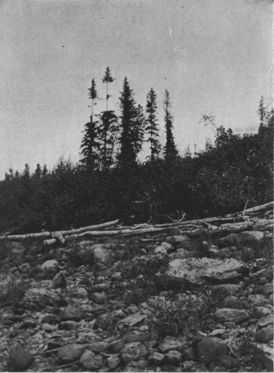
Bidding the bairns good-bye, we press onward on our way, Tom Kerr accompanying us. A great honour awaits us round the next corner, when the boatmen announce that they are going to make us each a lobstick. We land, as pleased as Punch over the suggestion. We now know what it feels like when the philanthropist of a village takes his after-dinner walk through the square and sees the sparrows drinking from the memorial fountain surmounted with his own bust, done in copper, life-size. It takes fully two hours to trim the trees into significant shape, but the beauty of this particular kind of Cook's Tour is that you go down when you like and stop when you want to. The lobsticks furnished, the men form a circle and discharge their muskets in salute, and on we go. We learn that the ethics of lobsticks is that each of these men, should Fate take him past this point again, will salute the lobstick just made and send a strong thought across the spruce-tops to us. There is a reverse to the shield. Should we, at any time before this journey ends, fail to make good, the men on the return voyage will cut the lobstick down. We are going to make no impertinent enquiries regarding the ulterior fate of these family trees. Is it not sufficient glory to say, "On the Peace River we had a lobstick"?
The Chutes of the Peace! These will live forever with the Ramparts of the Mackenzie as the two most majestic visions which the whole North Land gave us. We had not been prepared for that wonderful spectacle which met us as we turned a sharp point in the river. The torrent roars for four or five hundred yards of rapid riverway before coming to its great drop. The rock-reef over which the cataract falls extends quite across the mighty Peace, here a river of immense width. Measured in feet and inches, the Chutes of the Peace must take second place to Niagara, yet they impress us as Niagara never did. The awesome silence of this land so pregnant with possibilities, a land which, though it echo now only the quiet foot of the Cree, is so unmistakably a White Man's Country, intensifies the sense of majesty and power which here takes possession of us. The men talk of the water-power furnished by the great falls, and hazard guesses of the future economic purposes to which it will be put. For our own part, our one wish is to get away from the noise of even these subdued voices and in silence feast our very souls on this manifestation of the power of God. The thoughts that we feel cannot be put into words. Why attempt the impossible?
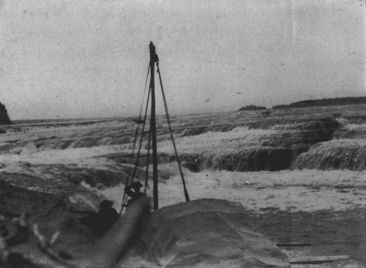
Our way lies beyond this, and the Chutes have to be overcome. These half-breeds know exactly what to do in every emergency which arises. Only one of the men has traversed this river before, and he gives orders. We strip our little Mee-wah-sin of her temporary masts and canvas awning and take out all our belongings. Everybody works. A purchase is obtained by throwing a pulley and rope over a nearby jack-pine, and the boat is pulled out bodily from the water. Then the crew drag her along the shore well beyond the head of the rapid, and we make camp.
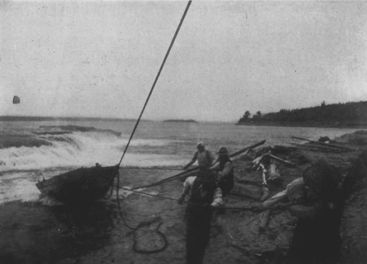
These delicious nights within the tent are memories that will remain through all the years to come. It is cool and silent and productive of thought. We are selfishly glad that fifty people went out by Athabasca ways, leaving to us all the mighty reaches and pleasant pastures of the Peace. The midnight is flooded by a glorious moon, and the thoughts born this afternoon of that stupendous fall have driven sleep far away. Opening the tent-flap, I slip through the camp of sleeping Indians to the edge of the fast-flowing stream. The feeling is insistent here which has been ever-present since we entered this valley of the Peace—here is the home prepared and held in waiting for the people who are to follow.
"Listening there, I heard all tremulouslyIt is on August 27th, in the evening, that the crew, all slicked up in their Sunday-go-to-meetings, draw us up on the beach of the City in the Silences, this Past-in-the-arms-of-the-Present,—Vermilion-on-the-Peace. The first thing to meet our eye is the red roof of the flour-mill of the H.B. Co., a picture of progressiveness set in a living frame of golden wheat, the heavy heads nodding to the harvest.
Vermilion is an old post of the Old Company. Alexander Mackenzie on his way to the Pacific found people at work here far back in 1792. The Vermilion of to-day stands a living monument to the initiative faith and hard work largely of one man, Mr. Francis D. Wilson, who has had charge of H.B. Co. interests here for nineteen years. Mr. Wilson found this place a fur-post on the edge of civilisation, and he has made of it a commercial, agricultural, and manufacturing centre. And his example has been contagious, for the half-breeds around him have become farmers, the Indians who traded furs a dozen years ago now buy harness and ploughs and breach-loading guns from The Company, paying for the same with wheat of their own growing.
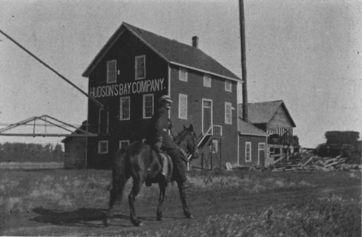
Vermilion is in latitude 58° 30' N.,—that is, about four hundred miles due north of Edmonton, and on practically the same parallel as Stockholm. The flour-mill that we now inspect is the most northerly wheat-mill on this continent, and it has been running for five years. It is the roller process, with a capacity of fifty barrels a day, the motor-power being a 40 H.P. Corliss engine. The wheat which feeds these rollers is all grown in nearby fields, and the resultant flour is consumed by the people of the lone posts of the Peace and the lower Mackenzie. Two years ago the H.B. Company paid to farmers, all of whom lived within a radius of five miles from the mill, the sum of $27,000 spot cash for their wheat. An electric plant lights the mill and fort buildings, affording fifty six-candle-power lights.
Right up to the door of the mill extends the sixty-acre wheat-field of the H.B. Company, from which Mr. Wilson computes that he will this year thrash two thousand bushels. If the H.B. wheat-field were to sell the H.B. mill these two thousand bushels at $1.25 a bushel (the ruling Vermilion price), there would be a net profit of $1500, after paying all expense of culture, to the credit of one branch of Mr. Wilson's commercial institution. For thirty years, wheat, oats, barley, and vegetables have been grown in Vermilion, not as an experiment, but as regular commercial crops. Cereals are sown late in April or early in May, and the harvest is gathered in August. More than once, wheat has matured in eighty-six days from seed-sowing to seed-garnering.
Vermilion farmers boast sulkies and gang-ploughs and the latest geared McCormick, Massey-Harris, and Deering farm implements,—self-binders and seeders. Everything is up-to-date. We ourselves counted fifteen self-binders at work. And grain is not the whole story. The farmers own thoroughbred Ayrshire stock and splendid horses. I happened to be at the garden of the Church of England Mission when the potato-crop was being harvested, and found that seven bags of seed planted in the middle of May produced one hundred bags by the end of August. Five potatoes that I gathered haphazard from one heap weighed exactly five and one-half pounds. I photographed and weighed a collection of vegetables grown by Robert Jones on the Dominion Experimental Farm.
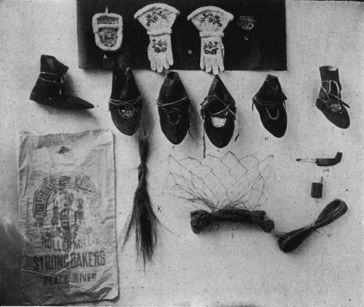
A—Wall-pocket of white deerskin, embroidered in silk-work, and bordered with ermine—the work of a Cree woman at Vermilion-on-the-Peace.
B—Gloves of white deerskin embroidered in silk, the work of a Slavi woman on the Liard River (a branch of the Mackenzie).
C, D, E, F, G, H, I—Moccasins as worn respectively by the Crees, Chipewyans, Slavis, Dog-Ribs, Yellow-Knives, Loucheux—all the work of the women.
J.—Flour bag from the mill at Vermilion-on-the-Peace, the most northerly flour-mill in America.
K—Sinew, from close to the spine of the moose—used by the women of the North instead of thread.
L—Very valuable net of willow-bark made by an old squaw at Fort Resolution. This is almost a lost art, and harks back to the pre-string days.
M—The "crooked knife" or knife of the country.
N—Match-box made from a copper kettle by an old Beaver Indian at Fort Vermilion-on-the-Peace.
O—Babiche, or rawhide of the moose or caribou—"the iron of the country."
One cauliflower weighed eight pounds, half a dozen turnips weighed nine pounds each, and twenty table beets would easily average six pounds each. The carrots and onions were sown in the open in mid-May and were as inviting specimens as I have ever seen. Tomatoes ripened in the open air on this farm on July 13th. Peas, sown on May 23rd and gathered on August 12th, weighed sixty-four pounds to the bushel. Experimental plots of turnips gave sixteen tons to the acre, and white carrots twelve tons. Apple-trees and roses we found flourishing on this farm, with twenty-five varieties of red, black, and white currants. The wheat story is of compelling interest. Preston wheat, sown on May 6th and cut on August 22nd, weighed sixty-four pounds to the bushel; Ladoga wheat, sown on the last day of April and cut on September 5th, ran sixty-four pounds to the bushel also, and early Riga weighed sixty-three pounds. In the garden of the R.C. Mission we were presented with splendid specimens of ripened corn and with three cucumbers grown in the open air, which weighed over a pound each.
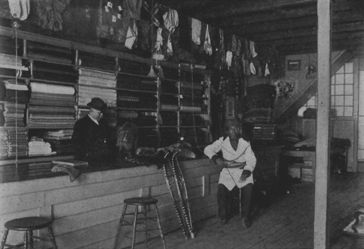
Vermilion is the centre of prairie and rolling timber-land greater in extent than the whole of Belgium. There are probably a million acres of land immediately tributary to the place, all capable of producing crops like those cited. Within a radius of ten miles of the H.B. post there are living now five hundred people of whom perhaps fifty are white. They all to some extent cultivate the soil, varying their farm operations by hunting, trapping, and freighting. The settlement boasts two churches, two mission schools, and two trading stores,—a happy, prosperous, and very progressive community. Everything in the place points to this conclusion.
The H.B. Company here, in addition to buying beaver-skins and growing $1.25 wheat and grinding flour and importing big red binders, breaks the monotony by running a sawmill and building modern steamboats. This sawmill turned out all the lumber for the new steamer Peace River, built here four years ago of native timber. She is a hundred and ten-foot stern-wheeler with twenty-two-foot beam, drawing two and a half feet and carrying forty tons burden. She can accommodate thirty passengers in comfortable cabins, and when going with the current, makes fifteen knots an hour. The sawmill which turned out the timbers for this boat has a capacity of fifteen thousand feet a day.
Within this mill I took, at random, the record sheet of one raft of one man's logs for the spring of 1906, cut in the immediate vicinity of Vermilion and floated along the Peace to the mill. Edmond Paul's logs in one raft gave a total of two hundred and eighty-eight logs, which cut at the mill 27,029 board feet of lumber. The biggest log in this raft was a twelve-foot log with twenty-six inches diameter at the small end, which cut three hundred and sixty-three feet of lumber.
Vermilion in its soil fertility, its modernism, culture, and arrived-ness is a source of recurring marvel and pleasure. If a handful of people four hundred miles from a railway, as the crow flies, and seven hundred miles by actual practicable trails, can accomplish what has been done, into what status of producing activity will this whole country spring when it is given rail communication with the plains-people to the south?
Waiting for steamboat connection, we are for weeks in this glorious autumn weather, guests in the hospitable home of Mr. and Mrs. Wilson. Can we ever forget the generous kindness extended to us within these walls? Months of travel in open scows, sleeping on the ground, and stretching out in blankets on the decks of little tugs have prepared us to enjoy to the full the comforts of a cultured home. It is a modern house, with beds of old-fashioned pansies and sweet-Williams and rows of hollyhocks on all sides. The upper verandah affords a view of the Peace, here fully a mile in width, of incomparable beauty. To the visitor who steps over its threshold, Mr. Wilson's library indicates at once the reading man and the clever artificer. Scientific works of reference, good pictures, the latest magazines, certainly look inviting to ragged travellers who have opened no books, save those of nature and human-nature, for five long months. The office furniture, hand-made of native tamarack and birch, is Mr. Wilson's individual work in both design and execution. Admiring the outcome of hand and head, we get also a glimpse of a warm heart, for we are quick to notice that all these carefully-filed magazines and papers are available for reference to any one in the settlement, whether fort employé or not, who cares to come in here for a quiet hour to read.
Kipling says, "You couldn't pack a Broadwood half a mile," but the Wilson home gives the lie direct to this, blithe line. In a corner of the drawing-room stands an old-fashioned piano with a history. The honourable ancestress of all the modern square pianos and baby-grands of Canada, this little instrument came long years ago in the hold of a sailing ship to Hudson Bay, and by interior waterways was carried by portage and York-boat into Winnipeg, and subsequently into Edmonton. It carries on it the name of John Broadwood & Sons, London. Mrs. Wilson tells us that when she was little it was carried by the boys from house to house on the prairies to do duty wherever there was a social dance. The ghost of the old thing has much quiet here in Vermilion to think of the pretty girls in their short sleeves and muslin frocks who once trod Sir Rogers to its sweet strains.
Mrs. Wilson, the grand-daughter of Peter Warren Dease, the explorer, and the daughter of late Chief Factor Clarke of the H.B. Co., has put in a life of loving service among the people of Vermilion. Her knowledge of medicine and her devoted attention and nursing, extended in the hour of need alike to Indians and whites, has saved the life of many a mother and child; for doctors and professional nurses are unknown in Vermilion. These are the pioneer days, when interdependence breeds neighbourly kindness.
Everything on a Vermilion dinner-table is produced in the country, with the exception only of tea, coffee, sugar, and pepper. The country furnishes beef, pork, and fowl all locally matured; home-cured ham and bacon; every known variety of hardy and tender vegetables; home-made butter; bread made from flour grown and ground on the premises; pies whose four constituents—flour, lard, butter and fruit—are products of the country; home-made cheese; wild honey; home-made wines; splendid fish caught from the Peace, and a bewildering variety of wild game—moose, caribou, venison, grouse, brant, wild geese, canvas-backs, and mallards. Wild berries furnish jams and conserves of a dozen different kinds, such as raspberry, black currant, strawberry, blackberry, cranberry, blueberry, and saskatoon. The salt comes from Slave River, and sugar could very readily be produced from Vermilion beets if there should arise a market. What more would you? The Vermilionese on his fertile acres is as independent of the world outside as is the Eskimo in his Arctic igloo. The farm of Sheridan Lawrence, exhibiting its wide-stretching wheat-fields, some heads of which counted seventy-one kernels, with its patches of one-pound potatoes, twelve-foot sunflowers, and its quiverful of happy, tow-headed children, gives as sweet a picture of Canadian thrift and happiness as one would wish to see. Indeed, happiness seems to be the keynote of Vermilion, whether we seek it within the fort walls of the H.B. Co., on the fat acres of the farmers, or within the folds of Protestant or Roman Mission.
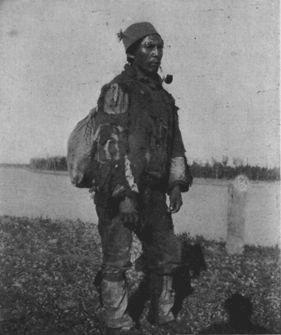
We carry away with us two pictures, that we like to cherish, of the convent kiddies of Vermilion. The first thing we saw when we peered round a corner of this old-fashioned building was the bright face of Sister Thomas of Canterbury playing see-saw with a dozen wide-grinning Slavi babies. When the morning came when we were to bid reluctant good-bye to Vermilion and all its spontaneous kindness, the last sight that met our eyes before we turned the corner of the Peace was the whole convent force of Vermilion perched high on stumps and fence-rails, wishing us bon voyage with fluttering pocket-handkerchiefs, while Sister Thomas of Canterbury, on a ladder, surmounted the crowd and waved her farewells with a table-cloth.
"'Tis a summer such as broods
O'er enchanted solitudes,
Where the hands of Fancy lead us through voluptuary moods,
And with lavish love outpours
All the wealth of out-of-doors."
—James Whitcomb Riley.
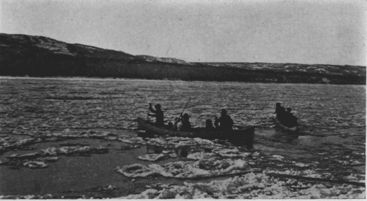
On September 15th we leave Vermilion, leave, too, on the beach the little Mee-wah-sin, and in the tiny tug Messenger of the H.B. Company pass on up the Peace. By night we tent on the banks, by day we puff along between painted banks of gold and crimson, while all around us the air is a pungent tonic, and overhead the southward-passing cranes are flying.
Little Se-li-nah, the sturdiest of travelling companions through months of wandering over portage and up river, has won our unbounded respect and created for herself a warm place in every heart. Se-li-nah, though, makes it impossible for us to pose as brave endurers of hardships. Each night and morning she carries her little pack on and off shore, takes her share of pot-luck at meat-su, and is never cross. Bless the kiddie! If ablutions seem to her a work of supererogation and our daily play of toothbrush furnishes all the fascination of the unknown, still hers is the right stuff for pioneer lands and she has lessons to teach us in pluck and endurance.
The first night out from Vermilion we made camp after dark and, on waking, found that in our blankets we had lain directly across four new bear-tracks. Moose-tracks are plentiful at every stopping-place, so we see to it that both guns and camera are primed. At eight next morning we pass Not-in-a-gu Seepee. Some Indians hail us, asking for tea, and from these we learn that ten families who made this their winter camp last season bagged eighty moose among them.
At half-past two our chance came. To get away from the noise of the engine, the Kid and I had moved our work directly after breakfast to a flour-laden scow that we had in tow, and I was dictating this story to the machine when the sharp eyes of Showan in the distance spied a moose. He was on the shore cropping willows. It had been generously agreed that if opportunity offered at a moose the shot was to be mine, so in excited whispers the news is telegraphed to our end of the scow and my rifle is handed up. The fireman slows up on the engine, but still its throbbing sounds distressingly loud as we creep up on the feeding moose and scan the lay of the land, calculating his chances of escape. The banks are high,—perhaps one hundred and fifty feet—and sheer, but there are two gullies which afford runway to the bench above. What an ungainly creature he looks as we draw in nearer, all legs and clumsy head,—a regular grasshopper on stilts! He reminds me of nothing so much as those animals we make for the baby by sticking four matches into a sweet biscuit. And now at last he sees us. I fire, and the shot just grazes his spine. Will he take to a gully? No, he plunges into the river instead and we follow him up in the little tug. One more shot is effective, and I have killed my premier moose. "Cruel!" you say. Well, just you live from mid-May to mid-September without fresh meat, as, with the exception of Vermilion's flesh-pots, we have done, and then find out if you would fly in the face of Providence when the Red Gods send you a young moose! To illuminate the problem I transcribe the menu of one sample week of the summer.
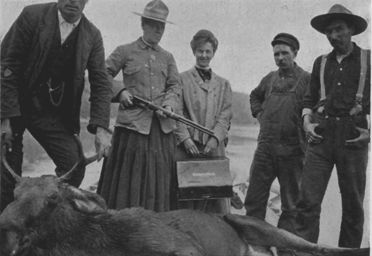
This is the literal "dope sheet" of the camp cook:
Monday:—Dried caribou and rice.
Tuesday:—Salt fish and prunes.
Wednesday:—Mess-pork and dried peaches.
Thursday:—Salt horse and macaroni.
Friday:—Sow-belly and bannock.
Saturday:—Blue-fish and beans.
Sunday:—Repeat.
Dragged ashore, the moose proved to be a male of two prongs, about eighteen months old, and weighed perhaps four or five hundred pounds. A full-grown moose of this country will sometimes dress half a ton. We are to learn that there are many viewpoints from which to approach a moose. The Kid wants its photograph, Chiboo and Mrs. Gaudet each eloquently argue for the skin, the rest of us are gross enough to want to eat it, and Se-li-nah, looking demurely off into the pines, murmurs gently in Cree, "Marrow is nice." Poor young stripling of the Royal House of Moose, you could not have fallen into more appreciative hands!
The first thing Baptiste does is to plunge his penknife into the back to see how deep the fat is. We had noticed this testing process before. A bunch of feathers is always plucked off the new-killed bird that one can immediately gauge the gastronomic niche at which to set one's waiting stomach. No more voyaging to-night. The moose is cleaned and skinned. Mrs. Gaudet draws the skin. I claim the head. A little Indian boy, who with his mother had been added to our ship's crew at Carcajou Point, appropriates the kidneys, which he proceeds to roast in the ashes. Ten-year-old Bill evidently likes his devilled kidneys rare, for within three minutes we see him prancing round the camp, nibbling his dripping dainty from the point of an impaling stick.
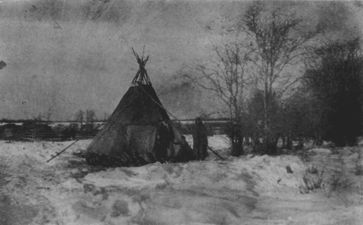
Having sat round the barbecue half the night, we pull out late the next morning. And now, apprised by moccasin telegraph, we are all on the qui vive to catch sight of a floating bride. A fur-trader attached to "The French Company" at Vermilion has been out on six months' leave and is bringing in a bride from Paris. We are to expect them to cross our course on a raft, floating in with the current of the Peace as we make our way upstream. We see the raft. All is excitement. We direct the steersman to draw close in, and the men prime their rifles for a salute. She is not visible,—floating brides on the Peace shrink evidently from being the cynosure of passing eyes. Our men fire their salute, the steersman on the raft looks puzzled when we, smiling our sympathy, peer over the edge of his craft, and see, instead of the Parisian bride,—a load of Poland pigs for Vermilion! It is the wrong raft. The real bride passes us in the gloaming ten hours later, when it is too dark to get a satisfactory photograph!
On the evening of September 22nd we arrive at Peace River Crossing, or Peace River Landing, just a week out from Vermilion. Our course from there has been almost due south. We turn the little Messenger back here and regretfully bid good-bye to our staunch and friendly boatmen. No people in the world could be pleasanter to travel with than these splendid men of the North. Indefatigable and ready for any emergency, they know their business and are always master of the situation; moreover, nature has dowered them with an intuitive delicacy as rare as it is pleasing. Through all these weeks, intensely interested as they are in everything that is new, never for a moment have they intruded upon us or our doings. At night there is not a man of them who will not walk a quarter of a mile through the woods rather than pass between our occupied tent and the camp fire. But let us offer to show them pictures or to explain the workings of the camera or the typewriter and it is a different story, for then every man Jack drops his oar or tump-line and rushes to our side like an excited schoolboy.
Peace River Crossing is in latitude 56° N. and longitude 117° 20' W. From that far-off day in spring when we first touched the Clearwater we have been following in the historic footprints of Sir Alexander Mackenzie. We now take a day off, with the object of locating Mackenzie's last camp on the Peace, which he reached in 1792 and from which, in the spring of 1793, he started west across the map seeking an unknown route to the Pacific Ocean. We find the remains of that camp. It is in the corner of a potato-field a little way beyond Peace River Crossing and on the opposite side of the river. Only the foundations of the walls are left and the crumbling bricks of two old chimneys. Mackenzie was the first man to cross the continent from sea to sea north of the latitude of Mexico, and it was from this point where we stand that he launched his ambitious canoe. There is no more historic spot on the continent than that on which we stand this September day, and as yet it is all unmarked of commemorative stone or recording tablet. The lost camp had never been photographed until we brought our inquisitive camera to bear upon it.
I stoop and pluck from where it nods behind the old chimney a wild larkspur, and as I half-mechanically count its forty-two seed-pods, I try hard to throw back my thoughts to the year 1792,—one hundred and sixteen years. It is a far call! Canada is tardy in her recognition of her early builders of Empire. Our cousins to the south would appear to be more appreciative. In song and story and by a memorial World's Fair the people of the United States have honoured the discoveries of Lewis and Clark, but Mackenzie crossed the continent a full dozen years in advance of these explorers.
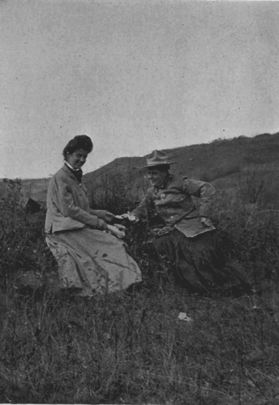
Our mind feels back across the centuries to little-known Montreal where, amid the bales of peltries and the trading-trinkets of the Fur Company, a hidden voice is speaking and a young man listens. That young man is Alexander Mackenzie, a self-taught Scot, a Canadian bourgeois. In the noisy midday clatter of the fort he hears the voice, in the waking hours of dawn and "when evening shuts the deed off, calls the glory from the grey." He cannot get away from that haunting challenge, he would not if he could. There are interminable changes rung on the everlasting whisper, but its burden is ever the same.
"Something lost behind the Ranges,No more might it satisfy him to out-do his competitors and carry back to Grand Portage canoes overflowing with furs. We have seen how the doughty and determined Scot followed to the Arctic the river which now bears his name. It gives us the measure of the man to know that the thought uppermost in the mind of Mackenzie returning from the Arctic was not pride in the deed accomplished but a realization of his limitations in astronomical knowledge. He would go back to Britain and study stars for a time instead of skins, planets for peltries. And back he went in 1791. His first achievement had but whetted his ambition. It was of a Western Sea that he had greatly dreamed among the bearskins and beavers of Montreal, and to that ocean which split its waves "somewhere" far beyond the snow crests of the Rockies he would go. With this strong determination he returned from Scotland, made toilsome way to Fort Chipewyan and pressed up the Peace to make the camp among whose ruins we stand. The breaking of the spring ice of 1793 sent him forth on the quest of that Northwest Passage by Land.
"O Young Mariner,We have not time to recount the chapters of the story, to name the streams ascended, the boiling gorges passed, the discontent allayed, the encouragement given, the lonely night-watches when the leader himself looked for comfort to his new-found stars. The Fraser was discovered, traced for a while; and then, striking westward, Mackenzie heard the beat of the surf upon the rocks, and came out from among the pines to the silver Pacific sparkling in the sun. It was a sweet day in summer's prime, and as the gulls cried overhead and the sun mixed scent of seaweed with balsam breath from in-shore, we can imagine but not divine the feelings of that brave man who had thrown himself face-downward on the sand and from whose presence the awed companions stole silently away. We remember the words of another builder of Empire,—
"Anybody might have found it,—W.H. Carruth.
At Peace River Crossing we say good-bye to the Gaudets, whose home is here. While they have been making a little summer jaunt to Fort Good Hope under the Arctic Circle the garden-seeds they sowed before they left have not been idle. Mr. Gaudet shows us a pumpkin which weighs twenty-five pounds, a squash of the same weight, and citron melons, which weigh over ten pounds each.
To those who continue up the Peace from here, three great open prairies present themselves: the Spirit River Prairie, the Grande Prairie, and the Pouce Coupé. The Spirit River Prairie spreads over a thousand square miles of splendid soil, sandy loam on a subsoil of clay. Wood and water are plentiful, horses winter in the open, and crops here have never been damaged by frost.
Trending south from the H.B. post of Dunvegan, one reaches the Grande Prairie by passing through the fertile belt of Spirit River. Grande Prairie is a loose term given to an area of thirty-five hundred square miles of black-loam country. Settlers in this section never feed their cattle longer than six weeks each winter.
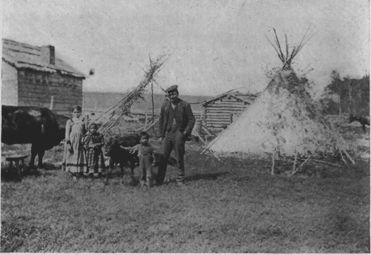
The Pouce Coupé would seem perhaps the most attractive of all the Peace River Prairies. The natural vegetation on its one thousand acres proves the soil exceedingly rich. Pea-vine and blue-joint hide a horse here in mid-August, and berry-vines show no touch of frost at mid-September. Shrub-grown knolls dot the rolling surface, while lakes and streams give abundant water. Through three mountain-passes the Chinook drifts in, tempering everything it touches and making it possible for Indians and pack-train men to winter their horses here without any trouble on the naturally-cured grasses. They drive the animals in at the end of autumn, and the horses come out in the spring hardened and fit for work. This is a paradise for wild animals. Rabbits seek the pea-vine, the lynx and the fox follow the rabbits, and the bear finds here the berries that tickle his palate,—blackberries, strawberries, cherries, cranberries, willow-berries, and saskatoons.
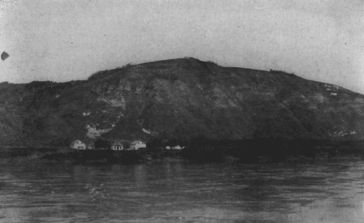
On September 24th we engage waggons to carry our dunnage a hundred miles south from Peace River Crossing to Lesser Slave Lake. This stands out in our memory as one of the most beautiful bits of the whole ten thousand miles that we travelled. With the cool mornings and evenings and the suggestion of frost in the air it is ideal walking and we tramp almost all of the hundred miles, letting the waggons overtake us at meal-times and waiting for them again when it is time to camp. The trail leads us through a rolling, lightly-wooded country, with many streams and open glades. At every lake and runway we flush ducks and wild-fowl, like us bound south, and like us, too, loath to leave the golden fulness of this land. The sun is strong, the stretch of woods on each side of the trail is a painter's palette splotched with vivid golds, greens, crimsons, and tawny russets. Robins, little moose-birds, and saucy whiskey-jacks are fairly revelling in the berries, crowding close to us, disputing the very berry we are popping into our mouths. Spring lingers late in this Land of Promise. Strawberry blossoms are around us everywhere, nestling amid the ripened fruit, and on September 25th in latitude 56° N. I pluck a little pasque-flower, one beautiful belated anemone.
Next evening's tramp brings to view the little settlement of Lesser Slave, and we sigh to realise ourselves another one hundred miles nearer civilisation,—the "civilisation" of Chicago! A strong desire possesses us to about-face and back to the woods again.
It is upon all the excitement of the Lesser Slave potato-harvest that we intrude. Every one is busy piling potatoes in heaps, putting them into sacks, wheel-barrowing the bags into winter storage,—men, women, children, cassocked priests, and nuns surrounded by their chattering flocks. A noise in the upper air causes everyone to stop work. We look up, to count a flock of high-sailing cranes floating far to the south,—one hundred and fifty-three of them. The observers make a pretty picture,—the rigid figures and uplifted faces of the monks, the nuns with their up-kilted skirts, the happy children. "It is the Man with the Hoe," I murmur. "Yes," assents the Kid, "and The Angelus at Lesser Slave."
We are the guests at Hudson's Bay House of Mr. and Mrs. George Harvey. Mrs. Harvey is one of the best horsewomen in the North, and it is clear delight, with her as pilot, to find ourselves once more in the "horse latitudes"—though, indeed, it is no belt of cairns where Mrs. Harvey leads. The only real accident of the summer writes itself on this page. The day after our arrival we were incontinently spilled from a democrat and dragged half a mile through the muskeg, being saved only by Mrs. Harvey's splendid pluck and presence of mind. Climbing along the pole, this cool-nerved lady gathered up the lost lines, sawed the horses' mouths, and pulled our craft into the desired haven, incidentally in the act making possible the writing of this "immortal work"!
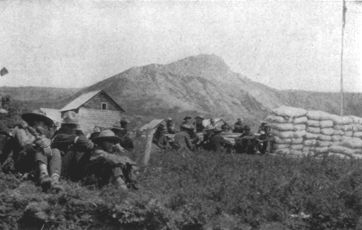
Things are more on the move here than elsewhere we have been. Everybody rides, from grandmothers to two years' babies, and everybody handles a gun. Duck-shooting is at its height, for the wild-fowl linger to feed on their way south at Lesser Slave as they do at Chipewyan. Mr. Harvey and his assistants, Old Country boys, some of whom have seen service in Britain's foreign wars, are all wing-shots, and there is friendly rivalry among them regarding the season's scores. The ducks are shot at dusk. After office hours we watch each little group, equipped with the latest capers in London and Dublin sporting-irons, hie off to the vantage-points in the marshes. On the walls of the office each resultant bag is verified and recorded, the figures being kept from year to year. To make good at Lesser Slave, if you are a man you must ride well, shoot straight, honour The Company, and otherwise play the game. This is the healthy standard Mr. Harvey sets and follows himself.
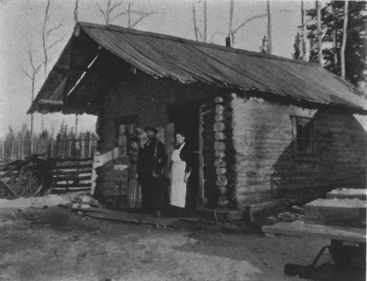
There is much to tempt the camera here. We see the identical shack in which Sergeant Anderson made his arrest of the murderer King, and, driving along a mile to the garden of the R.C. Mission, we photograph giant cabbages, one of which weighs full forty pounds.
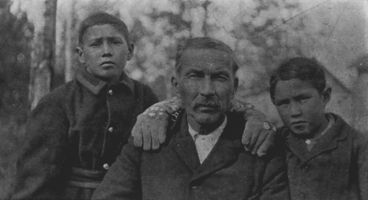
By special good luck we run across Alec Kennedy,—tall, straight, fifty-seven or thereabouts, with a face that shows the mixing of Scotch blood with Sioux. On his coat shine two African Service medals, one granted him by the British and one by the Egyptian government. His grandfather was one of those Selkirk Scots who colonised the Red River a century ago, but, in Kennedy, Indian blood far outweighs the white. He married a full-blood and has several splendid-looking children. At the time of Riel's first half-breed rising, Kennedy's services attracted the notice of Sir Garnet Wolseley. When, in 1844, Wolseley was detailed to lead an expedition for the relief of Chinese Gordon, then at Khartoum, he had to think of the details of river-transportation, and the flat-boats of the Nile recalled the Canadian batteaux and Alec Kennedy. It is a far call from the Lesser Slave to the Nile, but men who can navigate boats and manage crews are rare, and the outcome was that this Scots-Sioux,—strong, silent, faithful, was ordered to collect a party of Canadian voyageurs and report to the Commander-in-Chief. Reaching Egypt, Kennedy was at once attached to a young officer, Kitchener, who, too, was later to win his spurs. Round the camp-fire we induce Alec Kennedy, between puffs from a black pipe, to tell in short ruminating sentences of the hansoms slurring over London mud, of the yellow Nile, of Africa's big game, of the camel that takes the place of the moose, of the swart Arabs and Egyptians. But of his own deeds of derring-do Alec has little to say. It was of men such as Kennedy that Kipling warns, "Do not expect him to speak, has he not done the deed?"
Lesser Slave holds many a person with a history behind him. As a young fellow of the H.B. Co. says, "It's beastly bad form to ask any man who comes in here anything about his former history. If he wants to be a wilful-missing, that's his privilege." However, fate has thrown in our way one person whom we will interview, bad form or not. From Chipewyan up the Peace we have traced the story of Louise the Wetigo, taking down at different posts, from the lips of nineteen different people, more or less garbled chapters of it. As great good luck will have it, Louise herself has to-day come in to within six miles of Lesser Slave. We soon make connection with her and at the same time with Archdeacon and Mrs. Scott, who are closely identified with the weird story.
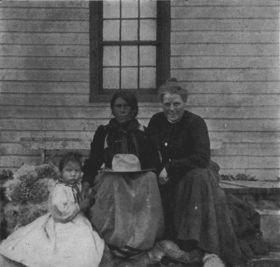
Stripped of the horrible details, these are the related facts. Twenty years ago Louise was a bride of seventeen. With her sister, aged eighteen, their respective husbands, father, mother, sisters, little brothers and cousins, en famille, they pitched off from Little Red River to make winter camp in the woods. The camp made, all the younger men set off to hunt meat for the others. Neither moose nor caribou was seen, and on and on they went. They shot one small beaver and ate it, and the white earth afforded no further food. Starving and hopeless, they stumbled on, finally to fall into a camp of stranger Indians, who nursed them back slowly through the winter to sane strength.
How about their families, the camp of waiting ones left behind in the woods? With no one to hunt for them, gaunt Famine held these in her clutch. Grandmothers' faces grew weary, the sharpened eyes of the little children peered daily across the snow waiting, watching, for the hunters who were to bring food. The fires were made in readiness, but no meat came to those hanging kettles. Old and feeble, young and helpless, alike became weaker as they watched. One by one they died. The survivors ate of the dead bodies. At last, of the nineteen souls, Louise and her sister alone lived. Wild-eyed and starving, holding one old musket between them, these two sisters stumbled off together to try to make Little Red River, leaving behind them in the woods the most awful experience that two human beings could share. At the nightly camps each feared the other and neither dared to sleep. The third night out, thinking that Louise slept, the sister levelled the gun at her stooping companion, but Louise was watching through burnt holes in the canvas. The next day brought no food, and the nightly watch was repeated. Then the sister died. How she died God and the watching stars alone know. Some say that Louise carried with her a piece of her sister's flesh as food when at last she staggered into Red River. This Louise denies, but admits freely the cannibalism of the winter's camp.
Cannibalism! As we use this term we regret the paucity of a language which forces us, in describing the extremity of Louise, to use the same word which we apply to those inhuman monsters who, of their own volition, choose the flesh of man for food. It is an awful story. Human imagination and sympathy utterly fail to give a conception of the agony undergone by these poor creatures—women and children with affections like our own—shut for the greater part of a winter within that cruel camp of death!
Coming back to the world of men and women, Louise was for years a recluse, shunned of all Indians as a "Wetigo" or "Cannibal." A friend was raised up to her in the person of Mrs. Scott, the wife of Archdeacon Scott, who took her in and made her a member of their household. Years passed, and Louise married a man whose Cree name is The-Man-Who-Looks-Like-Silver. To this marriage a little child has been born.
As we arrange the little group for a photograph, the mother tenderly caresses the child and the father smiles kindly upon both. Louise the Cannibal! When we look on our joint picture, it might be somewhat difficult to distinguish the writer from the Indian woman. She is "even as you and me."
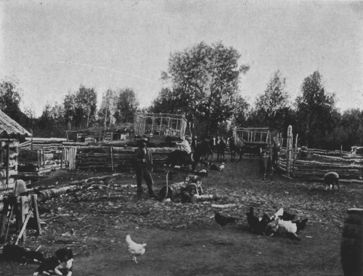
Taking passage on the steamer Northern Light, we leave the settlement of Lesser Slave Lake, this world-in-small, on the first day of October, and, from here to Athabasca Landing, travel in company with Mr. J.K. Cornwall, President of the Northern Transportation Company. Between the time of our journey and this writing, Mr. Cornwall has been returned as Member of the Alberta Legislature for the district we are now traversing. He certainly knows his constituency better than most representatives do. There is scarcely a mile of these unmapped ways that he has not tramped alone; not an Indian guide in the North can last with "Jim" for a week, in summer, or on snow-shoes. When some Lesser Slave half-breeds were told that Mr. Cornwall was going to run for the legislature against Allie Brick, one of them said, "Jim wins. Allie Brick can't run. Not much fun in that race. No man on Peace River can run like Jim."
Mr. Cornwall's pronouncement on the North Country can be taken as authoritative. He says, "Practically all the timber of any commercial value between the Great Lakes and the Rocky Mountains is in these northern watersheds. This timber will be a very important factor in the coming development of Prairie Canada to the south, and fortunately, too, it is most get-at-able. There are thirty-six hundred miles of river and lake in the North on which steamers are plying to-day and which are open for navigation for six months in every year. The first railway that comes in will tap a system of transporation equalled only on this continent by the Mississippi and St. Lawrence with the Great Lakes. The American Government has spent two hundred million dollars on the improvement of Mississippi navigation, and to-day it is not as valuable a national asset as the great Athabasca-Mackenzie-Peace system is as it came from the hand of Nature. Thirty thousand bushels of wheat that would grade 'No. 1 Northern' was produced in the Peace River Country this year, besides thousands of bushels of oats and barley. In this Northland there are 100,000,000 acres of land fit for the growing of grain."
Charles Dickens used to carry a note-book in his vest-pocket in which he jotted down names that tickled his fancy. Were Dickens to travel this route with us, his name-note-books would bulge. Where Lesser Slave River issues out of Lesser Slave Lake, we found Tom Lilac in earnest conversation with Jilly Loo-bird. Jilly has navigated the North all the way from Athabasca Landing to Hudson's Hope on the Peace, seeking a wife, and still lacks his connubial rib. Being told that ladies are on board, he breathlessly asks, "What colour?" When he learns that we are white, Jilly makes a dash for some cache in the woods which takes the place of clothes-closet, but the steamer has passed on before he emerges. Another lost chance, both for Jilly and the writer! For two or three miles here, where the river runs out of the lake, it never freezes, and ducks and wild-fowl remain here all the winter in open water. Last month, in this immediate vicinity, no fewer than one hundred moose were killed. Lilac tells us that last winter there was no snow here until March, and two winters ago absolutely no snow fell whatever, so that the sleighs were not gotten out and all the freighting had to be done with waggons. "No need to starve here," says Lilac, "the trout run up to forty pounds each. There are whitefish and grayling, and I gather berries all the year round. In summer, I get the red and white currants, raspberries, saskatoons, blueberries, gooseberries, and strawberries, and all winter long there are both high-bush and low-bush cranberries."
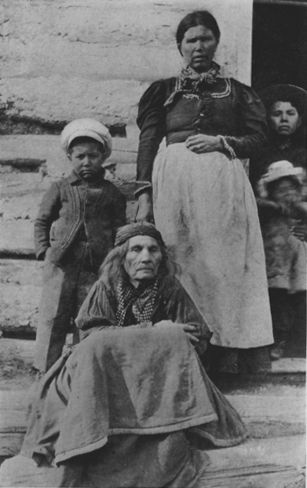
Travelling with us are Judge Noel and Judge Beck, making the first circuit of justice through this country. Although they had come all the way from Edmonton looking for trouble, so splendid has been the surveillance of the Mounted Police here that no one could scrape up one case for the judges to try. The Peace River people seemed somehow to think that in greeting the judges with an empty house the settlement had failed to make good. Some one comforts them with setting forth as the ethics of the case the fact that the judges should be presented with white gloves, as the traditional sign of an empty docket. Again is Peace River chagrined, neither The Company nor the French Company has white kids in stock. Each judge is made the recipient of a handsome pair of moose-skin gloves, as a substitute, ornamented with beads and quills of the porcupine.
At Norris's, we leave the steamer and shoot the current of the swift Lesser Slave River in a cranky dugout. The Dominion Government, with a series of wing-dams, is putting this river to school, teaching it how to make its bed neatly and wash out its own channel. Where the Lesser Slave River runs into the Athabasca, we change the dugout for a scow, and from there to Athabasca Landing float down the last stretch of our northern waterways of delight. There is frost each night now and the deciduous trees on the banks are a rich riot of colour. We resurrect from the depths all the warm clothing available and have opportunity of testing in their own latitudes the lynx-paw robes, moose-skin hunting-coats, and other spoils that we are bringing out to civilisation.
Every passenger who floats with us enlarges our knowledge and enriches our vocabulary. Judge Noel's bodyguard is a young stripling of the Mounted Police, born in dear old Lunnon. It is always interesting to note the different things of which people are proud. Old men boast of their age and young ones of their youth. The fat woman in the side-show is arrogant over her avoirdupois; the debutante glories in her slender waist; and the globe-trotter triumphs in the miles he has travelled. Wyllie claimed distinction in never having left Chipewyan. This Mounted Policeman, who stretches out on the scow, plumes himself on two things: "I 'old the dahnsin' championship of Edmonton. I got a gold watch lahst winter for waltzin'." We smile approval, and the constable continues, "I waltzed,—reversin',—an 'our-an'-a-'alf! And—," straightening himself up, "I am the best-tattooed man in the Province of Alberta."
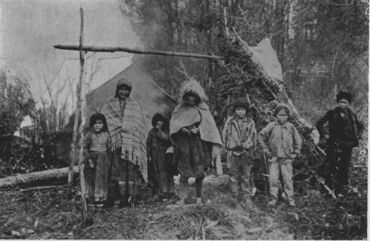
Rich is the descriptive language of the North, and we lie awake on the scows, rolled in our blankets, loath to lose any of it. "Jim" is at the sweep. Many of the men are going out from the North for the first time in four or five years. They also seem too interested to slumber, and all night long the conversation goes on. A priest is describing some man who seems to be hard to identify. "You know him,—the son of the ole man with the patch on his nose wot died. I christen him last winter." No one is more apt at naming than these men. Two days ago, at the treaty at Lesser Slave, when a smiling couple drew five dollars for a baby one day old, a Cree bystander dubbed the baby "dat little meal-ticket." A young girl who came up to claim her money was nicknamed "Pee-shoo," or "The Lynx," because of her bad temper. So we see where all the old cats of the south come from.
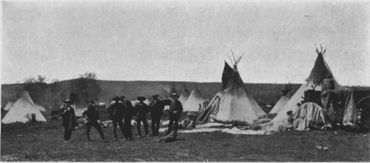
The scow glides on, and we doze, but do not sleep. In the dark she hits something and bumps us wide awake to hear the reassuring, "This is where Pat Cunningham's horses were drownded last week." Under Jim's command, everybody works, even learned judges from Edmonton. He says, "Take another shot at the oars, and then you can hit the feathers." In the morning, one half-breed fails to turn up for meat-su and the comment is, "He feels the feathers pullin'." "Don't blime 'im," remarks the constable, passing the tea, "only fools and 'orses work."
"He reached out his hand for a drink," rendered into trans-Athabascan would be, "He got his thievin' irons on the joy-juice," or "He stretched his mud-hooks for the fight-water." "He set him a-foot for his horse" means "He stole his horse," and from this we derive all such phrases as, "He set him a-foot for his blankets," "He set him a-foot for his furs," "He set him a-foot for his wife."
The springy tussocks of grass growing in swampy places are têtes des femmes, a name that pleased our fancy and made us think each time we negotiated them of walking over the swaying heads of women in a crowd. To call the tribes together, Indians are wont to send out significant little pieces of wood. The announcement in the society columns, if the Indians had any, would be, "The Crees sent out chips for a crush." An Indian far down the Mackenzie had a name that kings might envy. He was known among his tribe as The-Man-Who-Goes-Around-and-Helps. When a beardless and ardent missionary approached this splendid chief, wanting to "convert" him to the Christian religion, the old man replied with indulgent dignity, "My son, for eighty years have I served the Great Spirit in my own way. I fear I am now too old to change."
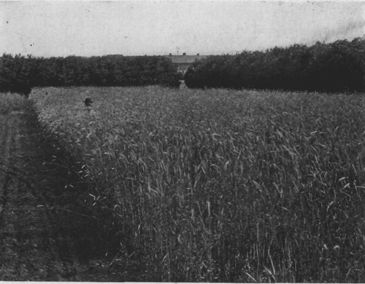
Edmonton once more. Two Spanish sailors shipwrecked and navigating the Pacific on a log, search the shore for a sign. Into what land are they drifting? The one at the bow (does a log have a bow?) sees something through the haze—"Gracias a Dios! Praise be to God, it is a Christian country! I see the gallows!" We too get our sign. We reach Edmonton on Convocation Day.
Most young countries for the first ten years of their lives confine their energies to roads, bridges, transportation—things of the market-place. Alberta has been a full-fledged Province of Canada for barely three years, and, coming out of the wilds, we sit on the back benches and see her open the doors of her first Provincial University. The record is unique and significant. On the banks of the Saskatchewan rise the walls of the new Parliament Buildings, a replica in small of Minnesota's State Capitol at St. Paul. This new Province, carved out of the heart of the world's biggest wheat-farm, would seem to hold within it all the elements that make for national greatness: the richest soil in the world, oil, timber, fur, fish, great underlying coal measures, a hinterland which is a very Pandora's box of gifts. Strong, sane, young people have the situation in hand, each alert to grasp the skirts of happy Chance. Peace walks within these western borders. What more would you?
The very first man we hunt out in Edmonton is Mr. Wyllie of Chipewyan. On his promised visit to the Orkneys the old man had gotten as far as Winnipeg, where the crowds of the modern city affrighted him. "Miss Cameron, the men on the streets were as trees walking, and no man stopped to ask how the other was doing. If that is the world, I wanted to go no farther. I'm going back to Chipewyan, and I will take my family with me. We go home with dogs on the first ice!" Poor Wyllie! Before the bells rang out the Old Year, his soul heard the summons none may disregard, and alone he went out on the Long Journey.
What of Inspector Pelletier, Walker, Joyce, and Conway, essaying the traverse from Resolution to Hudson Bay? For weeks after coming out we waited for news of the party. Month succeeded month and no word came out of the white silence. Hudson Bay has no daily mail service. "There ain't no busses runnin' from the Bank to Mandalay." It is not until March that the welcome word comes that the original party safely made salt water. The relieved tension at Regina headquarters and the joy of personal friends is dimmed by the news of the death of Corporal Donaldson, who joined the others at Chesterfield Inlet. Donaldson, in company with Corporal Reeves, started down Hudson Bay in an open boat and encountered a herd of walruses. Enraged and maddened at the shots of the men, one huge animal made a charge, the boat was upset, and Donaldson, trying to make shore, was drowned. Reeves survived.
It seems to be a chapter of accidents. Just as this book goes to press we learn of a double fatality which attended the transport of the 1909 outfit of Count von Hammerstein. This plucky developer of McMurray oilfields, while running Grand Rapids on the Athabasca (the rapids which we had descended in an empty while the other sturgeon-heads were discharging freight at Grand Rapids Island), struck a boulder. The boat turned turtle and the three men were tossed into the torrent,—von Hamerstein, V. Volksooky, a young Russian, and a French half-breed, La France. The Count was washed ashore and escaped, but the others were drowned. Deaths such as these are the price of Empire. When the railroad reaches the Athabasca, the running of these dangerous rapids will no longer be necessary.
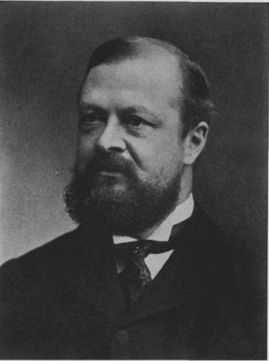
In the footprints of Back and Samuel Hearne, Alexander Mackenzie and Sir John Franklin, for six months we have been treading the silent places. We have thought much of these faith-possessed men who found the roads that others follow. In faith they wrought. Canada does well to honour these great of old, and that she appreciates the work of her early explorers is shown in the fact that British Columbia recently granted a pension to the granddaughter of Simon Fraser, the man who in 1808 first sailed down the great river that bears his name. But the day of our great men is not over; Canada still in her great North and West has Pathfinders of Empire. The early voyageurs made their quest in the dugout and the birchbark; and the tools of these are rails of steel and iron horses.
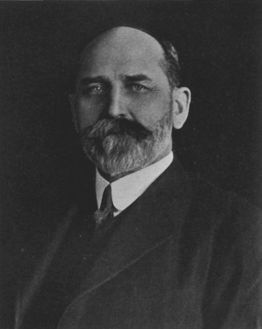
We are accustomed to look upon a railroad as a cold thing of dirt and sand and rock, ties and steel,—a mechanical something associated with gradients and curves. But the history of railroading in Canada is one long romance; back of each line is its creative wizard. We are too near these men to get their proper measure; the historian of the future will place their names on Canada's bead-roll:—Charles M. Hays, the forceful President of the Grand Trunk Pacific; Mackenzie and Mann; William Whyte of the Canadian Pacific. Canada owes much to Caledonia. Nine-tenths of those pioneers of pioneers, the trading adventurers of the H.B. Company, came from Scotland, that grey land where a judicious mixture of Scripture and Shorter Catechism, oatmeal and austerity, breeds boys of dour determination and pawky wit, boys who, whatever their shortcomings, are not wont to carry their wishbone where their backbone ought to be. A conspicuous example of the dynamic Scottish Canadian, hale at sixty-six, is William Whyte, Vice-President of the Canadian Pacific Railway. At an age when most men are content to "drowse them close by a dying fire," William Whyte finds himself in complete charge of all the affairs of the Canadian Pacific Railway Company between the Great Lakes and the Pacific. Through the positions of brakemen, freight clerk, yard master, conductor, night station-agent, passenger agent, this man worked on his own passage along Fame's ladder. Twenty years of adolescence and preparation, twenty years with the Grand Trunk, a quarter of a century with the Canadian Pacific, this is William Whyte's record of splendid service. He has always played the game and he is still in the harness.
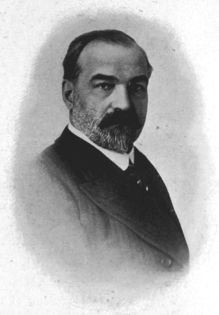
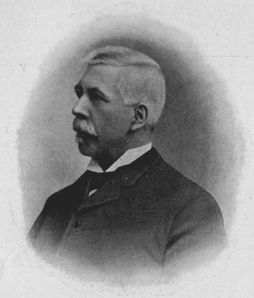
When people enquired of the early Christians, "What do you call your new religion?" they answered, "We call it The Road." If religion is the best work of a man made visible, as I think it is, then the Canadian Northern Road may well stand for the religious expression of the men who made it. It takes more than money, more than dreams, more than ambition, for two men in twelve years to build, own, and personally control five thousand miles of railway. As Riley says, it takes sweat. A mile a day for twelve years,—this is the construction-record of the Canadian Northern. It sounds like the story of Jonah's gourd. In 1896, nothing. In 1909, a railroad line with earnings of ten million dollars a year west of Port Arthur alone, and twelve thousand people on the regular pay-roll. Beginning in Manitoba and operating in the three prairie Provinces, the Canadian Northern is primarily a western railway, its remarkable growth being coincident with and closely related to the tide of immigration.
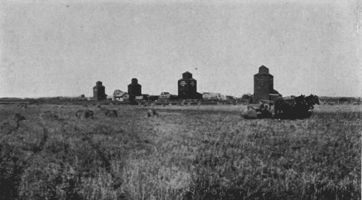
As a case in point, on our way south from Edmonton we pass through the divisional point of Vermilion on the Canadian Northern, which is not to be confounded with our Far North Vermilion-on-the-Peace. Vermilion exemplifies wonderfully the Go-Fever and the Grow-Fever of the Prairies. Before it was three months old its citizens had organised a Board of Trade, had given it a Methodist Church, a newspaper, a bank, a public school, three lumber-yards, three hotels, three restaurants, four implement warehouses, two hardware stores, two butcher shops, four real estate offices, a furniture store, a drugstore, a jewellery store, a steam laundry, a flour and feed store, a shoe-shop, a bakery, and a bookshop. Three barbers had hung out their signs, and so had two doctors, a photographer, a lawyer, a dentist, and an auctioneer. There were two pool-rooms and a bowling-alley.
Farther south we reach the town of Vonda. The Canadian Northern reached this neighbourhood, and the town-site was surveyed in June, 1905. That year Vonda shipped over the line one hundred thousand bushels of wheat, and in 1906 her exports were five hundred thousand bushels. The Canadian farmer looks upon the railroad as his friend; you cannot expect him to use the inclusive condemnation, "Corporations have no souls." The main line of the Canadian Northern runs from Port Arthur on Lake Superior—where, by the way, stands the world's largest grain elevator—to beyond Edmonton on the North Saskatchewan, operating in the heart of one gigantic wheat-farm. The method of construction has been unique. The owners commenced to build branch railways almost before they had a main line. Little spurs to small elevators grew into long branches flanked with bigger elevators, and the elevators evolved into villages, towns, and cities, until to-day the result of twelve years' growth shows a main line of thirteen hundred miles, with over three thousand miles of branch railways. An orchard tree is a good fruit-bearer when the thick clustering branches are more in evidence than the long thin trunk, and the same applies to railroads. But this main line will grow, too. Working out from its wheaten heart, its natural line of growth is east to Hudson Bay, north beyond Edmonton, and west to the Pacific. Surely the tentacles are pushing out. Already the Alberta Legislature has granted the Canadian Northern a charter to Athabasca Landing, and one hundred miles of steel will here tap all the lush land watered by the Peace and the Athabasca.
More interesting than the line which gridirons the wheat-lands we are passing through, are the men who made it. To try to write the history of Western Canada's development and not speak of Mr. Mackenzie and Mr. Mann would be as difficult as Mr. Dick's efforts to tell his story without mentioning the unfortunate Charles I. William Mackenzie is the Cecil Rhodes of Canada—gentle, kindly, almost retiring in his manner, and with a glance as inscrutable as the sea. Beginning as a school-teacher, he early threw aside the ferule and the chalk, to get into the world of action. In his time he has built shacks, kept a country store, and run a saw-mill. Three things come to him as priceless treasure out of the self-discipline of these experiences: a rare aptitude to see and to focus the central idea of any proposition, quick and unerring decision, and the power of ready calculation. "I am seldom wrong in a figure," is one of his few admissions about himself. The President of the Canadian Northern travels without a secretary, dictates letters sparingly, and works in an office as bare of adornment as a monk's cell.
And his working partner? Donald D. Mann is a man of deeds rather than words. James J. Hill has declared Mr. Mann to be the greatest railway builder in the world. Mr. Mann was born in Ontario not far from the sleepy town of Acton and just six miles east of Rockwood, the birthplace of James J. Hill. These two boys learned to swim in the same swimming-hole. One wonders from what roadside spring they quaffed the draught which sent them railroad-building. Mr. Mann thinks it a great advantage to be born a country boy, for he says it makes a lad frugal, strong, and resourceful. It worked out this way in his own case at least, for there is not a thing in railroad building that Mr. Mann cannot do with his own hands, from shoeing a mule to finding the best pass in the Rockies through which to slide his iron horse down to the sea. Direct, strong, simple, he knows how to control himself and manage others. D.D. Mann is a conspicuous example of what a Canadian boy has managed to accomplish by his own efforts. The beauty of this Western Canada is that it holds out opportunities to every plucky lad who has initiative and who is willing to work; nothing is stratified, the whole thing is formative.
While the steel kings are letting the light of day into this great granary, they are being helped by a government representative, as democratic and direct as any of the pathmakers whose visible work we have been noticing. The Hon. Frank Oliver, Canada's Minister of the Interior, is essentially a self-made man. Before the railroad men realised their vision splendid, young Mr. Oliver and his bride rode into Edmonton on an ox-cart, with a modest little printing-press tucked away among the wedding-gifts and household goods. Oliver was a practical printer and soon issued a hand-dodger called by courtesy a newspaper. The editing habit sticks. The Minister of the Interior owns and publishes the Edmonton Bulletin. Mr. Mann says, "I like building railroads"; Mr. Oliver might parody him and say, "I like building newspapers."
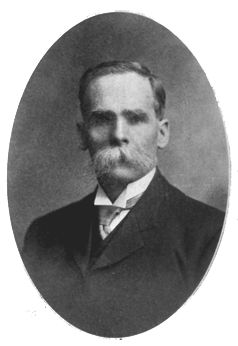
Arrived at Winnipeg, we look back across this great prairie we have twice traversed. The land stands ready to produce bread for the nations; Nature has done her part, now man must do his. The two greatest needs of Western Canada to-day are transportation and immigration. Of the one we have spoken; the other claims our interest even more compelling, for man is more vital than machinery. Canada is a country with a meagre past, a solid present, and an illimitable future.
She, moreover, is the last unstaked Empire under a white man's sky,—where wilderness and man are meeting. The flood of immigration hither is not the outcome of the temporary mood of mankind or of the immigration policy of a government. It is the natural sequence of the economic conditions of a continent seeking the outlet of least resistance to a more favourable situation. The people who are coming in are not dreamers but workers. "The world's greatest wheat-farm," says the economist. It is more than this: it is a human crucible, and we are witnessing here the birth-throes of an entirely new nation.
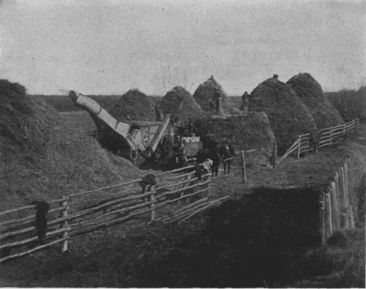
While seventy-five per cent of Canada's wheat-farmers are either Canadian, American, or British-born, and of the class that preserves the homogeneity of the race, every country on the map pays tribute to the plains. Austrians are here and Galicians, Hungarians and Belgians, Dutch and French and Germans, Italians and Polish, the Russian Doukhobortsi, Finns and Danes and Icelanders, Swedes in thousands and stalwart Norwegians. South Africans and West Indians are coming in with Bermudians and Jamaicans and the bearded Spaniard. Far off on the Pacific Coast, strangers are knocking at the western gate,—Chinese, Japanese, and Hindoos.
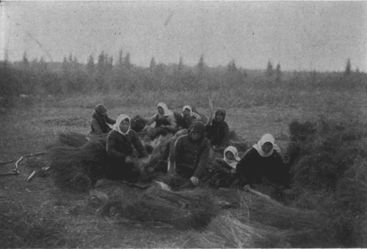
There is no Established Church in Canada; it is the freest land in the world. On his one hundred and sixty government-given acres, the new arrival may worship his God in his own way. The Greek Church in Winnipeg has a Bishop who one day each year makes holy water of the Red River when the Czar is performing the same blessing on the Neva. Down in Southern Alberta refugee Mormons from Salt Lake grow sugar-beets, revere the memory of Brigham Young, and multiply after their kind. Until within two years ago the expatriated Russian Doukhobors maintained a commonwealth of ten thousand souls, eschewing liquors and flesh-meats, making the prairie blossom into bumper harvests, and holding all things in common.
Winnipeg has three thousand Icelanders who, every August, take a day off to celebrate the fact that the Danish King, in 1874, granted a constitution to Iceland. When you ask them why they came to America, they say, "Did not our Lief Ericcson discover this continent, why shouldn't we come?" The Icelanders boast two members in the Manitoba legislature. A Mennonite is a member of the Parliament of Alberta. The first graduate of Wesley College in Winnipeg to find a place on the staff of his Alma Mater is also a Mennonite. Winnipeg has several, Roman Catholic Polish lawyers. Statistics prove that the young Jewish people of Western Canada patronise the public libraries more than any other class or race. All the citizens-in-the-making are closely interested in politics. Recently there was chronicled the formation in Winnipeg of a Syrian Liberal Club and a Syrian Conservative Club. Up in Edmonton the Galicians (Ruthenians?) have just organised a corps of volunteer militia to serve the Canadian country of their adoption.
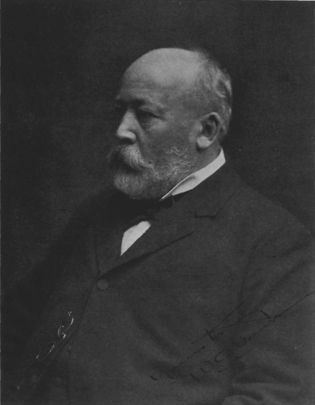
The Americanisation of Canada? During the past seven years over three hundred and fifty thousand people have come to us from the United States. Is this American invasion to be feared politically? Western Canada has no more desirable citizens than those who come to us from the south. They are not failures, but are people who have made good, intent on making better. One generation at the most,—sometimes but a few years,—converts these into Canadian voters. The troubled English brother should remember that when "American" farmers in Canada pronounce on Canadian matters they do so constitutionally at the polls and as Canadian citizens. As Canadians we believe that our national institutions, though far from perfect, are in some respects superior to those of the United States. We believe they are at once more elastic, more responsive to the popular will, and more stable because more elastic. The west is gaining in political power as it gains in population and prosperity, and fortunately our government machinery has been well tested before it is called upon to feel the strain of our rapidly-increasing population. Canada may construct where older nations must reconstruct, and if we borrow an American institution or two, provided it be a good one, let no man hold up hands in holy horror. Japan has borrowed nationally whenever she saw, lying around loose, something she could use, and Japan is as Japanese at heart as she was in the days of the Tycoon and the two-sworded Samurai. Belgium to-day, after centuries of contiguity and intercourse, is not exactly France; and little Switzerland, surrounded by the Powers, will be Switzerland till the last curtain-fall.
"Is Canada loyal to England?" is a question that sometimes meets us. No, Canada is loyal to the British Empire of which she forms a part. Let England see to it that she, too, is loyal.
Canada has two hundred millions of arable acres south of the Saskatchewan. North of this river, in the pleasant valleys of the Peace, are one hundred million acres more. If Canada were as thickly populated as the British Isles it would have a billion people. The mind reels and the imagination staggers in thinking of the future of this rich land. God has intended this to be the cradle of a new race, a race born of the diverse entities now fusing in its crucible. Most of these people in time will intermarry,—Germans and Latins, Celts and Slavs, and with these the Semitic peoples, in varying proportions and combinations. Physically, what will be the result? Mentally and morally, what type will prevail? Drawn by the lure of the wheat, all pour themselves into the melting-pot. What of the new Canadian who will step out?
In the point of population, Canada begins the twentieth century where the United States began the nineteenth. The race is ours to run. Wise the nation, as is the individual, who can learn his lesson from a page torn out of his neighbour's book, learn what to follow and what to avoid. Our fore-elders who laid the foundations for us laid them four-square. As Canadians, we owe a debt to the Fathers of Confederation and their successors. In the West, our particular thanks are due to the Hudson's Bay Company, the R.N.W.M.P., and all those factors which established British law "in the beginning." Canada has never seen a lynching; we have had no Indian war; with but one weak-kneed exception there has been no attempt to hold up a train within our Western borders. This is the inheritance of the people of this generation, and on this foundation we must build. Our hope is in the children.
On the benches of one school-room in Edmonton I found children who had been born in Canada, the United States, England, Scotland, Russia, New Zealand, Poland, Switzerland, Australia, and Austro-Hungary. They were all singing "The Maple Leaf Forever." It is the lessons these children are to learn in that little red school-house which will determine the future of Western Canada, and not the yearly tale of forty-bushel wheat. In the past, nations out of their very fatness have decayed. Many signs are full of hope. Last winter Mrs. Ray travelled alone with dog-sled all the way from Hudson Bay to Winnipeg to place her children in school. Her husband is a fur-trader and could not leave his post. At all hazards the bairns must be educated, so the brave mother journeyed out with them!
May I close with a purely personal note? At the end of a summer which had showered us with kindness, I was to hear from the lips of a Roman priest in St. Boniface the most delightful tribute I have had in my life. We had gone across the river to see the holy relics and skulls, the result of the La Verendrye research carried on by this clergy in the Lake of the Woods country. I was anxious to get the story of the recovery of these historic remains and also to secure photographs. But the Father was obdurate, for he thought his Bishop might not approve. We turned to go downstairs from the third story of the seminary. Looking in at an open door, my eye was caught by the familiar wording of a blackboard problem. "If 16 men and 4 boys working 4 hours a day dig a trench 82 yards long——." And I halted, as the one-time circus-horse stops when he hears the drum of a passing band.
"You are interested?" queried the Father.
"Yes," I acknowledged, "I once taught school."
He, still in the trammels, looked the enquiry he did not utter.
"I taught school for twenty-five years," I admitted.
We walked on down the stairs to the next landing in silence, when he turned to me with, "And you taught school—for twen-ty five years?"
I nodded my head, and we went on. At the next landing the remark was repeated. At the foot of the stairs he excused himself and came back with the photographs which he presented to me with an Old World courtesy and dignity. Grasping my hand in farewell, once more the man of God wondered, "And for twen-ty five years you taught school. And you remain so—" He hesitated for the word, and I wondered what it would be. At last it came,—the tribute of one who expected to teach school all his life to one who had put in a quarter of a century at the work and still survived,—"You have taught school for twen-ty five years, and you remain so glad!"
And this is the keynote of what the summer has left with us. As Canadians, looking at this Western Canada which has arrived and thinking of the lands of Canada's fertile Northland far beyond, for the future we are full of optimism, and of the present we are glad.
| MILES | PLACE | PASSENGER TARIFF | FREIGHT TARIFF per cwt | MODE OF TRAVEL | TIMES | ||
| 0 | Edmonton | ||||||
| 100 | Athabasca Landing | $8.00 | $1.00 | Mail stage, run by J.M. Kennedy | Twice a week all year round | ||
| DOWN STREAM | RETURN UPSTREAM |
DOWN STREAM | RETURN UPSTREAM | ||||
| 0 | Athabasca Landing | Northern Transportation Co.'s SS. Midnight Sun (when business offers) or scows. From Athabasca Landing to Grand Rapids. | |||||
| 120 | Pelican Rapids | $ 7.50 | $ 7.50 | .75 | .75 | ||
| 165 | Grand Rapids | $10.00 | $15.00 | 1.50 | 1.50 | ||
| 252 | Fort McMurray | $20.00 | $27.50 | 3.25 | 3.25 | Scows from Grand Rapids to Fort McMurray | |
| 437 | Fort Chipewyan | $35.00 | $45.00 | 4.50 | 4.50 | H.B. Co's SS. Grahame (sternwheel river steamer, 130 ft. x 28 ft.; accommodates 30 passengers; blankets supplied; bathroom; meals served 50 cents each; 150 lbs. baggage free). From Fort McMurray to Smith's Landing. | From June to August inclusive[1] |
| 539 | Smith's Landing | $45.00 | $55.00 | 5.50 | 5.50 | ||
| 555 | Fort Smith | $48.00 | $58.00 | 6.25 | 6.25 | H.B. Co. Transport, portage by teams from Smith's Landing to Fort Smith. | |
| 749 | Fort Resolution | $56.00 | $68.00 | 7.25 | 8.25 | H.B. Co's SS. Mackenzie River (strong new sternwheel, lake and river steamer; accommodates 50 passengers, same conditions as Grahame above). From Fort Smith to Fort Macpherson. | |
| 819 | Hay River | $59.00 | $73.00 | 7.75 | 9.25 | ||
| 869 | Fort Rae | $62.00 | $78.00 | 8.25 | 10.25 | ||
| 917 | Fort Providence | $65.00 | $82.00 | 8.25 | 10.25 | ||
| 1078 | Fort Simpson | $73.00 | $92.00 | 9.25 | 12.25 | ||
| 1214 | Fort Wrigley | $80.00 | $102.00 | 10.25 | 14.25 | ||
| 1398 | Fort Norman | $87.00 | $112.00 | 11.25 | 16.25 | ||
| 1572 | Fort Good Hope | $93.00 | $122.00 | 12.25 | 18.25 | ||
| 1780 | Arctic Red River | $100.00 | $130.00 | 13.00 | 19.50 | ||
| 1854 | Fort Macpherson (Peel's River) | $103.00 | $133.00 | 13.75 | 21.25 | ||
For further particulars regarding dates and rates, application should be made to the Hudson's Bay Company, Winnipeg; J.K. Cornwall, M.P.P., of the Northern Transportation Co. at Edmonton; or to A.G. Harrison, Secretary Edmonton Board of Trade, Edmonton, Alberta.
| MILES | PLACE | PASSENGER TARIFF | FREIGHT TARIFF per cwt | MODE OF TRAVEL | TIMES |
| 0 | Edmonton | ||||
| 100 | Athabasca Landing | $8.00 | $1.00 | Mail stage, run by J.M. Kennedy | Twice a week all year round |
| 0 | Athabasca Landing | Northern Transportation Co.'s SS. Midnight Sun (sternwheel river steamer, 120 ft. long x 24 ft. beam; accomodates 35 in staterooms; passengers supply their own blankets; meals served 50 cents each; freight-carrying capacity 50 tons). From Athabasca Landing to Mouth of Lesser Slave River. | |||
| 75 | Mouth of Lesser Slave River | $6.00 | .80 | ||
| 91 | Norris's (head of rapids) | $8.00 | 1.40 | Portage 16 miles in N.T. Co's passenger and freight waggons from Mouth of Lesser Slave River to Norris's (head of rapids). | From May 15 to Oct. 15[2] |
| 194 | Shaw's Point on LesserSlave Lake | $16.00 | 2.50 | N.T. Co.'s SS. Northern Light (sidewheel river and lake steamer, 100 ft. long x 26 ft. beam; accommodates 35 in staterooms; passengers supply their own blankets; meals served 50 cents each; freight capacity 30 tons). From Norris's to Shaw's Point. | |
| 201 | Lesser Slave Lake Settlement | Portage 7 miles to the settlement. | |||
| 0 | Lesser Slave Lake Settlement | From Lesser Slave Lake Settlement to Peace River Crossing, teams and drivers may be hired; fare depends on number of passengers; takes 3 days. Stopping places at intermediate points, with stabling and hay; bunkhouses for travellers who supply their own bedding and provisions. | |||
| $10.00 to $25.00 according to number | All the year round | ||||
| 90 | Peace River Crossing (Peace River Landing) | ||||
For further particulars regarding dates and rates, application should be made to the Hudson's Bay Company, Winnipeg; J.K. Cornwall, M.P.P., of the Northern Transportation Co. at Edmonton; or to A. G. Harrison, Secretary Board of Trade, Edmonton, Alberta.
| MILES | PLACE | PASSENGER TARIFF | FREIGHT TARIFF per cwt | MODE OF TRAVEL | TIMES | ||
| UPSTREAM | RETURN DOWN STREAM |
UPSTREAM | RETURN DOWN STREAM | ||||
| 0 | Peace River Crossing | Having arrived at Peace River Crossing, the traveller may go up the Peace by H.B. SS. Peace River (sternwheel river steamer, electric light, bathroom; accomodates 40 passengers; blankets supplied; meals served 50 cents each; 150 lbs. baggage free). | From June to August inclusive[3] | ||||
| 70 | Fort Dunvegan | $10.00 | $ 5.00 | 1.00 | .75 | ||
| 200 | Fort St. John's | $25.00 | $15.00 | 3.00 | 2.25 | ||
| 240 | Hudson's Hope | $35.00 | $20.00 | 5.00 | 4.25 | ||
| DOWN STREAM | RETURN UPSTREAM |
DOWN STREAM | RETURN UPSTREAM | ||||
| 0 | Peace River Crossing | Or, having arrived at Peace River Crossing, the traveller may go down the Peace.— By the H.B. SS. Peace River, from Peace River Crossing to the Chutes of the Peace. |
From June to August inclusive[3] | ||||
| 280 | Fort Vermilion | $15.00 | $25.00 | 1.00 | 3.00 | ||
| 330 | Chutes of the Peace | $17.00 | $30.00 | 1.75 | 4.00 | ||
| 570 | Fort Chipewyan | $37.00 | $60.00 | 3.25 | 7.00 | By H.B. SS. Grahame or Tug Primrose, from Chutes of the Peace to Fort Chipewyan. | |
For further particulars regarding dates and rates, application should be made to the Hudson's Bay Company, Winnipeg; J.K. Cornwall, M.P.P., of the Northern Transportation Co. at Edmonton; or to A.G. Harrison, Secretary Board of Trade, Edmonton, Alberta.